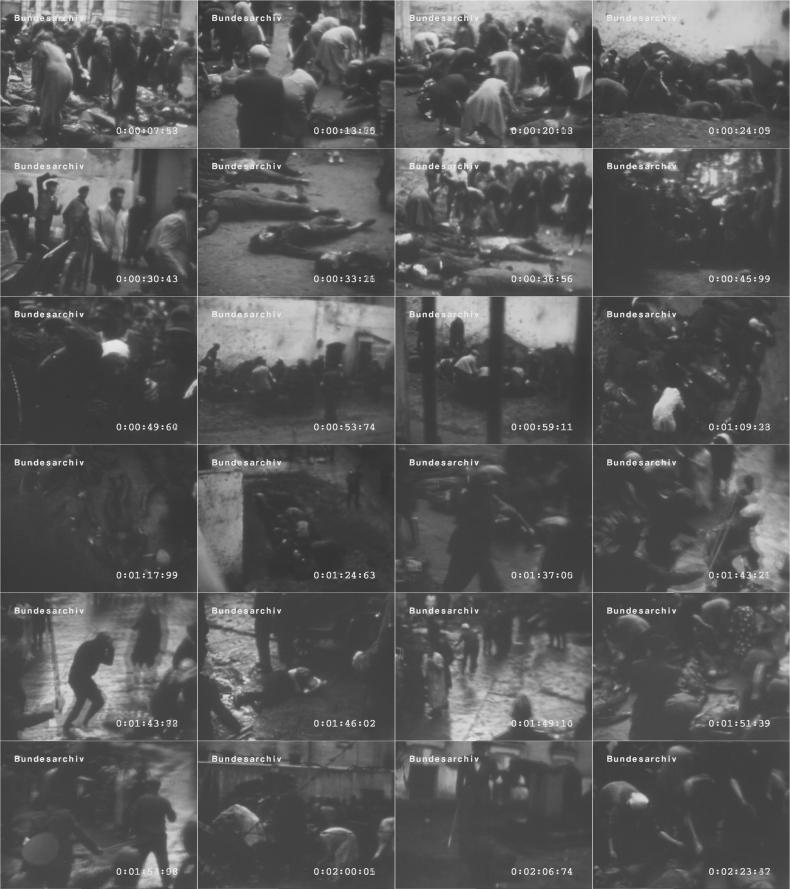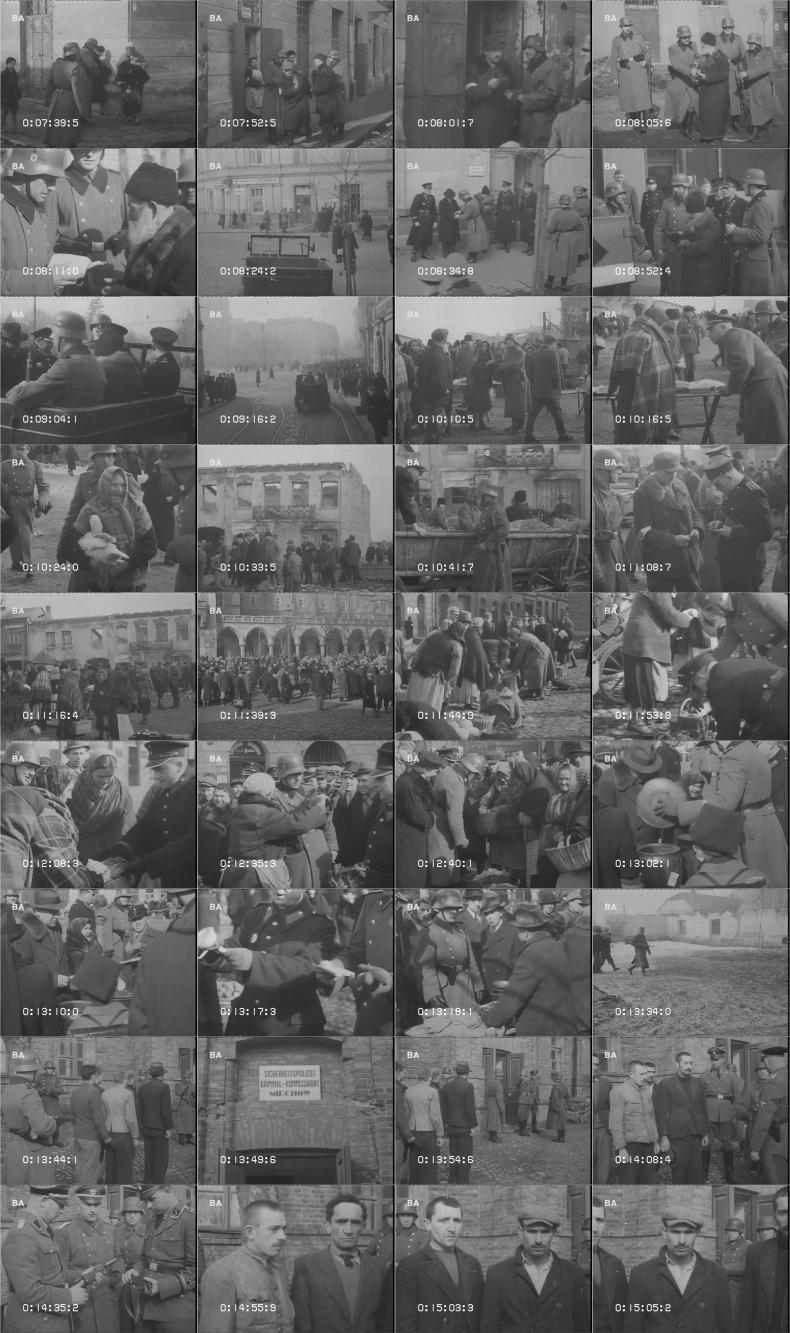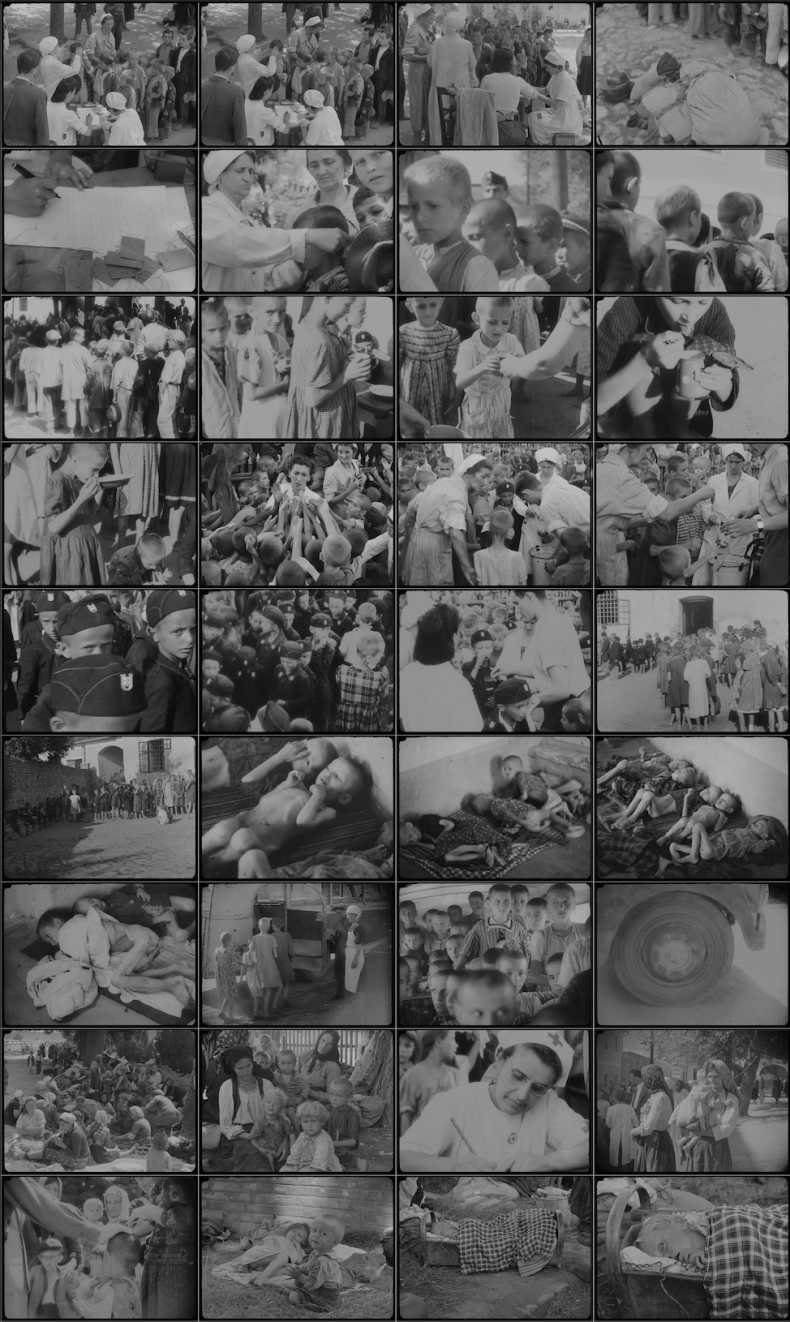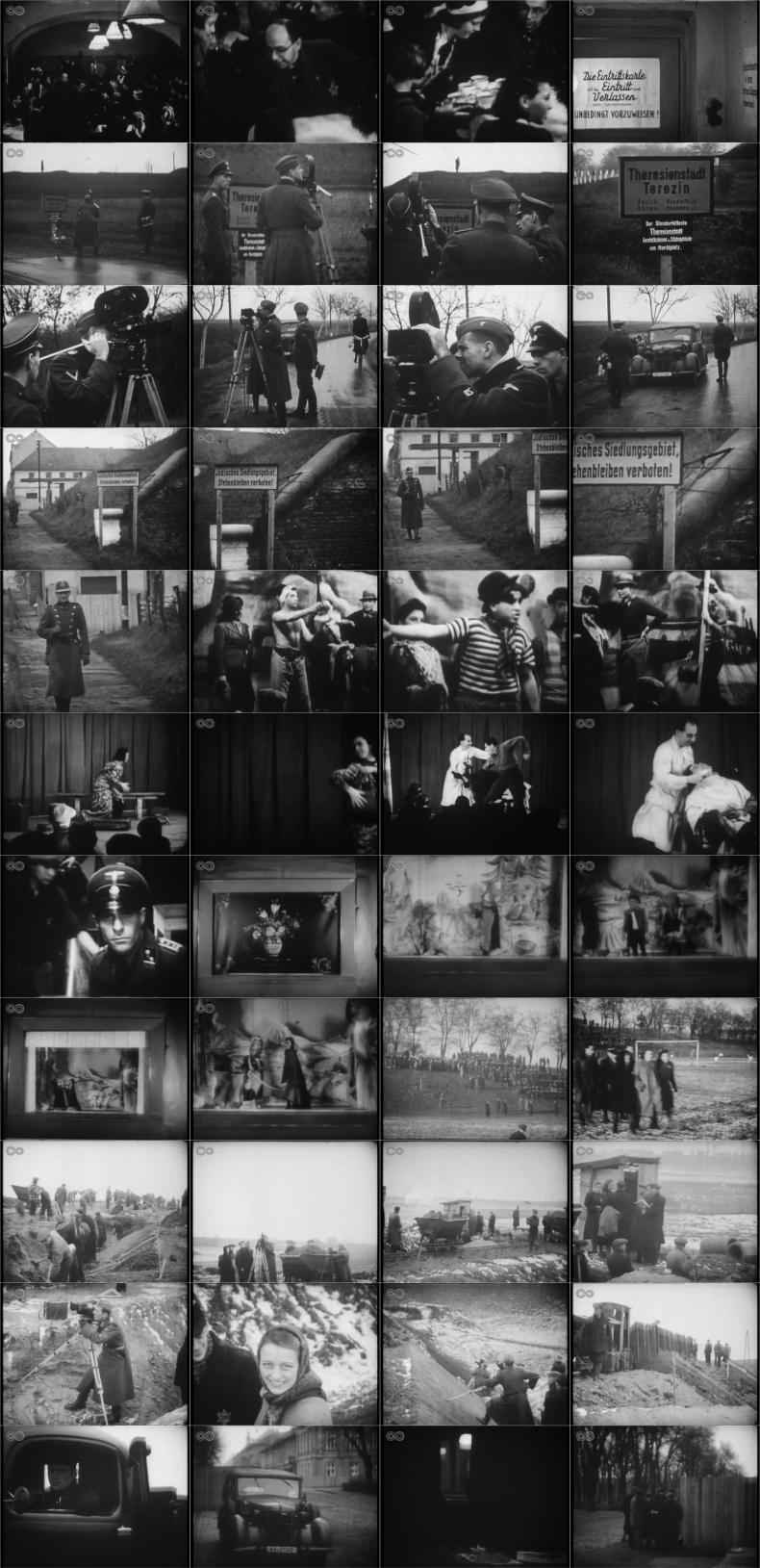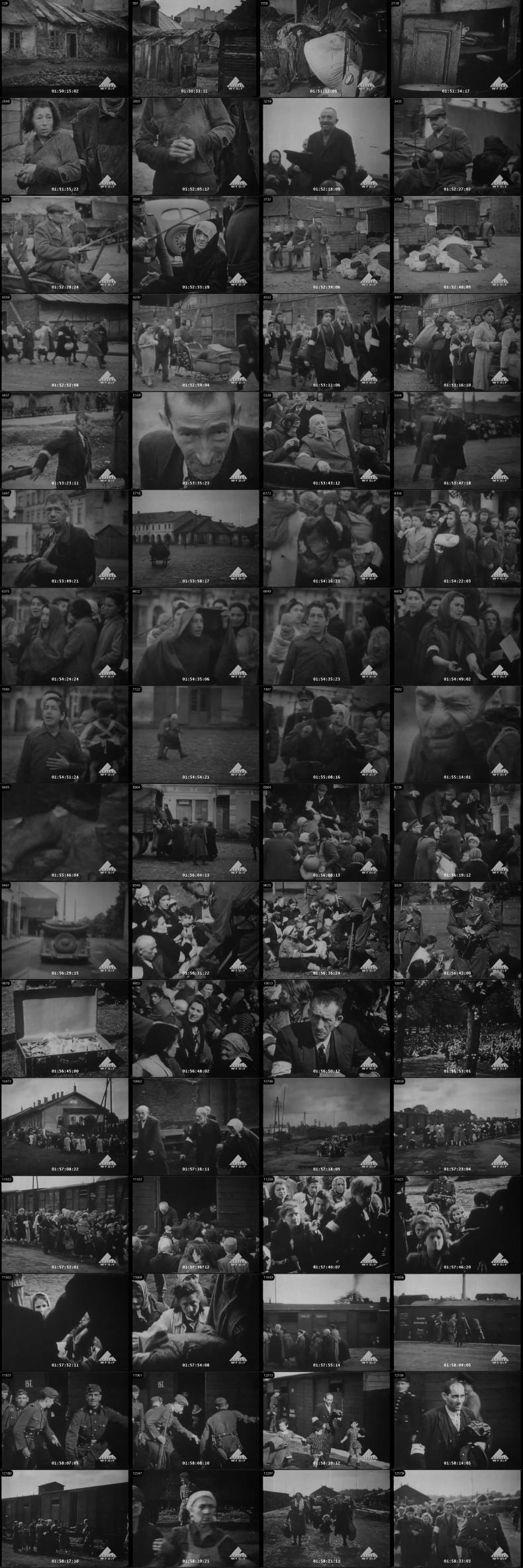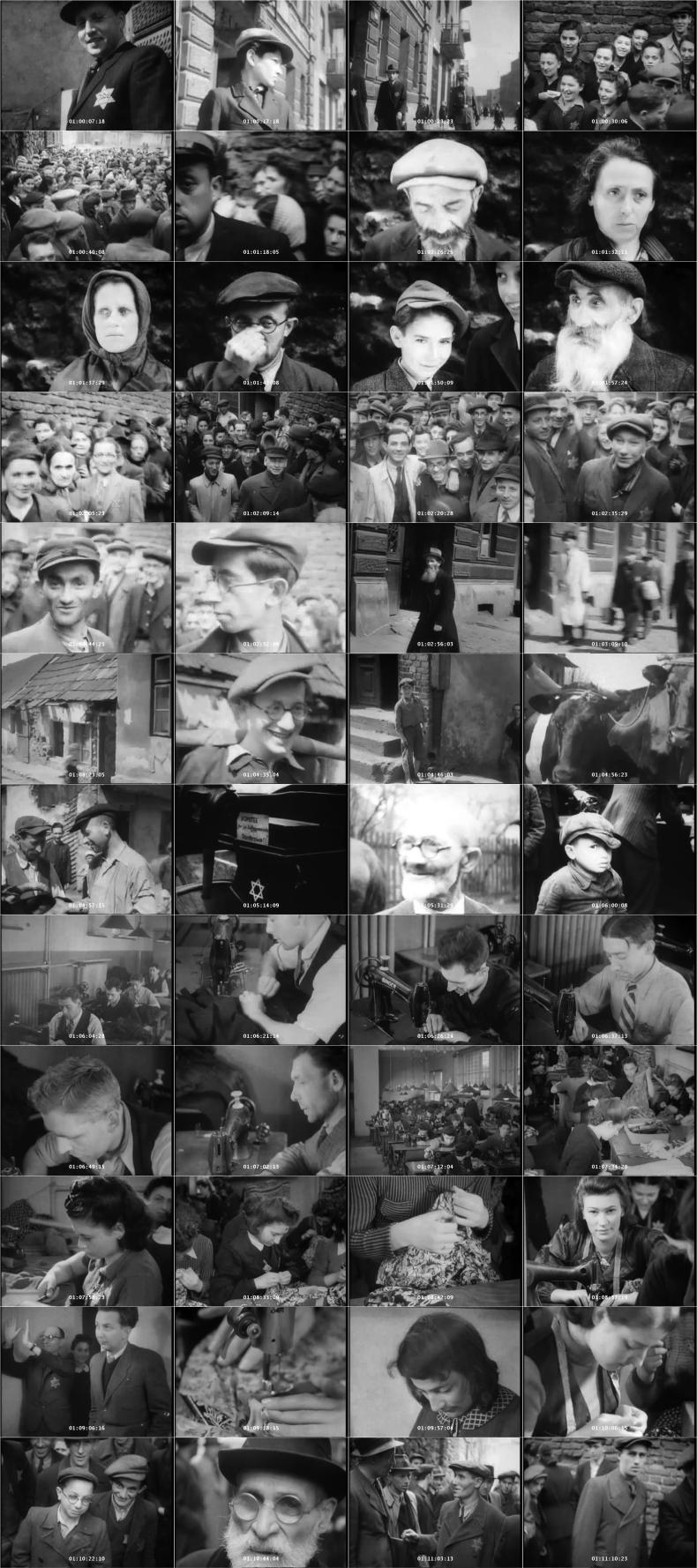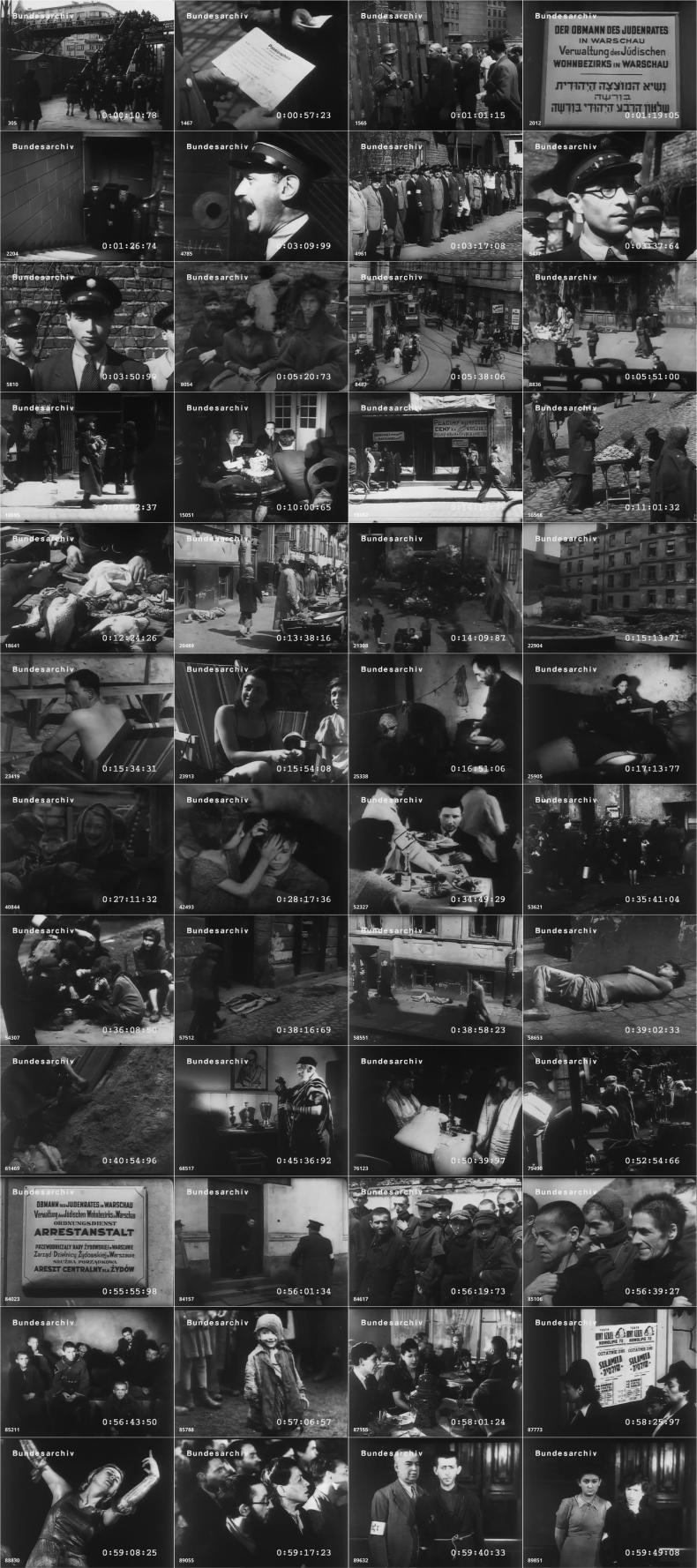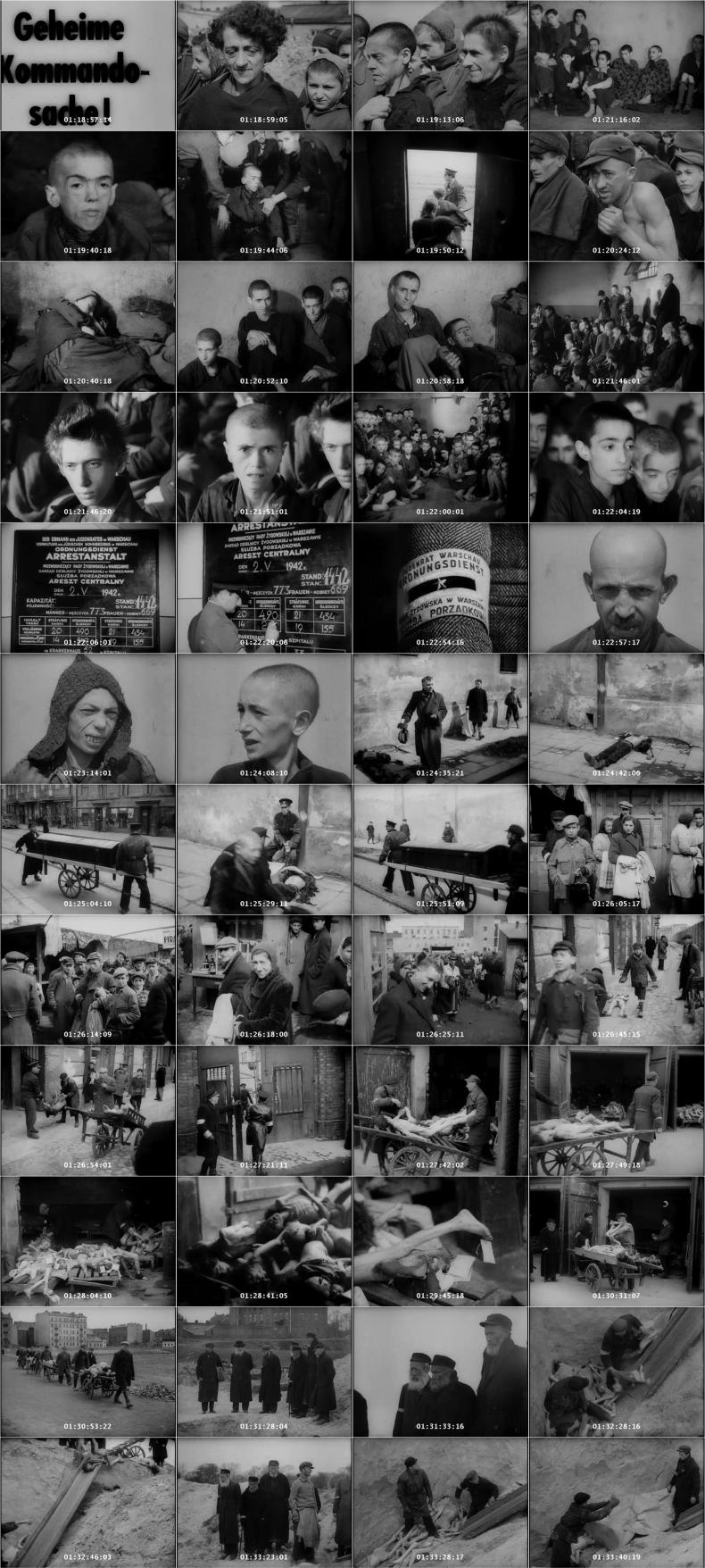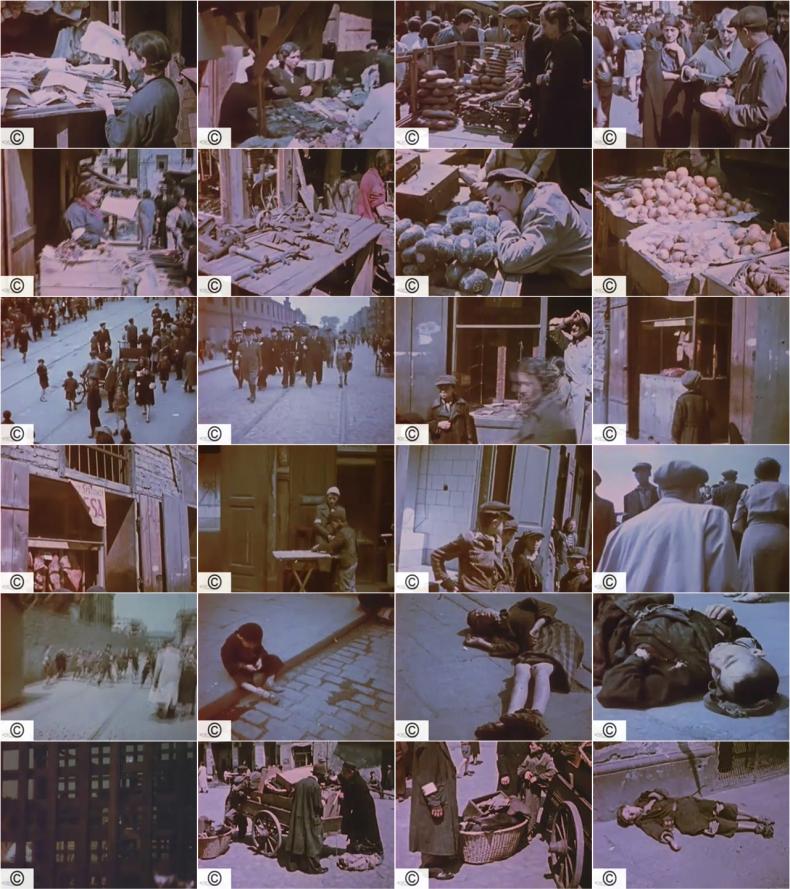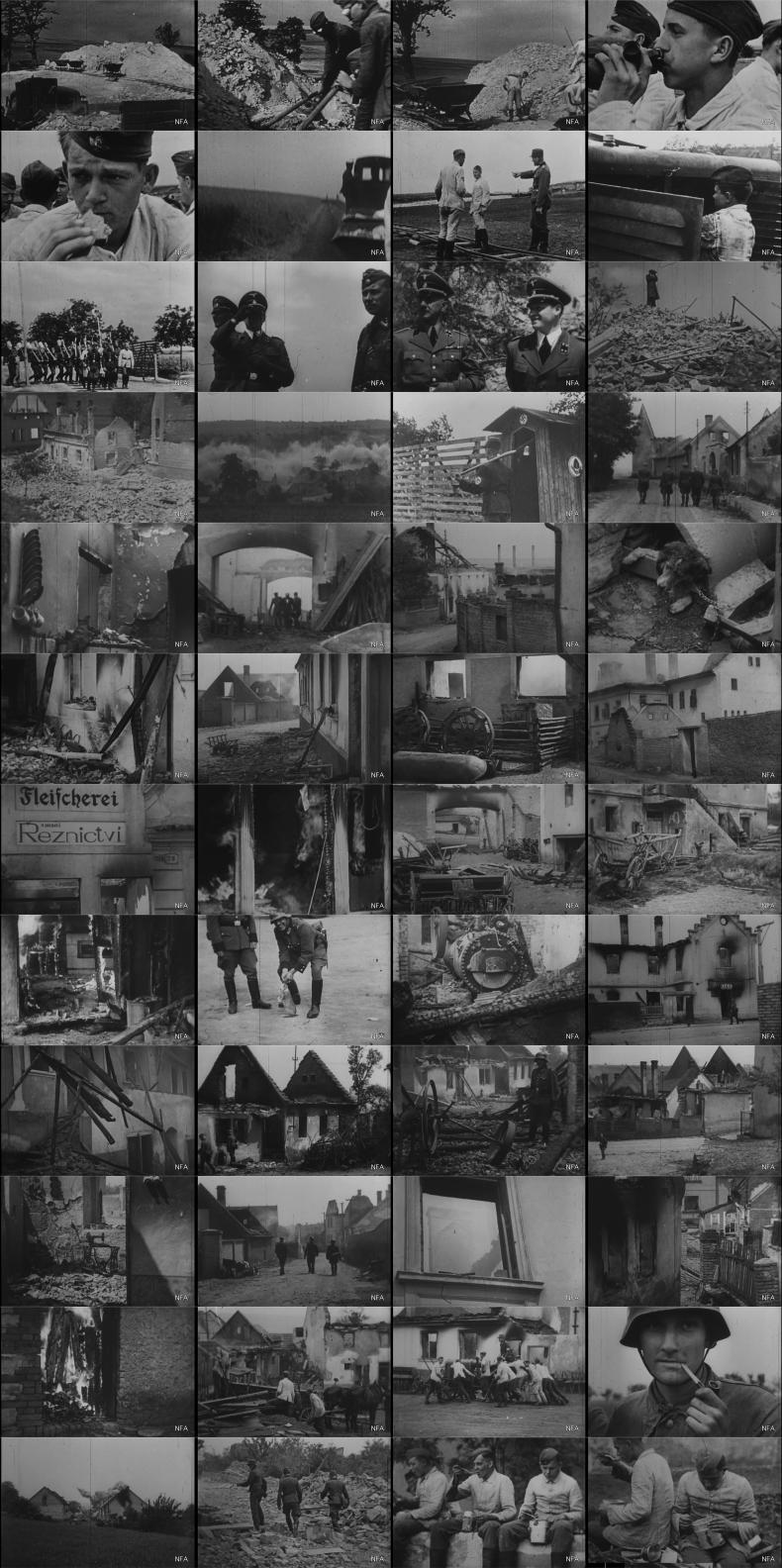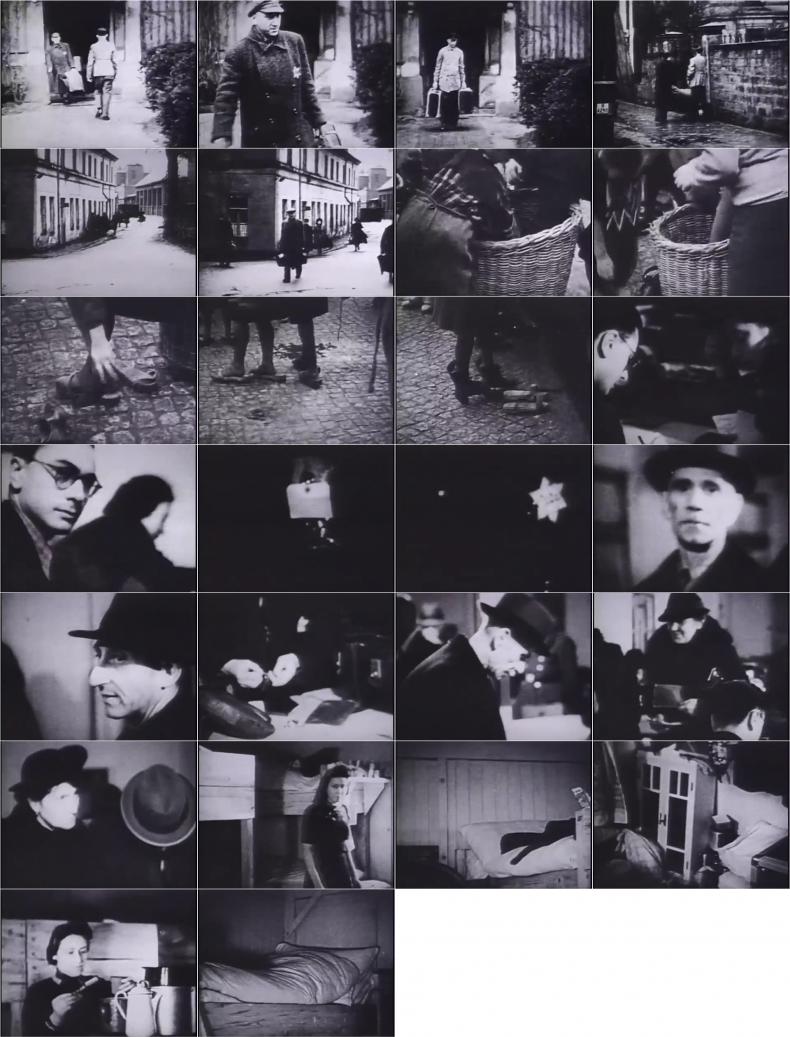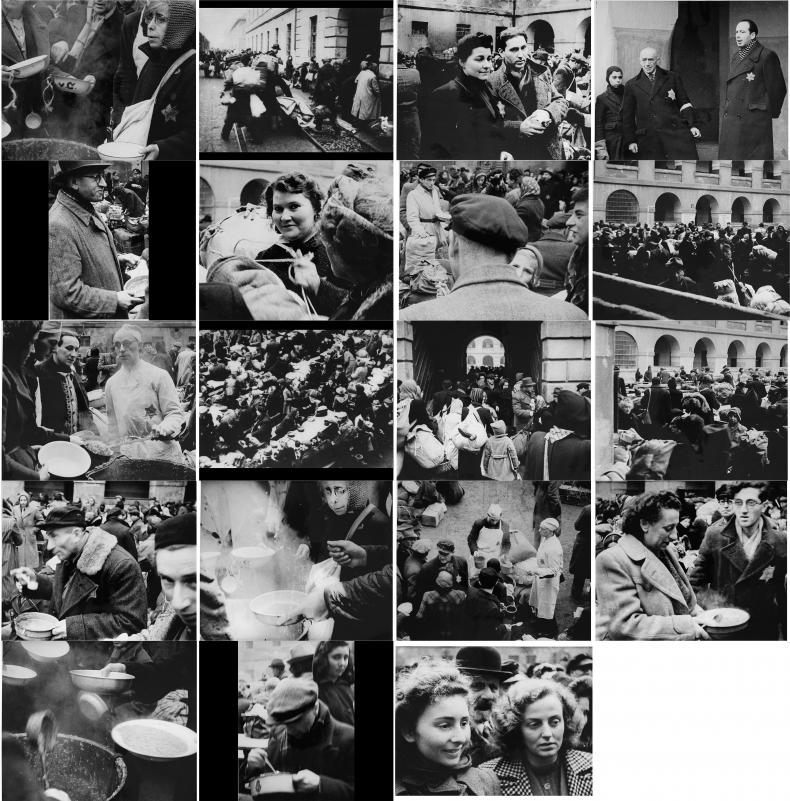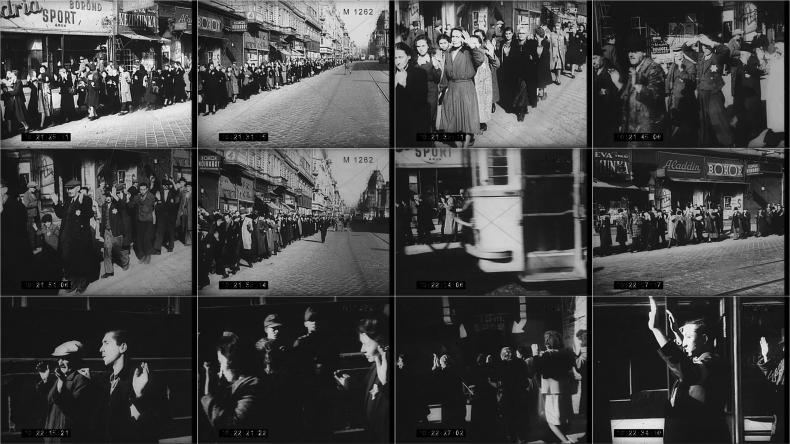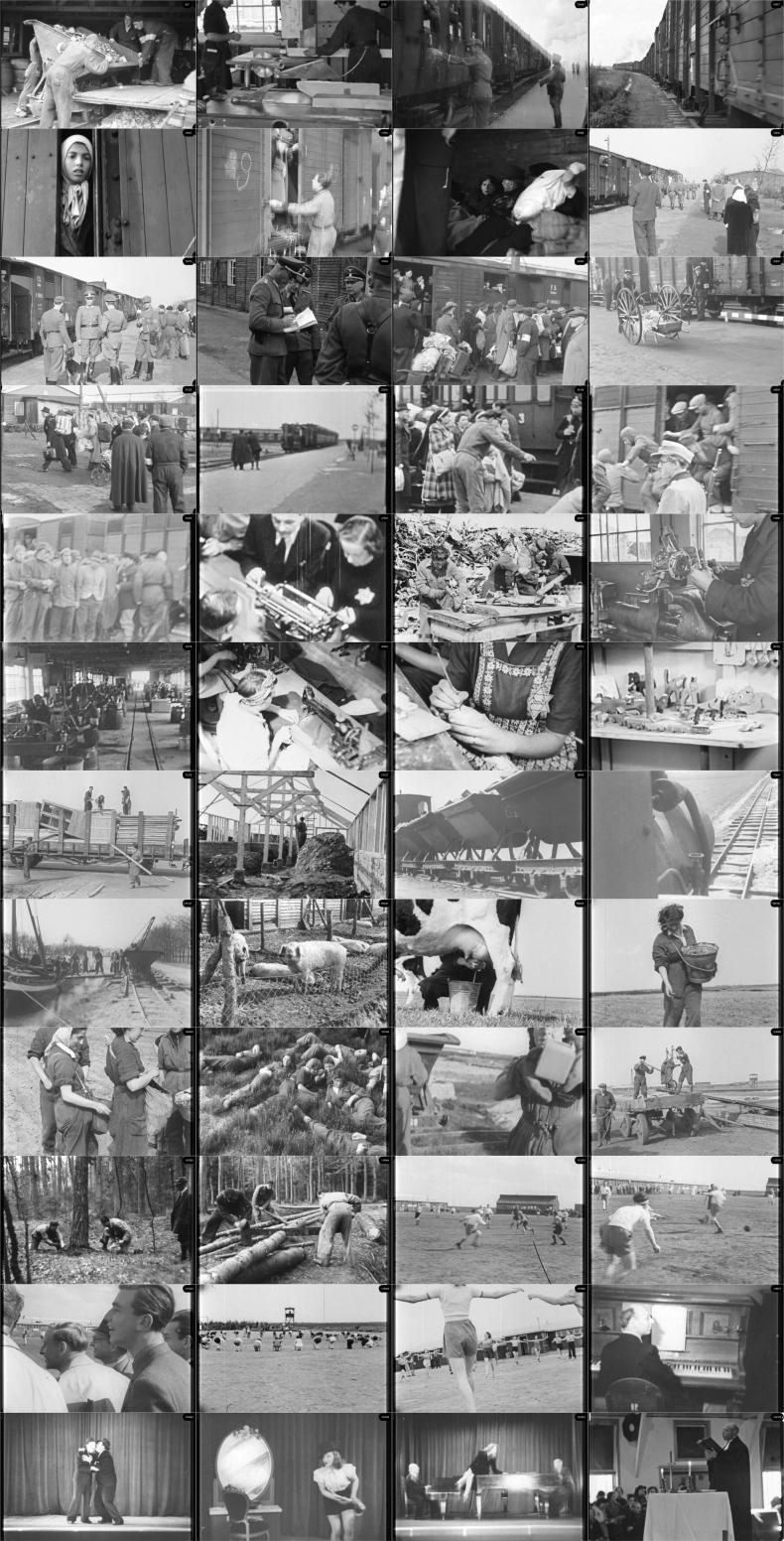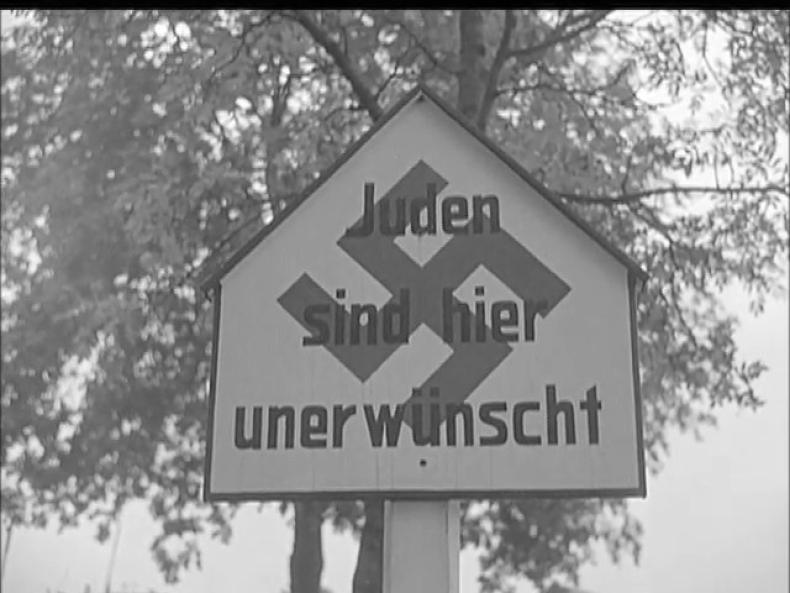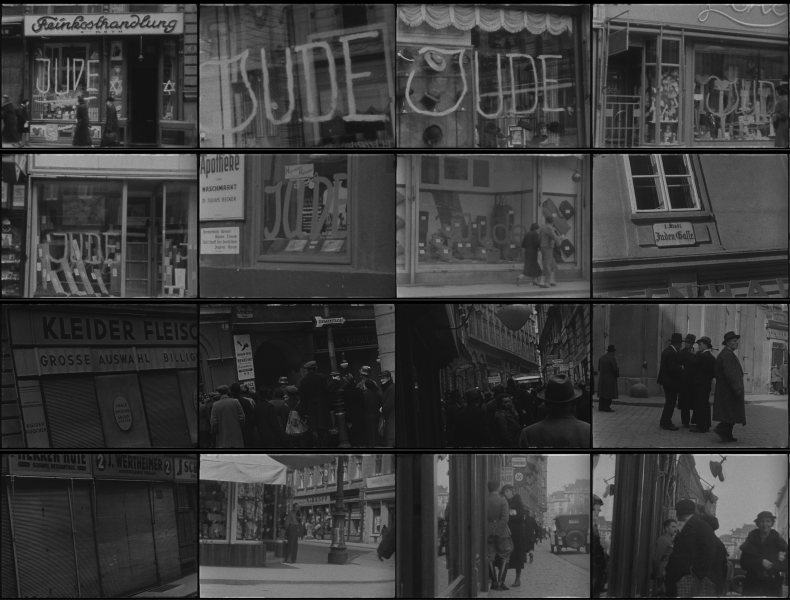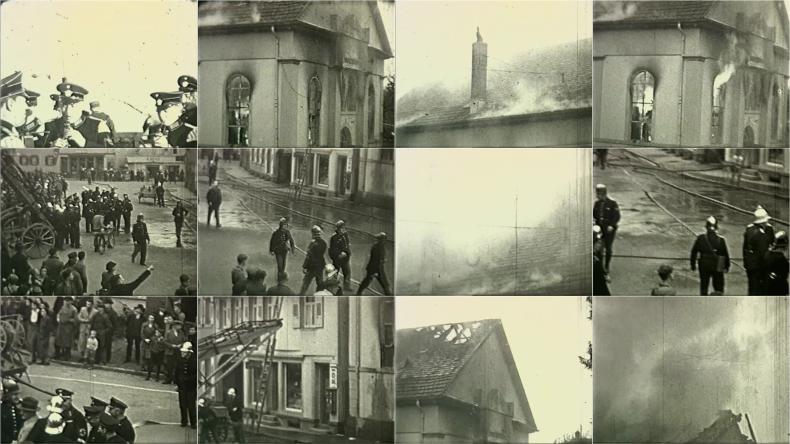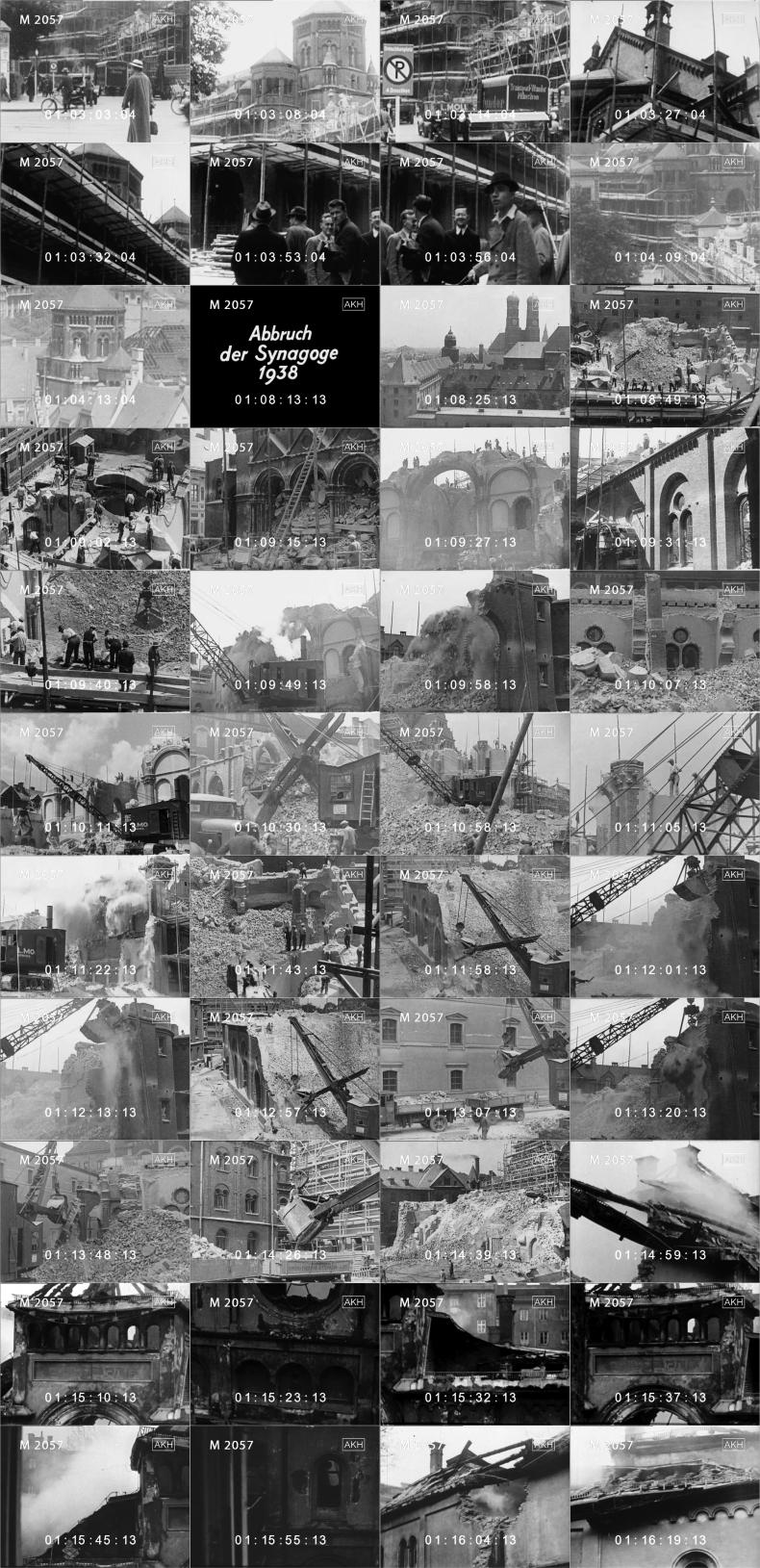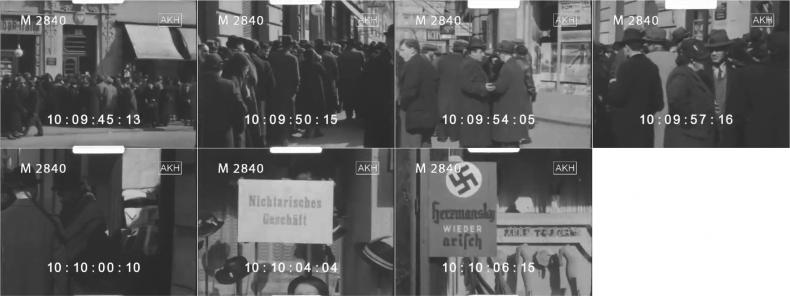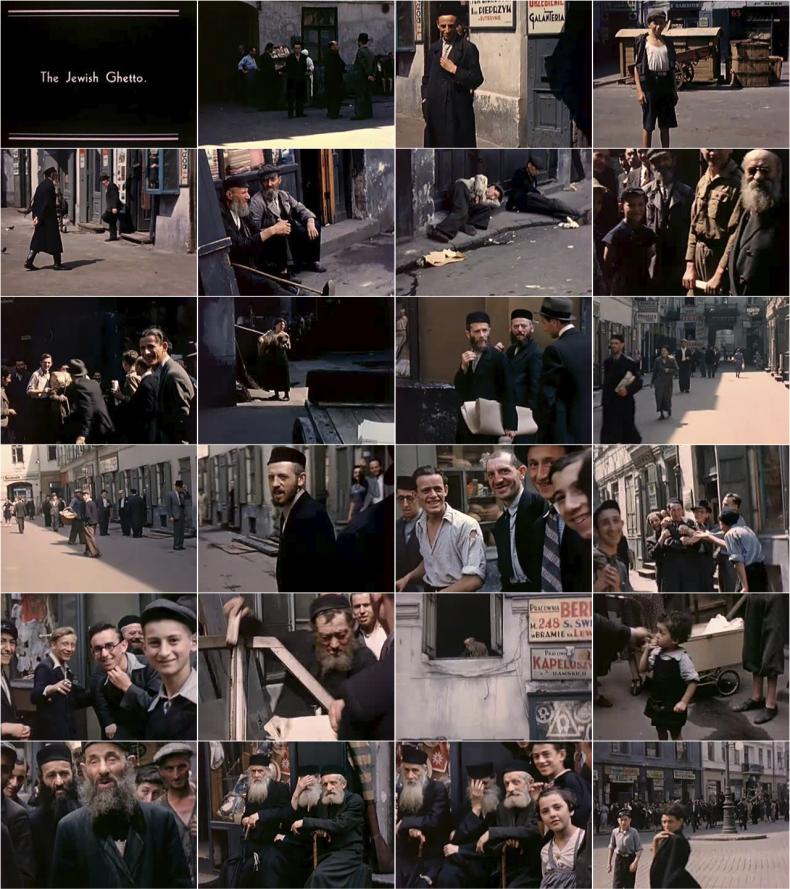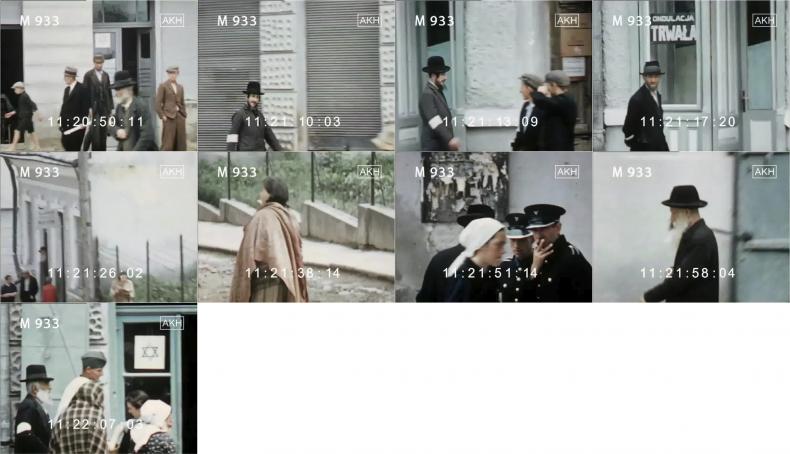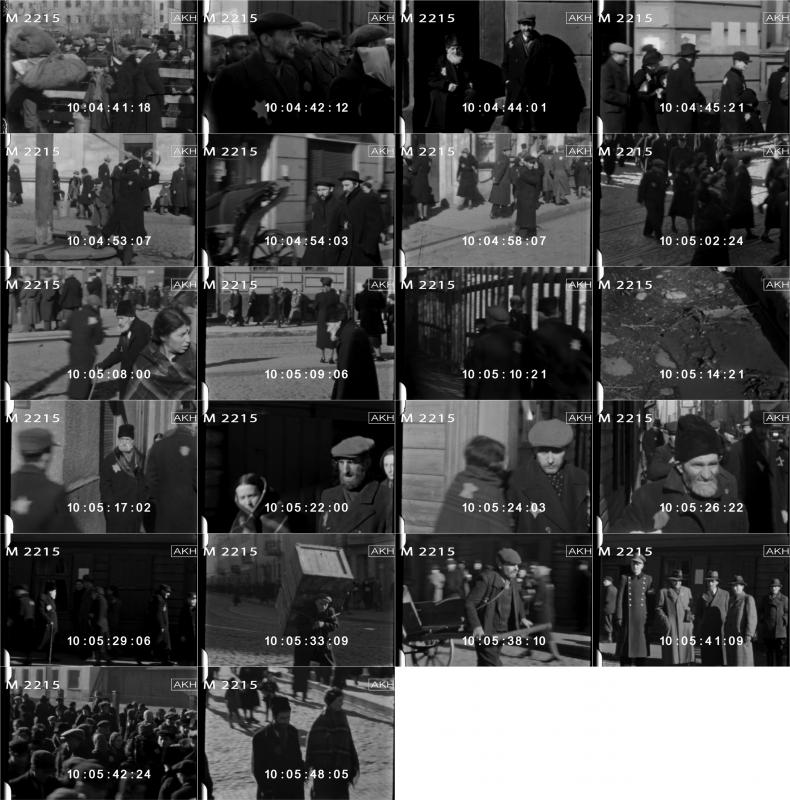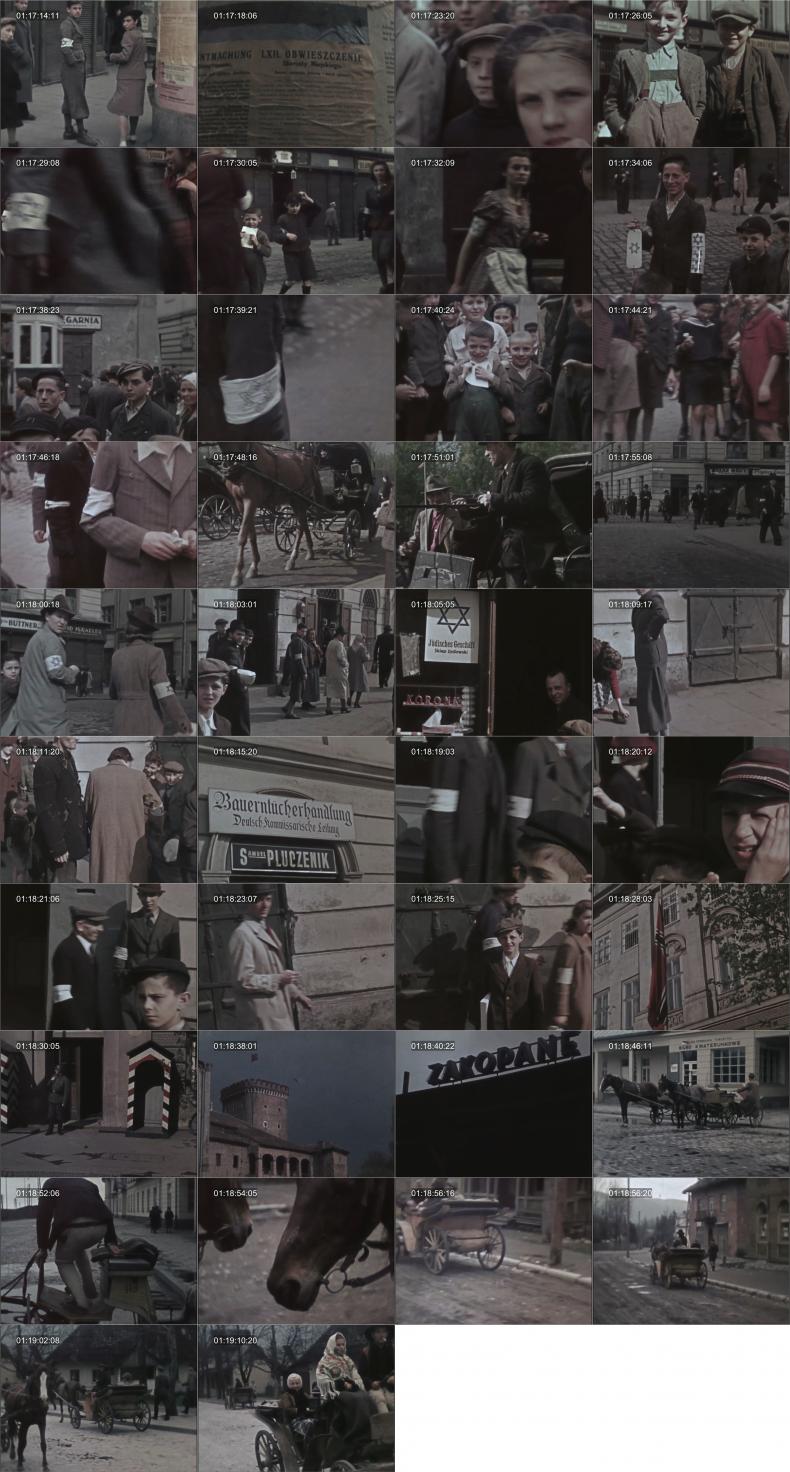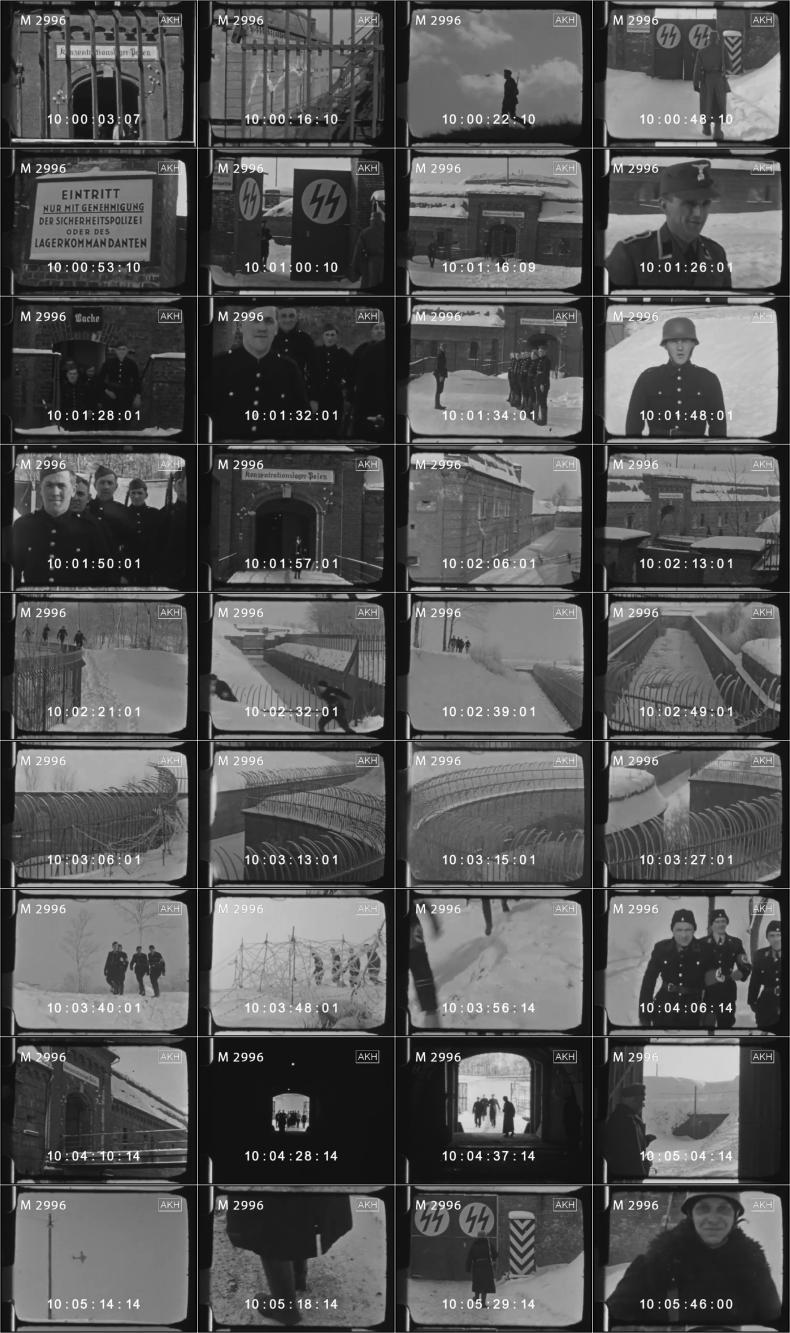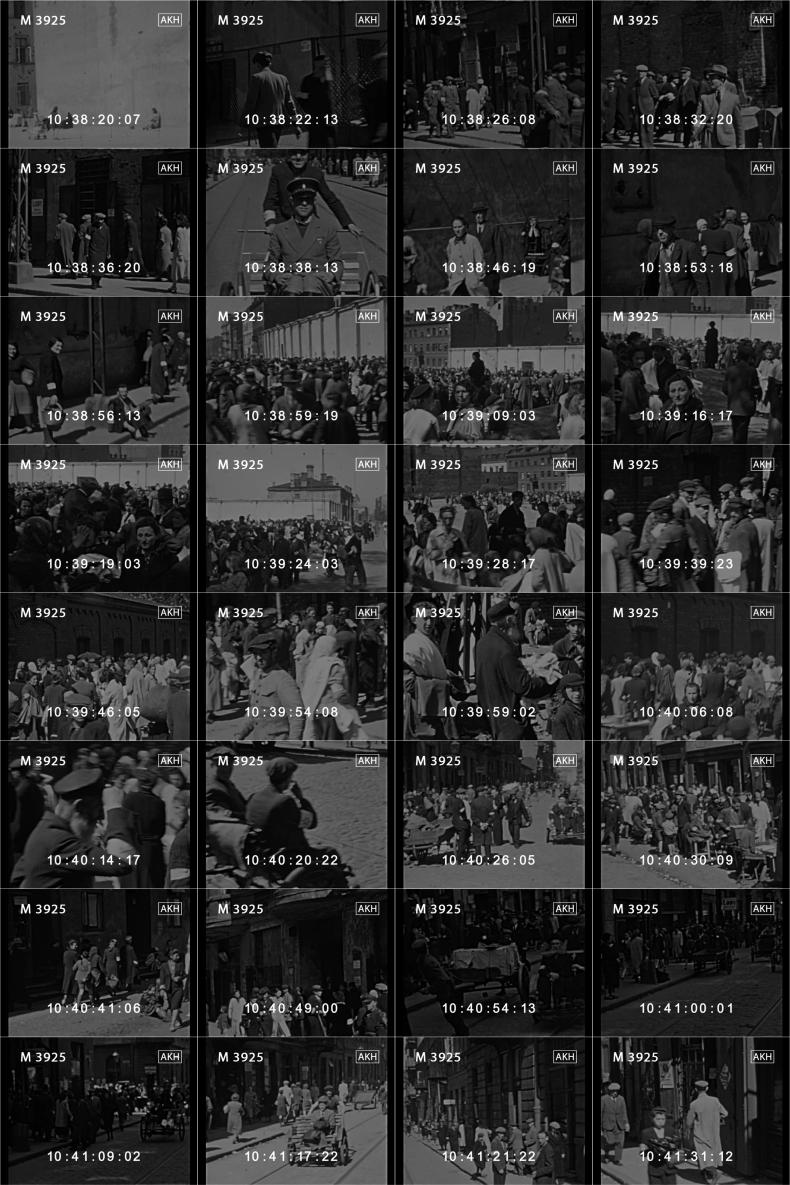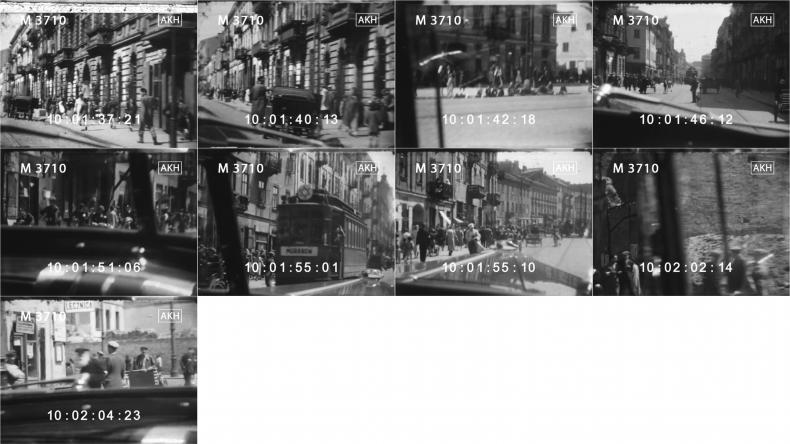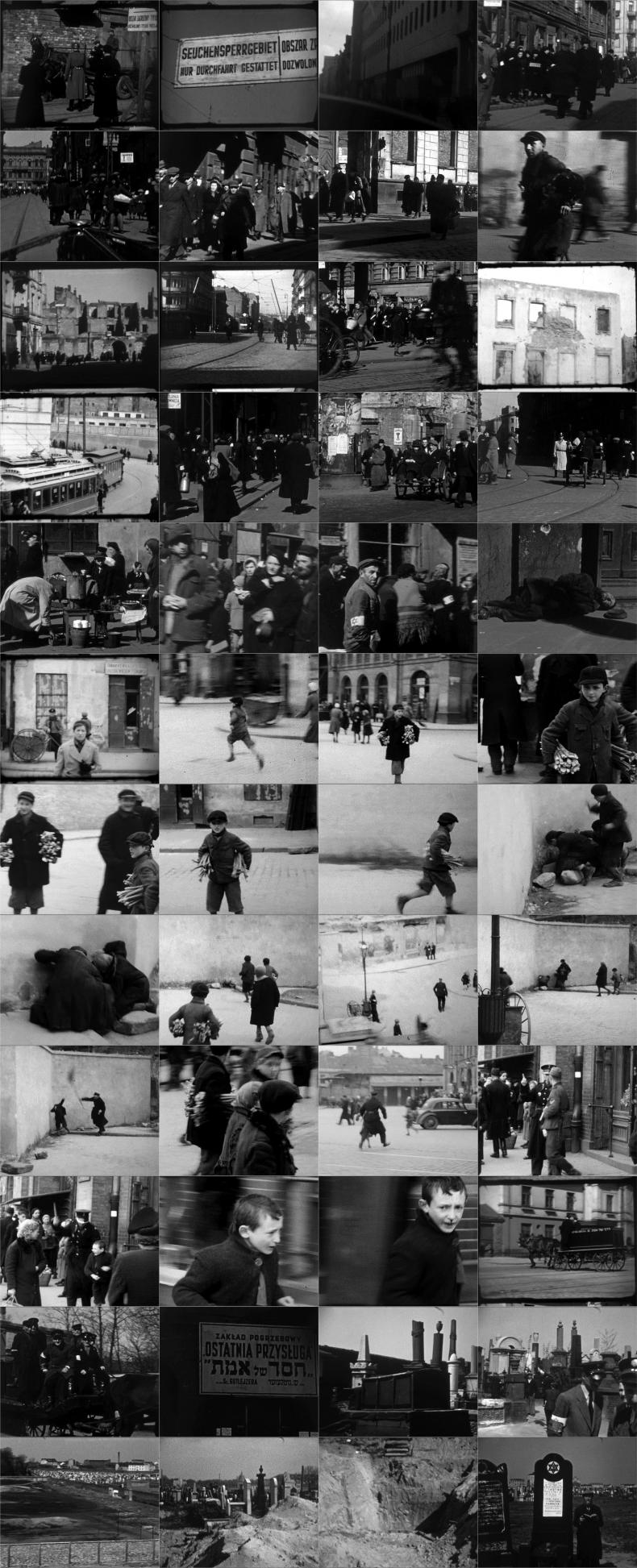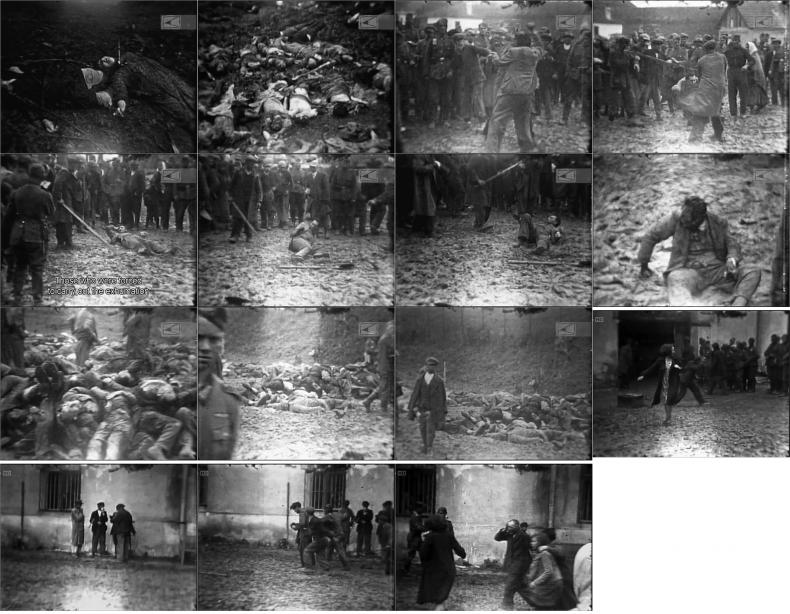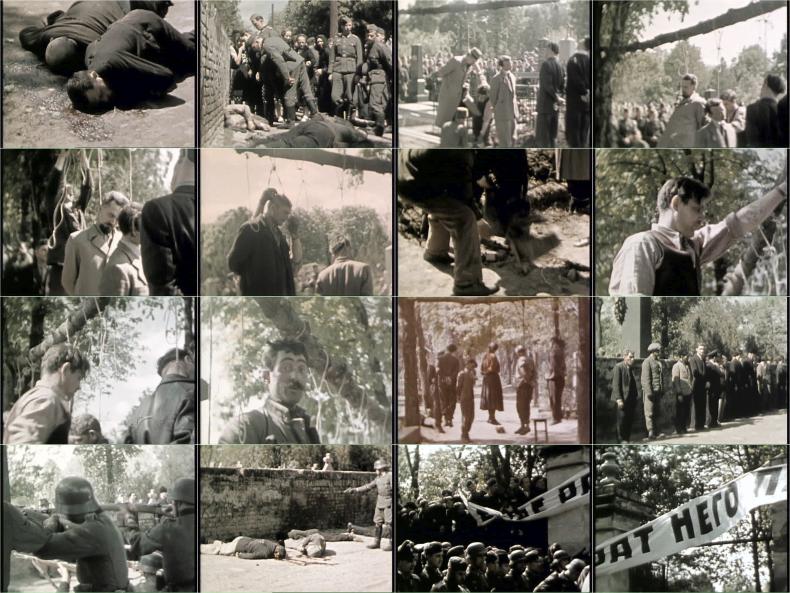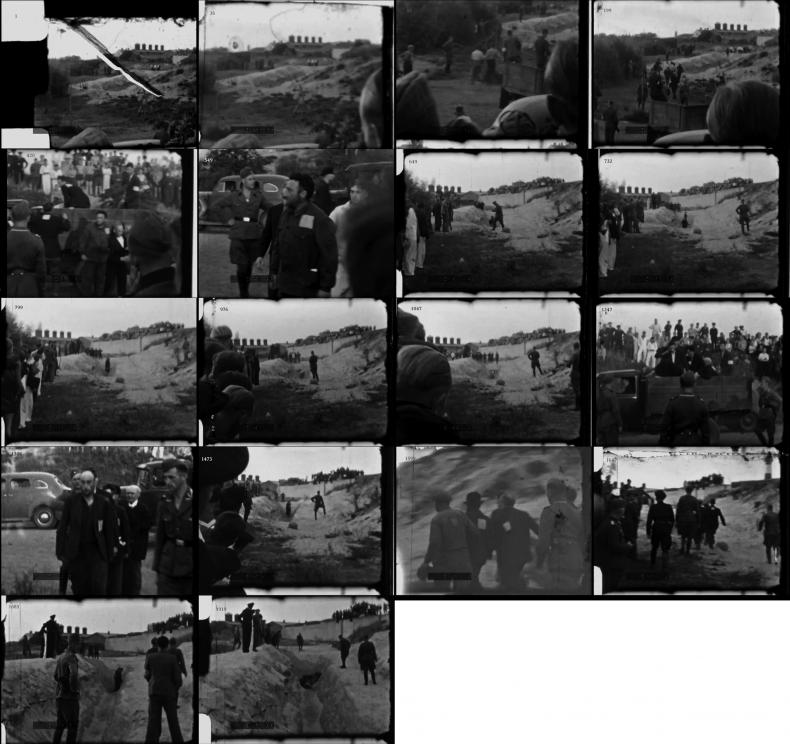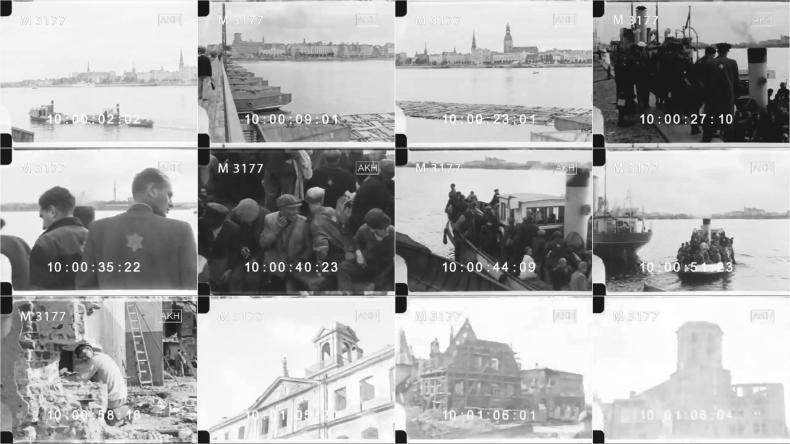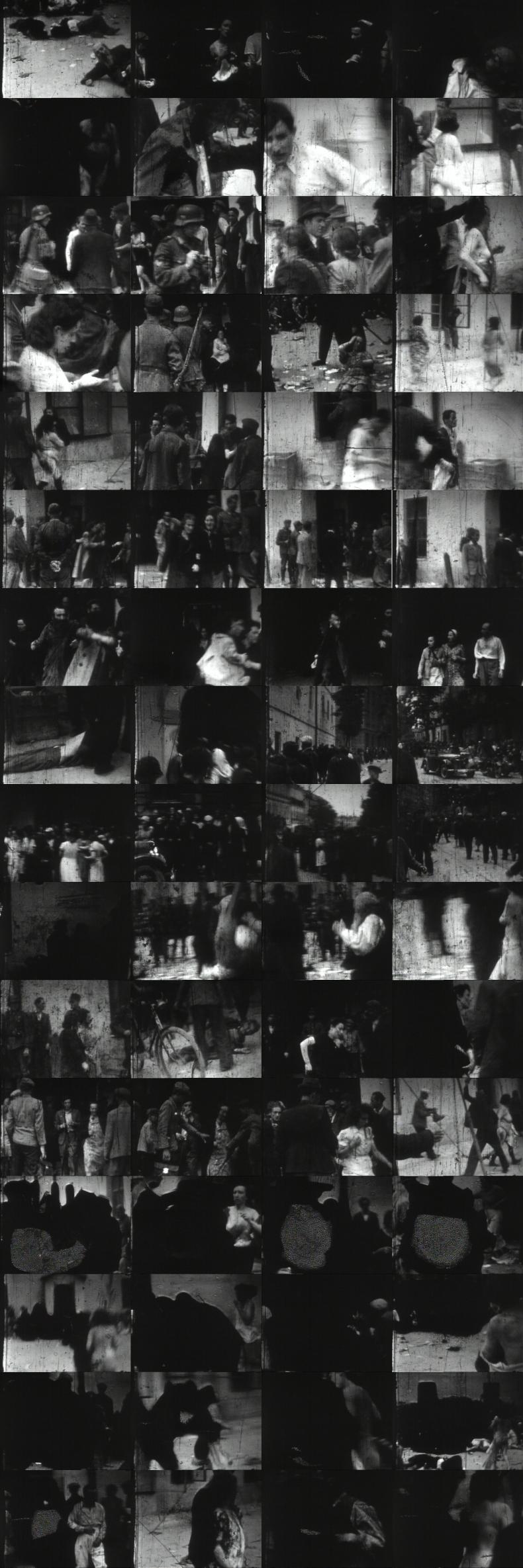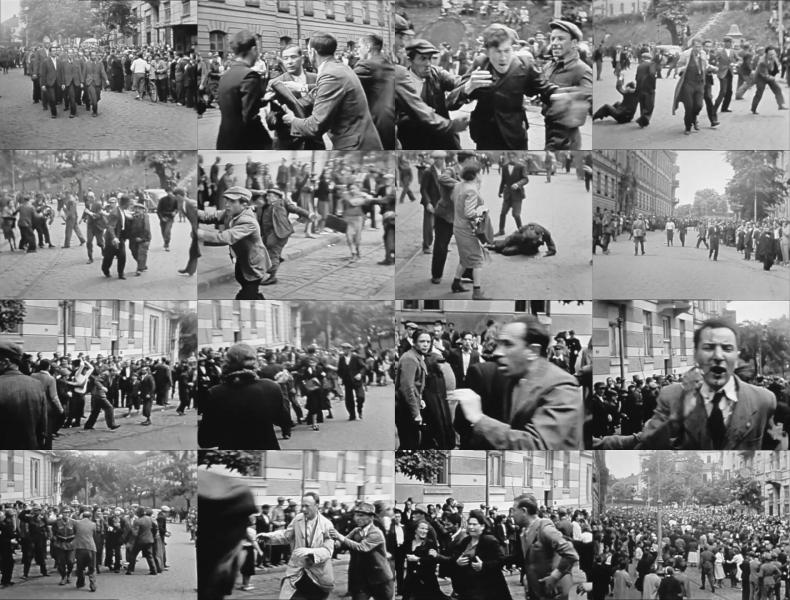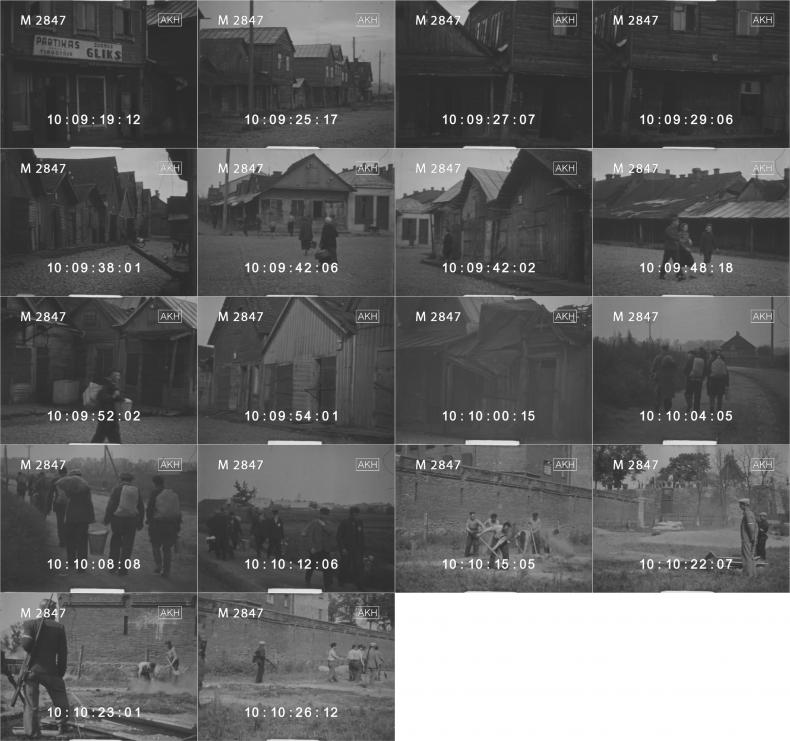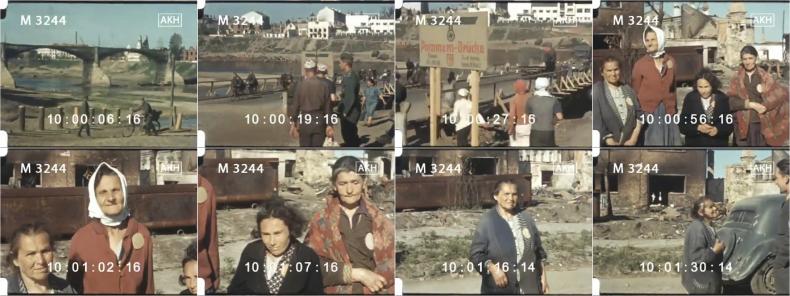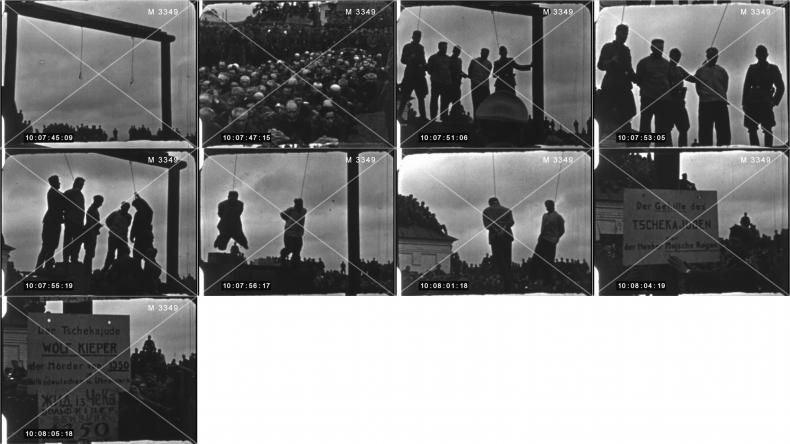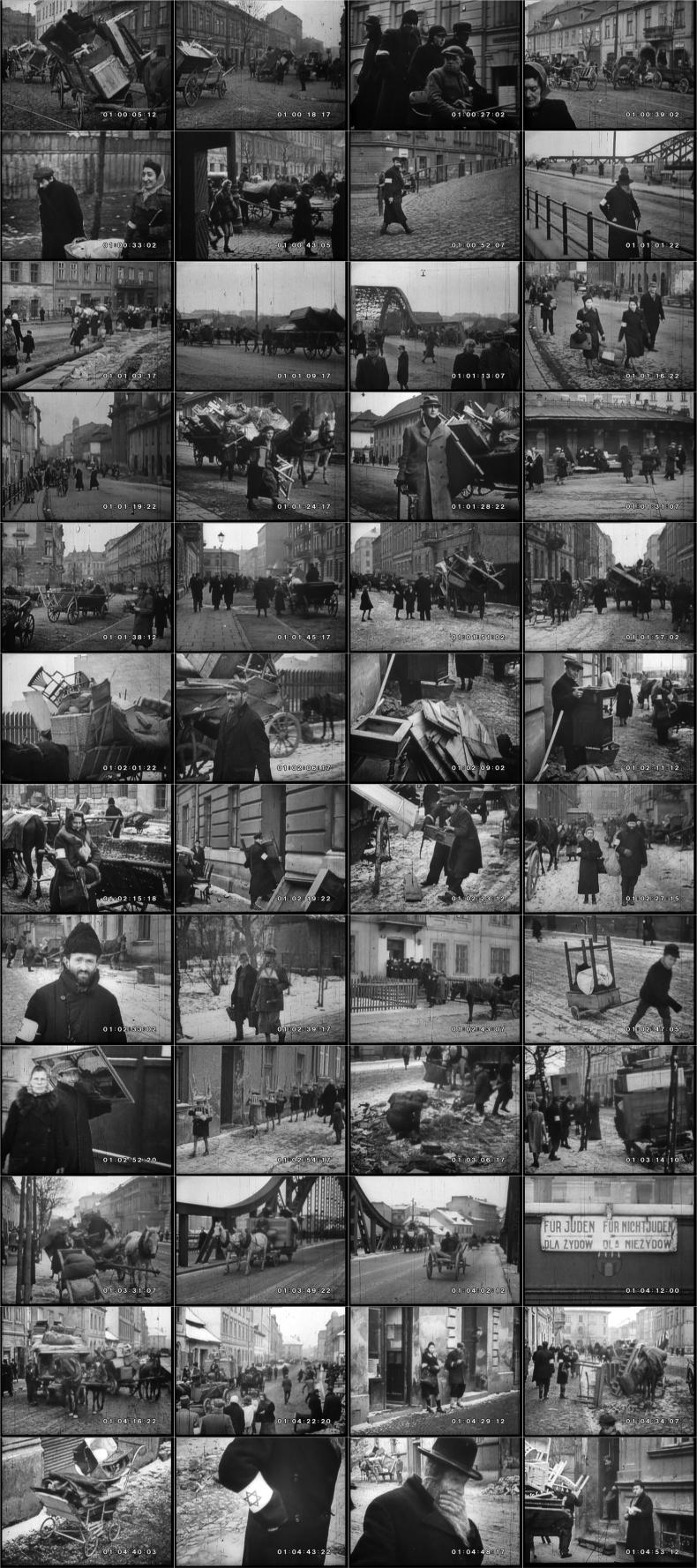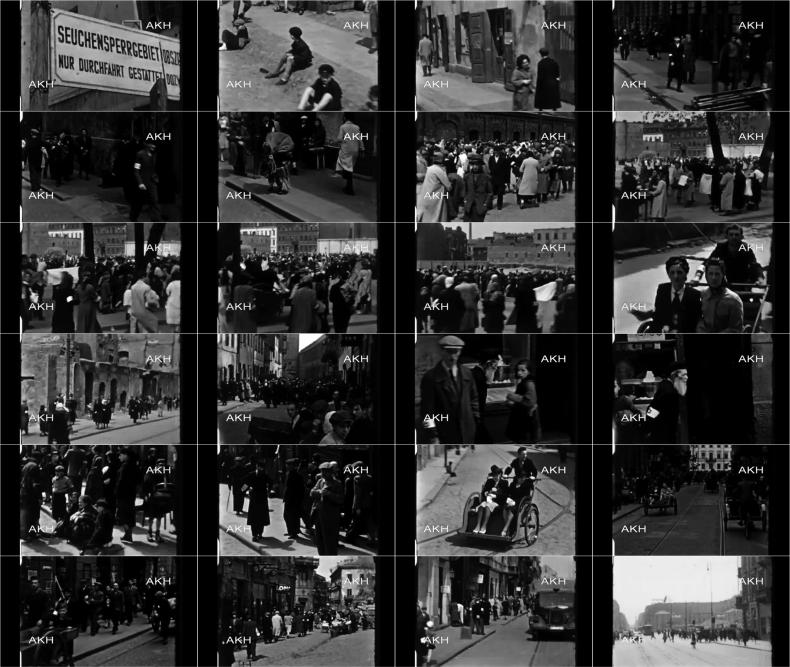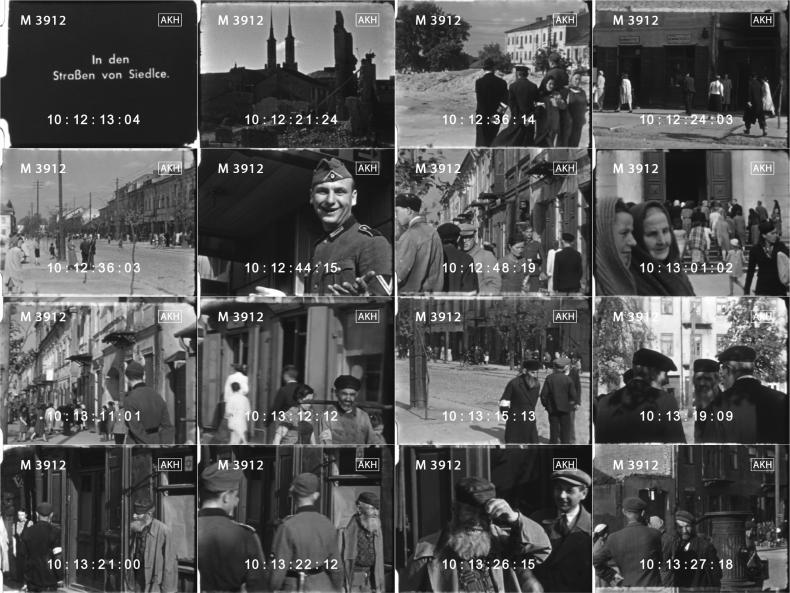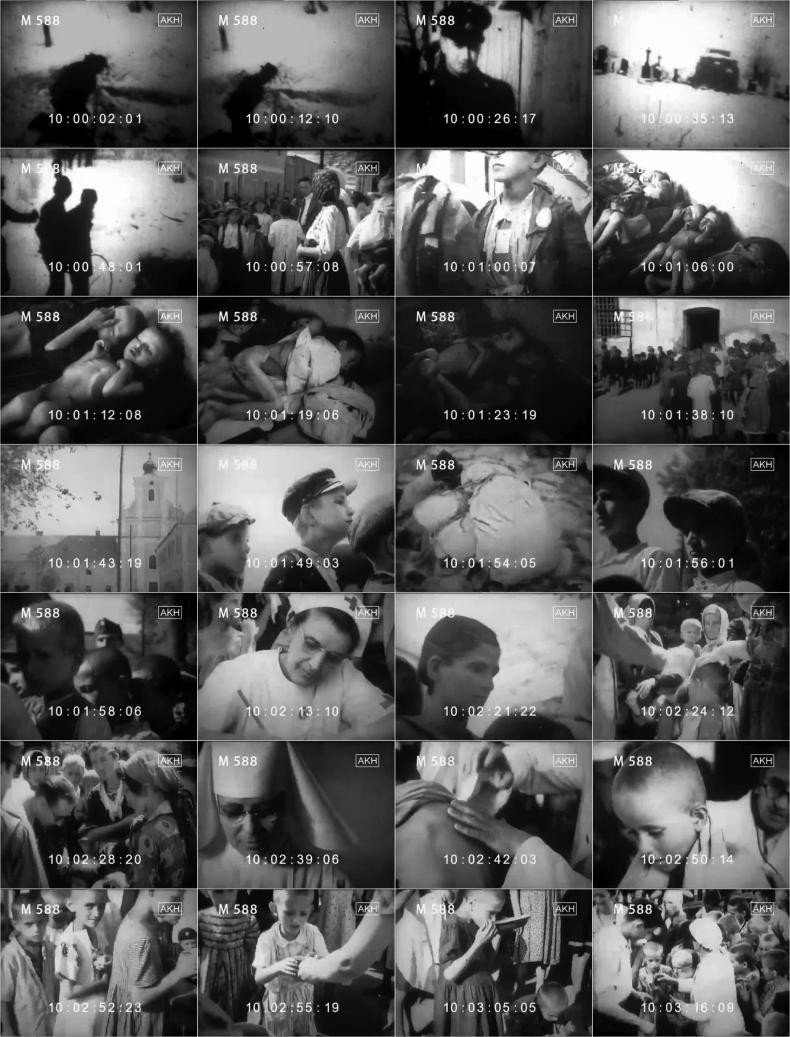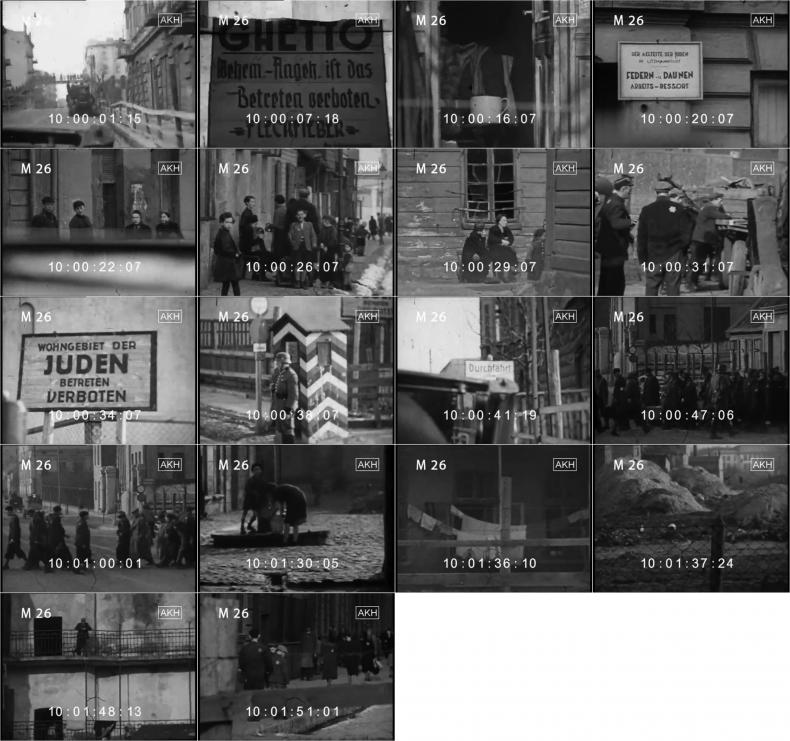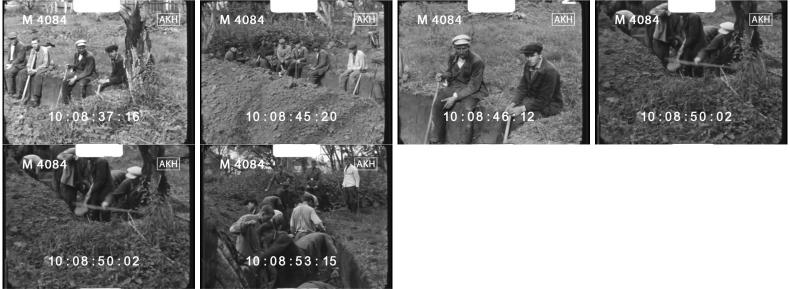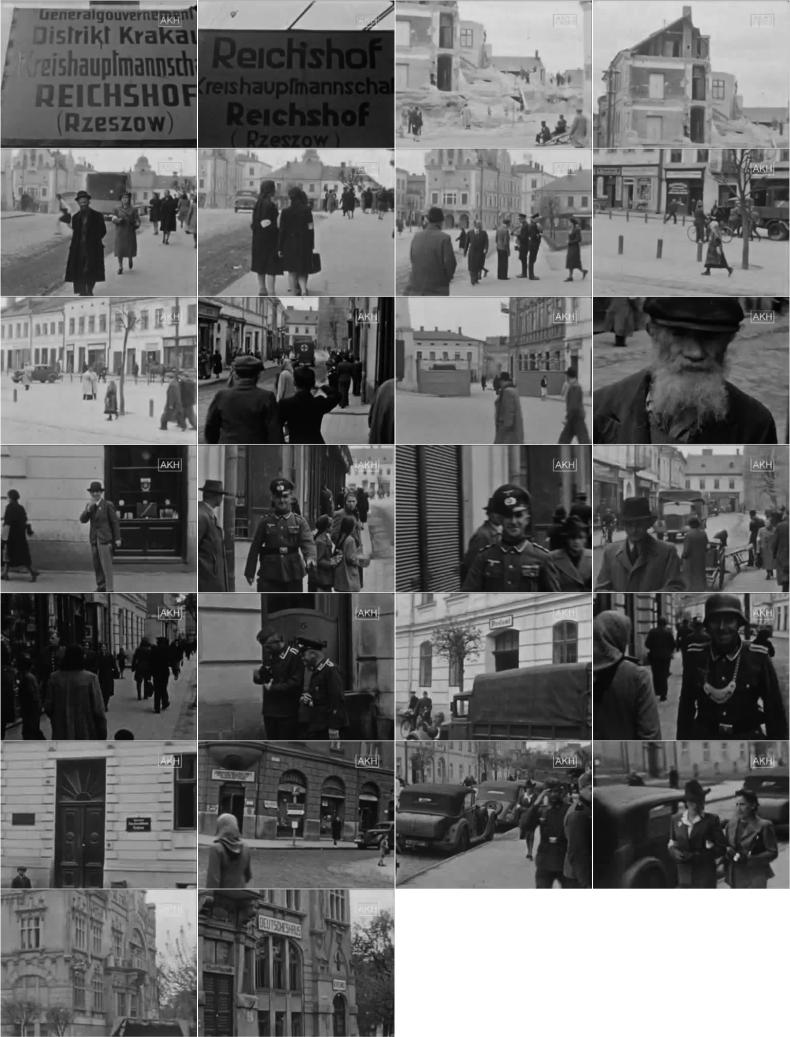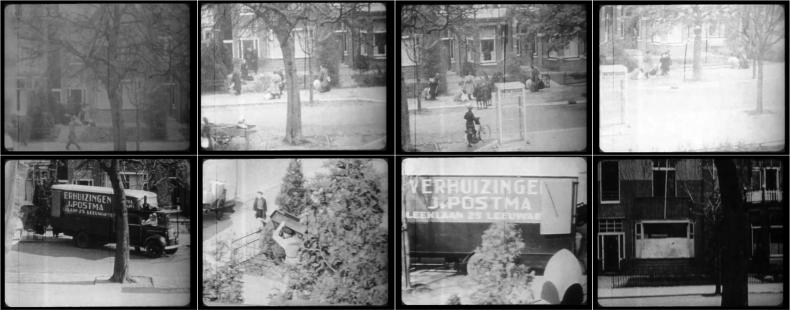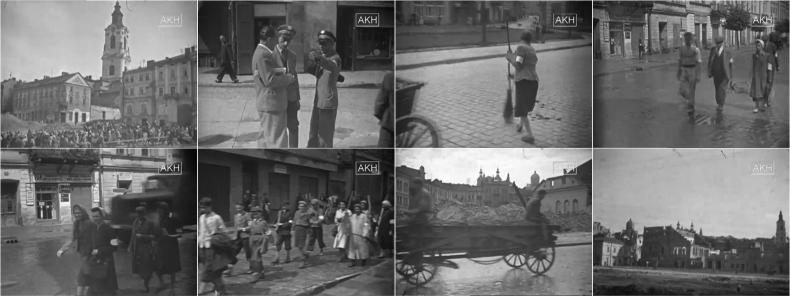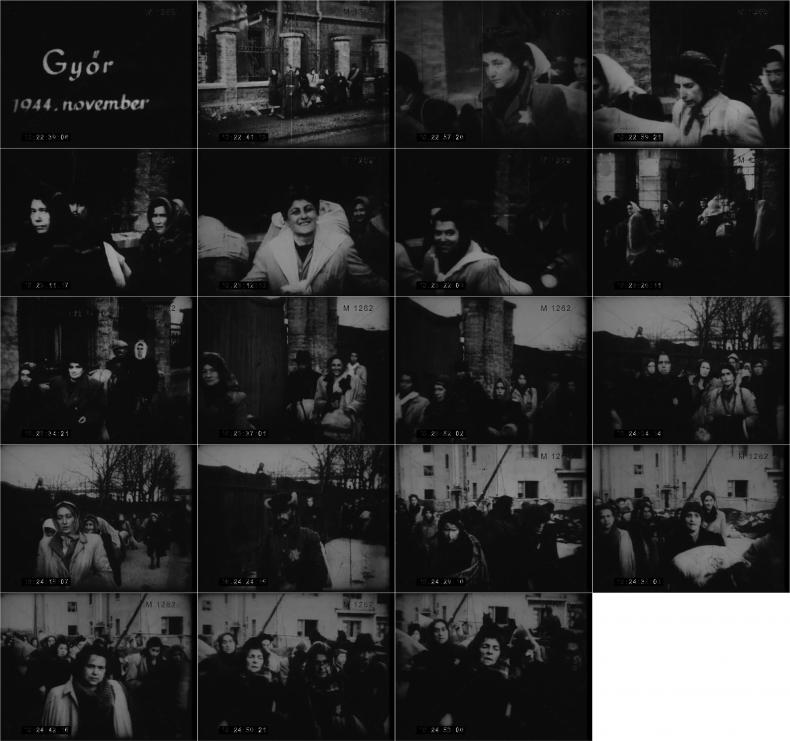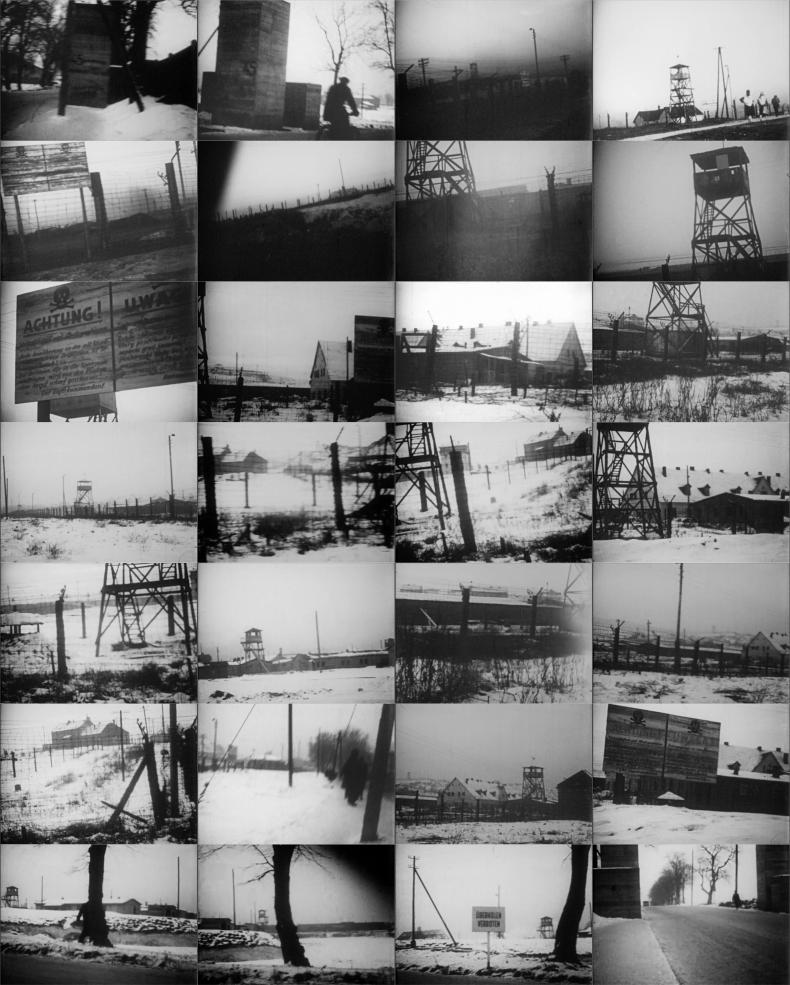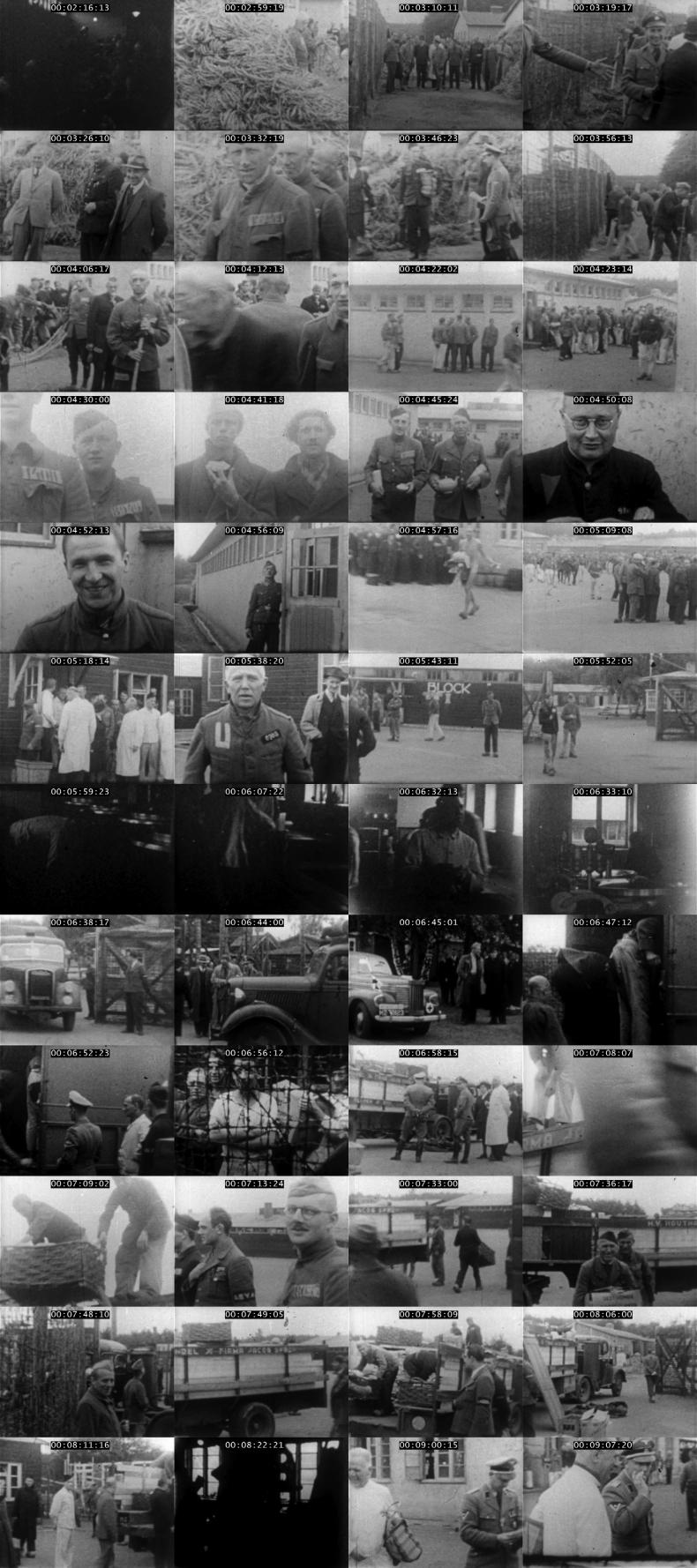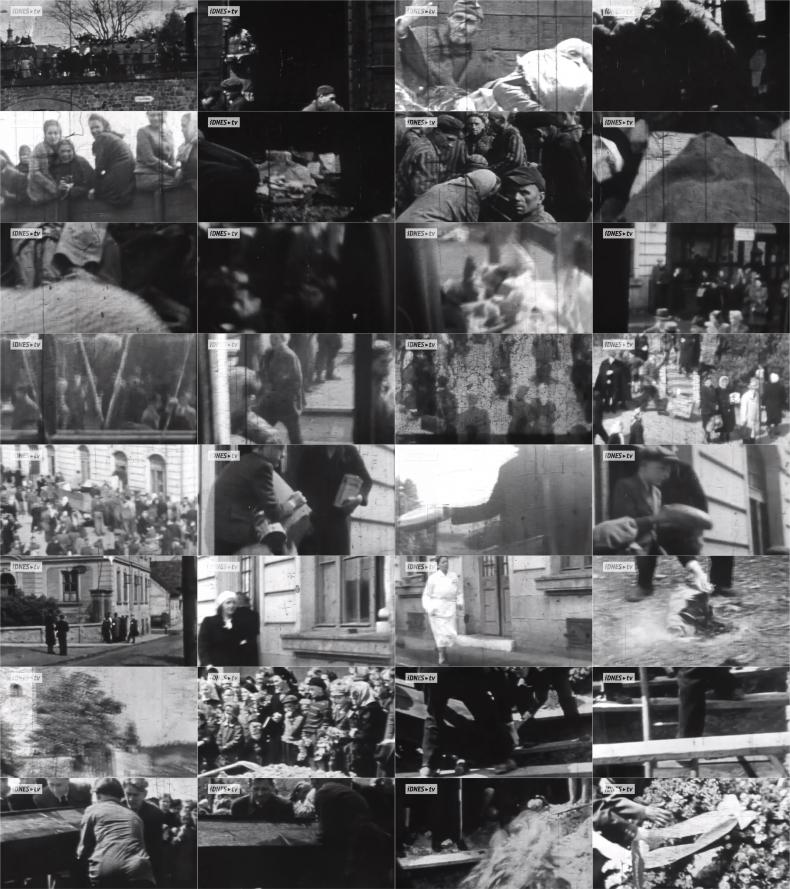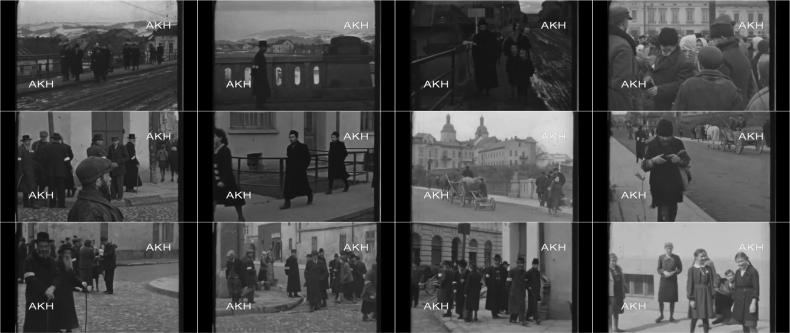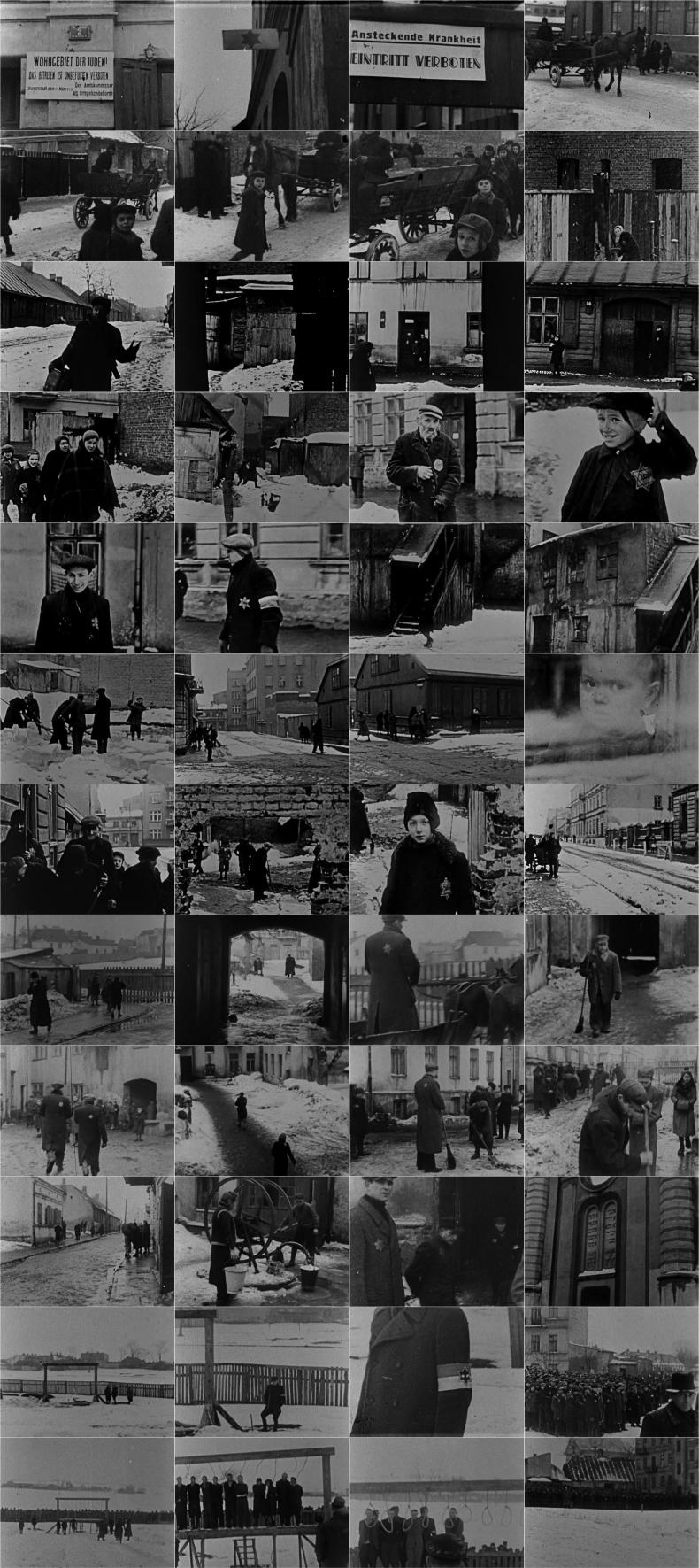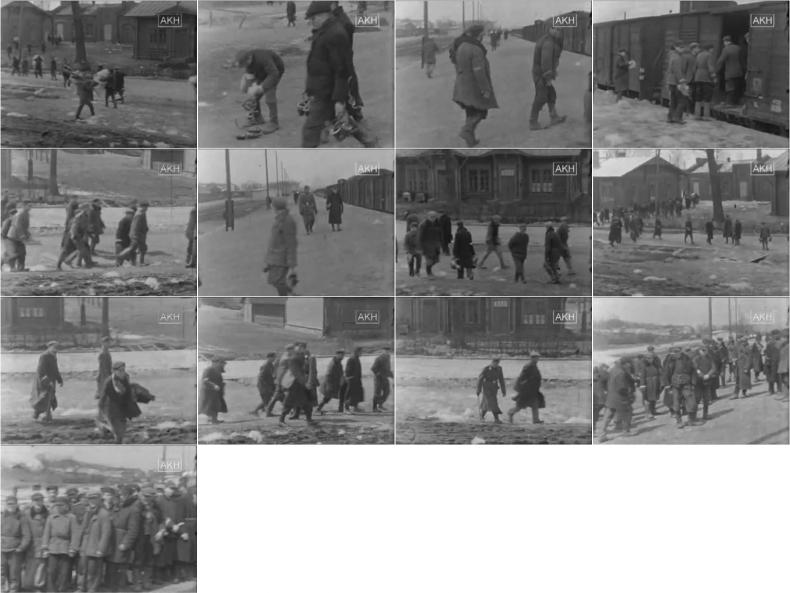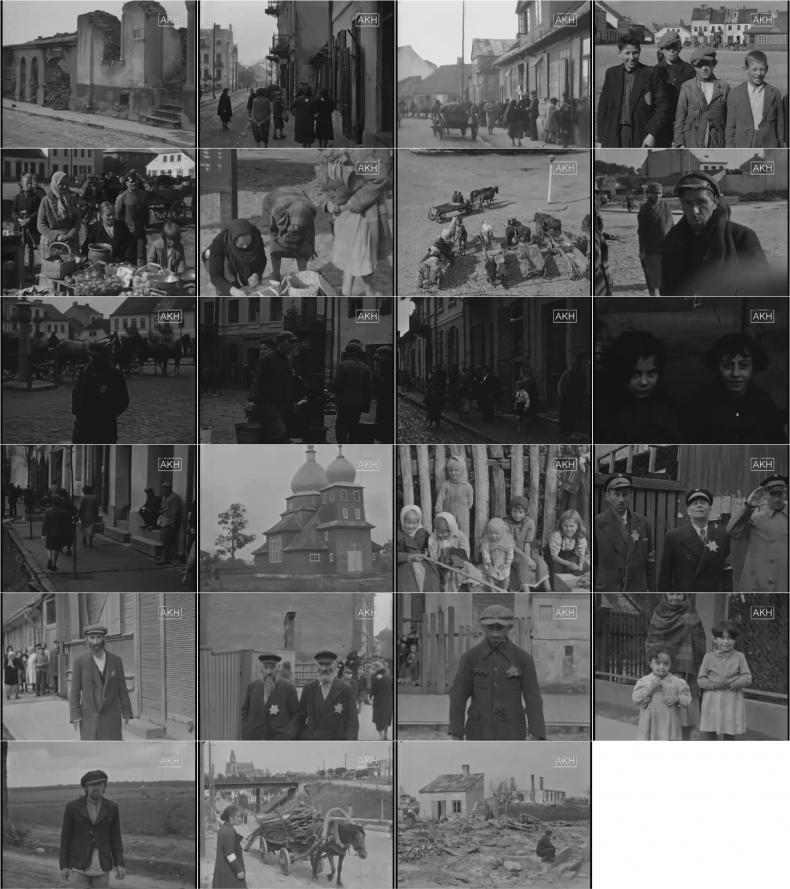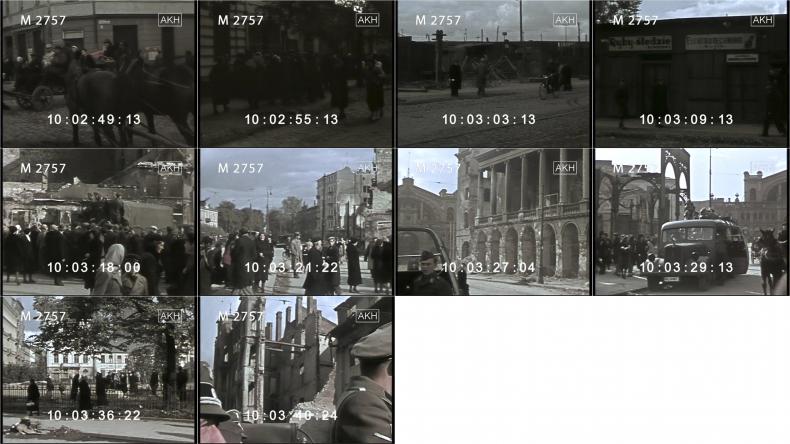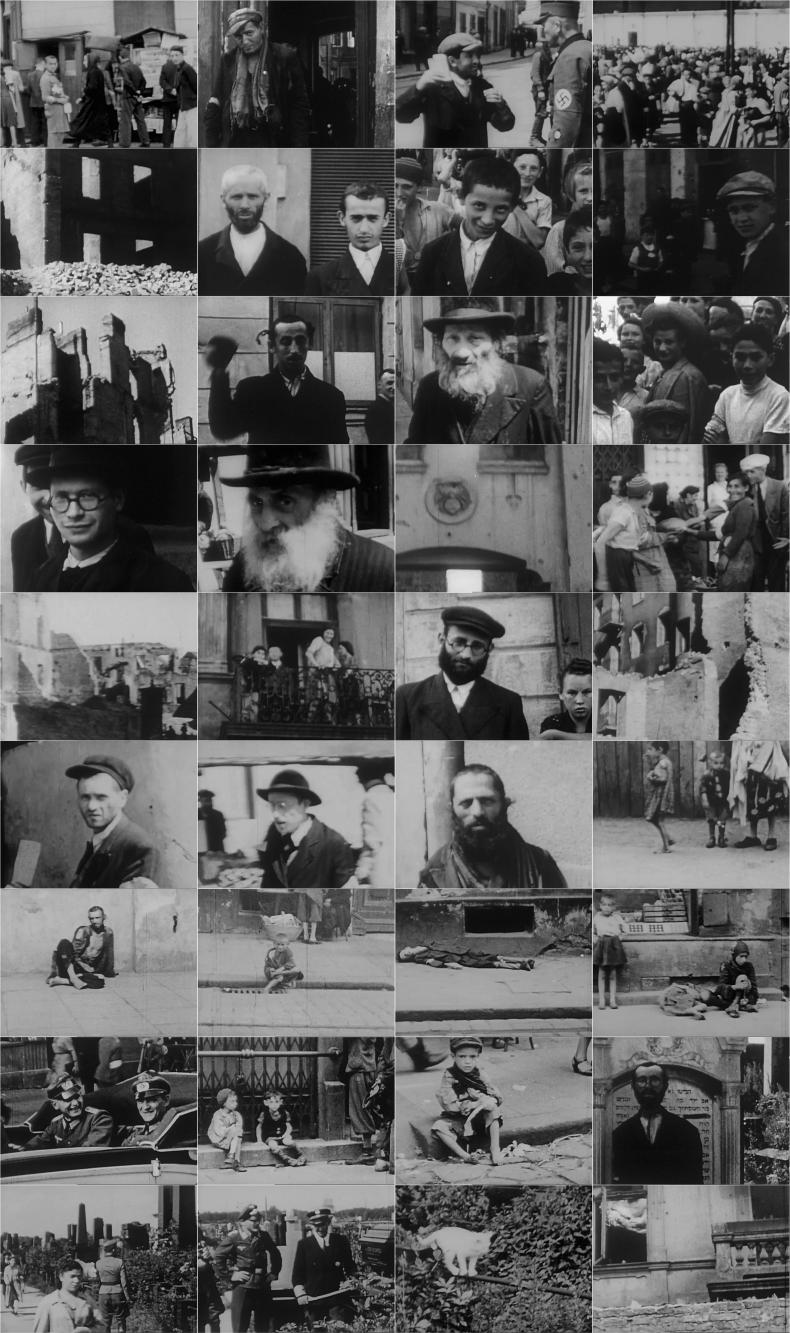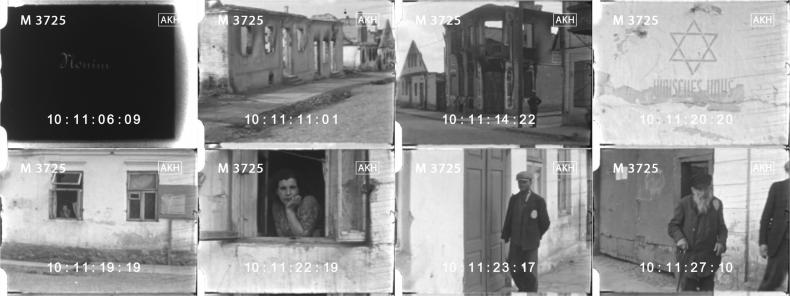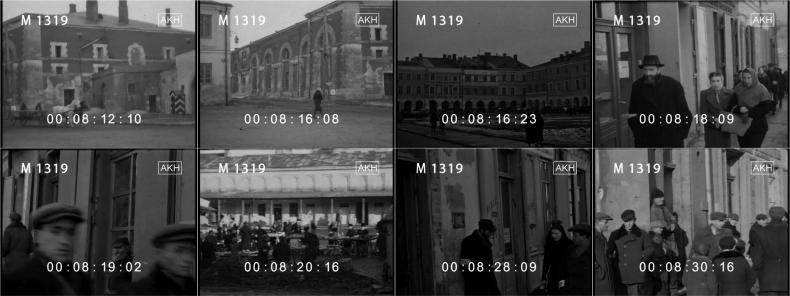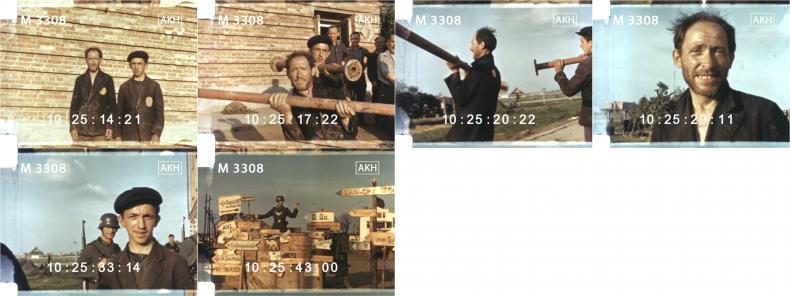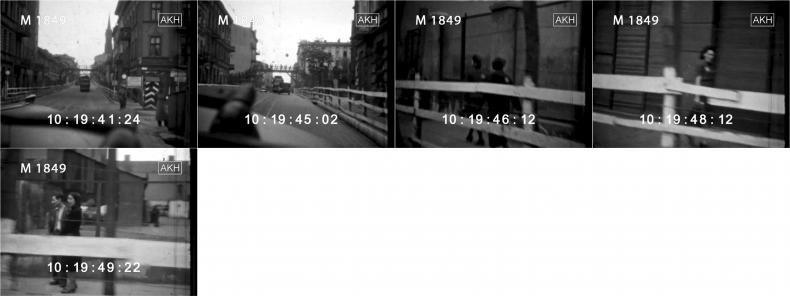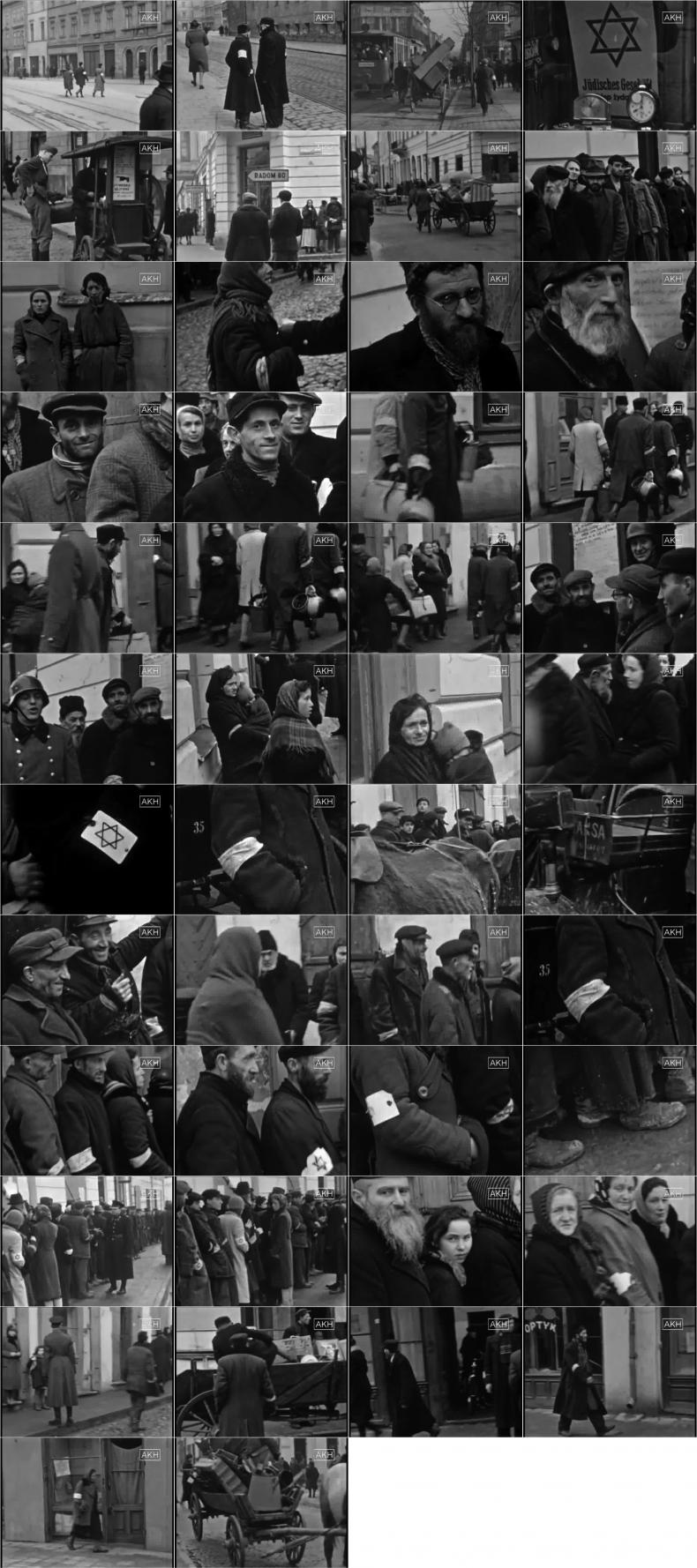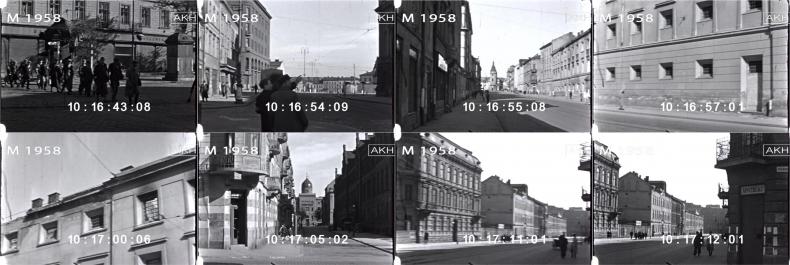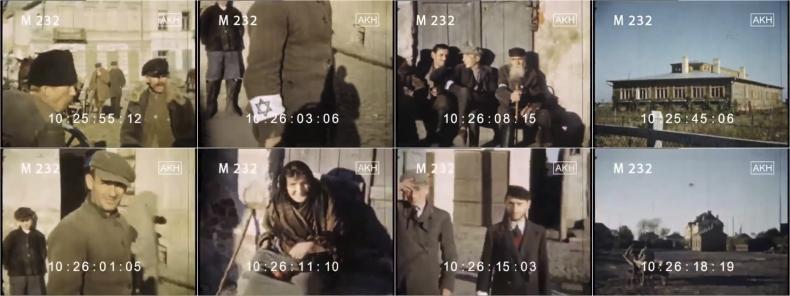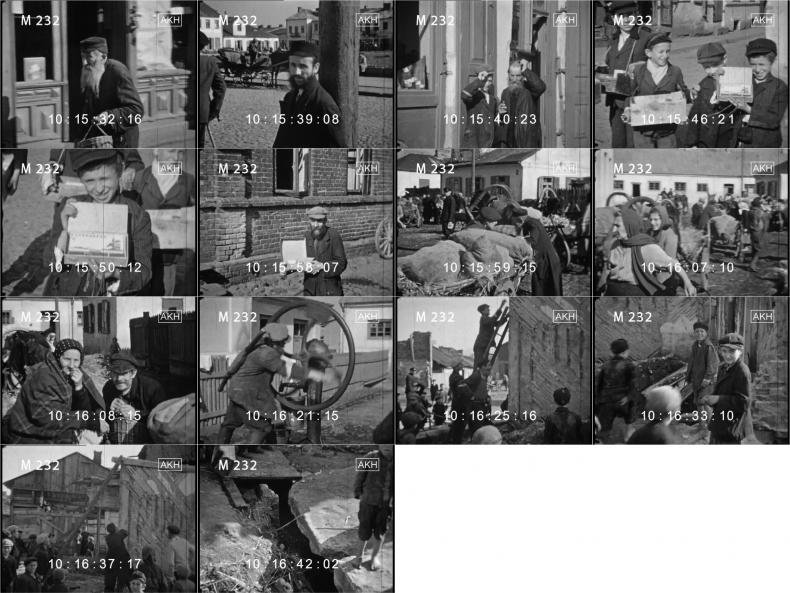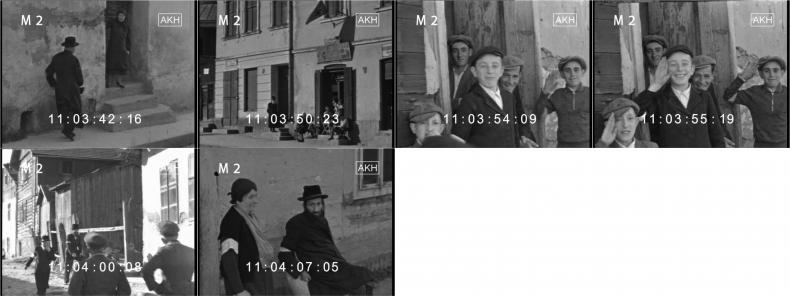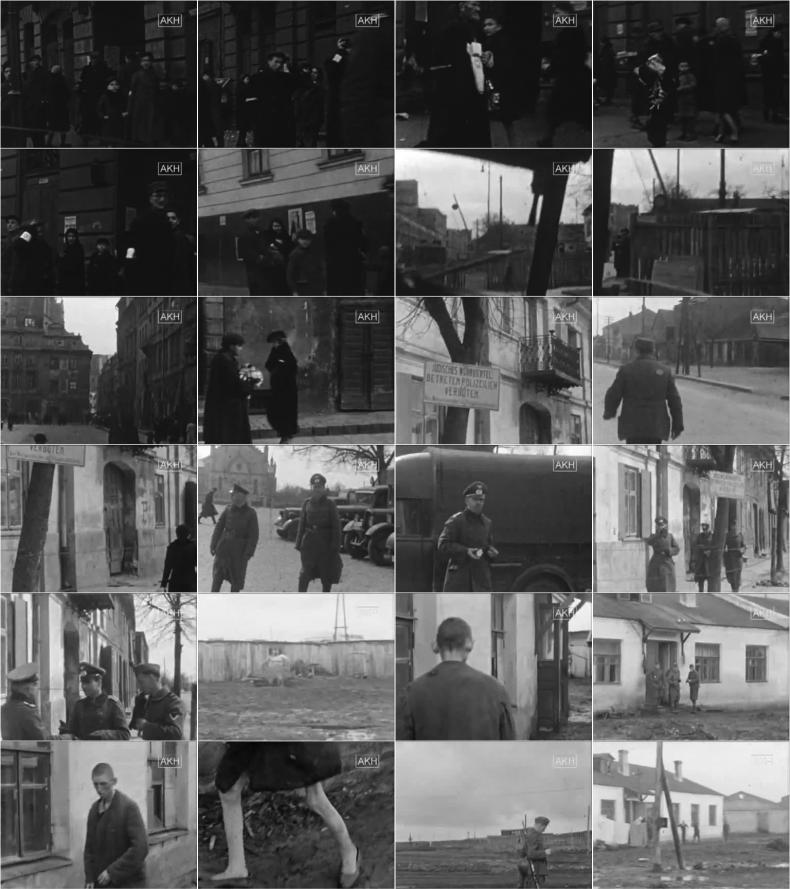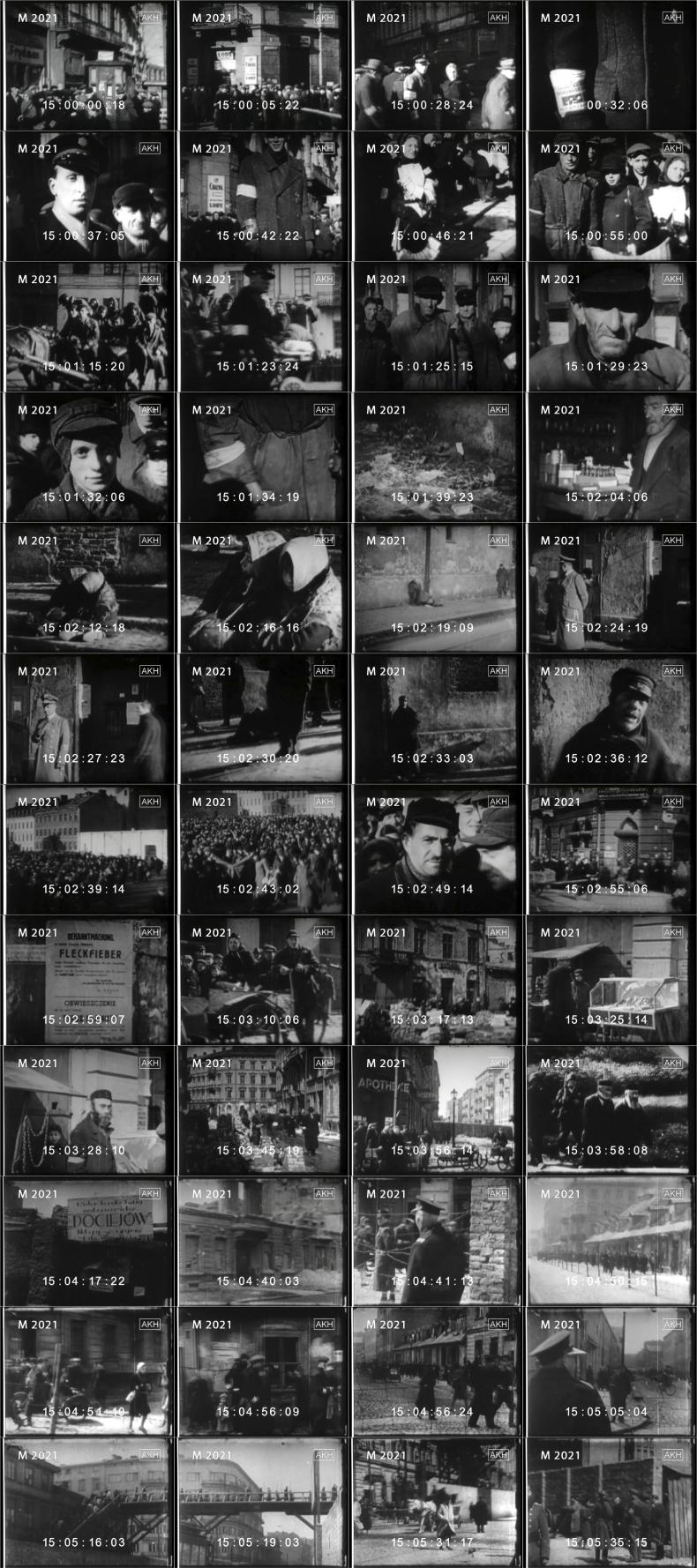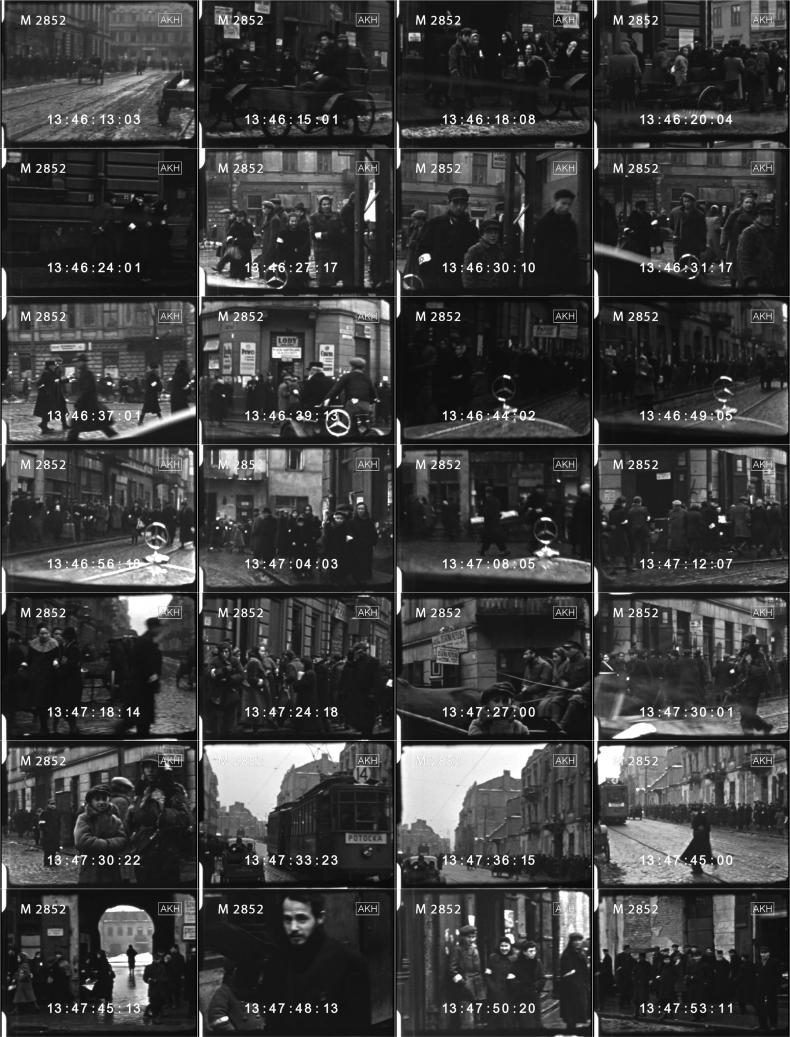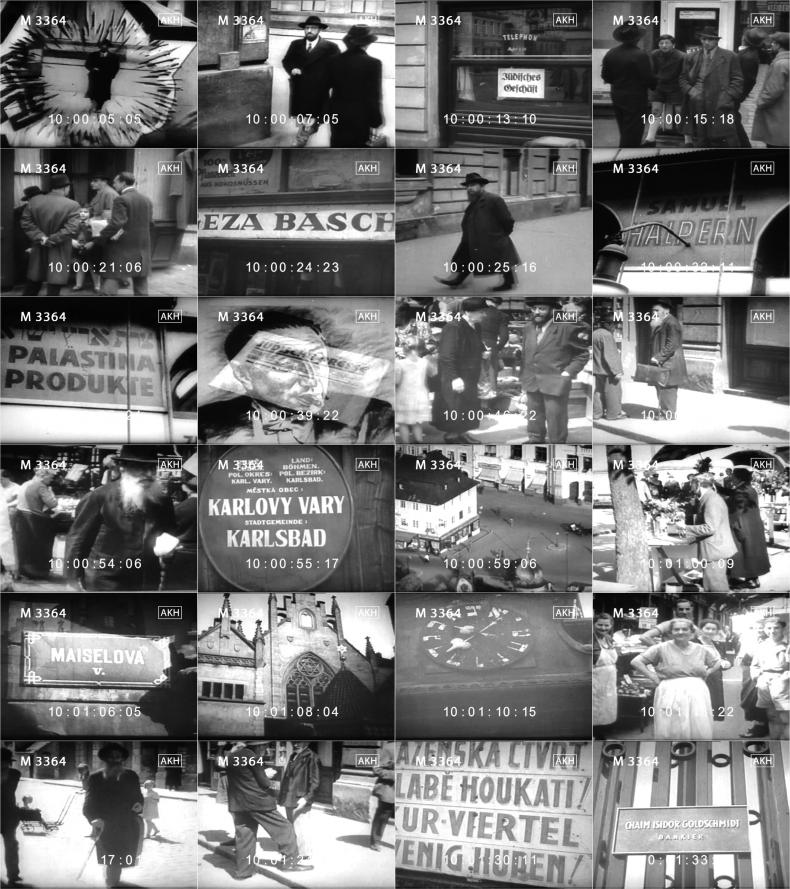Filmography of the Genocide
Official and Ephemeral Film Documents on the Persecution and Extermination of the European Jews 1933-1945
Table of Contents
Secret Publics
Digital Digging
Movie Theatre(s) of Memory
Filmography of the Genocide
Exacting the Trace
Destroyed Statues, a Bolex 16 mm Camera, and an Old Jeep
“…will you show that on your British television?” ACCEPTABLE LEVELS as Historiographic Metafiction
Work and Life
This is an Open Access article distributed under the terms of the CC BY-NC-ND 4.0 License.
Suggested Citation: Schmidt, Fabian, and Zöller, Alexander Oliver. “Filmography of the Genocide: Official and Ephemeral Film Documents on the Persecution and Extermination of the European Jews 1933–1945.” Research in Film and History. Audiovisual Traces, no. 4 (February 2022): 1–160. DOI: https://doi.org/10.25969/mediarep/18245.
Chapters
1. Introduction
2. The Schulberg Report
3. The Heydrich Decree
4. Sources for Moving Images from the Genocide
5. Towards a Forensic Cinema
6. Methodological Notes
7. Filmography (incl. map)
8. Bibliography
1. Introduction
By order of 12 November 1941, Reichsführer SS [Heinrich Himmler] has prohibited the taking of photographs during executions and ordered that, if such photographs were necessary for official reasons, the entire material be archived. (Reinhard Heydrich, April 1942)1
It has now been definitely established that at least one secret film on concentration camp atrocities and other Nazi cruelties has been made in Germany for a select audience of top Nazi officials. (Budd Schulberg, September 1945)2
Let them film! Let them film as much as possible! So a filmed documentation will remain of the situation brought upon a community of four times 100.000 Jews! They have the ability to create such a document. The editing and commentary are unimportant. They should leave a sneak view of the Jewish passerby on the crowded streets in the movie. The faces, the eyes that in future years will shout out in silence. They should all be commemorated; the droves of beggars, the people of yesterday slowly dying from the hardships and starvation in the closed ghetto. And another thing, the main one – they should add the German participants in this drama. They are the lead actors in this play. (Diary of Rachel Auerbach, 1942, p.3.)3
One of the self-evident and most prevalent historiographical assumptions tied to the Holocaust is that close to no film footage and photographs from the actual process of annihilation survived. Even the very notion that such material was produced in the first place has on occasion been dismissed: Why would the perpetrators have decided to leave such palpable evidence of their crimes? The assumption of the non-existence of film records seems to be supported by the few published filmography stubs such as the one from Jean-Michel Frodon (Cinema and the Shoah, 2010) which comprises no more than 40 archival convolutes and propaganda films. The finding aid “Jüdisches Leben und Holocaust im Filmdokument 1930–1945” (“Jewish Life and Holocaust in Film Documents 1930–1945”) compiled by the German Bundesarchiv lists quite a large number of archival materials, including newsreels, though often without clear references to provenance or whereabouts and with a rather vague focus.4 To the best of our knowledge, no prior effort has been undertaken to compile a comprehensive list of archival film material related to the genocide, including film materials which are only mentioned in contemporary sources, or which were only reported by witnesses after the war. A tabulation which encompasses lost films, if indeed there is considerable evidence for them, is bound to upend the prevailing notion that filming during the genocide was highly exceptional and mostly carried out in the handful of instances surviving as archival material today.
The reasons for the reluctance when it comes to filmic or photographic evidence of the Holocaust are manyfold and range from fear of the content to a hope for a lack of evidence due to a guilt-conscience on side of the perpetrators. Often, the alleged absence of cameras in the camps and ghettos ostensibly underlines the clandestine character of the genocide, as in Gideon Greif’s text about Lili Jacob and the Auschwitz Album, where he describes the arrival of the transport to Auschwitz-Birkenau from May 24, 1944 that was photographed for the so-called Auschwitz Album:
They held no revolvers or whips in their hands; instead, they were holding something that, until that day, had never before been seen in Auschwitz Birkenau when Jewish transports arrived – a camera. Such an instrument in this place, which for the Nazi regime was the most clandestine and secret, had to be considered a very exceptional occurrence.5
In fact, cameras and even film cameras were anything but an unusual sight in Auschwitz. Like Mauthausen, Westerbork, Theresienstadt, Dachau and many other camps and ghettos, Auschwitz had official photographers and a photo laboratory.
Possibly, this above mentioned scarcity of filmographic treatment is also connected to the disputes about the impossibility of a representation of the Holocaust which saw one of its peaks unfold around Claude Lanzmann’s cinematic milestone SHOAH (F/UK 1985) and the subsequent discussion about perpetrator footage in the context of Holocaust remembrances. Explicitly, the search for photographic evidence of the Holocaust in itself was equated with a tacit attempt to deny it.6 Today, the issue of permissible representation of the actual events appears to have changed. Given today’s knowledge about censorship of liberation footage on both sides of the Iron Curtain (e.g., the cancelled British production GERMAN CONCENTRATION CAMPS FACTUAL SURVEY and the largely censored Majdanek film of Aleksander Ford7), the question arises whether avoiding direct representation doesn’t run the risk of perpetuating such censoring practices. The discussion about the representation of the Holocaust today is less ideologically charged, which perhaps is also connected to the fact that it is much less in the center of attention. And also the proponents of the representation argument changed their attitude. SON OF SAUL (H 2015) for example visualised the mass murder in Auschwitz, and eventually even Claude Lanzmann approved of it.8 Claude Lanzmann, who became famous for his seminal ten-hour documentary SHOAH, exclusively consisting of testimony, even reconsidered his rejection of archive footage during the last phase of his career. The surprising, if scarce use of archival footage in his last documentary THE LAST OF THE UNJUST (FR 2013) perhaps can be considered as part of this broader shift of paradigm.
There also seems to be gradual change starting to happen in the pop-cultural approach to archival footage from the Holocaust. While the dominant historiographical discourse and even more the public remembrances are either busy ignoring or mourning the allegedly missing films and photographs, documentaries shown during film festivals like the very recent À PAS AVEUGLES / FROM WHERE THEY STOOD (Christophe Cognet, FR 2021) or Mar Targarona’s feature film EL FOTÓGRAFO DE MAUTHAUSEN (ES 2018) deal with filming and photography in the concentration camps and with the fact that it was, not unlike today, widely ignored at the time.
Strikingly, photographs and film stills showing German atrocities were circulated outside the Third Reich as early as 1941. Photographs from the reprisal execution in Pancevo for example already appeared in a Soviet propaganda leaflet, shown below, printed in the summer of 1941, only months after they were taken. These photos were most likely found among the belongings of a dead or captured German soldier who possibly had bought or traded them from another soldier. A large collection of 200 photographs with hanged or mutilated civilians and POWs can be found in the brochure “Soviet Documents on Nazi Atrocities,” published in 1943 in Great Britain. In the same year, the British short film CALLING MR SMITH (Franciszka and Stefan Themerson) used such photographs and even film footage from the ghettos in Poland in order to accuse the Germans of atrocities in the East.
So, perhaps, it is also time for historiography to acknowledge the fact that there has been, ‘and still is,’ a lot of photographic and film evidence of the genocide, much of which is still waiting to be fully analysed and assessed.
The beginning of the process which led to the filmography we are presenting here was the research for our still-ongoing documentary film project ATROCITY FILM.9 Intrigued by a status report by US Lt. Seymor W. (“Budd”) Schulberg from September 1945 and a fairly overlooked decree by Reinhard Heydrich from April 1941, we started to gather any traces of film activities in the context of the persecution and the genocide the Germans had unleashed mainly in Eastern Europe between 1941 and 1945. Schulberg claimed in his report to have found believable traces and testimonies of an Atrocity Film, a secret SS film project documenting the Holocaust. Reinhard Heydrich, cited above, in 1942 specified Himmler’s ban of photography during executions, originally issued in November 1941, and emphasised an aspect of Himmler’s initial decree that so far has not been acknowledged by historians: the order that all films and photos of executions were to be sent to and centrally collected at the RSHA (Reichssicherheitshauptamt) SS headquarters in Berlin. The combination of these two documents called for a broad search for traces of these archive films. We were successful in finding traces, much more than we had imagined. While the filmography we gathered this way merely served as proof for the theory of the Atrocity Film, it became clear to us that the majority of these film materials had not been acknowledged by historians, not to speak of the vast amount of footage mentioned in official and personal reports that has not yet surfaced and that indicates an almost seamless documentation of the genocide through its various stages. Hence, we decided to publish a full filmography, a filmography of the genocide, as we’d like to call it in order to distinguish it from Ronny Loewy’s Cinematography of the Holocaust, which has a far broader approach (including fiction film) and which at some point will be the larger host archive for our much smaller, specific collection.10 This introductory text is about our initial reasons to produce this filmography but at the same time seeks to point to the various opportunities this collection offers. Our latest publication “Atrocity Film” in Apparatus Journal gives a broader overview on the hypothesis of the SS Film and its traces uncovered so far.11
2. The Schulberg Report
During World War II, U.S. Navy Lt. Budd Schulberg was assigned to the Field Photographic Branch of the Office of Strategic Services (OSS), the direct precursor of the Central Intelligence Agency (CIA), working with John Ford’s documentary film unit. In 1945, Ford gave Schulberg and his fellow officer Ray Kellogg the order to locate incriminating motion picture film evidence that could be used against the Nazi perpetrators at the Nuremberg trials. Schulberg’s mission resulted in the OSS War Crimes Project amassing a considerable body of newsreels, documentary and propaganda films as well as photographs and other records, many of which had been seized from captured Nazi sources. In September 1945 Schulberg filed a report for his OSS superiors in which he gave a detailed account of any such efforts undertaken thus far.12 In section III. he lists what he calls “films of German atrocities” or simply: “Atrocity Film.” Under subsection D “German sources” he states that
[...] it has now been definitely established that at least one secret film on concentration camp atrocities and other Nazi cruelties has been made in Germany for a select audience of top Nazi officials.13
In the following pages of the report Schulberg explicitly names several sources who claim to have either seen the film or at least have knowledge about participants, content, and possible whereabouts of the physical film elements. Schulberg further reports that his efforts to find the film had been unsuccessful thus far, as three of the film storage sites of the former Reichsfilmarchiv, in Rüdersdorf, at the Olympic stadium in Berlin, and in a salt mine at Grasleben were burnt down or otherwise destroyed shortly before his arrival, while other such film vaults were still waiting to be examined.
One of the sources Schulberg refers to is Albert Neuman, a German citizen and former employee of the Reichsfilmarchiv who defected to the Allies in March of 1945. Neumann’s interrogation resulted in the Nazi film archive being elevated to a Priority 1 target in the SHAEF intelligence target reports, with U.S. forces being ordered to secure its vaults and storage sites, including the main compound outside Babelsberg, by all means possible.14 Neumann stated that he had actually seen footage “showing SS massacre of Jews in Warsaw, mass murder of Russians and Poles, gas chamber tortures and other crimes.” In the corresponding file of his first interrogation, Albert Neumann claims more precisely to have watched a film “about LUBLIN in which Jews were shown digging their own graves and being machine-gunned by their Nazi guards.”15 It should be noted that Neumann’s descriptions are comparably detailed and hint to an unusual level of knowledge about the genocide. His account is fairly descriptive, and the number of collaborators listed by Schulberg is considerable. Schulberg attributed all this information to sources he considered credible, leading him to believe in the existence of such an atrocity film, and that further OSS efforts to locate the film were warranted.
3. The Heydrich Decree
As outlined by Bernd Boll, and contrary to widespread assumptions, no general ban on private filming and photographing for military personnel existed in Nazi Germany. The only exception was the German Navy. In all other areas bans were limited, either temporally or spatially (Boll undated: 2). In general, the photographing of strategically sensitive objects such as airports, military installations or certain civil engineering structures was forbidden. The often public executions and the life in the camps and ghettos somehow were borderline cases that attracted film amateurs. Due to the ongoing, widespread practice of taking photos by military personnel, including ordinary soldiers of the Wehrmacht who participated in executions as spectators and onlookers, if not perpetrators, photo bans were issued in various contexts, including a decree by Himmler from November 1941. This ban was addressing SS personnel and specifically regulated the photographing of executions. Even if the SS would have obeyed this decree, it did not extend to the majority of uniformed units involved in the killings, such as the Wehrmacht and German Police. But Himmler’s photo ban for the SS, which has not survived, most likely did more than just ban photographing. It was renewed and altered by Reinhard Heydrich in March 1942. But instead of only reaffirming the ban, Heydrich specified that all photos and films that had so far been taken were to be sent as top secret material (Geheime Reichssache) to the RSHA in Berlin. Striking about this order is the fact that Heydrich explicitly demanded to contextualise the footage “in every case” by specifying date and place and that he referred to the earlier decree by Himmler (from November 12, 1941) as mandating the “archival collection” of all existing footage (“archivmäßig zu sammeln”) at Referat IV A 1 of the RSHA. It seems unlikely that the RSHA would have been tasked with collecting those films and photos for the sole purpose of destroying them. This could have been achieved much more easily by ordering such material to be destroyed by commanding officers in situ.
Himmler’s photo ban from 1941 is usually referred to not in the form of the original decree which has not survived, but through a later order by Himmler himself from 1944, where he reaffirms the ban without repeating its details (most likely the original decree was expected to be known and available to every officer). When Heydrich paraphrases the photo ban in 1942, however, he talks, in somewhat greater detail than Himmler did in 1944, about the need of systematic and archival (“archivmäßigem”) film collecting. We might conclude that Himmler’s initial ban has been mistakenly assumed to be a simple ban on photography, when it in fact represented the beginning of collecting film footage and photographs of atrocities. In this perspective Heydrich mainly gave more specific orders on how to label the films.
Given our general understanding about secrecy during the Holocaust, this interpretation of the Heydrich decree might seem sensationalist at a first glance. However, evidence exists that the described procedure of sending in films to the RSHA may in fact have taken place: Wilhelm Brasse, a Polish political prisoner who later became one of the photographers in Auschwitz, reported after the war that SS Hauptscharführer Bernhard Walter with his Agfa 16 mm film camera would film executions and that he “sent the original [film] to the RSHA in Berlin and later received a copy-print in return.” (Testimony of Wilhelm Brasse, 1984)16 It seems more than unlikely that Brasse would have had any reason to invent such a story.
4. Sources for Moving Images from the Genocide17
In addition to a plethora of amateur filmmakers, such as German soldiers who filmed inside the ghettos, several institutions and entities of the Nazi apparatus were involved in filming the Holocaust and the steps that led up to it. Out of these professional groups, the Propagandakompanien (Propaganda Companies, or PK) arguably were the most active, not least because of the sheer amount of cameramen which they fielded, their far-flung operational area across all theatres of war and occupied Europe, and their unfettered access to film and camera equipment.
While the German Propaganda Ministry held discretionary power over the PK’s deployment and activities, it was the Wehrmacht who ultimately fielded the PK units, and its members were ordinary members of the German military. As such, they were subordinate to military orders—an arrangement which far transcended the modern approach of civilian “embedded correspondents.” In addition to the branch forces of the Wehrmacht—the Heer, Luftwaffe, and Kriegsmarine—the Waffen-SS also fielded its own PK units. Over the course of World War II, the PK employed more than 700 combat cameramen—the so-called Filmberichter—whose primary task was to shoot film for the weekly domestic newsreel, Deutsche Wochenschau. PK footage was also used in a number of propaganda films and various other newsreels produced for the occupied and neutral countries of Europe. By the end of the war, the PK’s film output amount to some five million metres of 35 mm film, though only about 300,000 to 500,000 metres ended up being screened. The remainder—by far the bulk of PK footage—was destroyed in a number of catastrophic nitrate film fires toward the end of the war. As such, historiography has struggled with assessing this vast body of lost film, being confined largely to the published films and newsreels, obviously a very carefully composed selection of material edited for the purposes of Nazi film propaganda.
The PK cameramen were instructed to shoot film with a view to produce suitable stories to be screened in cinemas, with maximum propagandistic effect, yet they also had the additional task to document the war for later, historical purposes: they also shot film for the archive. While the censors banned considerable swaths of PK footage from being released to newsreel companies or film studios, such material was nevertheless centrally collected and archived for its documentary value. All PK footage was archived at a special subsidiary office of the German Reichsfilmarchiv, the so-called PK-Filmstelle.
Even though the greater part of PK film footage ended up being destroyed, the surviving collections of PK photographs permit us to make assumptions as to what the film material may have contained: PK photography often moved along comparable film activities, with both a photographer and cameraman being assigned the same mission. Surviving series of PK photos cover various Jewish ghettos established by the Nazi occupants in Poland, of Jews being deported, and even from inside the Salaspils concentration camp near Riga, Latvia. On several occasions PK photographers shot pictures of mass executions and atrocities, and it is likely that the Filmberichter equally documented such events.
In a number of instances, PK cameramen—being the professionals at hand—were also drawn upon to shoot film for special projects, such as the 35 mm film from the Warsaw Ghetto shot in the spring of 1942, shortly before the commencement of mass deportations to the death camps. Finally, war correspondents of the SS were even attached to the SD’s mobile killing squads, the Einsatzgruppen. While the purpose of these “SS propagandists'” appears to have been largely in the area of so-called “active propaganda” (Aktivpropaganda) targeted at the civilian population of the occupied Soviet territories, as well as at enemy combatants, especially in the context of anti-partisan warfare, a documentary function in connection to mass executions and similar atrocities cannot be ruled out.
A second entity which more than likely was involved in filming the Holocaust was the SS itself, however far too little is known at present about the film activities of the SS and its various organisations. The SS had its own film department (Filmstelle) for which no appreciable archival record exists. More specifically, activities focused on the persecution, ghettoisation, and ultimately murder of Jews may have been spearheaded by the Reichssicherheitshauptamt (RSHA) and the SD. The RSHA had its own film and photography department, which initially was part of the RSHA’s Group II D (Technical Matters), itself a subsection of Amt II (Organisation, Administration, and Legal Matters) headed by SS-Obersturmbannführer Walter Rauff (1906–1984), who was instrumental in the implementation of the genocide using mobile gas vans. After a reorganisation in 1943 the film department was redesignated Referat II C 1 with the slightly altered purview of “Radio, Photography and Film.” With the possible exception of the Theresienstadt film from 1942, believed to have been initiated by the Sicherheitsdienst and at least partly shot in the presence of a SD cameraman, Olaf Sigismund, no film footage confirmed to have been produced by the RSHA is known to survive in archival collections today.
Several filming efforts in the context of the genocide were commissioned ‘locally’ by SS officers, specifically without prior consent of the RSHA. One could conclude that Heydrich was specifying Himmler’s decree because he had knowledge of such efforts and feared that these films and photos might fall into the wrong hands and backfire. However, one decisive aspect is worth highlighting once again: SS officers had several reasons to commission film productions, among them personal ambition (the hope to ‘surprise’ superiors who were all too cautious and unimaginative when it came to filming); the hope to produce evidence that cast them in a positive light (which cannot be fully ruled out in the case of Günther and THERESIENSTADT and seems likely in the case of Gemmeker in Westerbork); the desire for private or at least internal memorabilia; and the belief that they were responsible for this kind of propaganda within their own remit of power, combined with a certain jealousy or fear of intervention. All of these possible motives are based on one important prerequisite that filming at the time was an integral part of modern daily life.
In a capacity very similar to the SS, various formations of the German police were also involved in film activities. Once again the activity of the respective Filmstellen is difficult to reconstruct due to a dearth of archival records. The Bild- und Filmstelle der Ordnungspolizei (Film and Photography Unit of the Order Police, or Orpo) demands special scrutiny. Ordnungspolizei troops perpetrated mass murder during the Holocaust and were responsible for a large number of genocidal crimes, including numerous mass executions.
The Orpo’s Film- und Bildstelle fielded both cameramen and photographers, the latter of which took thousands of photos of Orpo operations. A 1943 brochure, “Ordnungspolizei auf den Rollbahnen des Ostens,” included a photo series of Orpo troops raiding the Jewish quarter and synagogue of a town in the occupied Soviet Union. The unit also produced a number of films, most of which have not survived. Congruous with similar losses incurred by the vaults of the PK film footage, the greater share of Orpo-produced audiovisual material appears to have been destroyed in the final days of the war. Only a few films that may have been produced by the Film- und Bildstelle have survived. DIE TÄTIGKEIT DER POLIZEI IM GENERALGOUVERNEMENT / POLICE OPERATIONS IN THE GENERAL GOVERNMENT, likely produced in 1941 by its immediate precursor (Film- und Bildstelle der Technischen Polizeischule) contains scenes of police raiding the Jewish quarter in Kraków, and of Jews being arrested and interrogated.18 Another film which now resides in the trophy collection of the Russian State Film Archive Gosfilmofond is even closer to actual documentary reporting and may be an indication that Orpo cameramen documented the war in a way similar to the PK.
Perhaps surprisingly, staff members of the civilian newsreel companies were also implicated in relevant film activities. Cameramen of the German-controlled Aktualita newsreel in the Protectorate of Bohemia and Moravia were drawn upon to shoot the film THERESIENSTADT of 1944/1945, and they had previously been sent out to film the destruction of Lidice in 1942, razed to the ground in retaliation for the assassination of Reinhard Heydrich. In a similar fashion, in 1943 cameramen of the Bulgarian newsreel company Bălgarska delo shot footage of the deportation of Greek Jews from Thrace and of their transportation across Bulgarian-controlled territory.
Yet not only perpetrator footage survived. A number of films and photos shot in the context of the Holocaust were created by bystanders and in rare occasions shot by the victims, such as the four photos from the Sonderkommando in Auschwitz-Birkenau. These films cover incidents like trains with concentration camp inmates passing through smaller villages or even efforts by local resistance to film concentration camps and watchtowers, as in the case of the 8 mm material of the Plaszow concentration camp shot by Tadeusz Franiszyn.
5. Towards a Forensic Cinema
What do we hope to achieve by listing these films, including materials which have been lost or deliberately destroyed? This filmography is presented as an argument which concerns matters of historicization. While for the longest part of the postwar period film footage served as illustrations for the basic historicization of the Holocaust, an effort that required a lot of work and argument, we have already entered a new phase: local and micro histories command broader attention and films and photos increasingly are perceived as material evidence of the ‘cases’ they were supposed to record. This shift is partially made possible due to the fact that the Holocaust slowly ceases to be a matter of social debates about guilt and commitment, at least in Germany. And it goes along with a diminished reluctance to use such films on the side of historians. Still, to acknowledge that these films do not and cannot represent history but instead record single case structures cannot entirely clear out all reservations we have in terms of ‘the gaze’ inscribed in them. We are called upon to make aware the audiences watching these films of the ideological entanglements—and sometimes these entanglements are the only thing worth noting that has been preserved in these films. The case structures recorded in these archive materials are often inseparable from their ideological framing. Typically, the Wehrmacht soldier visiting the Warsaw Ghetto with his camera is not primarily documenting the housing situation of the Jews; he is aiming at feeding his prejudices. As such, these amateur films preserve something else: the perpetrator’s gaze19 on the situation in the ghetto. But at the same time, beyond restrictions that result from a selection of motifs and a selection of subjects that were not filmed and often go along with fear and hence atypical behavior on the side of the ghetto inhabitants being filmed, these films nevertheless offer an impression of what these ghettos looked like. Many of the moving images in question exhibit a twofold nature: they are ideologically framed and often staged representations, yet they are also indexical records of occupation and persecution, and often the only visual material in existence.
The importance to acknowledge this shift of perspective towards microhistory cannot be overrated, as this development runs danger to underestimate and to misjudge prior efforts of historicization in retrospect. A lot of the documentaries from before 2010 do not live up to today's expectations in terms of accuracy or case-oriented specificity. Archival footage was often used in a generally illustrative way, sometimes up to a disturbing extent. But this doesn’t necessarily mean that these movies are faulty or need to be corrected. They served a different purpose and still do so, rightfully.
Being connected to this shift, the lesser-known part of this filmography may provide some unexpected features. Often the subjects filmed present themselves proudly, withstanding the mugshot attitude of their indoctrinated photographers, and engaging with the camera as one, if only very partial, “way out.” These films and photographs perhaps have the strongest potential to contradict the expectations of audiences today. They resist the still-dominant victimizing tendencies in Holocaust remembrances. As such, our approach goes beyond a sole rejection of the perpetrator’s gaze inscribed in these images. While Jamie Baron in her recent publication Reuse, Misuse, Abuse20 claims that the revealing of staged shots and the humane gaze that Yael Hersonski applies to the carefully selected “Judentypen” from the archival propaganda footage of the Warsaw Ghetto in her documentary A FILM UNFINISHED neutralizes the perpetrator’s gaze to a degree that justifies its use, we believe that exactly this use is problematic for two interconnected reasons: On the one hand, the distorted representation of the ghetto inhabitants as abnormal types conveys an anti-Semitic cliché of the Polish Jews. But even if we ignore this bias, the footage depicts these individuals as victims of an inevitable fate and therefore puts forward an interpretation of history that avoids agency, that imagines the Holocaust as a crime without perpetrators—the victimizing Holocaust remembrance. Archival footage such as GHETTO IN DABROWA GORNICZA AND BEDZIN (1942) on the other hand, is very rarely is shown in documentaries, most likely as its casual mood doesn’t make this kind of humane gaze look appropriate, while the footage actually fully represents the objectifying impact of the perpetrator’s gaze—but in order to comprehend and experience it, we need to accept the act of filming as part of the genocide.
A number of the materials listed here call for a closer scrutiny. While the better known footage, like the Liepaja film, as Ebbrecht-Hartmann (2016) demonstrates, underwent a development of its status from war trophy to court evidence to lasting document, a lot of the privately shot films from the ghettos still seem to come across like trophies, or at least like exciting by-catch in these amateur films, often shot by German soldiers when they were off-duty, while at a closer look they almost always betray the ideologically trained gaze and often seem to anticipate the atrocities to come. But it should also be noted that the content varies considerably. At least a handful of amateurs did not indulge in mugshots or humiliating perspectives. These few examples show that the perpetrator’s gaze wasn’t the only possible way to film or photograph, but a deliberate attitude the majority of photographers and amateur filmmakers chose to adopt.
While their sheer existence in our opinion sheds a new light on the level of commitment among the filmers and the filmed perpetrators appearing in some of them, these films also have substantial evidential value. They are proof of the perpetrator’s gaze and at least some of them provide evidence for the living and working conditions in the ghettos. Recently there has been a number of publications that examine the forensic value of films and photos from the genocide. The widely acknowledged publication of the newly surfaced collection of photographs by Johann Niemann Fotos aus Sobibor (2020) was introduced with the vague but impressive claim that the photos would show a young John Demjanjuk in Sobibor and therefore finally settle that he had been lying to the court. Also, in Die fotografische Inszenierung des Verbrechens21 Bruttman, Hördler, and Kreutzmüller analyse the photographs from Auschwitz in a detective-like manner, striving to explain every detail and to date them with the help of shadows down to the hour of day. A similar approach can be found in Fabian Schmidt’s recent essay about the Westerbork footage (2020), where he scrutinizes not only the provenance of the footage but also the alterations it most likely was subjected to by the archives preserving it. Our essay about the Atrocity Film (same title, 2021) also belongs to this new corpus of quasi-forensic approaches. This could be interpreted as traces of a shift in the historicization of the Holocaust. While well into the late 1990s the discourse in Germany was influenced by perpetrators and a comparably harmless event such as the so-called Wehrmachtsausstellung was capable of sparking a nationwide controversy about how much of the truth was allowed to be said, we seem to be entering a new phase, where eventually the fact of the genocide is widely acknowledged and where there is public interest in reconstructing the past. Perhaps these films and photos will eventually allow the public remembrances to engage in a less distorted look at the atrocities that were committed by the Germans in Eastern Europe, a view that today is still restricted to a relatively small number of Holocaust historians and film archivists. But we would like to dare an even bolder reading of forensic cinema. Scrutinizing and also simply watching these films will help us to relate to the past. The Allied liberation films that were mapping the camps shortly before they often had to be destroyed for reasons of hygiene, but also reconstructions and reenactments of the camps in feature films and in 3D models can be interpreted as attempts to contribute to a visual memory of the Holocaust that doesn’t necessarily rely on evidential photography but rather aims at a visualising and profoundly cinematic remembrance. We believe that the films in this filmography should play a role in this process of historicization.
While the narratives of the World War and the genocide have been mined territory for a long time, photographs and films today promise a new, direct way of connecting to the past that is less tinted with false claims of innocence and quarrels about who is allowed to judge and define the past. This, of course, is an expectation these images will not be able to live up to. The perpetrator’s gaze that is inscribed in many of these moving images, their often propagandistic tendencies and the availability of material today, which is limited by deliberate destruction at the end of the war as much as by prior selection of motives during the process of shooting, ensures that these films can hardly be drawn upon for representative or objective purposes. At best, they offer glimpses into facets of reality, and often very subjective glimpses at that. Finally, there is yet another motivation for scrutinising these images which is deeply rooted in our culture of remembrance: many of these images show human beings on the verge of being murdered. For Lili Jacob, who in 1945 found the “Auschwitz Album,” those photographs were a final memento of her neighbours and relatives.22 Acknowledging the evidential, the indexical aspect of these images is also an act of respect and a final moment of empowering the victims. No matter the outcome, as a first step one ought to acknowledge the existence of these films and pictures, and explore the paths to further scrutiny which they may offer.
We are proposing this filmography as a preliminary effort to a comprehensive approach in researching and assessing these films. Compiling a list of titles, with data on their physical and intrinsic properties and where they are located today, will hopefully encourage historians and researchers to seek out these sources, especially lesser-known materials. We hope that the screenshots that will be added for many of these films will contribute to their increased visibility as sources, even though the next obvious step— a public repository which makes them accessible as moving images—remains a far-flung objective that is bound to encounter opposition from some of the rights holders. At its best, this filmography will serve as the nucleus for a collaborative approach, and will be amended and enhanced well into the future. Finally, we’d like to reinforce again that this filmography also constitutes an assemblage of evidence for the collective will to document a genocide—initially merely anticipated (as in the trophy films shot in the ghettos before their liquidation), though very quickly moving on to filming and photographing even acts of murder. While the greater share of these latter documents has been lost (and, we must assume, often deliberately destroyed), the existing footage defines not only the shape of this gap but serves to estimate its quality.
6. Methodological Notes
The volume of material documenting the genocide is as expansive as it is profoundly disturbing. The potential existence of an SS Film documenting the genocide remains hypothetical for the time being. The following filmography is supposed to give an overview over both existing and lost materials. So far, we have identified over 150 pre-1945 film materials which were produced during the different stages of the genocide, ranging from newsreels and propaganda films to unedited footage and a sprawling amount of amateur films. Of the latter, amateur footage from the ghettos forms the largest identifiable group.
In the filmography presented here, we compiled all references to footage that we could find: still-existing material, material used in the past but with no verifiable trace of the original elements in archives today, as well as footage only mentioned in wartime or postwar sources which hitherto has not been discovered. The latter group is bound to include films or film footage that was destroyed, either deliberately or as a result of the devastations of war, and which may never be found. We encourage readers to let us know about any further such materials, reports on film activities or even existing footage that is missing here. The corpus of literature on the Holocaust has long grown to a size that is hard to survey, let alone evaluate in full. As such, we rely on all historians and archival researchers to help us gather this information.
This filmography is still under construction, and will be completed over the course of the coming months and years. Our aim is to not only list all relevant materials, but to also provide screenshots of every new shot within the footage, each filed under a unique identifier consisting of an abbreviation for the film and a number for the frame count burnt into each screenshot so that future research is provided with an unambiguous reference for all these materials. So far we can only provide full documentation for some materials, such as the footage from Liepaja and Zichenau. In the coming months we hope to provide this information (open gate screenshots, frame count) for the entire filmography. We also aim to indicate surviving camera originals and contemporary pre-1945 elements, where possible, to highlight the existing physical record as it survives in film archives today.
In attempting to catalogue and classify what is essentially a highly diverse collection of films, we group them as follows:
Newsreels: any newsreel or comparable series of news films released for public screening.
Films: documentary features and shorts produced for public screening, including restricted screenings of films produced for limited audiences, such as trade professionals. In the case of films produced in Nazi Germany this mainly covers films that were cleared by the film censors (Filmprüfstelle). Perhaps unsurprisingly, the majority of these films are propagandistic in nature.
Footage: unedited footage, unfinished films etc. produced by statal organisations of Nazi Germany, including raw newsreel material.
Amateur films: any films shot and produced by amateur cameramen and filmmakers, including raw footage in case no statal background exists.
UPPERCASE TITLES refer to completed films that were assigned an officially-recognised title at the time, typically by the production company or author, with a view to being distributed and shown to audiences.
TITLES with an appended (A) refer to films or footage from an archival source, with the title having been assigned by the archive. In case of certain widely circulated materials that have been assigned different titles by different institutions, we give the most common identifiers.
[TITLES] in square brackets refer to films or footage to which no established title has yet been assigned. This typically applies to archival material that hasn’t been widely used in postwar documentaries and history television, or which has not survived in the first place. We also use this notation for important historical footage which only survives as fragments spliced into postwar documentaries.
Abbreviations: AKH – Archiv Karl Höffkes, Gescher; BA – Bundesarchiv-Filmarchiv, Berlin; GFF – Gosfilmofond of Russia, Belye Stolby; NARA – National Archives and Records Administration, College Park, MD; USHMM – United States Holocaust Memorial Museum, Washington D.C.; YV – Yad Vashem, Jerusalem.
Since many of these films are silent, we only indicate sound where present.
7. Filmography
A: pre-1945 documentary film materials
Newsreels
For newsreels, we aim to provide details on the respective news item of relevance to this filmography, and give both the length of the entire newsreel and the segment in question in metres.
- 1933
-
DEULIG TONWOCHE 66/1933 (5.4.1933). 35mm, b/w., sound, 12 min., official Boycott of Jewish shops. USHMM, RG Number: RG-60.4020, Film ID: 2705. https://collections.ushmm.org/search/catalog/irn1003426.
DEULIG TONWOCHE 66/1933 FOX TÖNENDE WOCHENSCHAU JG. VII, Nr. 15/1933. 35mm, b/w., sound, 11 min., (6.4.1933). USHMM: RG Number: RG-60.0240, Film ID: 200. https://collections.ushmm.org/search/catalog/irn1000173. (Note: the provenance is not clear).
FOX TÖNENDE WOCHENSCHAU JG. VII, Nr. 15/1933 - 1939
-
UFA-TONWOCHE 439/1939. PR: Universum-Film AG, Berlin. 35 mm, b/w, sound. ? min. Contains snippet of Hitler's speech in front of the Reichstag threatening annihilation ("Ausrottung") of the "Jewish race in Europe". The same speech is included in the TOBIS-WOCHENSCHAU 6/1939, DEULIG-TONWOCHE 370/1939, and in DER EWIGE JUDE.
UFA-TONWOCHE 471/1939. PR: Universum-Film AG, Berlin. 35 mm, b/w, sound, 506 m. 18 (1) min. Contains: Polish Jews under armed guard being marched on a road and made to stand in front of a wall; Jews standing on the platform of an open lorry before being transported away; camera pan across the faces of bearded Jews. Voice-over: "Polish Jews, many of whom are guilty of inciting murder against Germans. From their circles were recruited those grafters and criminals, who after 1918 flooded the defenseless Germany and of which the names Barmat and Kutisker are still remembered. Today the brothers and sons of these eastern Jews ["Ostjuden"] are sitting in England and Frankreich, agitating for a war of annihilation against Germany." 16 m. The same segment is included in TOBIS-WOCHENSCHAU 38/1939.
UFA-TONWOCHE 471/1939 UFA-TONWOCHE 472/1939. PR: Universum-Film AG, Berlin. 35 mm, b/w, sound, 671 m. 24 min. Contains: Synagogue in a Polish town occupied by German troops (ext. and int. shots); Jews sitting on the stairs of an entrance door, another is looking out of a window; Poles and Jews in a camp, sitting on the floor (camera pan); Jewish faces (close-ups); Jews clearing rubble, excavating a water trench and performing road construction. Voice-over: "Most of them find their houses in ruins. In this village but a single building wasn't torched by the arsonists: the synagogue. No comment is needed. In the ghettos of the occupied towns the Jews are in high spirits. These pictures forcefully contradict the Jewish atrocity propaganda in the enemy countries. Insubordinate elements are being concentrated in camps. For the first time in their life they are forced to work." 55 m. The same segment is included in TOBIS-WOCHENSCHAU 39/1939.
UFA-TONWOCHE 472/1939 UFA-TONWOCHE 474/1939. PR: Universum-Film AG, Berlin. 35 mm, b/w, sound, 497 m. 18 min. Contains: Jews in the bustling streets of a Polish ghetto; faces of bearded Jewish men (close-up); camera pan across groups of individuals. Jews clearing rubble and during road construction. Voice-over: "The greatest problem facing the civil administration in the occupied territories is the Jewish question. German soldiers were shot at from these ghetto shacks. Punishment is swiftly meted out. These eastern Jewish subhumans ["ostjüdisches Untermenschentum"] have always supplied western Europe with its international criminal riff-raff. From here democracies were provided with pickpockets, pimps, drug dealers and human traffickers, international banking profiteers and hate journalists. These are the self-same Jews whose brothers, sons and cousins do all the talking for humanity and civilisation in London and Paris. Only if they are properly forced to work they suddenly become very docile." 38 m. The same segment is included in TOBIS-WOCHENSCHAU 41/1939.
UFA-TONWOCHE 474/1939 UFA-TONWOCHE 476/1939. PR: Universum-Film AG, Berlin. 35 mm, b/w, sound, 478 m. 17 min. Contains: Jews clearing rubble in Warsaw; excavation of a pit by Polish prisoners of war. Voice-over: "In Warsaw a maddened governmental and military clique incited the civilian population to resist, believing to be under British protection. The irresponsible city commandant thought he could stall the well-equipped German units with barricades and toppled trams. His absurd resolve is to blame for the rubble covering the streets of Warsaw today. Jews are made to participate in the clean-up. They are not afforded any chance to exploit the suffering of others through racketeering or profiteering." 7 m.
UFA-TONWOCHE 476/1939 - 1940
-
SPRAWOZDANIE FILMOWE NO. 2 Z GENERALNEGO GUBERNATORSTWA W POLSCE. PR: Film- und Propagandamittel-Vertriebsgesellschaft mbH, Krakow – Warsaw. Contains: Jews are used as load carriers on the paddle steamer "Stefan Batory" on the Vistula, dragging sacks, boxes and pieces of luggage from the ship. 18 m. <1 min.
- 1941
-
ACTUALITÉS MONDIALES NR. 66 VOM 23.10.1941 (A: BA). PR: Deutsche Wochenschau GmbH, Berlin / ACE, Paris. 35 mm, b/w, silent, 179 m. 6 min. Contains: aftermath of a bomb attack against a synagogue in Paris (29 m). Note: On the night of October 2-3, 1941, members of the fascist Parti populaire français (PPF) committed several bomb attacks, destroying six out of the seven synagogues in Paris. The attacks were carried out on the initiative of the German SD, who always supplied the necessary explosives.
ACTUALITÉS MONDIALES 59/1941 DIE DEUTSCHE WOCHENSCHAU 538/1/1941. 35 mm, b/w, sound, ? m. 1 min.
DIE DEUTSCHE WOCHENSCHAU 538/1/1941 DIE DEUTSCHE WOCHENSCHAU 558/21/1941. 35 mm, b/w, sound, 607 m (? min). Contains: Belgrade: Jews removing debris in the partly-destroyed old fortress of Belgrade; men with provisional armbands carrying bricks. Voice-over: "The Jews of Belgrade are being used to perform clean-up work in the destroyed fortress." 26 m. 22 (1) min.
DIE DEUTSCHE WOCHENSCHAU 558/21/1941 DIE DEUTSCHE WOCHENSCHAU 559/22/1941 (21.5.1941). 35 mm, b/w, sound, 583 m. 21 min. Contains: Greece: POW camp; camera pans across POWs; individual prisoners (CU), including Indians, Arabs, and New Zealanders; a group of Serbian officers; group of Jewish prisoners with German guards; individual faces (CU). Voice-over: "A camp with 10,000 prisoners. (...) Officers of dispersed Serbian units who were captured in Greece, and Jewish émigrés as voluntary auxiliaries of the British."
DIE DEUTSCHE WOCHENSCHAU 559/22/1941 DIE DEUTSCHE WOCHENSCHAU 566/29/1941 (19.7.1941). 35 mm, b/w, sound, 934 m. 34 min. Contains: 1. Pogrom of Jews by Ukrainian nationalists in Lviv after the capture of the city by the German 1st Mountain Division on June 30, 1941; Jewish NKVD agents (as claimed by the German voice-over) are being turned over to German forces (14 m). 2. Jonava/Lithuania. The partly destroyed city; synagogue (EXT and INT shots); Luftwaffe soldiers pulling Jewish inhabitants from their homes to be taken away; CU shots of arrested Jews. Voice-over: "Jonava is in German hands. Scenes of destruction. Everything that was spared during the fighting was destroyed by the Soviet hordes during their retreat. Only the synagogue remained entirely intact due to orders given by the Jewish commissars of the GPU. The Jewish quarter of Jonava, which was equally spared, is being cleansed. Here, too, the Jewish rabble, in cahoots with GPU agents, terrorised the Lithuanian. Jewish ghetto types, scum of the earth." (18 m).
DIE DEUTSCHE WOCHENSCHAU 566/29/1941 DIE DEUTSCHE WOCHENSCHAU 566/29/1941 (Jonava) DIE DEUTSCHE WOCHENSCHAU 567/30/1941. 35 mm, b/w, sound, 1053 m. 38 (<1) min. Contains: 1. Jews with spades are made to jump from a truck; under SD guard they dig a pit at the edge of a forest, being constantly driven with loud shouts; some take off their shirts and continue working with bare torso. Voice-over: "The lazy Jews are immediately used to perform clean-up work" (14 m). 2. Pogrom in Riga: Latvian nationalists in civilian attire brutalising Jews in the streets; Wehrmacht soldiers as spectators; the burning synagogue of Riga at night. Voice-over: "The wrath and outrage of the populace against the cowardly, mostly Jewish murderers knows no bounds. Here the culprits for the nameless suffering of innumerable people are being caught by the irate relatives and handed over for just punishment. The synagogue of Riga, spared by the GPU commissars during their work of destruction like everywhere else, was set ablaze but a few hours later." For discussion of the first segment, which possibly shows the immediate steps leading up to a mass execution, see Schmidt/Zöller (2021).
DIE DEUTSCHE WOCHENSCHAU 567/30/1941 DIE DEUTSCHE WOCHENSCHAU 567/30/1941 (Synagoge) DIE DEUTSCHE WOCHENSCHAU 567/30/1941 (Digging) DIE DEUTSCHE WOCHENSCHAU 568/31/1941. 35 mm, b/w, sound, 1022 m (? m). 37 min. Contains: 1. Lviv/Lemberg: Jews forced to exhume corpses of NKVD prisoners; the excavated dead are placed in a meadow one by one (20 m). 2. Provisional POW holding cage near Minsk; Soviet prisoners; faces of individual prisoners (CU), some of them possibly Jews (47 m).
DIE DEUTSCHE WOCHENSCHAU 568/31/1941 (exhuming) DIE DEUTSCHE WOCHENSCHAU 568/31/1941 DIE DEUTSCHE WOCHENSCHAU 569/32/1941. 35 mm, b/w, sound, 892 m. 32 min. Aerial views of Dorpat; Ruins of churches and buildings in the city; bodies lying in a courtyard; naked male corpses lying side by side. 22 m.
DIE DEUTSCHE WOCHENSCHAU 569/32/1941 DIE DEUTSCHE WOCHENSCHAU 570/33/1941 (6.8.1941). 35 mm, b/w, sound, 970 m. 35 min. Contains: 1. Deportation of the Jews of Balti: huge procession of poorly dressed Jews on a rural road; they carry their few possessions and children with them, some are barefoot ( 20 m). 2. Smolesk after being occupied by German troops; Jews attaching yellow stars to their jackets; Jewish performing clean-up work in the streets of Smolensk; Jewish with large yellow stars affixed to the front and back of their clothes; collecting of garbage and sweeping of the streets; abandoned Soviet weapons are being collected (28 m). Voice-over: "A selection of Jewish types [Judentypen]. Finally they are being made to work. As can be seen - an unusual occupation for them. Here they must clean up the roads of the Soviet retreat" (28 m).
DIE DEUTSCHE WOCHENSCHAU 570/33/1941
DIE DEUTSCHE WOCHENSCHAU 571/34/1941 (13.8.1941). 35 mm, b/w, sound, 323 m.
DIE DEUTSCHE WOCHENSCHAU 571/34/1941 DIE DEUTSCHE WOCHENSCHAU 579/42/1941 (8.10.1941). 35 mm, b/w, sound, 888 m. 32 min. Kiev after being occupied by troops of the German 6th Army on September 19, 1941; soldiers carrying boxes of explosives out of the Lenin Museum; the boxes are opened and the dynamite packages examined. Camera panning over the faces of Soviet prisoners, partly in uniform and partly in civilian clothes; individual faces with Jewish appearance (close-ups). Original German voice-over: Here is a selection of cheap tools used by GPU commissioners. They are partly responsible for these explosives attacks. Most of these cowardly beasts are Jews, each of whom has countless murders on his conscience." 27 m.
DIE DEUTSCHE WOCHENSCHAU 579/42/1941 DIE DEUTSCHE WOCHENSCHAU 585/48/1941. 35 mm, b/w, 790 m. 28 (1) min. Contains: Column of Soviet prisoners of war crossing a makeshift bridge over the Dnepr; weary individuals in ragged clothing, partly in civilian clothes; POW column on a dirt road; aerial view from a Fieseler Storc; faces of individual prisoners (close-ups); group of Jewish prisoners in ragged clothing, sitting on the ground; single prisoners with shabby headgear (close-up). Voice-over: "The march of prisoners from the giant destruction battles east of the Dnepr seems endless. A special selection of Jews. The endless treck of captured Bolsheviks extends ever further west below. These are the allies of Churchill, Roosevelt's Christian soldiers." 25 m.
DIE DEUTSCHE WOCHENSCHAU 585/48/1941 SPRAWOZDANIE FILMOWE Z GENERALNEGO GUBERNATORSTWA No. 8. PR: Film- und Propagandamittel-Vertriebsgesellschaft mbH, Krakau/Warschau (FIP). 35 mm, b/w, 314 m. 11 min. Contains: German police patrol in Krakau; the patrol inspects a Jewish shop; one of the policemen discovers sausages and eggs from under the counter while the other reads out a proclamation to the Jewish shopkeepers (63 m). BA only has a silent print, BSP 16207.
- 1942
-
DIE DEUTSCHE WOCHENSCHAU 610/21/1942. 35 mm, b/w, 865 m. 31 min. Partisan warfare in the Jaila mountains in Crimea; Waffen-SS unit scouring a forested area; combat against a partisan base with small arms and grenades; partisans (in civilian clothes) surrender and are taken away. German voice-over: "Fight against Soviet gangs in the Jaila Mountains at 1200 metres. Clearing squads comb a forest area. Red Army personnel in civilian attire, Jews and Bolshevik agents, who terrorise the population at night through insidious raids and acts of sabotage, have set up their hiding places in these unclear and difficult to access areas. The gang is surrounded. Only a hard, ruthless grip can help here. The nest has been excavated, the rest of the bandits captured. This rabble can expect no mercy." 32 m.
DIE DEUTSCHE WOCHENSCHAU 610/21/1942 - 1944
-
DIE DEUTSCHE WOCHENSCHAU 718/25/1944 (7.6.1944). 35 mm, b/w, sound, 224 m. Contains an anti-Semitic story using footage from foreign sources.
DIE DEUTSCHE WOCHENSCHAU 718/25/1944
Films
- 1936
-
ERBKRANK. 35mm, b/w, sound. 11 min. One of six propagandistic movies produced by the “NSDAP, Reichsleitung, Rassenpolitisches Amt” or the Office of Racial Policy, from 1935 to 1937 to demonize people in Germany diagnosed with mental illness and mental retardation in order to gain public support for the T-4 Euthanasia Program then in preparation. It already features the mugshot style of later amateur and propaganda films. https://collections.ushmm.org/search/catalog/irn1002454 Erbkrank
ERBKRANK - 1937
-
OPFER DER VERGANGENHEIT (Gernot Bock-Stieber). PR: Kultura-Film / Reichspropagandaleitung der NSDAP, Abteilung Film, Berlin. 35 mm, b/w, sound, 413 m. 24 min. BA M 46. Propaganda film advocating for the sterilisation of individuals with hereditary diseases. Contains: mentally ill Jewish women in the convalescent and nursing home Berlin-Buch, who are contrasted with young, blonde nurses. Voice-over: “The Jewish people provide a particularly high percentage of the mentally ill. Their accommodation and subsistence, too, is being taken care of. For them, too, healthy German citizens must work, feed them, keep them dry.”
- 1938
-
BESEITIGUNG DER BRANDRUINE DER DRESDNER SYNAGOGE UNTER MITWIRKUNG DER TECHN. NOTHILFE OG. DRESDEN X.2. PR: Technische Nothilfe, Dresden. 16 mm, b/w, 112 m. 13 min. Removal of the rubble of the burnt-out synagoge in Dresden by the Technische Nothilfe (Technical Emergency Help). Film with intertitles. BA M 20196.
Beseitigung der Brandruine der Dresdner Synagoge JUDEN OHNE MASKE. 35 mm, b/w, 1000 m. 36 min. A compilation film consisting of outtakes from various feature films with Jewish actors, cut and contextualised to convey a strongly anti-Semitic message.
“WAS DU ERERBT...” (Herbert Gerdes). PR: Rassenpolitisches Amt der NSDAP, Berlin. 35 mm, b/w, silent, 668 m. 33 min. BA M 23182. Propaganda short advocating for the education of the German youth according to “Aryan” ideals of racial purity. Intertitle: “To dissolve our race, the Jew advocated for the glorification of prostitution. Squalidness, ruin and infirmity were the results. 130,000 people vegetate in mental asylums, their bodies and minds ruined, as a result of venereal diseases.”
"Was Du ererbt..." - 1939
-
DER FELDZUG IN POLEN (Fritz Hippler). PR: Deutsche Filmherstellungs- und Verwertungs-GmbH, Berlin, in cooperation with the German newsreels. 35 mm, b/w, sound, 1541 m. 56 (4) min. Contains: Bearded Jewish men in front of a house entrance; faces of Jewish girls and boys, and of bearded men with caps (close-up); camera pan across a row of Jewish men, individual faces (close-up); Jews clearing rubble in a Polish town and performing road construction under German guard; work in a ditch and levelling of the ground using shovels; Jews shoveling in a bomb crater; a Jewish man loading cobblestones into a wheelbarrow, carrying them one by one. Voice-over: “The eastern Jews [Ostjuden] have quickly gotten over the shock and scurry in droves from their ghetto holes. They are, as can be seen, in a great mood. These pictures forcefully contradict the Jewish atrocity propaganda in the enemy countries. Here a selection of particularly imposing Jewish heads. This eastern Jewish nether race [“ostjüdische Niederrasse”] sent its offspring to Berlin in the years 1918 and 1919. From these were recruited the known Jewish profiteers, a fixture of the Weimar Republic. The time of dodgy deals and racketeering is now over. Working is now a must. For the first time these eastern Jews learn how to work properly.” 85 m. DER FELDZUG IN POLEN was initially cleared by the German film censors on October 5, 1939, but was quickly withdrawn. A reworked and expanded version of the film (length: 1981 m) was cleared on January 27, 1940 and released under the modified title FELDZUG IN POLEN. The anti-Semitic sequence is no longer included in the second version.
Feldzug in Polen - 1940
-
EISENBAHNANLAGEN ZERSTÖRT... / DAS SCHIENENNETZ IM POLENKRIEG (Karl Breselow, C.-E. Clausius). PR: Reichsbahnfilmstelle, Berlin. 16 mm, b/w, sound, 280 m. 34 min. Censorship date: February 20, 1940. The film documents war damage inflicted on the Polish railroads and their provisional repair. Contains a number of scenes of forced Jewish laborers, with anti-Semitic commentary. Screenings of the film were restricted to professional audiences. BA 233508.
Eisenbahn zerstört... DER EWIGE JUDE. DOKUMENTARFILM ÜBER DAS WELTJUDENTUM / THE ETERNAL JEW (Fritz Hippler). 35 mm, b/w, 1820 m. 66 min. BA M 3002. Initially planned by Joseph Goebbels as the “Ghetto Film,” this viciously anti-Semitic propaganda film consists of documentary and feature footage combined with new material shot in occupied Poland.
Der ewige Jude HELFENDE HÄNDE (Kurt Rupli). PR: Ufa, Berlin. 35 mm, b/w, sound, 513 m. 18 min. BA M 3325. Abandoned apartments of Polish and Jewish emigrants are cleaned and made available for ethnic Germans.
DER JUDE IM REGIERUNGSBEZIRK ZICHENAU. 16 mm, b/w, 84 m. 9 min. Camera operator: Horst Loerzer. Not submitted to the German censorship authorities but shown to audiences of the Bund Deutscher Film-Amateure (BdFA, Union of German Film Amateurs). Camera original lost, copies at BA, YV, AKH.
DER JUDE IM REGIERUNGSBEZIRK ZICHENAU - 1941
-
OSTLAND – DEUTSCHES LAND. DER EINSATZ DES LANDDIENSTES DER HJ IM OSTEN (Otto Stolle). PR: Reichsjugendführung der HJ / Foto-Vogt, Stettin. 16 mm, b/w, 228 m. 27 min. BA M 20398. Film report about the Reichsgau territories of Danzig-Westpreußen and Wartheland. Contains an anti-Semitic segment, including close-ups of Jews.
Ostland Deutsches Land RIGA NACH DER EINNAHME DURCH DEUTSCHE TRUPPEN, JULI 1941 (A: BA). PR: Heeresfilmstelle, Berlin. 16 mm, b/w, sound, 148 m. 12 min. BA, M 2834. Contains: Jews performing clean-up work in Riga; Jewish men removing rubble in front of the burnt-out and partly-destroyed St Peter’s Church; a Jewish woman picking up Soviet propaganda leaflets in a meadow. Voice-over: “Jewish parasites are forced to perform clean-up.”
RIGA NACH DER EINNAHME DURCH DEUTSCHE TRUPPEN, JULI 1941 SCHIENENWEG NACH RUßLAND. DEUTSCHER AUFBAU IM POLNISCHEN EISENBAHNNETZ (Walter Lüddecke). PR: Reichsbahnfilmstelle, Berlin. 35 mm, b/w, sound, 464 m. 17 min. Contains scenes of Jews with white armbands as forced laborers clearing rubble in Warsaw (19 m). Screenings of the film were restricted to professional audiences. BA M 24123.
- 1942
-
BURGENLAND (Max Zehenthofer). PR: Kulturfilmproduktion Dr. Max Zehenthofer, Wien. 35 mm, b/w, sound, 379 m. 14 min. BA M 28271. Kulturfilm on the history and scenery of the Burgenland, following its annexation in 1938. Contains: scenes from a gypsy settlement; abandoned shops in a Jewish quarter, demolition of houses following the deportation of the Jewish inhabitants. Voice-over: “As parasitic remnants of those wars with the eastern people remained gypsies, now largely resettled and Jews, whose houses and ghettos are being demolished.” 20 m.
DASEIN OHNE LEBEN (Hermann Schwenninger). PR: Gemeinnützige Krankentransportgesellschaft mbH, Berlin. A propaganda film arguing for the value of euthanasia and the need to kill those “unfit for life.” A special cut screened only to individuals involved in the euthanasia program included scenes of patients being killed in a gas chamber. https://collections.ushmm.org
DASEIN OHNE LEBEN KAMPF DEM FLECKFIEBER. 35 mm, b/w, 473 m. 17 min. Produced by Heeresfilmstelle as Wehrmachtslehrfilm (Army Instructional Film) number 347. BA M 14552; USHMM RG-60.3298, Film ID 2504A. The film connects Jews with the spread of contagious diseases, especially typhus.
KAMPF DEM FLECKFIEBER REICHSBAHN IN RUßLAND. EIN STUMMFILMBERICHT FÜR DIE REICHSBAHNVERWALTUNG (M. Müller-Hildebrand, Paul Hinrichs). PR: Filmstelle des Reichsverkehrsministeriums, Berlin. 16 mm, b/w, 374 m. 45 min. Contains: Jewish women with yellow stars shoveling snow on a railway yard in Minsk. 4 m.
ROTER NEBEL (1942/1944, Voldemars Puuze). PR: Zentralfilmgesellschaft Ost (ZFO). 35 mm, b/w, 478 m. 17 min. Anti-Soviet propaganda film containing anti-Semitic segments. The film was initially produced to target the population of the Baltic states; it was later adapted to be shown to the “Ostarbeiter” (forced laborers from the occupied Soviet territories) inside Germany, and possibly in other European countries as part of Germany's “anti-Bolshevism” campaign. Known language versions: Estonian (PUNANE UDU), French (Pluie de sang), Latvian (SARKANĀ MIGLA), Swedish (DEN RÖDA DIMMAN); this list is incomplete.
[FIRST THERESIENSTADTFILM]. 35mm, b/w. Directed by Irena Dodalova who smuggled snippets out of the camp. Some of these fragments surfaced in Prague.
FIRST THERESIENSTADTFILM - 1943
-
CALLING MR. SMITH (UK 1943, Franciszka and Stefan Themerson). 35 mm, Dufaycolor, 10 min. Anti-Nazi propaganda short which incorporates imagery of Nazi atrocities.
CALLING MR. SMITH - 1945
-
THERESIENSTADT. EIN DOKUMENTARFILM AUS DEM JÜDISCHEN SIEDLUNGSGEBIET. 35 mm, b/w. >21 min. Only three continuous fragments of the film survive: approximately 15 minutes discovered in Prague in 1964; another 7,5 minutes, including the main title, in 1987; and another sequence in 1997. Additionally, 149 single frames of lost shots have survived and further 229 shots can be reconstructed from the sketches made by Jo Spier in set.
THERESIENSTADT. EIN DOKUMENTARFILM AUS DEM JÜDISCHEN SIEDLUNGSGEBIET. Fragment from Yad Vashem. THERESIENSTADT. EIN DOKUMENTARFILM AUS DEM JÜDISCHEN SIEDLUNGSGEBIET. Fragment found in Prague. THERESIENSTADT. EIN DOKUMENTARFILM AUS DEM JÜDISCHEN SIEDLUNGSGEBIET. Fragment found in 1997 THERESIENSTADT. EIN DOKUMENTARFILM AUS DEM JÜDISCHEN SIEDLUNGSGEBIET. Einzelkader.
Footage
Footage in this context refers to any unfinished films, unedited footage, outtakes, B-roll elements etc. produced by statal organisations, such as the Propagandakompanien.
- 1933
-
BILDBERICHTE 1932-1933, p: Landesfilmstelle Mitteldeutschland-Sachsen der NSDAP, 16mm, b/w., 3 min. Anti-Jewish boycott in Halle, 1.4.1933. USHMM: RG Number: RG-60.4634, Film ID: 2842. https://collections.ushmm.org/search/catalog/irn1004138 .
Bildberichte 1932-33 - 1935
-
KREISAPPELL IN MERSEBURG AM 25. AUGUST 1935. 16mm, b/w., 1min., p: Gaufilmstelle Halle-Merseburg der NSDAP. USHMM: RG Number: RG-60.4641, Film ID: 2842. https://collections.ushmm.org/search/catalog/irn1004145 .
KREISAPPELL IN MERSEBURG AM 25. AUGUST 1935 - 1936
-
APPELL DES KREISES LIEBENWERDA IN FALKENBERG, 16mm, b/w., 6 min., p: Gaufilmstelle Halle-Merseburg der NSDAP. USHMM: RG Number: RG-60.4997, Film ID: 2887. https://collections.ushmm.org/search/catalog/irn1004500 .
APPELL DES KREISES LIEBENWERDA IN FALKENBERG - 1939
-
POLENFELDZUG (AVT) (1939) (A: BA). 35 mm, b/w, 4924 m. Raw PK footage (18 reels). 180 min. Contains: 1. Jews as forced laborers perform road construction work (16 m); 2. Bearded Jews (CU) repairing a road under German guard (23 m); 3. Jews in civilian attire clearing rubble (13 m); 4. Camera pan across a holding pen, with tightly-packed Jews forced to sit on the ground (11 m). BA BSP 13626.
POLENREISE DES DR. FRANK (A: BA). PR: probably Ufa-Wochenschau, Berlin. 35 mm, b/w, sound, 408 m. 15 min. BA M 24129, and outtakes, silent, 404 m 15 min. BA M 24128. A report on Generalgouverneur Dr. Hans Frank touring occupied Poland. Includes an anti-Semitic segment of Jews in Krakau, with close-ups. Voice-over: “Krakau, the old German town on the upper Weichsel, built by Germans, shaped by German civic diligence, was inundated from the 16th century with eastern types [“Typen des Ostens”], who eventually came to dominate the streets.”
POLENREISE DES DR. FRANK SIX CITIES. 50 min. Six documentary films shot before the outbreak of World War II, documenting Jewish life in Poland. See entry in bibliography for details.
- 1940
-
[ADOLF SEISSEL / BELZEC FILM]. Footage shot over the course of one week in the autumn of 1940 by Adolf Seissel, a police officer, as reported to the Schulungsamt of the SS-Hauptamt. At the time approximately 3,000 Jews were located in several work camps in Bełżec and the surrounding area, with work details performing forced labor such as earthworks and border fortifications. The death camp at Bełżec was established approximately one year later. Seissel's filming may have coincided with the closure of the work camps in October of 1940. The film is lost. Seissel went on to shoot another film in a camp at Lublin, see the separate entry under [ADOLF SEISSEL / LUBLIN FILM].
[ADOLF SEISSEL / LUBLIN FILM]. Footage shot by police officer Adolf Seissel in Lublin, as communicated to the Schulungsamt of the SS-Hauptamt. Seissel reported to have received permission for filming from Odilo Globocnik (SSPF Lublin), and that he shot footage in the “Judenlager Lublin.” Work title: “Juden unter sich” (“Jews Amongst Themselves”). The film is lost. Seissel previously shot footage in Bełżec, see [ADOLF SEISSEL / BELZEC FILM].
DEPORTATION VON BRUCHSAL NACH GURS. b/w. 1 min. Source: Stadtarchiv Bruchsal.
DEPORTATION VON BRUCHSAL NACH GURS [FILM SHOT BY THE SS IN CAMP WESTERBORK, NETHERLANDS]. Reported by Kurt Schlesinger.23 Lost.
КРАКОВСКИЙ КУЛЬТУРФИЛЬМ (A: GFF) / DAS KRAKAUER GHETTO (A: BA). PR: unknown. 35 mm, b/w. Preservation elements: GFF 5663; BA only has a VHS copy. Raw footage, possibly from an unfinished Kulturfilm: scenes of Krakow during the German occupation; Jewish living quarters in Kazimierz; the squalid living quarters in the ghetto are contrasted with representative buildings in the city; close-ups of Jews.
[POGROM IN WARSAW, AUGUST 11, 1940]. An incident reportedly filmed by German war correspondents (Friedrich (2002) 612). The footage is lost.
- 1941
-
AUS LODZ WIRD LITZMANNSTADT (A: BA) / ŁÓDŹ BECOMES LITZMANNSTADT (A: USHMM). Producer: unknown. 35 mm, b/w, 702 m. 25 min. BA M 3578. USHMM RG-60.4341, Film ID 2796, https://collections.ushmm.org/search/catalog/irn1003805. Another version of this film is preserved at NARA, 242 MID 6219, and a silent print at Gosfilmofond, GFF 3252. See also https://progress.film/record/25007. Unfinished propaganda film about the development of Łódź as a “German” city, contrasting squalid living quarters with the new building program.
ERSTE KAMPFHANDLUNGEN IM SÜDABSCHNITT DER OSTFRONT, RUßLAND, SOMMER 1941 (A: BA). 51 min. PR: Heeresfilmstelle, Berlin. 16 mm, b/w, 427 m, 37 min. Contains: Deportation of Jewish men on the outskirts of a village or town; Jewish men sitting on the ground, guarded by Germans; individual groups of Jews sitting on the ground (CU); Jewish men are marched to a lorry and forced to climb aboard; SS officers of Einsatzgruppe C supervising the deportation. 19 m.
Erste Kampfhandlungen im Südabschnitt der Ostfront, Russland, Sommer 1941 [HIMMLER'S INSPECTION TOUR TO MINSK, AUGUST 1941]. 35 mm, b/w, original length unknown. 3 min. Camera operator: Walter Frentz. Fragment included in the three-hour version of THE NAZI PLAN (USA 1945, Ray Kellogg), screened at IMT Nuremberg as exhibit PS-3054. The whereabouts of the physical elements obtained by the OSS for the production of THE NAZI PLAN is unknown.
HIMMLER'S INSPECTION TOUR TO MINSK, AUGUST 1941 JUDEN BEI DER ARBEIT IN BRESLAU (A: BA). PR: Deutsche Wochenschau GmbH, Berlin. 35 mm, b/w, 60 m. 2 min. BA preservation elements: M 20230. Jews as forced laborers performing construction work. Note: The German Bundesarchiv locates the film has having been shot in Breslau, however the Reichsfilmarchiv card indexindicates it may have been shot in the Generalgouvernement instead, and as such may have been produced by FIP rather than Deutsche Wochenschau.
JUDEN BEI DER ARBEIT IN BRESLAU JUDEN, LÄUSE, WANZEN / JEWS, LICE, BUGS (A: USHMM). 35 mm, b/w, 310 m. 11 min. Presumably produced by Film- und Propagandamittel-Vertriebsgesellschaft mbH (FIP) in the General Government. German title assigned by Reichsfilmarchiv. BA preservation elements: M 17427. USHMM RG-60.3295, Film ID 2504A.
JUDEN, LÄUSE, WANZEN JUDENDEPORTATION IN STUTTGART (A: BA) / STUTTGARTER KRIEGSFILMCHRONIK. 16 mm, b/w, 58 m. 7 min. Deportation filmed by Gestapoleitstelle Stuttgart. Source: Stadtarchiv Stuttgart.
JUDENDEPORTATION IN STUTTGART LEBENSMITTEL-SONDERVERKAUFSSTELLE FÜR JUDEN IN DER EHEM. GASTWIRTSCHAFT "ZUM KRIEGSBERG" / JUDENDEPORTATION IN STUTTGART (A: Stadtarchiv Stuttgart). 16 mm, 60 m. USHMM RG-60.4636, Film ID 2842. Part of the Stuttgart “Kriegschronik,” this film shot by local cinematographer Jean Lommen depicts a special food purchasing store for Jews; intertitles claim the rations are on par with those for the German population.
LEBENSMITTEL-SONDERVERKAUFSSTELLE FÜR JUDEN [MOGILEV GASSING]. 16 mm (?), b/w, original length unknown. Camera operator: possibly Arthur Nebe who supervised the gassing experiment in Mogilev. Camera original lost. 1 min. 35 mm blow-up of a fragment (ca. 18 m) included IN NUREMBERG: ITS LESSON FOR TODAY (USA 1948, Stuart Schulberg). The original film was found no later than June 1947 in the former Berlin home of Arthur Nebe, its present whereabouts are unknown.24
MOGILEV GASSING OPFER RUSSISCHER MASSAKER IM BALTIKUM UND IN SÜDRUßLAND (A: BA). PR: Heeresfilmstelle, Berlin. 16 mm, b/w, 176 m. 21 min. BA M 1804. Footage shot by cameramen of the Wehrmacht’s Heeresfilmstelle, which operated independently from the Propagandakompanien. Contains: Exhumation of corpses after the capture of Lemberg by German troops on June 30, 1941. Jews forced to dig out corpses from a mass grave in the yard of Brigidki prison; civilians beating Jews with sticks; camera pans across the yard, which is full of corpses; prison wall showing bullet holes; the fire-damaged facade of Brigidki prison. 60 m.
OPFER RUSSISCHER MASSAKER IM BALTIKUM UND IN SÜDRUßLAND [PK footage: Jewish district in Lublin]. PK 666, February 4, 1941. Lost.
[PK footage: "The Jewish Ghetto in Litzmannstadt"]. PK 689 – Rolf Hermann Carl, February 1941. Lost.
[PK footage: "Jewish work camps in Litzmannstadt"]. PK 689 – Rolf Hermann Carl, May 13, 1941. Lost.
[PK footage: Judenaktion in Paris]. Propaganda-Abteilung Frankreich, August 19, 1941. Lost.
[PK footage: mass execution of Jews on the road to Niš, Serbia]. Propaganda-Abteilung Südost – unknown cameraman, October 8, 1941. Lost. Members of Prop.Abt. Südost were specially designated to document the execution.
[PK footage: Jewish prisoners in Minsk]. Footage shot by an unidentified PK or police cameraman. Lost.
[PK footage: Salaspils concentration camp]. Footage shot by an unidentified SS-Kriegsberichter in late 1941. Lost.
[PK footage: Jews digging a grave]. PK 612 - Alfred Fernau, July 4, 1941. Censorship report: “Soviet tanks in forest – burial of Soviet soldier by his comrades – Jews digging grave – captured Soviets.” Lost.
TÄTIGKEIT DER POLIZEI IM GENERALGOUVERNEMENT (A: BA). PR: presumably Film- und Bildstelle der Technischen Polizeischule. 35 mm, b/w, 427 m. 15 min. BA M 24496. Contains scenes of a police raid in the Jewish quarter in Krakau (Kazimierz); men being arrested; another raid on a market in Krakau; arrested Jews are being led under guard to the Kriminal-Kommissariat of the Sicherheitspolizei in Miechow; SD officers inspecting confiscated weapons; camera pan across the arrested men. The film survives as a rough cut without titles and sound.
TÄTIGKEIT DER POLIZEI IM GENERALGOUVERNEMENT VOLKSGRUPPE IM AUFBRUCH (A: BA). PR: NSDAP, Gau Wien. 16 mm, b/w, 189 m. 23 min. Raw footage from a film about the ethnic German groups in Slovakia. Contains: market square in a Slovakian town (possibly Neutra); Jews as pedestrians; a Jewish boy (with armband) being shooed away from a store entrance. The camera repeatedly follows Jews as they shop at the market. 24 m.
- 1941?
-
ENTLAUSUNG IN POLEN. 35 mm, b/w, 30 m. 1 min. Presumably produced by Film- und Propagandamittel-Vertriebsgesellschaft mbH (FIP) in the General Government. Title assigned by Reichsfilmarchiv. BA only has a nitrate print, BLB 26977.
- 1942
-
[CHILDREN IN NOVA GRADIŠKA CONCENTRATION CAMP]. 35? mm, b/w, 4 min, original length unknown. Jugoslovenska Kinoteka: [inventory number unknown]; USHMM RG-60.5834, Film ID 4365; AKH M 588. Emaciated and malnourished children being given food and administered medical care at Nova Gradiška, a sub-camp of Jasenovac concentration camp. Some of the children are wearing what appears to be the uniform of the Ustaše Youth (Ustaška mladež). The context and the possible presence of members of the International Red Cross is unclear. The footage may have been shot by a cameraman of the Croatian newsreel and was spliced into the short STRAZA NA DRINI (1942, Branko Marjanovic), which was screened at the 23rd Biennale in Venice, held in 1942.
CHILDREN IN NOVA GRADIŠKA CONCENTRATION CAMP [DEPORTATION OF JEWISH FAMILY FROM PRAGUE]. Producer: unknown. 35 mm, b/w. 1 min. This material was first used in AKTION J (GDR 1961, Walter Heynowski), and may have been filmed as part of the first Theresienstadt film (1942) - see under films, 1942, [FIRST THERSIENSTADT FILM].
DREHARBEITEN IN THERESIENSTADT (A: BA). 16 mm, b/w, 96 m. 11 min. BA M 20619. This 16 mm film was shot by SD cameraman Olaf Sigismund alongside the 1942 film project in Theresienstadt. Its categorisation—statal filming or merely an amateur film—has not been conclusively established.
DREHARBEITEN IN THERESIENSTADT DEPORTATION OF POLISH JEWS (A: USHMM) / ZYDZI POLSCY / THE POLISH JEWS / JUDENDEPORTATION IN POLEN (A: BA). 16 (?) and 35 mm, b/w. 8 min. Segment from a postwar 16 mm archival compilation with added musical score produced by the former Documentary and Feature Film Studio (WFdiF), Warsaw, Poland. Source material lost and provenance unknown. This compilation footage is among the most commonly used materials and is routinely seen in historical documentaries.
DEPORTATION OF POLISH JEWS - WFDIF GHETTO IN DABROWA GORNICZA AND BEDZIN (A: USHMM) / DIE JUDEN VON DOMBROWA (BA). 35 mm, b/w, 241 m. 11 min Source: NARA, 242 MID 6198u.
GHETTO IN DABROWA GORNICZA AND BEDZIN GHETTO (A: BA) / WARSAW GHETTO. 35 mm, b/w, 1723 m. 63 min. Camera operators: Hans Juppenlatz, Willy Wist. Rough cut discovered postwar at East German Film Archives. Nitrates destroyed, preservation copies at BA, M 17411.
GHETTO/ WARSAW GHETTO GHETTO-RESTMATERIAL (A: BA) / PROPAGANDA FILMING OF THE WARSAW GHETTO (A: USHMM). 35 mm, b/w, 948 m. 34 min. Camera operators: Hans Juppenlatz, Willy Wist. Additional scenes and take-outs which supplement the rough draft, discovered at the Library of Congress in the 1990s. Nitrates repatriated by LOC to Filmoteka Narodowa, Warsaw. BA, M 19675.
GHETTO-RESTMATERIAL IM WARSCHAUER GHETTO (A: BA) / WARSAW GHETTO IN COLOR (A: USHMM). 16 mm, Agfacolor, 106 m. 12 min. Camera operator: Hans Juppenlatz. Having been filmed by one of the PK cameramen who participated in shooting the 35 mm footage at the same time, we do not consider this an “amateur” film. Original camera reversal positive and preservation elements: BA, M 20814.
WARSAW GHETTO IN COLOR PRESSBURG UND DIE SLOWAKEI (A: BA). Camera operator: Max Endrejat, Hanns Linke, Wilhelm Mahla. 35 mm, b/w, 308 m. 11 min. BA M 21628. Raw footage from the civilian branch of Deutsche Wochenschau: 1. Pan across buildings in Preßburg (Bratislava) adorned with flags; window with Hitler portrait and swastika flag, sign “non-Jewish business” (German/Slovak) (9 m). 2. Poster “anti-Bolshevist exhibition! Hlinka building March-April”; sentry of the Hlinka guard in civilian clothes, with steel helmet and carbine in front of the telegraph office; destroyed Jewish shops after a bomb blast (23 m).
REMAINS OF LIDICE IN JUNE 1942 (A: USHMM). 35 mm. NFA ZF 0369; USHMM RG-60.1901, Film ID 4202. Destruction of the Czech town of Lidice following the assassination of Reinhard Heydrich. The film was made by cameramen of the Czech Aktualita newsreel and discovered in a secret German archive in Prague in 1945.
REMAINS OF LIDICE IN JUNE 1942 ZUSAMMENLEGUNG DER LETZTEN JUDEN IN DRESDEN IN DAS LAGER AM HELLERBERG AM 23./24. NOV. 1942 / DEPORTATION OF DRESDEN JEWS TO HELLERBERG (A: USHMM). Zusammenlegung der letzten Juden in Dresden in das Lager am Hellerberg am 23./24. Nov. 1942 / Deportation of Dresden Jews to Hellerberg (A: USHMM). PR: Zeiss-Ikon AG., Dresden. Camera operator: Erich Höhne. 16 mm, b/w, 240 m. USHMM RG-60.0199, Film ID 4274. AKH M3422, https://archiv-akh.de/filme/3422.
ZUSAMMENLEGUNG DER LETZTEN JUDEN IN DRESDEN - 1943
-
DEPORTATION OF JEWS FROM THRACE (A: USHMM) / ДЕПОРТИРАНЕ НА ЕВРЕИ ОТ БЕЛОМОРИЕТО (A: Bulgarian National Film Archive, Sofia) / DIE VERTREIBUNG DER JUDEN AUS DEM WEISSMEERGEBIET (A: BA). 35 mm. 14 min. Film shot by civilian cameramen of the BULGARSKA DELO newsreel showing the deportation of Jews from Bulgarian-controlled Thrace. USHMM RG-60.0466, Film ID 246.
DEPORTATION OF JEWS FROM THRACE - 1944
-
[ARRIVAL OF DUTCH JEWS IN THERESIENSTADT, JANUARY 20TH, 1944]. 35 mm. Only individual frames from this footage exist.25
ARRIVAL OF DUTCH JEWS IN THERESIENSTADT, JANUARY 20TH, 1944. [BURNING OF CORPSES NEAR DORPAT]. Exhumation and burning of corpses on funeral pyres by a detachment of “Aktion 1005” near Dorpat (Tartu), Estonia. Lost.26
JUDENDEPORTATION IN BUDAPEST (A: BA). 35 mm, b/w, 35 m. 1 min. Camera operator: Stanislaus Proszowski. PK footage, unpublished at the time. Source: National Film Institute, Budapest, Hungary. BA preservation elements: M 21113.
JUDENDEPORTATION IN BUDAPEST [PK footage: “Yellow stars have been shining in the streets of Budapest since April 5, 1944”]. Heeres-Kriegsberichterzug F - Blaschke, April 5, 1944. Lost.
[Prague synagogue]. Lost.27
[WESTERBORK FILM]. 16 mm, b/w, approx. 150 min.28
WESTERBORK FILM [YPSILON ATROCITY FILM PROJECT]. In her memoirs the German actress Maria Milde (1921–2005) recounts how in late 1944, at the Ufa studios in Babelsberg, an upstarting feature film director whom she calls “Ypsilon” —most probably Eugen York (1912–1991)—screened a film for her showing people forced to dig their own grave.29 The film is lost. York had previously worked on propaganda films for the NSDAP’s Reichspropagandaleitung and the Wehrmacht.
- 1945
-
[DEATH MARCH, APRIL 1945]. PK cameraman Heinz von Jaworsky claimed to have filmed a death march around April 26, 1945 in a village to the north of Berlin. He retrieved his Arriflex camera which he had already hidden and shot one or two reels of 35 mm Agfacolor film. Jaworsky also claimed to have offered the footage as evidence to Soviet authorities, specifically to Marshal Shukov. The whereabouts of the film are unknown.
- Unknown year
-
[BERNHARD WALTER ATROCITY FILM]. According to Auschwitz photographer Wilhelm Brasse, SS-Hauptscharführer Bernhard Walter would on occasion film executions. Walter submitted his film(s) to the RSHA, from which he received a copy-print in return. The film is lost.
[LUBLIN ATROCITY FILM]. Albert Neumann claimed to have seen a film at Reichsfilmarchiv about “Lublin in which Jews were shown digging their own graves and being machine-gunned by their Nazi guards.” See introductory text to this filmography. The film is lost.
Amateur films
Amateur films pose specific challenges in that they often have no title and the individual who shot the film cannot always be identified. Whenever possible, we use titles assigned by archives such as the German Bundesarchiv.
- 1933
-
FILM 3. Format unknown, b/w., 6min, camera operator: Walther Lenger. USHMM: RG Number: RG-60.1057, Film ID: 4217. https://collections.ushmm.org/search/catalog/irn610425. https://archiv-akh.de/filme/1477
Film 3 - 1937
-
[NAZI GERMANY/ BAVARIA]. 35mm, b/w. <1min., scenes from a market in Bavaria, camera operator: Julien H. Bryan. USHMM, RG Number: RG-60.0504, Film ID: 210. https://collections.ushmm.org/search/catalog/irn1000508 .
NAZI GERMANY/ BAVARIA [NAZI GERMANY/ NEUSTADT GERMANY]. 35mm, b/w. <1min., anti-Jewish sign at the tobacco harvest in Neustadt, camera operator: Julien H. Bryan. USHMM, RG Number: RG-60.0398, Film ID: 210. https://collections.ushmm.org/search/catalog/irn1000371 .
NAZI GERMANY/ NEUSTADT GERMANY [NAZI GERMANY/BERLIN]. 35mm, b/w. <1min., Berlin street scenes: park bench marked for Jews only, camera operator: Julien H. Bryan. USHMM, RG Number: RG-60.0383, Film ID: 210. https://collections.ushmm.org/search/catalog/irn1000707 .
NAZI GERMANY/BERLIN 1937-38 AUSTRIA, FAMILY AND HITLER. 16mm, b/w., <1min., camera operator: Ross A. Baker. Boycott of Jewish shops, Vienna, March 1938. USHMM: RG Number: RG-60.4554, Film ID: 2828. https://collections.ushmm.org/search/catalog/irn1004059 .
1937-38 AUSTRIA FAMILY AND HITLER - 1938
-
BRAND DER SYNAGOGE VON BÜHL AM 10. NOVEMBER 1938. 8 mm, s/w. 2 min. Camera original at Stadtgeschichtliches Institut, Bühl; BA only has a VHS copy. Burning synagogue in Bühl (Baden); firemen and spectators watching the fire; firemen seen protecting an adjacent building; flames bursting from the synagogue’s roof structure.
BRAND DER SYNAGOGE VON BÜHL AM 10. NOVEMBER 1938 JEWISH QUARTER IN POLAND (A: USHMM). 16 mm, color. Street scenes and interior shots in the Jewish quarter in Nasielsk, Poland, shot by David Kurtz, who traveled to Europe from New York in 1938. USHMM RG RG-60.4831, Film ID 2870, https://collections.ushmm.org/search/catalog/irn1004329. USHMM has archived the entire Kurtz collection under the title “Our Trip To Holland, Belgium, Poland, Switzerland, France and England 1938.”
JEWISH QUARTER IN POLAND [MONSON COLLECTION: VIENNA, 1938]. 16 mm, Kodachrome. <1 min. Film shot by Dr. Lafayette P. Monson in Vienna, summer 1938. Shows advertising for Der Stürmer and Jewish-owned shops defaced with anti-Semitic graffiti. USHMM, RG-60.1351, Film ID 2941. The film is part of the Worthington Collection at USHMM. Monson is said to have shot more but some of the material was confiscated by the Gestapo. The film may be viewed online as part of the Ephemeral Films Project / National Socialism in Austria: http://efilms.ushmm.org/film_player?movieID=57&movieSig=EF-NS_057_OeFM&movieSpeed=18.
MONSON COLLECTION: VIENNA, 1938 SCHÖNES BITTERFELD. Camera operator: Gustav Wittler. 16 mm, b/w, 214 m. 26 min. BA M 3686. Contains: Intertitle “The synagogue is ablaze! November 10, 1938” —burning synagoge in Bielefeld; flames bursting from the roof of the turret; residents watching the fire; collapse of the synagogue's cupola. 7 m. Wittler shot film of his hometown Bielefeld between 1938 and 1944, turning it into a compilation.
SYNAGOGE IN MÜNCHEN (A: BA). 16? mm, b/w, 223 m. 27 min. Demolition of the main synagogue in Munich, June 1938. BA M 750, also part of AKH M 2057, https://archiv-akh.de/filme/2057
SYNAGOGE IN MÜNCHEN [WIEN, FRÜHJAHR 1938]. Jews queuing in front of the Polish consulate. Jewish shops with anti-Jewish markings. Jews forced to scrub the streets (“Reiberpartie”), laughing spectators. AKH M 2840, https://archiv-akh.de/filme/2840.
WIEN, FRÜHJAHR 1938 - 1939
-
[BENJAMIN GASUL COLLECTION]. Kodachrome. 2 min. Color film footage documenting Dr. Benjamin Gasul’s lecture tour in Europe in 1939. Scenes include the Jewish quarter in Warsaw just months before the outbreak of World War II. USHMM, RG Number: RG-60.4567, Film ID: 2832. 2 min. All films in the collection may be browsed here: https://collections.ushmm.org/search/catalog/irn1000045.
BENJAMIN GASUL COLLECTION [257TH GERMAN INFANTRY IN GALICIA REGION]. 16 mm, color. USHMM RG-60.1379, Film ID 2944. Scenes filmed by Leutnant Edgar Forsberg of the 257th German Infantry Division, including shots in a Jewish quarter.
257TH GERMAN INFANTRY IN GALICIA REGION - 1939/1940
-
[NO TITLE / AMATEUR FILM WITH SCENES FROM THE WARSAW GHETTO]. AKH M2215, http://www.archiv-akh.de/filme/2215.
AMATEUR FILM WITH SCENES FROM THE WARSAW GHETTO - 1940
-
[György Pető films]. 8 mm, b/w. USHMM RG-60.7062, Film ID 4438 and 4439, https://collections.ushmm.org/search/catalog/irn718439 and https://collections.ushmm.org/search/catalog/irn718438. Pető filmed while forced into Jewish Labor Company 252/2 in Kiszombor, Hungary.
JEWISH PEOPLE IN LUBLIN AND KRASNIK, 1940 (A: USHMM). 8 mm, b/w. USHMM RG-60.1891, Film ID 4235, https://collections.ushmm.org/search/catalog/irn556014. Amateur footage shot by a German salesman.
JEWS IN KAZIMIERZ IN 1940 BEFORE THE ESTABLISHMENT OF THE GHETTO (A: USHMM). 16 mm, color, ? m. USHMM RG-60.1421, Film ID 2980, https://collections.ushmm.org/search/catalog/irn1004697. Street scenes from Kazimierz (the Jewish neighborhood of Krakow), prior to the ghetto being formed on March 3, 1941. This film was captured in 1945 by a U.S. intelligence officer, presumably from the possessions of Hans Frank, and donated to USHMM in 2016 by Hans Frank's son, Niklas.
JEWS IN KAZIMIERZ KONZENTRATIONSLAGER POSEN (A: BA). 8 mm, b/w. AKH M2996, http://www.archiv-akh.de/filme/2996. AKH has deposited the camera original at BA, B 51059 (M 2396). Views of the concentration camp at Fort VII in Posen, formerly part of the city’s Prussian defenses. The film only shows the perimeter of the fort with patrolling SS guards. Predominantly a police prison and transit camp, Fort VII was only temporarily designated as a concentration camp. In late 1939 several hundred patients from a psychiatric ward were killed in a provisional gas chamber at Fort VII using carbon monoxide; Heinrich Himmler may have witnessed such a gassing on December 13, 1939.
KONZENTRATIONSLAGER POSEN KRIEGSERLEBNISSE IN FRANKREICH, POLEN UND RUSSLAND (A: BA). 16 mm, b/w. Camera: Friedrich Kallmann. Contains: scenes of the Jewish quarter in Stary Zamosc during the German occupation.
[DR. WIEMER COLLECTION]. Includes scenes from the Warsaw Ghetto. AKH M3925, http://www.archiv-akh.de/filme/3925.
DR. WIEMER COLLECTION [No title / Warsaw Ghetto]. AKH M3710, http://www.archiv-akh.de/filme/3710.
Warsaw Ghetto - 1940/1941
-
BESUCH IN WARSCHAU (A: BA). 16 mm, b/w. Amateur film by Hauptmann Feickert. Includes scenes from the Warsaw Ghetto, filmed from an open Mercedes car.
[George Veres home movies]. 9,5 mm, b/w. < 1 min. USHMM RG-60.1385, Film ID 2945, https://collections.ushmm.org/search/catalog/irn1004660. Forced labor battalion of Hungarian Jews, filmed by George Veres who was himself forced into the battalion.
[No title / Warsaw Ghetto]. AKH M397, http://www.archiv-akh.de/filme/397.
- 1941
-
[ALFONS ZIOLKOWSKI FILMS]. 8 mm, b/w. >8 min. Amateur footage shot by Polish citizen Alfons Ziolkowski in the Warsaw Ghetto and used by Canadian director Eric Bednarski in his film WARSAW: A CITY DIVIDED (2019).
ALFONS ZIOLKOWSKI FILMS DAS GHETTO IN KUTNO (A: BA). 16 mm, b/w, 175 m. 21 min. Camera operator: unknown. Forced resettlement of Jews into the Kutno Ghetto.
[Erwin Bingel film]. Unknown format and length. Camera operator: Erwin Bingel. Bingel, a former Wehrmacht soldier, claimed postwar to have shot two reels of film during a mass execution near his barracks in the vicinity of Vinnytsia, on September 22, 1941. Bingel further claimed to have filmed the executions in order to collect evidence against the perpetrators, which included incriminating witness records from him and some of his subordinates. The film is lost, and appears to have never been submitted to the investigating US authorities.30
GPU-OPFER UND JUDENPOGROM IN SLOCZOW (A: BA). 9,5 mm, b/w, ? m. 2 min. BA only has a VHS copy; the original film is located at Michael Kuball/La Camera Stylo, Hamburg. Contains: Corpses placed in an orchard in Sloczow; scenes of civilians brutalising Jewish men and women, some of them being savagely beaten. The pogrom takes place in the presence of German soldiers. Note: The footage was demonstrably shot between July 3–6, 1941, when the Jewish inhabitants of Sloczow were forced to exhume the bodies of political prisoners previously executed by Soviet units before their hasty retreat. The Jews of Sloczow were afterwards themselves executed—by the Germans.
GPU-OPFER UND JUDENPOGROM IN SLOCZOW [HANGED PARTISANS]. Unknown format, color. Hanged partisans in Velizh near Smolensk, Russia, October 1941. AKH M3251, https://archiv-akh.de/filme/3251.
HANGED PARTISANS, SMOLENSK INFANTERIEREGIMENT GROSSDEUTSCHLAND IM BANAT 1941 (A: BA) / REPRISAL ACTION BY THE GROSSDEUTSCHLAND REGIMENT IN PANCEVO (A: USHMM). 16 mm, Agfacolor. 8 min. Camera operator: Gottfried Kessel. Original camera reversal positive and preservation elements: BA, M 21107.
REPRISAL ACTION BY THE GROSSDEUTSCHLAND REGIMENT IN PANCEVO LIEPAJA EXECUTIONS FILM 1941 (A: BA) / EINSATZGRUPPEN SHOOTING OF JEWS, LATVIA (A: USHMM). 8 mm, b/w, approx. 90 sec. Camera operator: Reinhard Wiener. AKH M2490, http://www.archiv-akh.de/filme/2490. Camera original: AKH. The only surviving footage of an Einsatzgruppen mass execution.
LIEPAJA EXECUTIONS FILM MÄNNER MIT JUDENSTERN IN RIGA (A: USHMM). USHMM RG-60.4746, Film ID 2863, https://collections.ushmm.org/search/catalog/irn1004240. Jews (mostly men) with Star of David patches on the back of their coats getting onto a boat, possibly after finishing a day of labor on Kipsala Island, Riga. USHMM obtained this film from the collections of Haus des Dokumentarfilms, Stuttgart. Also available as AKH M3177, http://www.archiv-akh.de/filme/3177.
MÄNNER MIT JUDENSTERN IN RIGA [LVOV POGROM] / ATROCITIES AGAINST JEWS (A: USHMM). 8 mm, b/w. 1 min. Amateur film of the pogrom in Lviv/Lvov/Lemberg, seized in 1945 in an SS barracks near Augsburg and shown at the IMT as exhibit PS-3052. Camera original and preservation elements at NARA, ARC Identifier 43456; see also the notes at USHMM RG-60.0441, Film ID 402, https://collections.ushmm.org/search/catalog/irn1001275
LVOV POGROM 8MM [LVOV POGROM (UCRDC)]. 16 mm (?), b/w. 2 min. Amateur film of the pogrom in Lviv/Lvov/Lemberg, preserved at the Ukrainian Canadian Research and Documentation Centre (UCRDC), Toronto, Canada. DVD copy at USHMM, RG-60.1412, Film ID 2983.
LVOV POGROM UCRDC MEIN KRIEG (A: BA). 16 mm, b/w, 53 m. 6 min. Camera operator: Dr. Wimmer. Contains scenes of a ghetto in the Bialystok area.
[No title / Latvia]. AKH M2847, https://archiv-akh.de/filme/2847. A shtetl in Latvia; Jews with yellow badges; Jewish forced laborers digging a ditch or trench under guard.
Latvia [No title / Witebsk]. Color. 2 min. AKH M3244, http://www.archiv-akh.de/filme/3244. Jewish women with yellow badges in Witebsk.
Witebsk [PUBLIC HANGING IN ZHITOMIR]. Public hanging of Moshe Kagan and Wolf Kieper in Zhitomir, August 7, 1941. The event was orchestrated by men of Sonderkommando 4a (Sk 4a) of Einsatzgruppe C, with the local Propaganda Company (PK 637) lending support in the form of a loudspeaker car. Other Jews forced to attend the hangings were later executed. https://archiv-akh.de/filme/3349.
PUBLIC HANGING IN ZHITOMIR TRANSPORT DER JUDEN ZUM KRAKAUER GHETTO (A: BA). 16 mm, b/w. BA M 20347.
TRANSPORT DER JUDEN ZUM KRAKAUER GHETTO UNSER STURM 11/M 21. 16 mm, b/w, 191 m. 23 min. Preservation elements: BA. Amateur film from a member of the NSKK (Nationalsozialistisches Kraftfahrkorps), covering the unit's deployment from September 26 until October 11, 1941. Contains scenes of the Warsaw Ghetto, including mug-shot close-ups of “Jewish types,” with intertitles.
[WARSAW GHETTO]. AKH M3912, http://www.archiv-akh.de/filme/3912. 5 min.
WARSAW GHETTO [JEWISH QUARTERS IN SIEDLCE]. AKH M3912, http://www.archiv-akh.de/filme/3912. 4 min.
JEWISH QUARTERS IN SIEDLCE - 1941‒
-
[GÖTZ HIRT-REGER COLLECTION]. 16 mm, b/w and color. <1 min. Includes: Jewish forced laborers in a Pionier camp; Jews clearing rubble in Warsaw; ghetto visit (Krakow?); corpses of executed Jews hanging from a gallow. Hirt-Reger was an ambitious amateur cameraman and recruited into the PK mid-war; he continued to film privately alongside his official filming. Camera originals: AKH.
GÖTZ HIRT-REGER [SREMSKA MITROVICA]. 8 mm (?), b/w. 3 min. Shooting of civilians—possibly Jews—in Sremska Mitrovica, ca. winter of 1941–1942. Preservation elements at Jugoslovenska Kinoteka, Belgrade. AKH M588, http://www.archiv-akh.de/filme/588.
SREMSKA MITROVICA - 1941?
-
[GHETTO LITZMANNSTADT]. AKH M26, 2 min. http://www.archiv-akh.de/filme/26.
GHETTO LITZMANNSTADT [SS AMATEUR FILM (OSTEINSATZ)]. 9,5 mm, b/w. <1 min. Civilians, probably in occupied Soviet territory, digging a mass grave, with SS soldiers looking on. Date likely is 1941. Source: AKH, M 4084, http://www.archiv-akh.de/filme/4084.
SS AMATEUR FILM [WARSAW GHETTO (FILM WITH ANTI-SEMITIC INTERTITLES)]. Unknown format, b/w. Source: AKH, M 2593, http://www.archiv-akh.de/filme/2593.
WARSAW GHETTO - FILM WITH ANTI-SEMITIC INTERTITLES - 1941/1942
-
[No title / Ghetto in Ukraine]. AKH M3861, http://www.archiv-akh.de/filme/3861. <1 min
Ghetto in Ukraine [No title / Rzeszów Ghetto]. 8 mm, b/w. <2 min. AKH M3872, http://www.archiv-akh.de/filme/3872. Scenes of the ghetto in Rzeszów/Reichshof.
Rzeszów Ghetto - 1942(?)
-
[Film taken by Rudolf Bohlmann in the Warsaw Ghetto]. Yad Vashem Film Archive, S-242, V-1590. Bohlmann, in charge of one of the ammunition factories in Warsaw, shot amateur footage on several occasions in the ghetto. 1m.
- 1942
-
[Alfred Rossner film]. Unknown format, approx: 2:40 min. YV, copy at USHMM. The SS-appointed German manager of a textile factory, Alfred Rossner, protected and saved some Jewish workers and has been named a “Righteous Gentile” by Yad Vashem. The film shows Rossner and workers—including Jews with star of David—in the office and surrounding areas of Bedzin, Poland.
[Deportation of the Jews of Hildesheim] (A: USHMM) / HILDESHEIM IN DEN KRIEGSJAHREN 1941/1942. 16 mm, b/w, 1 min (as part of a compilation). Footage of the deportation of Jewish men, women and children from the town of Hildesheim in March 1942, shot by amateur filmmaker Erwin Kamberger. Kamberger himself added an intertitle "Evakuierung der Juden" to his footage, and edited it into a longer compilation titled "Hildesheim in den Kriegsjahren 1941/1942", which he then deposited at the city archives for safekeeping. Source: Stadtarchiv Hildesheim.
Deportation of the Jews of Hildesheim [Deportation in Leeuwarden] / LEEUWARDEN, DIVERSE OPNAMES TIJDENS DE OORLOGSJAREN, 1939-1945 (A: Fries Film Archief). Unknown format, b/w, unknown length. Fries Film Archief, AV0004FVM; copy at USHMM, RG-60.2253, Film ID 2271, https://collections.ushmm.org/search/catalog/irn1001781. Clandestine footage shot by dentist Ruurd Rodenburg in Leuwaarden, on November 12, 1942, showing the eviction of his Jewish neighbors, the De Jongh family, by a Dutch policeman. Rodenburg filmed from behind the curtains of his bedrom window.
LEEUWARDEN, DIVERSE OPNAMES TIJDENS DE OORLOGSJAREN, 1939-1945 - 1943
-
[JEWS ON THEIR WAY TO TREBLINKA ARE ROBBED OF THEIR POSSESSIONS BY POLES, JUNE 4, 1943].31 Lost. 1 min.
[No title / Przemysl Ghetto]. KA: Walther Lenger. Amateur footage with intertitles, including shots of the ghetto in Przemysl. AKH M1966, https://archiv-akh.de/filme/1966.
PRZEMYSL - 1944
-
[GYÖR, NOVEMBER 1944] / HUNGARIAN JEWS BEING LED TO A DEATH MARCH (A: USHMM). 8 mm, b/w. Amateur footage of Hungarian Jews being led to a death march. USHMM RG-60.0826, Film ID 524. Camera original may be located at the Museum of Contemporary History in Budapest, Hungary.
HUNGARIAN JEWS BEING LED TO A DEATH MARCH - 1944/1945
-
FILMAUFNAHMEN VON TADEUSZ FRANISZYN (A: BA). 8 mm, b/w, 246 m. Camera operator: Tadeusz Franiszyn. Clandestine footage of Plaszow concentration camp.
PLASZOW CONCENTRATION CAMP - 1945
-
[AMERSFOORT CAMP]. 16 mm, b/w, Reich Commissariat for the Occupied Dutch Territories. 7 min. Archival provenance: Nederlands Instituut voor Beeld en Geluid.
AMERSFOORT CAMP [ROZTOKY]. Amateur footage of an open freight train with concentration camp prisoners passing through Roztoky, on the outskirts of Prague, with the local population distributing food and aid despite the presence of German guards. The footage was shot in April 30, 1945.
ROZTOKY TRANSPORT EWAKUACYJNY WIĘŹNIÓW KL AUSCHWITZ PRZEZ STACJĘ KOLIN, 24.01.1945 (A: Auschwitz Birkenau State Museum) / EVAKUIERUNGSTRANSPORT AUSCHWITZ – KOLIN AM 24.01.1945 (A: BA). 8 mm, b/w. 2 min. Camera operator: Jindřich Kremer. Railway transport of camp inmates from Auschwitz passing through Kolín, January 24, 1945. In 1987 the Auschwitz Birkenau State Museum obtained an 8 mm copy of the film from the Czechoslovakian Commission for the Investigation of German Crimes. The whereabouts of the camera original could not be ascertained. BA 16 mm preservation elements: M 21801.
EVAKUIERUNGSTRANSPORT AUSCHWITZ – KOLIN - Unknown year
-
Many of the films under this heading fall in the 1939–1941 period, and will be moved to the respective years pending positive identification.
ALS GEISTLICHER BEI DER WEHRMACHT IM KAUKASUS (A: BA) / ALS MILITÄRGEISTLICHER IM KAUKASUS (WILHELM HETTERIX) (A: AKH). Camera operator: Wilhelm Hetterix. 8 mm, ? m (30 min). AKH M2098, http://www.archiv-akh.de/filme/2098. Polish Jews, including in the ghetto of Nowy Sącz; BA assumes Przemysl instead.
ALS GEISTLICHER BEI DER WEHRMACHT IM KAUKASUS THE WARSAW GHETTO. Amateurfilm shot in and around the Warsaw Ghetto between 1940 and 1943. 16mm, 8mm, b/w., 2,5 min. Archive of the Institute of National Remembrance in Warsaw (Sign. IPN BU 1300/16 t. 1)
THE WARSAW GHETTO (1) THE WARSAW GHETTO (2) BRZEZINY GHETTO (A: USHMM) / DAS GHETTO IN LÖWENSTADT (A: BA). 16 (?) mm, b/w. 6 min.
BRZEZINY GHETTO [DEPORTATION OF JEWS IN RUSSIA]. AKH M611, http://www.archiv-akh.de/filme/611. 1 min.
DEPORTATION OF JEWS IN RUSSIA [FAHRT NACH BIALYSTOK]. AKH M 1320, https://archiv-akh.de/filme/1320. Street scenes of Jews with markings (cloth patches, yellow badges); Jewish Ordnungsdienst. 1 min.
FAHRT NACH BIALYSTOK [HANS BAUR COLLECTION]. Amateur films by Hans Baur, personal pilot to Adolf Hitler. S/w and color. Possibly includes scenes of the Warsaw Ghetto. AKH M2757, http://www.archiv-akh.de/filme/2757.
HANS BAUR COLLECTION [LUFTWAFFE OFFICERS IN THE WARSAW GHETTO] / WARSAW GHETTO (A: USHMM). 16 mm, b/w. 18 min. USHMM RG-60.0577, Film ID 237, https://collections.ushmm.org/search/catalog/irn1000392. USHMM obtained this film from YIVO Institute for Jewish Research in 1992. The film is a compilation of different materials, showing various scenes from the Warsaw Ghetto, as well as unconfirmed footage of the Ghetto Uprising: burning buildings shot from the “Aryan” side of the ghetto wall.
LUFTWAFFE OFFICERS IN THE WARSAW GHETTO [KARMEN: Execution] Two very short 8 mm (?) fragments inserted as poor blow-up shots into VELIKAYA OTECHESTVENNAYA / THE GREAT PATRIOTIC WAR (USSR 1965, Roman Karmen): German soldiers executing a hooded individual with a shot to the head, and toppling them into a pit. Archival provenance unknown, believed to have come from a source inside the Soviet Union. <1 min.
KARMEN: Execution [KARMEN: Separating Woman and Child]. Footage, possibly filmed clandestinely from the cover of a building, of a German soldier separating a woman and child. Included in VELIKAYA OTECHESTVENNAYA / THE GREAT PATRIOTIC WAR (USSR 1965, Roman Karmen), provenance unknown.
KARMEN: Separating Woman and Child [SOVIET POW CAMP; PARTISAN HANGING]. M2838, https://archiv-akh.de/filme/2838. The film is part of a larger convolute donated to the Austrian Film Museum in 2003 by the Haller family. Filmed by Karl Zimmel. Scenes of a Soviet POW camp (Stalag 372) near Pleskau in winter, with starving and dead prisoners. Later parts of the footage, filmed at a different time of year, show a Soviet partisan being prepared to be hanged.
SOVIET POW CAMP; PARTISAN HANGING [No title / Bad Kissingen]. AKH M3438, https://archiv-akh.de/filme/3438. Ruins of the demolished synagogue in Bad Kissingen, torched during Kristallnacht.
[No title / Belorussia]. AKH M3725, https://archiv-akh.de/filme/3725. Belorussia (?); Jewish quarter, house marked “Jüdisches Haus” and Star of David; Jews with cloth badges.
BELORUSSIA [No title / execution of partisans]. AKH M84, http://www.archiv-akh.de/filme/84.
EXECUTION OF PARTISANS
[No title / Jews in Zamosc]. AKH M1319, www.archiv-akh.de/filme/1319.
JEWS IN ZAMOSC [No title / Jewish forced laborers]. AKH M3048, http://www.archiv-akh.de/filme/3048.
[No title / Jewish forced laborers]. AKH M3308, http://www.archiv-akh.de/filme/3308.
JEWISH FORCED LABORERS [No title / Litzmannstadt Ghetto]. AKH M1849, http://www.archiv-akh.de/filme/1849.
LITZMANNSTADT GHETTO [No title / Krakau Ghetto and Kielce]. Amateur film by a PK soldier. The first five shots are from Krakau. The rest (see the road sign to Radom) most likely from Kielce. AKH M248, http://www.archiv-akh.de/filme/248. 2 min.
KRAKAU GHETTO [No title / Lemberg]. Jews in occupied Lviv/Lvov/Lemberg. AKH M1958, http://www.archiv-akh.de/filme/1958.
LEMBERG [No title / Lukow Ghetto]. Color and b/w. AKH M232, http://www.archiv-akh.de/filme/232. 4 mi
LUKOW GHETTO color LUKOW GHETTO b/w [No title / unknown ghetto in the Soviet Union]. AKH M2, http://www.archiv-akh.de/filme/2.
UNKNOWN GHETTO IN THE SOVIET UNION [No title / Warsaw Ghetto]. AKH M732, http://www.archiv-akh.de/filme/732. 1 min.
WARSAW GHETTO [No title / Warsaw Ghetto]. AKH M2021, http://www.archiv-akh.de/filme/2021.
WARSAW GHETTO [No title / Warsaw Ghetto]. AKH M2942, http://www.archiv-akh.de/filme/2942.
WARSAW GHETTO [No title / Warsaw Ghetto / Bau-Bataillon 2/4] AKH M2852, http://www.archiv-akh.de/filme/2852.
WARSAW GHETTO [Scenes from an anti-Semitic Kulturfilm (?)]. AKH M3364, https://archiv-akh.de/filme/3364. 1 min. Jews in Vienna; Jewish shops with markings; Jewish quarter and synagogue in Karlsbad.
KARLSBAD
B: post-1945 documentaries with first-time use of unknown documentary footage
1945 THE NAZI PLAN (USA, Ray Kellogg): Heinrich Himmler's visit to Minsk, August 1941. Filmed by PK cameraman Walter Frentz and obtained postwar by the OSS War Crimes Project in preparation of films to be shown as evidence during the first Nuremberg Trial.
1948 NUREMBERG: ITS LESSON FOR TODAY (USA, Stuart Schulberg): Mogilev gassing.
1961 AKTION J (DDR, Walter Heynowski): staged deportation scene from Prague.
1965 VELIKAYA OTECHESTVENNAYA / THE GREAT PATRIOTIC WAR (USSR, Roman Karmen): Two very short 8 mm (?) fragments inserted as poor blow-up shots: German soldiers executing a hooded individual with a shot to the head, and toppling them into a pit. Archival provenance unknown, believed to have come from a Soviet source.
2019 WARSAW: A CITY DIVIDED (Eric Bednarski): amateur film of the Warsaw Ghetto filmed by Polish citizen Alfons Ziołkowski.
8. Bibliography
This bibliography lists essays, journalistic efforts, books, and reports that deal with the shooting of films and photographs during the genocide. The list does not cover literature on the Allied liberation films. However, we included a few titles that predominantly focus on liberation footage and which also reflect on the representation of the Holocaust in a more general manner such as Valérie Pozner’s book on Soviet liberation films or Natasha Drubek’s recent volume about Majdanek. This is, of course, a work in progress, as new publications will have to be added. We also encourage readers to submit relevant publications missing from the list.
Arani, Miriam Y. “Die Fotografien der deutschen Propagandakompanien der deutschen Wehrmacht als Quellen zu den Ereignissen im besetzten Polen 1939–1945.” Zeitschrift für Ostmitteleuropa-Forschung 60 (2011): 1–49.
- Abstract
-
The photographs taken by the German army’s propaganda units have long been used in the visual presentation of World War II. What is frequently ignored, however, is that these photos were intended as part of a psychological war. They not only served as war propaganda and to glorify the German army, but also as a visual discreditation of alleged or real “enemies.” A number of researchers have been able to demonstrate how the photos taken by the propaganda units were manipulated by both the Ministry of Propaganda and the army high command, thus rebutting the previously widely held view that they constituted “objective” war reporting. The propaganda units were deployed on all war fronts, in the German occupied territories, and partly on the “home front” as well. As a record of the course of the war, following the military activities of the German armies, the photographs taken in the East Central European theater of war deserve greater attention, as it was here that the greatest number of soldiers and civilians—including those murdered in the holocaust—met their deaths. With its focus on the production of the propaganda units’ photographs and their contemporary context in German-occupied Poland between 1939 and 1945, the article aims to present for discussion the ambivalent character of these mass visual sources, with their “intentional iconography” on the one hand, and their elements of objective information on the other.
- Link
-
https://www.zfo-online.de/portal/index.php/zfo/article/view/9144/9143
Assmann, Aleida. “Die Last der Vergangenheit.” Zeithistorische Forschungen / Studies in Contemporary History 4, no. 3 (2007): 375–385.
- Abstract/Introduction
-
The overarching theme of the debate discussed in this essay is the ‘dialogue of disciplines’. Memory research is particularly well suited for such a dialogue, because it is not itself a single discipline, but a topic in which the questions of many disciplines intersect. Neuroscience, psychology, psychoanalysis, sociology, literature, art and media studies, political science, and, last but not least, history are all involved in this discourse. The increased preoccupation with memory and recollection also means for historical science that it must locate itself in an increasingly differentiated media landscape. History today ‘belongs’ to an ever-growing group of administrators—not only professors but also politicians, exhibition makers, history workshops, civic movements, film directors, artists, tourism organisers, infotainers, and event planners. This by no means implies that the historians’ sphere of influence would shrink—on the contrary: they are urgently needed in all history projects, but they must get used to working more closely with other actors. The engagement with history is shifting its focus from the university to the cultural sector and thus to the logic of the market. In the essay, two subject areas are addressed that stand in a paradigmatic way in the field of tension between ‘history’ and ‘memory’: the figure of the ‘contemporary witness’ and the question of dealing with historically burdened past.
- Link
Baron, Jamie. Reuse, Misuse, Abuse: The Ethics of Audiovisual Appropriation in the Digital Era. New Brunswick: Rutgers University Press, 2021.
- Abstract
-
In contemporary culture, existing audiovisual recordings are constantly reused and repurposed for various ends, raising questions regarding the ethics of such appropriations, particularly when the recording depicts actual people and events. Every reuse of a preexisting recording is, on some level, a misuse in that it was not intended or at least anticipated by the original maker, but not all misuses are necessarily unethical. In fact, there are many instances of productive misuse that seem justified. At the same time, there are other instances in which the misuse shades into abuse. Documentary scholars have long engaged with the question of the ethical responsibility of documentary makers in relation to their subjects. But what happens when this responsibility is set at a remove, when the recording already exists for the taking and repurposing? Reuse, Misuse and Abuse surveys a range of contemporary films and videos that appropriate preexisting footage and attempts to theorize their ethical implications. Baron also discusses in detail the ethics of the reuse of archival footage in Yael Hersonski's A Film Unfinished (2010).
Boll, Bernd. “Waffe und Souvenir. Fotos deutscher und österreichischer Soldaten aus dem zweiten Weltkrieg.” Vortragstext, 2013.
- Abstract
-
Short but rich and detailed overview on shooting and archiving film and photographs carried out by German officials and institutions during WW2.
- Link
-
https://www.yumpu.com/de/document/read/18897410/vortragstext-bernd-boll…
Bopp, Petra. Fremde im Visier: Fotoalben aus dem Zweiten Weltkrieg. Bielefeld: Kerber Verlag, 2009.
- Abstract (book, hardcover 160 pages)
-
Seventy years after the start of the war, the generation born around 1945 is negotiating the legacies and memories from the Second World War more intensively than ever. Using private photo albums of former members of the Wehrmacht, the views of German soldiers on foreign people, landscapes, and cultural monuments in the occupied countries are shown. Not only motifs and image aesthetics play a role, but also the influence of war propaganda on the soldiers’ amateur photography. Behind the seemingly harmless photos of everyday military life and the tourist gaze, the insecurity, fear, violence, and destruction of the war of extermination shine through.
For the first time in Germany, the book addresses the aesthetics of private war photography and shows the reservoir of hitherto unknown visual fragments of war in its thematic diversity. It offers readings and structures for a deeper understanding of these photo archives, often kept secretly, now viewed in their context.
- Link (catalogue of the exhibition, 72 pages)
-
http://www.fremde-im-visier.de/publikationen_pdfs/Fremde_im_Visier_bros…
Broersma, Koert, and Gerard Rossing. Kamp Westerbork gefilmd. Assen: Herinneringscentrum Kamp Westerbork, 1997.
- Abstract
-
In part five of the so called “Westerbork Cahiers,” published by the Herinneringscentrum in Westerbork, Broersma and Rossing present a compilation of by the time known facts about the Westerbork Film and enrich it with a number of interviews they had recorded in the early 1990s. Situated between journalistic report and memory culture effort the brochure unfortunately doesn’t provide too much information about its sources.
Chéroux, Clément, ed. Mémoire des camps. Photographies des camps de concentration et d'extermination nazis (1933–1999). Paris: Marval, 2001.
- Abstract
-
Catalogue de l’exposition Mémoire des camps (Hôtel de Sully, Paris, 12 janvier – 25 mars 2001).
Comité International de la Croix-Rouge, ed. Documents sur l’activité du Comité International de la Croix Rouge en faveur des civils détenus dans les camps de concentration en Allemagne (1939–1945). Geneva, 1947.
- Abstract
-
Official documents on the activities of the International Committee of the Red Cross in favour of civilians held in concentration camps in Germany (1939–1945)
- Link
-
https://sci-hub.se/https://doi.org/10.1017/S1026881200096045
Cüppers, Martin et al. Fotos aus Sobibor. Die Niemann-Sammlung zu Holocaust und Nationalsozialismus. Berlin: Metropol Verlag, 2020.
- Abstract
-
Johann Niemann was second commandant of the Sobibor death camp. On 14 October 1943, Jewish prisoners dared to revolt and killed Niemann in the process. Only recently, more than 350 photos and additional written sources from his possession were discovered. The privately collected pictures, some of which were compiled in two albums, allow completely new insights into the Holocaust in German-occupied Poland and the so-called euthanasia killings, in which Niemann was involved, based on the photographs he made during his career. The editors provide a comprehensive historical classification of the sources alongside the edition of this unique collection. Knowledge about the murder of about 1.8 million Jews in the death camps Sobibor, Belzec, and Treblinka, known as “Aktion Reinhard,” which has not yet found an appropriate place in social memory, is expanded by the Niemann collection with valuable insights.
Czesany Dvořáková, Tereza. Idea filmové komory. Českomoravské filmové ústředí a kontinuita centralizačních tendencí ve filmovém oboru 30. a 40. let. [The Idea of a Film Chamber. The Bohemian-Moravian Film Union and Continuity of Centralizing Tendencies in the Film Industry in the 1930s and 1940.] Praha, 2010.
- Abstract
-
The key theme of this thesis is the development of the film-industry self-regulation during the years immediately preceding the occupation of the Czech Republic by Nazi Germany and the period of the Protectorate of Bohemia and Moravia. Already in the First Republic (1918–1939), the association structures were characterized by highly hierarchical relations and encompassed all areas—film production, film distribution, and the cinema system. The predominant role was played by film industry associations and the largest unions of film workers. These organizations pressed for the solution of the protracted legislative deficits which complicated the day-to-day operation of the film industry. Starting in the second half of the 1930s, the essential aims of the activities of the film self-regulation included the foundation of a Film Chamber as the central body of Czech cinematography. The guarantor of the future public corporation, and possibly its financier, was to be the government. The views regarding the form of this institution were also influenced by foreign models, including the corporate structures of the Third Reich cinematography. As the authorities were taking their time to act, while the political situation was quickly changing, the film industry associations provisionally centralized their structures irrespective of the absence of a legal basis. These efforts culminated in the foundation of the Film Union for Bohemia and Moravia (Filmové ústředí pro Čechy a Moravu) in April 1940. The German side made use of the existing Czech system, and in February 1941 took over the employees and incorporated the offices of the film unions into the newly established public corporation of the Bohemian-Moravian Film Union (Českomoravské filmové ústředí, Böhmisch-Mährische Filmzentrale), founded under a decree of the Reich Protector, which had a number of executive and auditing powers, and till 1945 served as a tool for the occupation authorities to transform the Protectorate cinematography in keeping with the spirit of the applied cultural policy. The organizational structure of the Bohemian-Moravian Film Union was derived from that of the Reich Film Chamber (Reichsfilmkammer). In ethnic terms, it was a Czech-German parity organization, with Germans to be represented in the executive and administrative positions. Leaving aside the political context, the fact should not be overlooked that on the institutional plane, it was thanks to this organization that the dreams of the Czech side about the formation of a truly strong entity, able to reform the film business in the spirit of controlled economy, came true. Its relation to the former film associations and unions, as well as the development of the Czechoslovak cinematography in the early post-war period, were much smoother than it might seem at first sight. A proof to this effect is the surprising personnel continuity (above all in the figure of Emil Sirotek), or the development of many specific projects promoting Czech film-making and culture. From a certain angle, the Bohemian-Moravian Film Union thus represented a culmination of the endeavours of the First-Republic self-regulation bodies, and at the same time, in many respects it prepared the soil for the nationalization of the Czechoslovak cinematography.
- Link
Didi-Huberman, Georges. Images in Spite of All: Four Photographs from Auschwitz. Chicago: University of Chicago Press, 2008.
- Abstract
-
Of one and a half million surviving photographs related to Nazi concentration camps, only four depict the actual process of mass killing perpetrated at the gas chambers. Images in Spite of All reveals that these rare photos of Auschwitz, taken clandestinely by one of the Jewish prisoners forced to help carry out the atrocities there, were made as a potent act of resistance.
Available today because they were smuggled out of the camp and into the hands of Polish resistance fighters, the photographs show a group of naked women being herded into the gas chambers and the cremation of corpses that have just been pulled out. Georges Didi-Huberman’s relentless consideration of these harrowing scenes demonstrates how Holocaust testimony can shift from texts and imaginations to irrefutable images that attempt to speak the unspeakable. Including a powerful response to those who have criticized his interest in these images as voyeuristic, Didi-Huberman’s eloquent reflections constitute an invaluable contribution to debates over the representability of the Holocaust and the status of archival photographs in an image-saturated world.
Drubek, Natascha. “The Exploited Recordings. Czech and German Voices in the Film Theresienstadt. Ein Dokumentarfilm Aus Dem Jüdischen Siedlungsgebiet (1944–5).” In Electrified Voices. Medial, Socio-Historical and Cultural Aspects of Voice Transfer, edited by Dmitri Zakharine and Nils Meise, 249–279. Göttingen: Vandenhoeck & Ruprecht Verlag, 2012.
- Abstract
-
“The Exploited Recordings” looks into the role of voices in a propaganda film made by inmates of a concentration camp in the last year of the War. Commissioned by the SS, the film intended to show the good life of the Jewish inhabitants of Theresienstadt. The documentary film records their speaking, shouting, and singing in German and Czech. However, one voice does not belong to an inmate—it was added to the soundtrack in the final cut of March 1945 and belongs to the German narrator. This voice-over suggests that Jews live well in German camps. Other German films shot in ghettos or camps have no original sound—they rely on the ideological voice-overs. This makes the Theresienstadt film an exception. The camera benevolently records the faces and voices of the inmates that later in the final cut will be exploited. These images and sounds were provided by people, the majority of whom by that time had been sent to the gas chambers. This filmmaking procedure is completely in line with the Nazi concept of maximum utilisation of the Jewish prisoners, even after their death. For Czech audiences the soundtrack of the film is ambiguous: The voice-over, discordant with the independent meaning of the original recordings. In particular the voices of the children singing a Czech song were an attempt at resisting the intentions of the final cut of the film.
Drubek, Natascha. “The Three Screenings of a Secret Documentary: Theresienstadt Revised.” Apparatus. Film, Media and Digital Cultures in Central and Eastern Europe 2–3 (2016).
- Abstract
-
This article provides a fresh perspective on the footage shot in the ghetto of Theresienstadt, known under the titles Ghetto Theresienstadt, Theresienstadt 1942, and Theresienstadt. Ein Dokumentarfilm aus dem jüdischen Siedlungsgebiet / Der Führer schenkt den Juden eine Stadt / The Führer Gives a City to the Jews. Revisiting original sources, the article argues, contrary to the general consensus, that the different film shoots from 1942 to 1945 constitute a single film project. Drubek suggests corrections to its filmographic data, such as the inclusion of the last Jewish Elder of the ghetto, Benjamin Murmelstein, as co-author of the script. A comparative examination of different sources establishes the date, time, and place of the first official screening of the film, for delegates of the Committee of the International Red Cross, in Prague. Revising earlier conceptions on the intended effects and target audiences, the article draws attention to the fact that the film was initiated by the Sicherheitsdienst of the Reich Main Security Office (RSHA) in 1942 and screened at the end of the war to three carefully selected closed audiences. A study of the audience of the premiere on April 6, 1945, allows the reassessment of the question whether the film can be labeled as a propaganda film, or should rather be qualified as a stratagem of the German secret service.
- Link
Drubek-Meyer, Natascha. Filme über Vernichtung und Befreiung: Die Rhetorik der Filmdokumente aus Majdanek 1944–1945. Wiesbaden: Springer VS, 2020.
- Abstract
-
Basic work on the first films made by the Red Army in an extermination camp. Includes the function of Soviet propaganda in Poland in connection with the lack of representation of the Holocaust. First comprehensive account of the Majdanek shootings in the summer of 1944 in the context of the emerging Cold War.
Ebbrecht, Tobias. “Bilder, die es nicht geben dürfte. Film- und Fotoaufnahmen zum Novemberpogrom 1938 und ihre spätere Verwendung.” Filmblatt 15, no. 44 (Winter 2010/2011): 37–54.
- Abstract
-
Only two film documents have survived from the November pogrom on the night of 9th to 10th November 1938: Private footage of the burning synagogues in Bühl and Bielefeld. A film from Dresden documents the consequences of the pogrom with the demolition of the synagogue there. Especially since the 50th anniversary of the pogrom in 1988, more and more documentaries have been focusing on the events of 1938, drawing on surviving film and image material. Other footage, such as the demolition of the Munich synagogue in the summer of 1938, is often wrongly attributed to the November pogrom. The article analyses the original film documents in the context of their creation and traces the film images used as substitutes for missing original footage.
- Link
-
https://www.filmblatt.de/2010/12/01/filmblatt-15-jg-nr-44-winter-2010-1…
Ebbrecht, Tobias. “'Für die Kriegszeit bezeichnende Vorgänge’. Zwei Filme über die Ausgrenzung und Deportation der Juden in Stuttgart 1941.” Filmblatt 15, no. 44 (Winter 2010/2011): 55–68.
- Abstract
-
Between October and December 1941, two short films were produced as part of the Stuttgart War Chronicle, dealing with the exclusion and deportation of the local Jewish population. The film Lebensmittel-Sonderverkaufsstelle für Juden in der ehem. Gastwirtschaft “Zum Kriegsberg” / Special Food Store for Jews in the Former Inn “Zum Kriegsberg” stages the abundant supply of food for the Jewish citizens. The film known as Judendeportation in Stuttgart 1941 or Judensammellager Killesberg (1941) shows Stuttgart Jews waiting for their deportation in the collection camp on the grounds of Stuttgart’s Killesberg. A close reading of the two films makes it clear that both films produced for the archives had the task of retrospectively drawing a certain picture of the anti-Jewish measures.
- Link
-
https://www.filmblatt.de/2010/12/01/filmblatt-15-jg-nr-44-winter-2010-1…
Ebbrecht-Hartmann, Tobias. Geschichtsbilder im medialen Gedächtnis: Filmische Narrationen des Holocaust. Bielefeld: transcript Verlag, 2011.
- Abstract
-
The diverse film and television productions about the National Socialist era and the Holocaust feed a media memory that has a formative effect on our ideas about the past.
Tobias Ebbrecht shows that recent films about the Holocaust follow a procedure of recreating earlier films or historical documents about these events. In the process, narrative patterns and historical images emerge that are repeated many times and in the process also detach themselves from the context of the Holocaust and migrate into cinematic historical fictions about National Socialism.
The book’s analyses open up new perspectives both for academic debate and for the use of such films in teaching and educational work.
Ebbrecht-Hartmann, Tobias. Filmdokumente von Deportationen. Zum Umgang mit Filmaufnahmen von Tätern der Deportationen aus Stuttgart und Dresden. Yad Vashem, 2012.
- Abstract
-
The paper discusses the dealing with film recordings of Nazi perpetrators during the deportations of Jews from Stuttgart and Dresden.
- Link
-
https://www.yadvashem.org/de/education/newsletter/5/films-about-deporta…
Ebbrecht-Hartmann, Tobias. “Echoes of the Archive: Retrieving and Re-viewing Cinematic Remnants from the Nazi Past.” In Archive and Memory in German Literature and Visual Culture, edited by Dora Osborne, 123–140. Rochester: Boydell & Brewer, 2015.
- Abstract/Introduction
-
Film footage made in the Third Reich and since found in the archive has recently provoked new forms of cinematic engagement with the incriminating images that often emphasize the perpetrator’s perspective on historic events. Georges Didi-Huberman calls these visual remnants of the Nazi past “ill seen images”; "ill seen” because they have been “poorly described, poorly captioned, poorly classed, poorly reproduced, poorly used” by historians as well as filmmakers. In the case of archive films that remain from the Nazi period we are left with footage that is, for the most part, fragmentary and that has sometimes been edited in only rudimentary ways. Yet, even these fragments are significant beyond their status as documents or iconic images: their particular perspectives, framing, and production context mean they have certain cinematic qualities. In order to understand them properly, then, we need to “read" them as cinematic remnants, especially where they have been used in subsequent film projects precisely for their cinematic qualities.
- Link
-
http://ag-filmwissenschaft.de/wp-content/uploads/2014/02/Ebbrecht-Hartm…
Ebbrecht-Hartmann, Tobias. “Trophy, evidence, document: appropriating an archive film from Liepāja.” Historical Journal of Film, Radio and Television 36, no. 4 (2016): 509–529.
- Abstract
-
Many German soldiers filmed with their private cameras during World War II, but only lately have some of these private films become part of public archives and begun circulating in documentary films and historical television. An early example is an archive film depicting mass shootings in the Latvian town of Liepaja in July 1941, recorded by Reinhard Wiener, a German marine sergeant and amateur cinematographer. From a wartime trophy, the footage transformed into evidence through its first public screening during the Eichmann trial in Jerusalem. It then migrated into different historical documentaries and films such as Erwin Leiser’s Eichmann und das Dritte Reich (CH/FRG 1961) and Stefan Ruzowitzky’s Das radikal Böse (AT/DE 2013). The paper describes the context, analyzes the status of the footage, and traces its transformation from wartime trophy to evidence and finally into an archival document.
- Link
Ebbrecht-Hartmann, Tobias. “Three Dimensions of Archive Footage: Researching Archive Films from the Holocaust.” Apparatus. Film, Media and Digital Cultures in Central and Eastern Europe 2–3 (2016).
- Abstract
-
Archive footage from the Holocaust is an ambivalent source. Hence, specific ways of “reading” this footage are required that analyse the specific content, review the context of its production, and also take into account the circulation and appropriation of the footage in visual culture and correspondingly examine its changing status. By reviewing particular footage from the Warsaw and the Theresienstadt ghetto the article delineates an approach to analyse these three dimensions of archive footage and correspondingly proposes a specific historiography of archive films from the Holocaust.
- Link
Ebbrecht-Hartmann, Tobias. “Amateur Film from Roztoky, April 1945.” Dynamic Archive: Unarchiving and Appropriating Visual History (February 4, 2018).
- Abstract
-
On 30 April 1945 a train loaded with prisoners from the Concentration Camp Leitmeritz (a sub-camp of Concentration Camp Flossenbürg in the Upper Palatinate region of Bavaria) stopped in the Czech town Roztoky, ten kilometres North from Prague. When the train with mostly open waggons arrived, a huge crowd of civilians had gathered at the train station in order to help the starving prisoners with food and other supplies. Due to the total confusion at the platform 300 of them managed to escape and were hidden by the local population until the end of the war. Roztoky was not the only town, in which the train caused public attention. After entering the territory of Bohemia and Moravia the train was observed by locals and at many stops people tried to contact and help the inmates. Finally, all prisoners were rescued shortly before the train reached German soil.
Roztoky, however, was special due to a large number of visuals that document the local population’s attempts to help, including an eight minute long amateur film. The film depicts scenes from the train station, most of them obviously filmed in a rush, some of them, however, depicting also German uniformed guards.
- Link
-
http://dynamic-archives.blogspot.com/2018/02/amateur-film-from-czech-to…
Fedorovič, Tomáš. “Topografie terezínských filmů (1942–1944/5).” Apparatus. Film, Media and Digital Cultures in Central and Eastern Europe 2–3 (2016).
- Abstract
-
The Theresienstadt films made between 1942 and 1944/5 constitute an important source for historians researching the Ghetto. The films cover particular phases of the Ghetto’s development and, in visual form, represent the “highlights of the merits of the SS” concerning the “Paradise-Ghetto” (according to the SS-major Hans Günther). The author presents the two most important uses for these films. On the one hand, the films gave a view of the otherwise concealed ghetto, and in doing so offered guidance to (future) visitors and donors of humanitarian aid. On the other hand, the last film, Theresienstadt. Ein Dokumentarfilm aus dem jüdischen Siedlungsgebiet / Theresienstadt. A Documentary Film about the Jewish Settlement, also served as a window to show the outside world, which people were in the Ghetto (i.e., still alive) and represented “a value” in negotiations between the SS and the Allies.
- Link
Freund, Florian, Bertrand Perz and Karl Stuhlpfarrer. Das Ghetto in Lodz. Wien, 2013.
- Abstract
-
This text is the final report of a research project on the Lodz Ghetto and was written in 1993. The focus of the study is on the deportation of the so-called West Jews and Burgenland Roma to the ghetto. The report also includes two in-depth interviews with survivors from Vienna.
- Link
Frič, Ivan and Felsmann, Barbara. “Interview with Frič, Ivan, Kameramann des Films ‘Der Führer schenkt den Juden eine Stadt,’ Prag, 1991.” In Kurt Gerron. Gefeiert und gejagt, 1897–1944. Das Schicksal eines deutschen Unterhaltungskünstlers. Edited by Barbara Felsmann and Karl Prümm, 140–144. Berlin et al.: Edition Hentrich, 1992.
Friedman, Regine-Mihal. “Theresienstadt. The Film about the Town Which the Fuehrer Donated to the Jews.” Paper presented at the conference Remembering for the Future. The Impact of the Holocaust on the Contemporary World, Oxford, July 10–13, 1988.
- Abstract
-
Most likely the first detailed paper dealing specifically with the three occasions of filming in Theresienstadt.
- Link
-
http://www.apparatusjournal.net/index.php/apparatus/pages/view/textual
Frodon, Jean-Michel, ed. Cinema and the Shoah: An Art Confronts the Tragedy of the Twentieth Century. Translated by Anna Harrison and Tom Mes. Albany, NY: State University of New York Press, 2010.
- Abstract
-
A comprehensive overview of the ways cinema has adressed the phenomenon of the Holocaust, and how its encounter with this tragic event deeply affected it.
Georg, Willy. In the Warsaw Ghetto: Summer, 1941. Photographs by Willy Georg and passages from Warsaw ghetto diaries compiled with an afterword by Rafael F. Scharf. London: Aperture, 1993.
- Abstract
-
Taken by a German soldier one summer day in 1941, these photographs provide an unusual look behind the walls of the Warsaw Ghetto. The photographs record the destruction of one of the greatest Jewish communities of all time, one that had been at the forefront of every major development of Jewish life, culture, and achievement. The text includes diary excerpts rescued from the ghetto and extracts from the Polish Underground Press.
Greif, Gideon. “Six Cities.” Yad Vashem, 1999.
- Abstract
-
Several days before the outbreak of World War II, a package holding six documentary short films was sent from Warsaw to New York, in order to be distributed there. The films were sent by the producing company Sektor owned by the two Jewish Polish brothers, Shaul and Yitzhak Goskind. The six films describe six large Jewish communities in Poland: Warsaw, Vilnius (Wilna), Cracow, Lvov (Lemberg), Bialystok and Lodz. The production of those films was just the beginning of a bigger project, planned by the brothers Goskind and initiated by the Zionist leader Zeev Wladimir Jabotinsky, aimed at commemorating and documenting Jewish life in the largest Jewish community in Europe. The brothers were influenced by Jabotinsky, who had then developed a tremendously pessimistic view of the future of the Polish Jewry, whom he desired to be evacuated from Poland within ten to fifteen years. The production of such documentaries describing Jewish life in Poland, was based on his nightmare that Polish Jewry was facing a huge catastrophe and would soon be destroyed.
- Link
-
https://www.yadvashem.org/download/education/conf/GriefSixCities.pdf
Guerin, Frances. Through Amateur Eyes: Film and Photography in Nazi Germany. Minneapolis: University of Minnesota Press, 2012.
- Abstract
-
In Through Amateur Eyes, a research effort about amateur film and photographs taken by Germans during the Nazi era, Frances Guerin comes to the conclusion that such amateur artifacts can act “as agents in processes of witnessing and remembering anew the events of World War II and the Holocaust” (xvi). The author stresses throughout the book that, as viewers of these still and moving pictures from the Nazi period, we should not fixate on the presumed ideological perspectives of those who were behind the camera to the exclusion of all other meaning. Guerin, while neither lauding the works for their aesthetic value nor exculpating their creators from possible complicity in the crimes of this era, implores us to consider the roles of these images within other contexts of their time, for example, within the discourses of modernism and technological modernity. Guerin’s position is thus at odds with a predominant viewpoint in Holocaust scholarship, namely, “that to look at the German perpetrator’s photograph is to look through his lens, and therefore from his perspective” (14). Guerin argues convincingly against this limited view of these photographic and filmic documents, working to redeem them not as works of art but as aids in keeping alive in the twenty-first century the memory of the Holocaust.
Gryglewski, Marcus. Die Erinnerung hat ein Gesicht. Fotografien und Dokumente zur nationalsozialistischen Judenverfolgung in Dresden 1933–1945. Schriftenreihe der Stiftung Sächsische Gedenkstätten Bd 4. 1998.
- Abstract
-
In November 1942, the last Jewish inhabitants of Dresden had to vacate their homes. This "evacuation" was organised and supervised by the Gestapo. After passing through the municipal decontamination centre, the people were taken to the camp at Hellerberg on the northern edge of Dresden. The camp took in about 300 people, men, women and children. Many of them continued to work for the Zeiss Ikon company until March 1943, before they were deported to Auschwitz and murdered there. Impressive photographs document the living conditions of the Jewish people in that November 1942.
Hesse, Klaus. “‘... Gefangenenlager, Exekution, ... Irrenanstalt …’ Walter Frentz’ Reise nach Minsk im Gefolge Heinrich Himmlers im August 1941.” In Das Auge des Dritten Reiches. Hitlers Kameramann und Fotograf Walter Frentz, edited by Hans Georg Hiller von Gaertringen, 176–194. Berlin: Deutscher Kunstverlag, 2007.
- Abstract
-
The many photographs of Walter Frentz (1907–2004) show the Nazi state as Hitler and his entourage liked to see it—clean, with deliberate stagings of a pure, ideal world. The cruelty of war and the misery did not find their way into Frentz’s pictures or films. Most of his films were commissioned for the newsreels. During his many journeys across Europe, he let his camera wander rather haphazardly over the landscape and people. These shots suggest acquiescence to the Nazi regime. Front pictures seem rather surreal, comparable, for example, to a trip abroad. Frentz is not concerned with systematic documentation of damage and certainly not with an indictment of horror. His rubble pictures are not intended for any specific exploitation context, but rather serve a documentary interest.
The lavishly designed illustrated book describes the life and work of the studied electrical engineer, who came to photography rather by chance. As Hitler’s personal photographer, he belonged to his close circle and captured events as a constructed reality. The photographs, some of which have never been published before, are commented on and put in perspective by eleven expert authors. The topics explored, for example “Showing the Führer from his human side” or “Traces of a film assignment. The colour photographs of forced labour in the Mittelwerk and the rocket launches in Blizna,” are wide-ranging. The authors place one of the most important creators of Third Reich fiction, who shot supposedly authentic images of the regime, in a time-critical framework and show him for what he really was—an admirer of Hitler.
Hornshøj-Møller, Stig. “Der ewige Jude.” Quellenkritische Analyse eines antisemitischen Propagandafilms. Göttingen: Institut für den wissenschaftlichen Film, 1995.
- Abstract
-
In-depth, shot by shot analysis of the notorious anti-Semitic propaganda film Der ewige Jude by Fritz Hippler.
Horstmann, Anja. “‘Judenaufnahmen fürs Archiv’: Das dokumentarische Filmmaterial ‘Asien in Mitteleuropa, 1942.’” Medaon 4 (2009): 1–11.
- Abstract
-
The interest of the National Socialists in preserving visual material of their victims beyond expulsion and extermination is an aspect that has so far only been marginally considered by historiographical research, although quite a few films and photos as well as references and traces of their production, collection and archiving exist. In the following article, the form and intention of these deliberately created visual materials will be traced on the basis of the documentary film material Asia in Central Europe recorded in the Warsaw Ghetto in 1942.
- Link
Horstmann, Anja. “Ghetto (1942). Unvollendetes dokumentarisches Filmmaterial aus dem Warschauer Ghetto.” Filmblatt 15, no. 44 (Winter 2010/2011): 69–81.
- Abstract
-
In May 1942, a German film crew shot a tendentious report on living conditions in the Warsaw Ghetto. The footage, which has survived as a fragment and without a soundtrack, creates a picture of the Warsaw Ghetto that is on the one hand “typical” and on the other hand unusual. “Typical” in the sense that the film images convey stereotypical preconceptions and representations of National Socialist propaganda about European Jewry. What is unusual about the 1942 film footage is its conception as a longer, self-contained film with a guiding principle in terms of content: the film is consistently structured according to the principle of contrast in order to substantiate the seemingly sharply divergent property relations in the ghetto.
- Link
-
https://www.filmblatt.de/2010/12/01/filmblatt-15-jg-nr-44-winter-2010-1…
Jahn, Peter, and Ulrike Schmiegelt, eds. Foto-Feldpost: geknipste Kriegserlebnisse 1939–1945. Berlin: Elefanten Press, 2000.
- Abstract
-
142 page catalogue for the exhibition “Foto-Feldpost – Geknipste Kriegserlebnisse 1939–1945” dealing with private photographs of German soldiers during World War II, with essays by Peter Jahn, Klaus Latzel and Ulrike Schmiegelt.
Kaes, Anton. “History and Film: Public Memory in the Age of Electronic Dissemination.” In Framing the Past: The Historiography of German Cinema and Television, edited by Bruce A. Murray and Christopher J. Wickham, 308–323. Carbonale/Edwardsville: South Illinois University Press, 1992.
- Abstract
-
This collection of essays was selected from those presented in October 1988 at a conference sponsored by the National Endowment for the Humanities, “Concepts of History in German Cinema.” The contributors include notable historians, film scholars, and German studies specialists who explore the complex network of social, political, and religious institutions that have influenced the historiography of German cinema and television. Before the turn of the century, Germans began to employ the medium of film to represent the past when they attempted to document their Prussian heritage. Since then, German cinema and television have promoted history as a component of personal, cultural, and national identity by consistently providing prominent treatment of historical subjects. Although it is relatively easy to document changes in the selection and handling of these subjects, it is more difficult to determine precisely which factors have motivated those changes. In attempting to define these factors, the link between German cinema, television, and history has developed around three interrelated issues: (1) the reception of Weimar cinema, which for most film scholars continues to be mediated to one extent or another by Siegfried Kracauer’s work; (2) the inscribing of fascism in cinema and television; and (3) the nature of, and potential for, alternatives to mainstream cinema and television.
- Link
-
https://de1lib.org/book/1116051/e62369?regionChanged=&redirect=247706080
Knoch, Habbo. Die Tat als Bild: Fotografien des Holocaust in der deutschen Erinnerungskultur. Hamburg: Hamburger Edition, 2001.
- Abstract
-
With 142 illustrations and 3 tables. The debate about the Wehrmacht exhibition in particular has focused on the function of photographs in the transformation of the past after 1945. Habbo Knoch uses source-critical methods, iconographic procedures, and semiotic field analyses to examine the emergence of the visual inventory of Nazi crimes in West German society, elaborating its iconographic patterns and placing it in the public discourses on the Nazi past, on the basis of a broad material base that takes into account popular media in particular, but also includes the use of photographs in exhibitions and textbooks, the press and books.
Koch, Gertrud. Die Einstellung ist die Einstellung: visuelle Konstruktionen des Judentums. Frankfurt: Suhrkamp, 1992.
- Abstract
-
Koch discusses the analysis of film by the Frankfurt School, noting that some of its members had contacts in Hollywood. In their Research Project on Anti-Semitism, they proposed making a film to test audiences projectively for antisemitic prejudice. They took part in the controversy over Edward Dmytryk’s film Crossfire (1947), a film about an antisemitic murder, which the American Jewish Committee feared might backfire. Koch also discusses the representation of the Holocaust, analyzing Shoah as a successful example; the Nazi use of photographs from the ghettos; and Charlotte Salomon’s artistic record of her experience. The book further describes American Yiddish motion pictures, which some Jews feared might reinforce antisemitic stereotypes, and analyzes the image of the Jew in post-Holocaust German films.
Komisar, Efrat. “Filmed Documents. Methods in Researching Archival Films from the Holocaust.” Apparatus. Film, Media and Digital Cultures in Central and Eastern Europe 2–3 (2015).
- Abstract
-
Holocaust-related archival films document pre-war Jewish life and the fate of the Jews during World War II and, to some extent, during its aftermath as well. These materials—propaganda films, amateur films, documentary films—capture events at the time of their occurrence, and are therefore an invaluable historical source and should be treated as such. They contain many layers of information that must be examined. Comprehensive research is essential in determining the motivation and ideology of the person behind the camera, identifying places and events, creating the geographical frame, and, in some instances, even identifying situations and people. The more information available on a film, the greater its importance as a historical document. This article focuses on working methods of researching archival footage and explores examples of such research conducted on films catalogued in the Yad Vashem Film Archive.
- Link
Koppermann, Ulrike. “Challenging the Perpetrators’ Narrative: A Critical Reading of the Photo Album ‘Resettlement of the Jews from Hungary’.” Journal of Perpetrator Research 2, no. 2 (2019): 101–129.
- Abstract
-
In the discourse on photographs taken by the SS or the Wehrmacht at concentration camps, ghettos, and during mass shootings, the ‘perpetrators’ gaze’ or ‘perpetrators’ perspective’ is referred to repeatedly. Notwithstanding the ubiquity of the term, theoretical or empirical approaches to the issue are largely missing from the discussion. Drawing on a well-known photo album produced by SS-photographers at the Auschwitz II (Birkenau) concentration camp in 1944, this article analyses the photographic mediation and narration of events preceding the mass murder of hundreds of thousands of Jewish deportees from Hungary. To this end, the paper explores the limited scope of the representation, the construction of an alleged rationale behind the murder and various dimensions of photography in the context of violence.
- Link
-
https://www.vhh-project.eu/articles/challenging-the-perpetrators-narrat…
Kraus, František. “Das Drehbuch des Goebbels’schen Ghetto-‘Dokumentarfilms’ gefunden.” Aufbau und Frieden. Das Blatt der deutschen Werktätigen in der Tschechoslowakei, February 16, 1960.
Krautkrämer, Florian. Aufschub – Das Lager Westerbork und der Film von Rudolf Breslauer/Harun Farocki. Berlin: Vorwerk 8, 2018.
- Abstract
-
Aufschub is a 40-minute film that Harun Farocki compiled in 2007 from 90 minutes of uncut, silent film material. On the orders of the camp commander Gemmeker, the German-Jewish photographer Rudolf Breslauer had to document the everyday life of the camp prisoners in the Dutch “transit camp” Westerbork in 1944, their work, their leisure activities— a kind of image film was to be made, which was to be shown to official visitors to the camp in order to present work efficiency, camp organisation and the prisoner situation in a favourable light. The footage gives us images of the bathrooms, kitchen, laundry, hospital, agriculture, but also two arriving trains and a train departing to the “labour camps in the East” [the official, camouflaged name of the extermination camps]: the images do not show what we expect from a Holocaust document, but rather laughing people, relaxed rest during field work, gymnastics, workshop work, stage shows, bustling activity and waving on the platform. All the faces in the film show us today a terrible ambivalence between hope and the knowledge that they will not return—namely, our posthumous knowledge, because we know where these trains ended in the East.
Farocki has left his careful montage in mute and only inserted intertitles—to direct the concentration on the images and to let the horror of the deportation itself become visible: Every Tuesday, a train left for the East, and each of the inmates had to hope, fearfully and agonisingly, week after week, that their own name would not be mentioned when the deportation list was read out.
The publication highlights different aspects of the concentration camp, the film material and Harun Farocki’s film Aufschub in four texts. French historian Sylvie Lindeperg analyses the production of Breslauer’s raw material and its shooting conditions, Axel Doßmann looks at Aufschub against the background of historical circumstances, and Florian Krautkrämer interprets it in the discourse of films about the Shoah and the ‘representation of the unimaginable’. The reprint of Harun Farocki’s text “How to Show Victims?” contains his own reflections on the project.
Kreutzmüller, Christoph, Tal Bruttmann, Stefan Hördler. Die fotografische Inszenierung des Verbrechens. Ein Album aus Auschwitz. Darmstadt: wbg Academic, 2019.
- Abstract
-
In depth analysis of the so-called Lili Jacob album containing photographs of the arrival of Hungarian Jews in Auschwitz in 1944, shot by the SS. Along with eyewitness accounts of survivors, files, and documents, it is the black-and-white photographs of the Auschwitz Album that have left a mark in the collective memory of the Holocaust. The SS photographers Bernhard Walter and Ernst Hofmann documented the processes in the Auschwitz-Birkenau concentration camp—arrival at the ramp, the forwarding of the deportees, the robbery of their last belongings. On the 75th anniversary of the liberation of Auschwitz-Birkenau, the three historians Tal Bruttmann, Stefan Hördler, and Christoph Kreutzmüller present for the first time a comprehensive analysis of these photographs in their illustrated book.
Kuball, Michael. Familienkino. Geschichte des Amateurfilms in Deutschland 2: 1931–1960. Reinbek: Rowohlt, 1980.
Lanzmann, Claude. “Holocauste, la representation impossible.” Le Monde, March 3 (1994): 7.
- Abstract
-
One of the earliest published mentions of Lanzmann’s reluctance to preserve actual filmic evidence of the gas chambers. Lanzmann stated the same in a letter to the Manchester Guardian Weekly, April 14.
Liersch, Werner. “Erwin Strittmatters unbekannter Krieg.” Frankfurter Allgemeine Sonntagszeitung, June 8, 2008.
- Abstract
-
Article about the author Erwin Strittmatter and his so far unknown membership in the German Ordnungspolizei during WW2.
- Link
-
https://www.faz.net/aktuell/feuilleton/buecher/ss-vergangenheit-erwin-s…
Lindeperg, Sylvie. Night and Fog: A Film in History. Minneapolis: University of Minnesota Press, 2014.
- Abstract
-
François Truffaut called Night and Fog “the greatest film ever made.” But when Alain Resnais finished his documentary with its depiction of Nazi atrocities, the resistance of the French censors was fierce. A mere decade had passed since the end of the war, and the French public was unprepared to confront the horrors shown in the film—let alone the possibility of French complicity. In fact it would be through Night and Fog that many viewers first learned, as film critic Serge Daney put it, “that the worst had only just taken place.”
An engrossing account of the genesis, production, and legacy of Resnais’s incomparable film, this book documents in extraordinary detail how a film that began as a cinematic spin-off of an educational exhibition on “resistance, liberation, and deportation” went on to become a significant step in the building of a collective consciousness of the tragedy of World War II. Sylvie Lindeperg frames her investigation with the story of historian Olga Wormser-Migot, who played an integral role in the research and writing of Night and Fog—and whose slight error on one point gave purchase to the film’s detractors and revisionists and Holocaust deniers. Lindeperg follows the travails of Resnais, Wormser-Migot, and their collaborators in a pan-European search for footage, photographs, and other documentation. She uncovers creative use of liberation footage to stand in for daily life of the camps featured to such shocking effect in the film— a finding that raises hotly debated questions about reenactment and witnessing even as it enhances our understanding of the film’s provenance and impact.
A microhistory of a film that altered the culture it reflected, Night and Fog offers a unique interpretation of the interworking of biography, history, politics, and film in one epoch-making cultural moment.
Loewy, Hanno, ed. “Unser einziger Weg ist Arbeit.” Das Ghetto in Łódź, 1940–1944. Eine Ausstellung des Jüdischen Museums Frankfurt am Main. Vienna: Löcker, 1990.
- Abstract
-
The German ghetto administration, “honourable civil servants and businessmen,” saw to the “orderly” course of “extermination through labour” in the “decimation ghetto” for four years.
In 1940, the head of the financial accounting department of the German ghetto administration, Walter Genewein from Salzburg, began taking colour photographs in the ghetto. Colour slides with street scenes, of the cemetery and the administration, and of course of the manifold production in the ghetto. A unique documentation whose gaps speak for themselves. We see people in the Pabianice labour camp having to search through clothes belonging to the victims of Chelmno, but we do not see what happened there. Intended as propaganda for the profitable system of “decimation through labour,” these photos are part of the German bureaucracy of death.
Confronted with the documents of the extermination policy, the colour photographs break the security of historical distance with their frightening everydayness. They make events present that some would like to see as a lifetime ago.
Margry, Karel. “Das Konzentrationslager als Idylle. Theresienstadt. Ein Dokumentarfilm aus dem jüdischen Siedlungsgebiet.” In Auschwitz. Geschichte, Rezeption und Wirkung, edited by Fritz Bauer Institut, 319–351. Frankfurt am Main: Campus Verlag, 1996.
- Abstract
-
Essay about the propaganda film shot in Theresienstadt in 1944.
Margry, Karel. “Ein interessanter Vorgänger. Der erste Theresienstadt-Film (1942).” Theresienstädter Studien und Dokumente, edited by Miroslav Kárný, Raimund Kemper, and Margita Kárná, 181–212. Prague: Edition Theresienstadter Initiative Academia, 1998.
- Abstract
-
Essay about the production of a propaganda film in Theresienstadt starting in 1942.
Margry, Karel. “Filmové Týdeníky v Okupovaném Československu. Karel Pečený a jeho společnost Aktualita.” Iluminace 21, no. 2 (2009): 83–134.
- Accordion title 1Abstract
-
Essay about Karel Peceny, the head of the Czech newsreel agency Aktualita and his involvement in the production of the propaganda film Theresienstadt and the trial against him after the war.
- Link
-
https://www.iluminace.cz/JOOMLA/images/stories/clanky/margry_2_2009.pdf
Margry, Karel. “A False Start: The Filming at Theresienstadt of January 20, 1944.” Apparatus. Film, Media and Digital Cultures in Central and Eastern Europe 2–3 (2016).
- Abstract
-
On January 20, 1944, one day of filming took place at the Theresienstadt ghetto. This can be regarded as a ‘false start’ of Theresienstadt. Ein Dokumentarfilm aus dem jüdischen Siedlungsgebiet, the infamous Nazi propaganda film subsequently shot there during the summer. The essay discusses how it came about, and why the filming, although planned to be the first day of a longer shoot, was aborted after one day. It shows that the shooting was based on a script that was different from the one later written by Kurt Gerron. It identifies the probable scriptwriter—Jindřich Weil—and shows, by analysis of his three surviving scripts, that the filming of January 20 followed the second of these. It describes the actual filming on a cold wintry day in the ghetto. It tracks the disappearance of Weil’s film papers after the war and shows how when they finally resurfaced after 15 years; they were wrongly interpreted before being buried again in archive collections. The article presents the only remaining visual images of the shooting but, because of misinformation provided by the cameraman who preserved them, these 18 film stills have for decades been wrongly thought to be secretly made images showing the true misery of the ghetto rather than what they actually were: deliberate products of Nazi propaganda. The essay discusses the reasons why the cameraman chose to do this.
- Link
Mémorial de la Shoah, and Daniel Blatman, eds. Regards sur les ghettos. Scenes from the Ghetto. Paris: Mémorial de la Shoah, 2013.
- Abstract
-
Catalogue of the exhibition “Regards sur les ghettos” which shows over 500 photographs from three camera perspectives: that of the Jewish ghetto inmates, that of the German soldiers, and that of the propaganda companies of the Wehrmacht. For each individual picture, the exhibition organisers attempt to name the photographer, to clarify his or her motivation and the exact circumstances of the photograph, as well as to provide information on the history of its transmission. The impressive and so far unique compilation of ghetto photography was ceremoniously opened by the German ambassador in France in November 2013.
Meyer, Ahlrich, and Serge Klarsfeld, eds. Der Blick des Besatzers. Propagandaphotographie der Wehrmacht aus Marseille 1942–1944 [Le regard de l’occupant]. Bremen: Temmen, 1999.
- Abstract
-
Illustrated book about army propaganda photography in Marselle during the German occupation 1942–1944.
Milton, Sybil. “Photography as Evidence of the Holocaust.” History of Photography 23, no. 4 (1999): 303–312.
- Abstract
-
The subject of photography as evidence of the Holocaust has a small but growing analytical literature. The essay examines the routine administrative use of photographs by the German bureaucracy to register and identify ethnic minorities and prisoners, to document the construction of concentration camps, and to record the deportations of Jews and Gypsies. It will also discuss the selective use of photographs in the censored German illustrated press about the creation of the early concentration camps, and also compare the work of exiled German and of non-German photographers with the German official photographic record.
- Link
-
https://www.tandfonline.com/doi/pdf/10.1080/03087298.1999.10443338?need…
Murmelstein, Benjamin. Theresienstadt. Eichmanns Vorzeige-Ghetto, edited by Ruth Pleyer and Alfred J. Noll. Vienna: Czernin, 2014.
- Abstract
-
Description of the Ghetto Theresienstadt by the last of the Jewish Elders Benjamin Murmelstein published in 1961. Possibly a (futile) attempt by Murmelstein to position himself as witness in the trial against Eichmann. Contains descriptions of the shooting of the propaganda film Theresienstadt.
Potthast, Jan Björn. Das jüdische Zentralmuseum der SS in Prag. Frankfurt am Main: Campus Verlag, 2002.
- Abstract
-
Shortly after the Nazi “Final Solution” began, a Jewish museum was established in occupied Prague. Under the supervision of an SS office, Jewish historians worked on exhibitions about Jewish customs and history. What did Heydrich, Eichmann, and their subordinates intend by this? Jan Björn Potthast analyzes the connections between “Gegnerforschung” and extermination. Jan Björn Potthast, Dr. phil., received his doctorate from the Department of Jewish History and Culture at the University of Munich. He works as a historian and journalist in Munich.
Pozner, Valérie. Filmer la guerre 1941–1946: les Soviétiques face à la Shoah. Memorial de la Shoah. Paris: Mémorial de la Shoah, 2015.
- Abstract
-
On the occasion of the 70th anniversary of the end of World War II and the opening of the camps by the Allies, the Shoah Memorial is dedicating an exhibition to the images, most of which have never been seen before, filmed by the Soviets on the entire Eastern Front.
Between 1941 and 1945, hundreds of hours of film were shot by Soviet operators on the Eastern Front. Organised to denounce Nazi barbarism and to attest to international opinion the extent of the massacres and destruction committed by the occupying forces, these films revealed to the world and still do today the reality and extent of the Shoah. Arriving from the Eastern Front, the Soviets were the only ones able to film the traces of the Shoah in all its magnitude, its systematicity and the variety of ways of killing. How were these images shot, edited and projected in the USSR during the war? What can we learn about the Shoah from these mostly unpublished films?
Ranke, Winfried. Deutsche Geschichte kurz belichtet: Photoreportagen von Gerhard Gronefeld 1937–1965. Berlin: Deutsches Historisches Museum, 1991.
- Abstract
-
Collection of photographs by Gerhard Gronefeld including photographs of a reprisal execution of civilians in Pancevo by the German Wehrmacht.
Reifarth, Dieter and Schmidt-Linsenhoff, Victoria. “Die Kamera der Henker. Fotografische Selbstzeugnisse des Naziterrors in Osteuropa.” Fotogeschichte 7 (1983): 57–71.
- Abstract
-
Even today, pictures can dramatically intervene in private and public life, in present-day events. They function as photographic evidence that the unimaginable actually happened. Written documents, such as the official correspondence of the death factories, the minutes of confessions and witness statements provide much more and much more detailed information than photographs. However, the representational nature of the medium gives these images a greater degree of persuasiveness and evidential strength than texts. “Die Kamera der Henker” deals with atrocity photographs from Eastern Europe.
- Link
-
https://zeithistorische-forschungen.de/sites/default/files/medien/mater…
Rother, Rainer and Judith Prokasky, eds. Die Kamera als Waffe: Propagandabilder des Zweiten Weltkriegs. Munich: Edition text + kritik, 2010.
- Abstract
-
In recent years, the source value and impact of images of National Socialism have been discussed again and again. In the process, we have become aware of how National Socialist self-representation continues to shape our visual memory of the “Third Reich” and World War II to this day. During the war, military-trained reporting was active in “propaganda companies.” Their photos and film footage, which were widely received in newsreels and compilation films, were considered by Reichsfilmintendant Fritz Hippler to be the most effective “intellectual weapon in the war.” A symposium organised by the Deutsche Kinemathek in autumn 2009 brought together established and younger scholars to provide a common platform for research on this topic. In their contributions, they examined the conditions of creation, impact strategies and motives of this image production, its distribution and marketing as well as its reception before and after 1945 from the perspectives of film history, media studies and history. The lectures showed how the apparent realism of these images was deliberately ideologically oriented and aesthetically shaped.
This volume brings together the contributions of the following authors: Dirk Alt, Miriam Y. Arani, Heinrich Bodensieck, David Culbert, Ulrich Döge, Ralf Forster, Hans-Peter Fuhrmann, Klaus Hesse, Judith Keilbach, Klaus Kreimeier, Edgar Lersch, Valérie Pozner, Karl Prümm, Rainer Rutz, Karl Stamm, Matthias Struch, Daniel Uziel, Roel Vande Winkel, Brian Winston, and Alexander Zöller.
- Link
-
https://www.deutsche-kinemathek.de/de/kinemathek/publikationen/die-kame…
Rupnow, Dirk. “‘Ihr müßt sein, auch wenn ihr nicht mehr seid.’ The Jewish Central Museum in Prague and Historical Memory in the Third Reich.” Holocaust and Genocide Studies 16, no. 1 (2002): 23–53.
- Abstract
-
Some scholars have suggested that the Nazis planned not only to exterminate the Jews physically, but to erase them from the very historical record. But the collection and exhibition activities of Jewish scholars working under the direction of the SS in occupied Prague undermine such arguments, the author asserts. The establishment of the Jewish Central Museum—by which preservation and documentation were associated with looting and extermination—implies a different understanding of the nature and role of memory in the Third Reich.
- Link
Rupnow, Dirk. Vernichten und Erinnern: Spuren nationalsozialistischer Gedächtnispolitik. Göttingen: Wallstein, 2005.
- Abstract
-
In cultural studies debates, one can repeatedly find the assumption that the National Socialists planned not only the total physical extermination of the European Jews, but also the erasure of their victims from history and memory. However, only insufficient and isolated attention has been paid so far to projects and phenomena that quite obviously contradict the attempt at total oblivion and rather speak for a more far-reaching functionalisation that goes even beyond extermination. The continued exhibition of Judaica during the Third Reich and the establishment of a Jewish Central Museum under the supervision of the SD in Prague point in the same direction as the efforts of the National Socialists in the field of Jewish research and a multitude of photographic and film documentations of the victims and the crimes committed against them. Instead of a final solution of memory, the perpetrators rather planned an Aryanisation of memory. The musealisation served to perpetuate the necessary Feindbild (image of the enemy) for National Socialist ideology. National Socialism and the Holocaust are thus no longer considered merely as a starting point for post-war discourses on memory, but the function of memory and remembrance is examined in the immediate context of the policy of robbery and extermination.
Rupnow, Dirk. “The Invisible Crime. Nazi Politics of Memory and Postwar Representation of the Holocaust.” In The Holocaust and Historical Methodology, edited by Dan Stone, 61–78. Oxford and New York: Berghahn Books, 2012.
- Abstract
-
In the last two decades our empirical knowledge of the Holocaust has been vastly expanded. Yet this empirical blossoming has not been accompanied by much theoretical reflection on the historiography. This volume argues that reflection on the historical process of (re)constructing the past is as important for understanding the Holocaust—and, by extension, any past event—as is archival research. It aims to go beyond the dominant paradigm of political history and describe the emergence of methods now being used to reconstruct the past in the context of Holocaust historiography.
Rupnow, Dirk. “What if the Final Solution had been completed? Nazi memory in a victorious Reich.” In What Ifs of Jewish History. From Abraham to Zionism, edited by Gavriel Rosenfeld, 311–331. Cambridge, Cambridge University Press, 2017.
- Abstract
-
What if the Exodus had never happened? What if the Jews of Spain had not been expelled in 1492? What if Eastern European Jews had never been confined to the Russian Pale of Settlement? What if Adolf Hitler had been assassinated in 1939? What if a Jewish state had been established in Uganda instead of Palestine? Gavriel D. Rosenfeld’s pioneering anthology examines how these and other counterfactual questions would have affected the course of Jewish history. Featuring essays by sixteen distinguished scholars in the field of Jewish Studies, What Ifs of Jewish History is the first volume to systematically apply counterfactual reasoning to the Jewish past. Written in a variety of narrative styles, ranging from the analytical to the literary, the essays cover three thousand years of dramatic events and invite readers to indulge their imaginations and explore how the course of Jewish history might have been different.
- Link
Rürup. Reinhard. “Foto-Feldpost. Geknipste Kriegserlebnisse 1939–1945.” WerkstattGeschichte 26 (2000).
- Abstract
-
Opening speech for the exhibition “Foto-Feldpost.”
- Link
-
https://werkstattgeschichte.de/wp-content/uploads/2017/01/WG26_071-078_…
Sander, Oliver. “Niemieccy fotoreporterzy w Polsce / Deutsche Bildberichter in Polen.” In: W obiektywie wroga. Niemieccy fotoreporterzy w okupowanej Warszawie 1939–1945 [Im Objektiv des Feindes. Die deutschen Bildberichterstatter im besetzten Warschau 1939–1945], edited by Danuta Jackiewicz and Eugeniusz Cezary Król, 31–47. Warsaw: Dom Spotkań z Historią, 2008.
- Abstract
-
During World War II, about 700,000 inhabitants of the city of Warsaw lost their lives. Almost the entire Jewish population was murdered. In 1945 Warsaw was an almost deserted and destroyed city. The photographs shown are taken through the “lens of the enemy,” namely that of the propaganda companies of the Wehrmacht and the Waffen-SS.
Through the lens of the German war correspondents, a propagandistic view of the occupied city and its inhabitants is shown: the September campaign, the destructions, the repressions against the population of Warsaw, everyday life in the occupied city and in the Warsaw Ghetto until its annihilation after the Ghetto Uprising (April–May 1943), finally the Warsaw Uprising (August–October 1944) and the total destruction of the city between October 1944 and January 1945.
To commemorate the 70th anniversary of the German invasion of Poland, a bilingual traveling exhibition was shown at the Herder Institute in Marburg, which had previously only been on display in Warsaw, Berlin, and Koblenz. On the occasion of the exhibition opening, a scientific colloquium on the topic took place.
Saxton, Libby. Haunted Images: Film, Ethics, Testimony and the Holocaust. London, New York: Wallflower Press, 2008.
- Abstract
-
Haunted Images takes a close look at a range of treatments of the Holocaust in film, using sustained textual analysis to radically rethink film as a witness to history. Questioning the legitimacy of persistent claims that the Holocaust remains ‘unrepresentable’, this volume seeks to redefine the singular challenges this event presents to filmmakers, suggesting that filmic representations address the Holocaust as much through what they leave unseen—through silences and ellipses—as through what they visualise directly. Discussing films such as Kapo (1960), Shoah (1985), and Histoire(s) du cinéma (1997), this important new study provides a compelling reading of how European cinema has responded to the particular problems that the Holocaust presents to filmmakers, and suggests compelling fresh insights into the relationship between visual art, cultural trauma and the power of the image.
Scharf, Michaela. “Dokumentation und Demütigung. Judenverfolgung in Amateurfilmen aus dem nationalsozialistischen Wien 1938.” ZZF – Centre for Contemporary History: Visual History (April 26, 2021).
- Abstract
-
National Socialist representations of Austria’s ‘Anschluss’ to Nazi Germany in March 1938 were characterized by images of general euphoria. Counter-images correcting these official depictions are rare, but they do exist: Such as images of the destruction of Jewish life which can be found in amateur films. This paper focuses on three such films, produced by amateur filmmakers of different national backgrounds in the spring of 1938. It shows that amateur images of Jewish persecution could fulfill very different functions: In their scenic and filmic context, they could become a critical commentary on amateur footage depicting Austrians’ overall jubilation. As visual documents, they could serve as evidence of the amateurs’ resistant actions and attitudes. However, the moment of their production could function as a situational regulator. Amateur filmmakers could use the camera to shape or influence the assaults, reinforcing the humiliation of the victims and the dynamics of social exclusion or inclusion that took place. Thus, the article explores how in the context of Austria’s ‘Anschluss’, amateur film could serve the production of the so-called ‘Volksgemeinschaft’.
- Link
-
https://visual-history.de/2021/04/26/dokumentation-und-demuetigung-judenverfolgung-in-amateurfilmen-wien-1938/
DOI: https://doi.org/10.14765/zzf.dok-2180
Scharnberg, Harriet. “Juden lernen arbeiten.” In Judenfeindschaft und Antisemitismus in der deutschen Presse 2. Edited by Nagel, Michael, and Moshe Zimmermann, 841–872. Bremen: Ed. Lumière, 2013.
- Abstract
-
Essay about anti-Semitic reports and campaigns in the German press during the Third Reich.
Scharnberg, Harriet. Die “Judenfrage” im Bild: Der Antisemitismus in nationalsozialistischen Fotoreportagen. Hamburg: Hamburger Edition, 2018.
- Abstract
-
Censorship, repression, and control—with photojournalism in Nazi newspapers, Harriet Scharnberg focuses on a dimension of anti-Semitic politics that has not yet been systematically scrutinized.
Photojournalism was in its first heyday when the National Socialists came to power in Germany. Images conquered the daily and weekly newspapers. Illustrated magazines, the most important media of photojournalistic discourse, reached an audience of millions. The National Socialists set up a Bildpresselenkungsstelle (department for press photograph control) and used images for a targeted image policy.
Harriet Scharnberg’s analysis focuses on the “Jewish Question” and uses many examples to show how the Nazi picture press developed various visualization strategies to deflect, deceive, and distort.
Schmidt, Fabian. “The Westerbork Film Revisited: Provenance, the Re-Use of Archive Material and Holocaust Remembrances.” Historical Journal of Film, Radio and Television 40, no. 4 (2020).
- Abstract
-
The Westerbork film has become an iconic piece of archive footage. It was granted world document heritage by UNESCO in 2017 and has been a subject in the periphery of the international academic debate on the relationship between archival footage and historical inquiry since Harun Farocki’s Respite (2007). Despite its status as one of the most important archive films of the Holocaust, there has been next to no critical research on the provenance of the material. In the course of my dissertation research, it has become clear that at least parts of the edition in circulation today—namely the subject of all written and filmic publications since the early 1990s—is not the original, but instead an altered, shortened form, most likely produced in a Dutch archive during the late 1980s with the intention to present the footage in ways attractive to potential buyers. This essay lays out the extent of these modifications to the original footage and explores their effects on subsequent essays and films. The implications of these findings for the ethics of appropriation and general approaches to archival footage in different contexts such as historiographical research and public commemoration of the genocide of the European Jews are explored in detail.
- Link
Schmidt, Fabian and Alexander Oliver Zöller. “Atrocity Film.” Apparatus. Film, Media and Digital Cultures in Central and Eastern Europe 12 (2021).
- Abstract
-
What if the SS as the main Nazi organisation responsible for the Holocaust produced a secret film about the persecution and murder of the European Jews during World War II? The essay discusses the possible production of a documentary film about the genocide, made by the perpetrators. In doing so, it challenges a set of assumptions that is commonly put into action against such an endeavour. By examining the various activities of private and official photographers and cameramen in the context of the deportation and extermination of the European Jews and by drawing on contemporary sources which hint to such a —now lost—film project, the essay examines the available evidence and investigates comparable footage, arguing that the gaze of the perpetrators has long been part of our collective visual memory of the Holocaust.
- Link
Schulberg, Budd. “The Celluloid Noose.” The Screen Writer 2, no. 3 (August 1946): 1–15.
- Abstract
-
Schulberg describes his experiences working for the OSS in preparation of the Nuremberg trials. His job, the gathering of filmic evidence for the trials, is described as a series of adventures including large archive fires and secret meetings with shady informants.
- Link
-
https://archive.org/details/screenwriterjun102scre/page/n121/mode/2up
Schwarberg, Günther. Im Ghetto von Warschau. Heinrich Jösts Fotografien. Göttingen: Steidl, 2001.
- Abstract
-
On his birthday in September 1941, Heinrich Jöst, a Feldwebel (Corporal) in the Wehrmacht, decided to walk through the Warsaw Ghetto, taking photos with his Rolleiflex camera as he went. In 1982 Jöst gave his photos to the journalist Günther Schwarberg, who then donated them to Yad Vashem.
Shepelev, Georgy. War and Occupation. Unknown Photographs of Wehrmacht Soldiers from the Occupied Territory of the USSR and the Soviet-German Front. 1941–1945. Yauza, 2021.
- Abstract
-
Amateur photography played an important role in the art of the Third Reich. The ideologues of the Nazi regime have repeatedly emphasized the role of “people’s photographers” in the creation of its chronicle. By the beginning of World War II, the number of compact cameras in Nazi Germany had reached 7 million, and many of them were taken along in the backpacks of Wehrmacht soldiers. The prohibitions on photography concerned only mass executions and subjects that could be used by enemy propaganda, but they were not always strictly observed (even by employees of the death camps). As a result, in 1941–1945 millions of photographs were taken on the Eastern Front by Wehrmacht soldiers and officers. The album is based on a collection of photographs collected by the historian Georgy Shepelev. The selected photographs cover a wide range of subjects: from the extermination policy of the occupiers to the daily life of the Wehrmacht, destroyed cities, burned down villages, Jewish ghettos and prisoner of war camps. The book was published by the Russian Military Historical Society.
Shneer, David. Through Soviet Jewish Eyes. Photography, War and the Holocaust. Brunswick, N.J.: Rutgers University Press, 2011.
- Abstract
-
Most view the relationship of Jews to the Soviet Union through the lens of repression and silence. Focusing on an elite group of two dozen Soviet-Jewish photographers, including Arkady Shaykhet, Alexander Grinberg, Mark Markov-Grinberg, Evgenii Khaldei, Dmitrii Baltermants, and Max Alpert, Through Soviet Jewish Eyes presents a different picture. These artists participated in a social project they believed in and with which they were emotionally and intellectually invested—they were charged by the Stalinist state to tell the visual story of the unprecedented horror we now call the Holocaust.
These wartime photographers were the first liberators to bear witness with cameras to Nazi atrocities, three years before Americans arrived at Buchenwald and Dachau. In this passionate work, David Shneer tells their stories and highlights their work through their very own images—he has amassed never-before-published photographs from families, collectors, and private archives.
Through Soviet Jewish Eyes helps us understand why so many Jews flocked to Soviet photography; what their lives and work looked like during the rise of Stalinism, during and then after the war; and why Jews were the ones charged with documenting the Soviet experiment and then its near destruction at the hands of the Nazis.
- Link
Spieker, Christoph. “Polizeibilder unter SS-Runen. Die Film- und Bildstelle der Ordnungspolizei.” In Kontrapunkt. Vergangenheitsdiskurse und Gegenwartsverständnis. Festschrift für Wolfgang Jacobmeyer. Edited by Sabine Mecking and Stefan Schröder, 139–149. Essen: Klartext, 2005.
- Abstract
-
Detailed reconstruction of the history of the film and photo archive of the German Ordnungspolizei during and after the war.
Spieker, Christoph. “Polizei-Tätigkeit im Generalgouvernement. Die Arbeit der ‘Film- und Bildstelle der Ordnungspolizei’ im Zweiten Weltkrieg.” Filmblatt 15, no. 44 (Winter 2010/2011): 83–96.
- Abstract
-
The educational film Activity of the Police in the General Government from 1941, which has only survived in mute form, shows everyday police operations during World War II. Behind the presented controls and patrols, however, essential parts of police work in the East are hidden: their active part in the implementation of the Shoah and the murderous grip on the resistant population. Today, this footage is often used in popular history television to illustrate the everyday life of the occupation. However, the educational film images generate a harmless scenario peppered with stereotypes. The uncritical use of this official footage could tempt one to reduce the police “counterpart” to an image from the perspective of the National Socialist worldview.
- Link
-
https://www.filmblatt.de/2010/12/01/filmblatt-15-jg-nr-44-winter-2010-1…
Starke-Goldschmidt, Käthe. Der Führer schenkt den Juden eine Stadt. Bilder, Impressionen, Reportagen, Dokumente. Berlin: Haude und Spener, 1975.
- Abstract
-
Käthe Starke-Goldschmidt’s deportation to Theresienstadt and her return to Hamburg.
- Link
-
https://juedische-geschichte-online.net/quelle/jgo:source-218
Stutterheim, Kerstin. “Das Bild des Juden in der deutschen Wochenschau 1933–1942.” Filmblatt 15, no. 44 (Winter 2010/2011): 23–36.
- Abstract
-
In the National Socialist propaganda, “the Jew” personified the ultimate evil. The newsreel was an important means of propaganda, directed at the population, but also perceived from the outside. This study uses a number of examples to trace how the visualisation of the Jew as an abstract being was avoided or implemented in the newsreels according to the stages of persecution up to the Shoa analysed by Saul Friedländer.
Strusková, Eva. “Film Ghetto Theresienstadt. Die Suche nach Zusammenhängen.” In Der Letzte der Ungerechten. Der Judenälteste Benjamin Murmelstein in Filmen 1942–1975, edited by Ronny Loewy and Katharina Rauschenberger, 125–158. Frankfurt am Main: Campus Verlag, 2011.
- Abstract
-
Claude Lanzmann recorded a long conversation with the Viennese rabbi Benjamin Murmelstein (1905–1989) for his epochal work Shoa, but he did not include it in the film. The focus was on Murmelstein’s ambivalent role as a high-ranking functionary of the Jewish Community of Vienna controlled by Adolf Eichmann during the Nazi era and as the “Judenältester” of the Theresienstadt ghetto. Using Lanzmann’s film material, two Nazi films from 1942/1944 and a Czech feature film from 1962 about Theresienstadt, the volume sheds light on Murmelstein’s portrayal and self-image.
Strusková, Eva. “‘The Second Life’ of the Theresienstadt films after the Second World War.” Apparatus. Film, Media and Digital Cultures in Central and Eastern Europe 2–3 (2016).
- Abstract
-
The films shot by the SS in the ghetto of Theresienstadt between 1942 and 1945 were long considered lost. Several fragments were found and to this day remain scattered in European and Israeli archives. The results of historical research over decades and other newly revealed facts enable us now for the first time to reconstruct how different film fragments made their way into international archives after 1945. Recently found documents in the Archive of Security Services (former archive of the StB) in Prague became a new source of information about the production and later use of the propaganda film Theresienstadt. Ein Dokumentarfilm aus dem jüdischen Siedlungsgebiet / Theresienstadt. A Documentary Film about the Jewish Settlement (1944–1945). They are connected with a Prague trial in the mid-1960s relating to the illegal transfer of fragments of this film to West Germany. Based on archival studies this article reconstructs the post-war history of the film materials from the Theresienstadt ghetto, which has become a prime source for studying the Holocaust. The study contains two tables tracing the “second life” of the film materials in different archives.
- Link
Struk, Janina. Photographing the Holocaust: Interpretations of the Evidence. London, New York: Tauris, 2004.
- Abstract
-
Atrocities committed by the Nazis during the Holocaust were photographed more intensely than any before. In the time since the images were taken they have been subjected to a perplexing variety of treatments: variously ignored, suppressed, distorted, and above all exploited for propaganda purposes. With the use of many photographs, including some never before seen, this book traces the history of this process and asks whether the images can be true representations of the events they were depicting. Yet their provenance, Janina Struk argues, has been less important than the uses to which a wide range of political interests has put them, from the desperate attempts of the war-time underground to provide hard evidence of the death camps to the memorial museums of Europe, the US, and Israel today.
- Link
The United States Holocaust Memorial Museum, and The Steven Spielberg Film and Video Archive, eds. n.d. “Transcript of the Shoah Interview with Benjamin Murmelstein, Part II.” Translated by Lotti Eichorn.
Trimmel, Gerald. „Gefilmte Lügen“ – Der Theresienstadt-Propagandafilm von 1944 im Kontext der NS-Filmpropaganda. 1984.
- Abstract
-
Trimmel sums up the state of research about production and reception of the film Theresienstadt from 1944/45.
- Link
Tvrdíková, Lada. Scénograf František Zelenka. Graduation thesis. Brno, 2009.
- Abstract
-
The graduation thesis deals with the stage designer František Zelenka (1904–1944) and his artistic and architectural work, one of the artists who had to contribute to the propaganda film Theresienstadt (1944). It maps an important period of Czech theatre history between the world wars, concerns on the performances which were created by František Zelenka and tries to put them to the context of other cultural actions in the Czech republic.
- Link
-
https://is.muni.cz/dok/fmgr?so=nx;furl=%2Fth%2F147042%2Fff_m%2F
Uziel, Daniel and Judith Levin. “Ordinary Men, Extraordinary Photos.” Yad Vashem Studies 26 (1998): 265–293.
- Abstract
-
Photographs from the Holocaust era are among the most horrifying visual documents produced since the invention of photography. Several famous photos taken during the Holocaust have become its symbols and are widely displayed in exhibitions, films, and albums. Despite the wide dissemination of photographs from the Holocaust, historical research has hardly availed itself of them, and little has been written about the methodology of their use. Re-examination of photographs from the Holocaust, coupled with the knowledge accrued in the past few years, may give us a new perspective on the importance of these photographs as a historical source. This article illuminates the intrinsic research potential of the photographs by presenting and examining photos taken by German soldiers and police in their service postings in Eastern Europe. Many such photos, appropriated from German prisoners or lifted from the pockets of German soldiers and prisoners who had been killed, made their way to various private collections and archives after the war.
- Link
-
https://www.yadvashem.org/odot_pdf/Microsoft%20Word%20-%202290.pdf
Uziel, Daniel. “Wehrmacht Propaganda Troops and the Jews.” Yad Vashem Studies 29 (2001): 27–65.
- Abstract
-
The representation of the Jews in Nazi propaganda has long been a popular topic of inquiry in regard to the Holocaust and anti-Semitism. In particular, there has been substantial work on anti-Semitic films, the newspaper Der Stürmer, and its editor Julius Streicher. Nonetheless, to date there has been no serious attempt to determine precisely who disseminated what within the framework of the antisemitic campaign in Nazi Germany. It has been generally assumed that the driving force was the Reich Ministry for Popular Enlightenment and Propaganda (Reichsministerium für Volksaufklärung und Propaganda, RMVP) headed by Josef Goebbels, or the initiatives of various Nazi party organizations. There has been no research on the specific role of the Wehrmacht propaganda machine in this connection, especially during the war, even though it was the source for the bulk of propaganda material disseminated to the Germans and other peoples. Daniel Uziel fills this gap by providing an overview over the role of the Wehrmacht Propaganda troops in the context of the Holocaust.
- Link
-
https://www.yadvashem.org/articles/academic/wehrmacht-propaganda-troops…
Uziel, Daniel. The Propaganda Warriors. The Wehrmacht and the Consolidation of the German Home Front. Oxford and Bern: Peter Lang, 2008.
- Abstract
-
It has been generally assumed that the driving force behind German propaganda in World War II was the Propaganda Ministry headed by Josef Goebbels, or the initiatives of various Nazi party organizations. There has been little research on the specific role of the Wehrmacht propaganda machine in this connection, even though it was the source for the bulk of German wartime propaganda material. This book deals with the history of the propaganda troops of the Wehrmacht, created shortly before WWII as a result of lessons learned concerning the importance of psychological warfare during WWI. This unique branch of service proved to be indispensable to the German propaganda effort during WWII. The products of its Propaganda Companies—better known as «PK», a term that became synonymous with high-quality war reporting in Germany—formed a crucial and popular part of wartime propaganda. The military propaganda organization worked closely with Goebbels’s Propaganda Ministry and their cooperation contributed to the success of this young service. The veterans of the propaganda troops and their wartime and postwar products continued to influence the image of the Wehrmacht and WWII long after the war.
Uziel, Daniel. “Juden unter sich.” The Propaganda Companies and the Jewish Ghettos in Occupied Poland. Potsdam: Leibniz-Zentrum für Zeithistorische Forschung Potsdam (ZZF), 2020.
- Abstract
-
One of the most influential anti-Semitic propaganda actions produced in the “Third Reich” in the years 1939–1941 was based on images and reports from various ghettos in occupied Poland. Large portion of the raw material required for the anti-Semitic propaganda was collected and delivered by the Propagandakompanien (PK) of the Wehrmacht. In order to analyze and understand the significance of this contribution, it is necessary to look not only at the propaganda materials, but also at the historical contexts in which they were produced. This includes organizational aspects, local conditions, general propaganda strategies and the given general and local war situation.
- Link
-
https://zeitgeschichte-digital.de/doks/frontdoor/deliver/index/docId/17…
Vernichtungskrieg. Verbrechen der Wehrmacht 1941 bis 1944: Ausstellungskatalog. Hamburg: Hamburger Edition, 1996.
Wagenaar, Aad. Settela. Translated by Janna Eliot. Marshwood, Dorset: Lamorna Publications, 2016.
- Abstract
-
Aad Wagenar describes his research about the famous girl from the deportation sequence in the Westerbork Film, who had been mistaken for a Jewish girl. Wagenaar identified her Sinti background which caused a little scandal in the Netherlands.
Wendland, Jörn. Das Lager von Bild zu Bild: narrative Bildserien von Häftlingen aus NS-Zwangslagern. Köln: Böhlau, 2017.
- Abstract
-
Comics in a concentration camp? That hardly seems imaginable. And yet, some prisoners in the National Socialist forced labor camps managed to be artistically active. A special feature is the series of pictures consisting of several depictions, which are examined here for the first time with regard to use, aesthetics, and narrative structure. The author asks about the conditions of their creation, their function as testimony and social medium, but also about the forms of expression, the use of humor and satire, and the autobiographical dimension. Biographies of the artists and numerous illustrations complete this book about an unusual art form produced by people in an existentially exceptional situation.
Wahler, Isaac E. Bilder und Akten der Gestapo Wüzburg über die Judendeportation 1941–1943. Bad Neustadt a.d. Saale: Rötter, 1988.
- Abstract
-
Describes the deportations of the Jews of Würzburg and surrounding communities in Franconia (Bavaria), mainly on the basis of documents and photographs from the Würzburg Gestapo archives which were found by Wahler (a staff member of the American prosecution at the Nuremberg Trials) among other papers taken by the U.S. Army. Pp. 19–61 (in German) and pp. 95–133 (in English) detail the bureaucratic procedures of the Gestapo in assembling the Jews for deportation, the confiscation of property, and the organization of the transports. Pp. 62–90, “Bilder aus dem Fotoalbum der Gestapo Würzburg,” contain photographs of the deportations. Pp. 142–206 contain facsimiles of documents.
Wiener, Reinhard. “Mr Wiener’s Interview Re Libau.” Interview held on September 27, 1981. Transcribed March, 1992.
- Abstract
-
Reinhard Wiener filmed the only surviving film footage of a mass execution of Jews during World War II during his stay as Wehrmacht soldier in Liepaja, Latvia in the summer of 1941.
- Link
-
https://collections.ushmm.org/film_findingaids/RG-60.1310_01_trs_en.pdf
Willemsen, Dick. De Theresienstadt-film 1944. Doctoral Thesis, Rijksuniversiteit Utrecht, 1984.
Zöller, Alexander. “Versprengtes Erbe. Das Reichsfilmarchiv (1934–1945) und seine Hinterlassenschaften.” In Wie der Film unsterblich wurde. Vorakademische Filmwissenschaft in Deutschland, edited by Rolf Aurich and Ralf Forster, 62–71. München: Edition text + kritik, 2015.
- Abstract
-
Provides a succinct overview on present-day archives with collections of film or documents originating from the former Reichsfilmarchiv and the historical events which caused these materials to be scattered to several countries.
- 1IfZ Munich archive, Fb 101/32.
- 2“Report, September 11, 1945,” OSS War Crimes Photographic Project, Donovan Nuremberg Trials Collection, vol. 18 (Ithaca, New York: Cornell University Law Library), http://lawcollections.library.cornell.edu/nuremberg/catalog/nur:02024.
- 3Flashes of Memory: Photography during the Holocaust. Jerusalem: Yad Vashem, 2018.
- 4https://www.bundesarchiv.de/findbuecher/Filmarchiv/Holocaust/rightframe.htm.
- 5Gideon Greif, “The Story of Lili Jacob,” in The Auschwitz-Album: The Story of a Transport, ed. Israel Gutman and Bella Gutterman (Jerusalem: Yad Vashem/ Auschwitz-Birkenau State Museum, 2002), 73.
- 6On the controversy between Godard and Lanzmann see Bonnaud and Viviant quoting Godard: “I have no proof of what I’m suggesting, but I think that if I set to work with a good investigative journalist, I would find images of the gas chambers after twenty years. You would see the deportees enter and you would see the state in which they emerge again.” (translation quoted from Libby Saxton, Haunted Images: Film, Ethics, Testimony and the Holocaust (London, New York: Wallflower Press, 2008), 53; “La légende du siècle.” Interview with Jean-Luc Godard by Frèdèric Bonnaud and Arnaud Viviant, Les Inrockuptibles, October 21, 1998, 28). Godard allegedly made this claim in reaction to Claude Lanzmann who had announced that he would destroy any film from the gas chambers if he were to find it (Claude Lanzmann, “Seminar With Claude Lanzmann, 11 April 1990,” Yale French Studies 79 (1991): 82–99; Claude Lanzmann, “Holocauste, la representation impossible,” Le Monde, March 3, 1994, 7).
- 7See Natascha Drubek-Meyer, Filme über Vernichtung und Befreiung: Die Rhetorik der Filmdokumente aus Majdanek 1944–1945 (Wiesbaden: Springer VS, 2020).
- 8See Rachel Donadio, “In ‘Son of Saul,’ Laszlo Nemes Expands the Language of Holocaust Films,” New York Times, December 15, 2015, https://www.nytimes.com/2015/12/15/movies/in-son-of-saul-laszlo-nemes-e…. The merit of this development is debatable and has recently been critically assessed in an essay by David Dickson (see https://www.mdpi.com/2313-5778/4/3/88/htm).
- 9The authors are in the process of funding a documentary. In December 2020 the German Federal Commissioner for Culture and Media announced to provide initial funding for the project.
- 10The Cinematography of the Holocaust is presently being reworked and expanded; a much-outdated version persists at http://cine-holocaust.de/.
- 11http://www.apparatusjournal.net/index.php/apparatus/article/view/223/515.
- 12“Report, September 11, 1945,” OSS War Crimes Photographic Project, Donovan Nuremberg Trials Collection, vol. 18 (Ithaca, New York: Cornell University Law Library), http://lawcollections.library.cornell.edu/nuremberg/catalog/nur:02024.
- 13“Report, September 11, 1945,” http://lawcollections.library.cornell.edu/nuremberg/catalog/nur:02024.
- 14NARA, RG 407 (Records of the Adjutant General’s Office), Entry 427, Box 2416, Folder 109-2.18 (9th Army Intelligence Target Reports). See especially Ninth US Army Intelligence Target Report No. 7 (20 April 1945), re: “Reich’s-Film-Archiv,” Priority 1: “[...] comprising possibly the most complete document library of the Third Reich; films on Nazi activities, including many which document Nazi war crimes and atrocities [...]. It is urgently requested that every possible effort be made to locate the target, that a guard be posted adequate for its protection, and that G-2, 12th Army Group be immediately notified of its seizure.”
- 15NARA RG 238 (Office of the United States Chief of Counsel for Prosecution of Axis Criminality), Entry NM-70 160, Box 040, Neumann interrogation report, p. 2 annex 1.
- 16We owe thanks to Ulrike Koppermann who was so kind to point us to this testimony published in Janina Struk, Photographing the Holocaust: Interpretations of the Evidence (London, New York: Tauris, 2004), 105.
- 17For much of the following, see the references in Schmidt/Zöller (2021), chapter “Official Filming.”
- 18See Christoph Spieker, “Polizei-Tätigkeit im Generalgouvernement. Die Arbeit der ‘Film- und Bildstelle der Ordnungspolizei’ im Zweiten Weltkrieg,” Filmblatt 15, no. 44 (2010/2011): 83–96.
- 19See Gertrud Koch, Die Einstellung ist die Einstellung: visuelle Konstruktionen des Judentums (Frankfurt: Suhrkamp, 1992), Miriam Y. Arani, “Die Fotografien der deutschen Propagandakompanien der deutschen Wehrmacht als Quellen zu den Ereignissen im besetzten Polen 1939–1945,” Zeitschrift für Ostmitteleuropa-Forschung, 60 (2011): 1–49, https://www.zfo-online.de/portal/index.php/zfo/article/view/9144/9143, … Koppermann, “Challenging the Perpetrators’ Narrative: A Critical Reading of the Photo Album ‘Resettlement of the Jews from Hungary’,” Journal of Perpetrator Research 2, no. 2 (2019): 101–129.
- 20“Thus, in addition to a revelatory gaze, A FILM UNFINISHED also reasserts a humane gaze over and above the dehumanizing gaze of the Nazi filmmakers. In addition to directing our gaze to the German cameramen, Hersonski’s use of freeze frames and slow motion also increases the duration of our own gaze at the Jewish subjects. By increasing the duration of the dehumanizing propagandistic gaze, she asserts her own compassionate subjective responsiveness and thereby transforms—or at least attempts to transform—the gaze into its opposite: the humane gaze that bears witness.” (Jamie Baron, Reuse, Misuse, Abuse: The Ethics of Audiovisual Appropriation in the Digital Era (New Brunswick: Rutgers University Press, 2021), 133–134).
- 21Bruttmann, Tal, Stefan Hördler, and Christoph Kreutzmüller. Die fotografische Inszenierung des Verbrechens. Ein Album aus Auschwitz (Darmstadt: wbg Academic, 2019).
- 22See Greif, “The Story of Lili Jacob,” 76.
- 23Instituut voor Oorlogs-, Holocaust- en Genocidestudies, NIOD 250i, file 511.
- 24For a discussion of the material including provenance and authenticity, see http://holocaustcontroversies.blogspot.com/2016/05/german-footage-of-homicidal-gassing.html.
- 25See Karel Margry, “A False Start. The Filming at Theresienstadt of January 20, 1944,” Apparatus. Film, Media and Digital Cultures of Central and Eastern Europe, 2–3 (2016), http://dx.doi.org/10.17892/app.2016.0002-3.54.
- 26USHMM, https://collections.ushmm.org/search/catalog/irn505508, and see Angrick (2019) “Aktion 1005,” p. 675, who speculates the purpose of the film may have been to produce a “training film” on how best to dispose of the corpses, or that Himmler wanted to study the technical process.
- 27Rupnow refers to documents about the shooting of scenes in the Prague Synagogue for the Jüdisches Zentralmuseum (Jewish Central Museum). See Dirk Rupnow, Vernichten und Erinnern: Spuren nationalsozialistischer Gedächtnispolitik (Göttingen: Wallstein, 2005).
- 28Depending on the source, there are varying lengths of the full material. Until the recent digitization the material was presented in 24 frames per second, while today Beeld & Geluid assumes that the correct speed is 16 frames per second.
- 29Maria Milde, Berlin Glienicker Brücke: Babelsberger Notizen (1991): 141.
- 30See https://www.yadvashem.org/untoldstories/documents/studies/Erwin_Bingel….
- 31See Klaus-Peter Friedrich (2012): Der nationalsozialistische Judenmord in polnischen Augen: “So habe eine Gruppe, die zur Deportation nach Treblinka unterwegs gewesen sei, ihr Gepäck abstellen müssen, und der umstehende Pöbel sei eingeladen worden, sich daran zu bereichern; diese Szene sei gefilmt worden, und so werde sie einst als Beweis herhalten, daß nicht die Deutschen, sondern die Polen mordeten und raubten.” S. 210 zitiert nach WRN, Nr. 11, 4.6.1943.
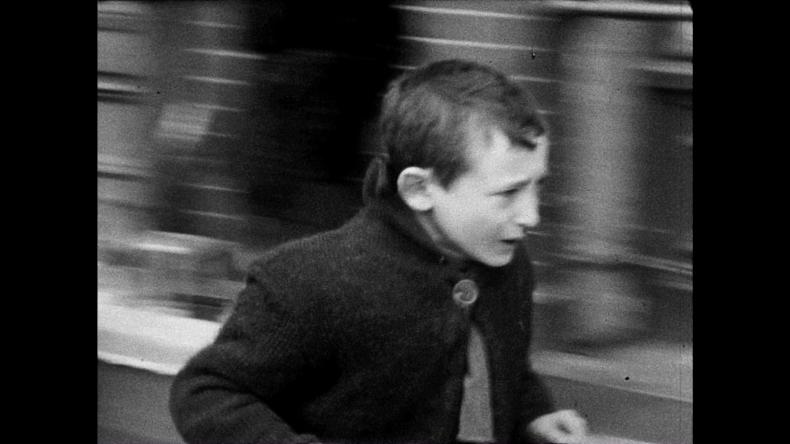
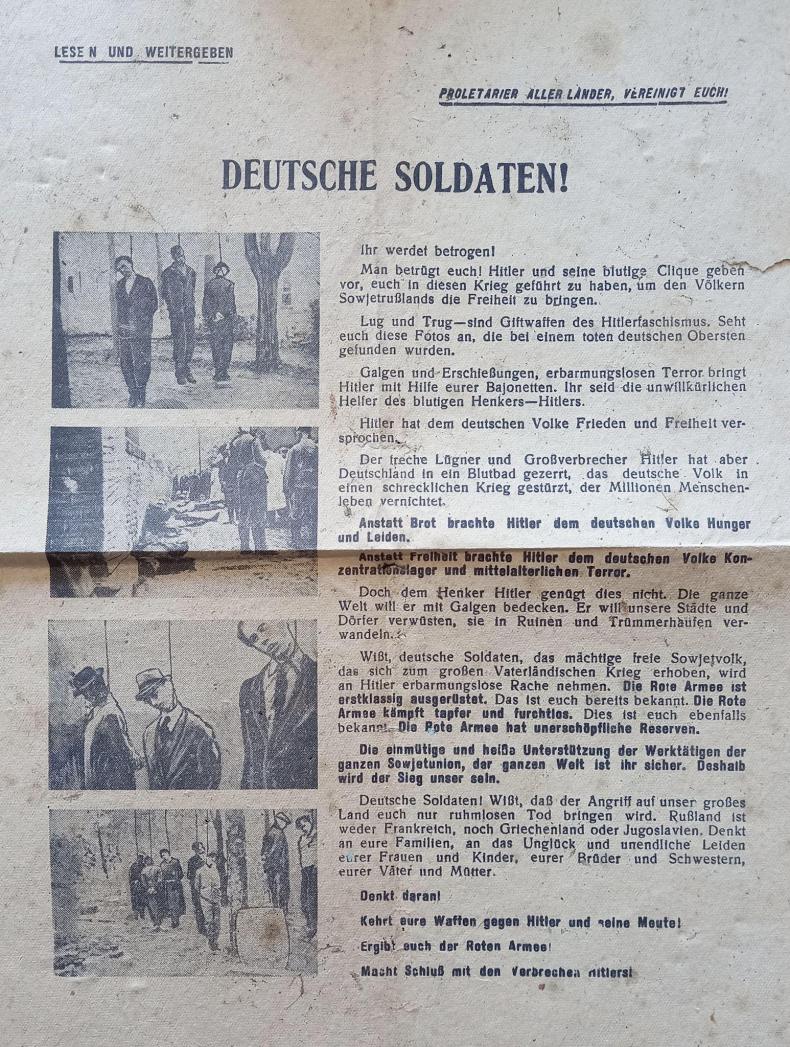
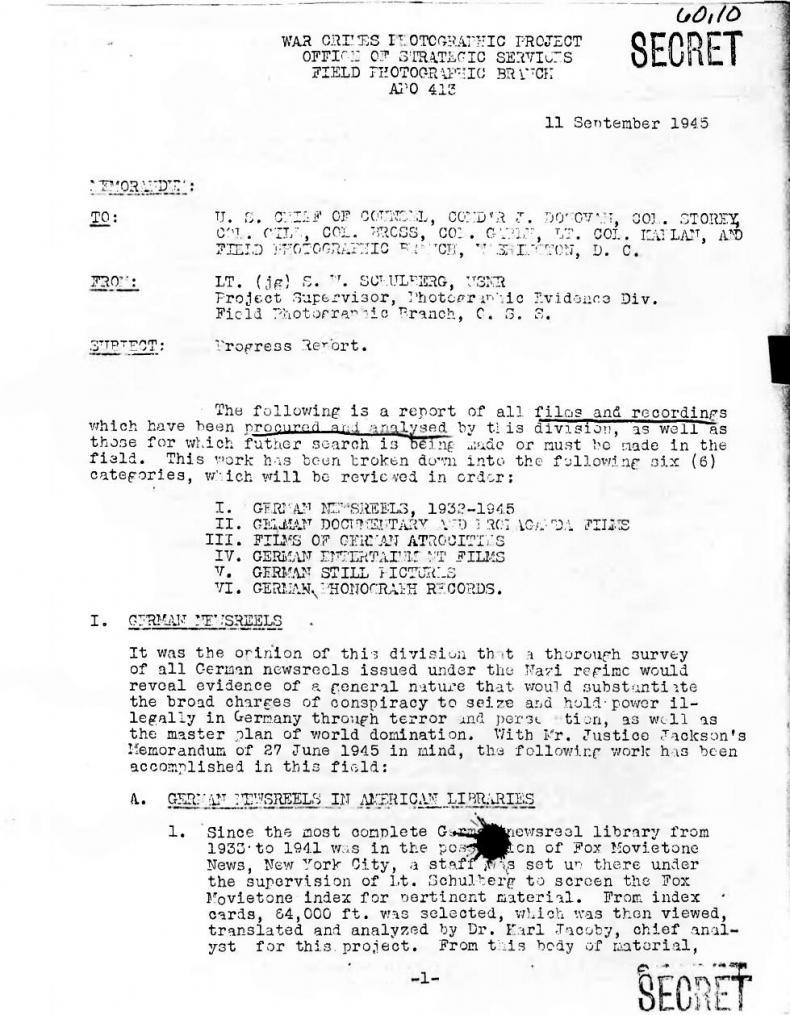
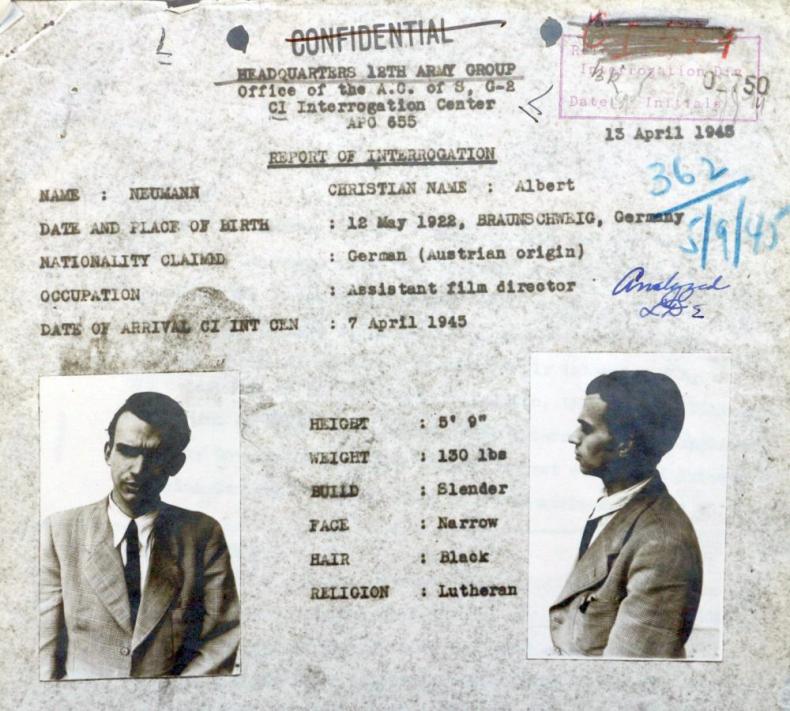
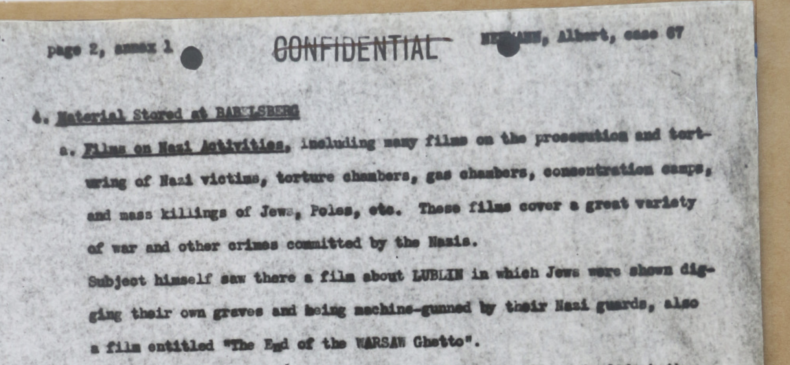
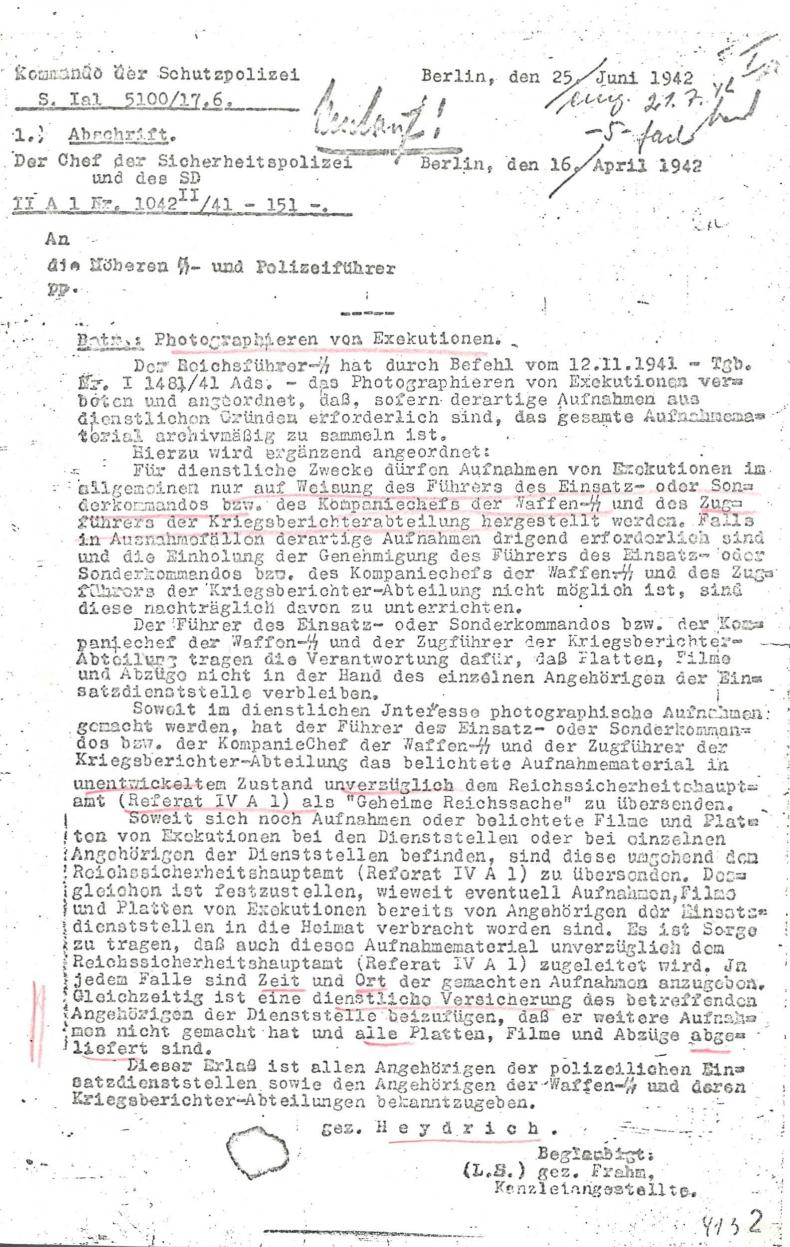
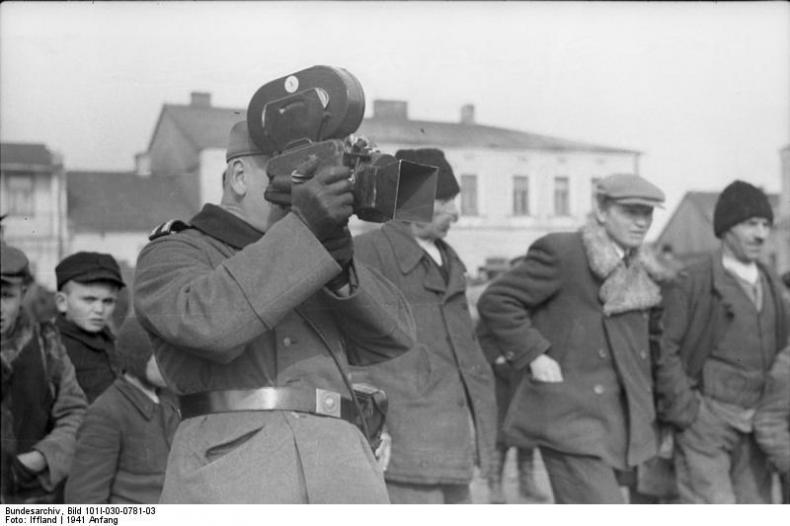


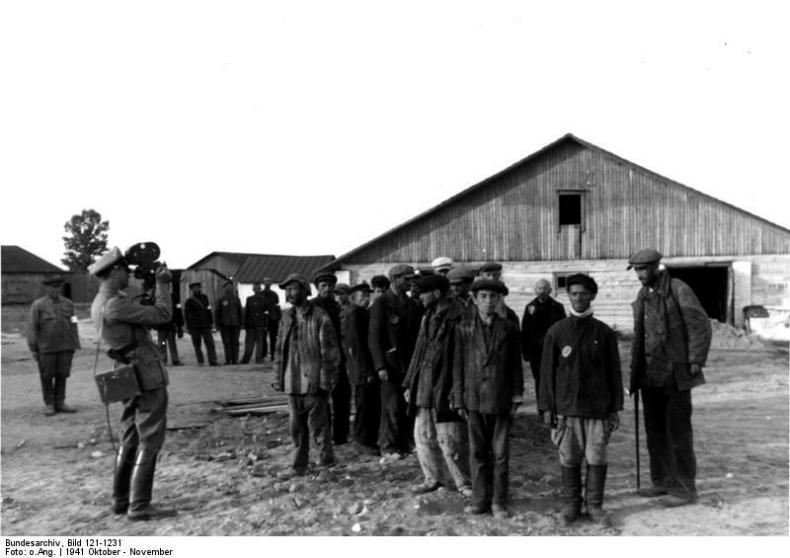
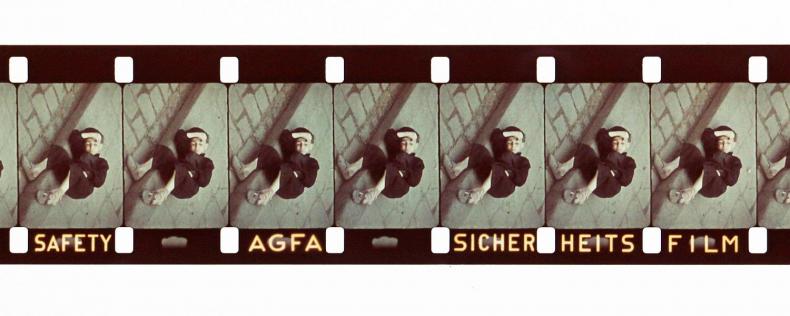
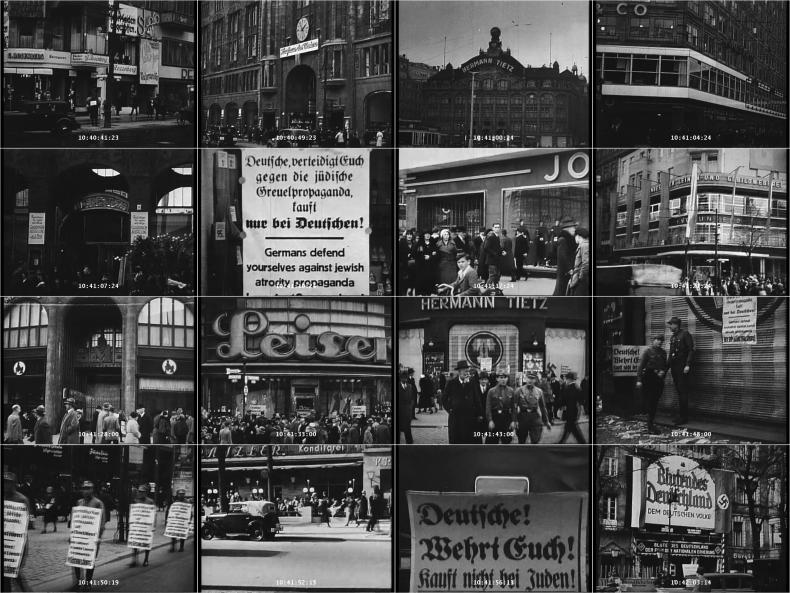
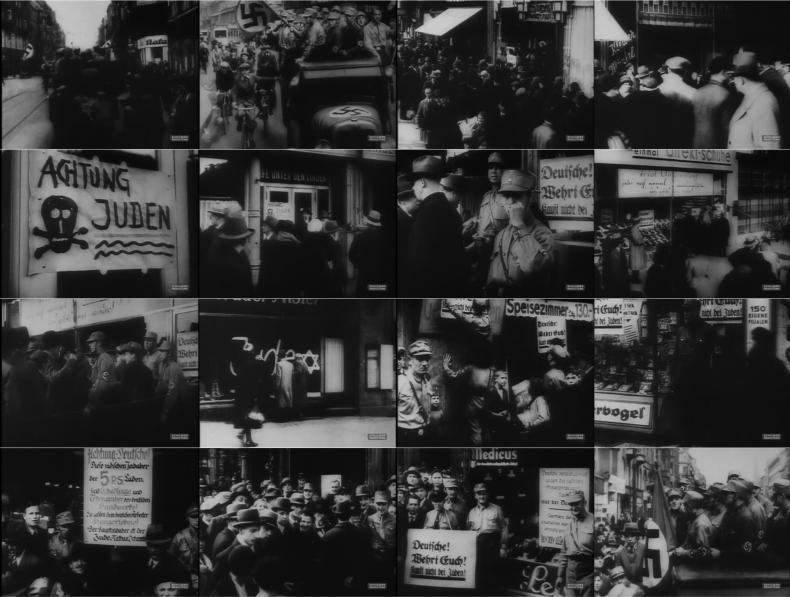
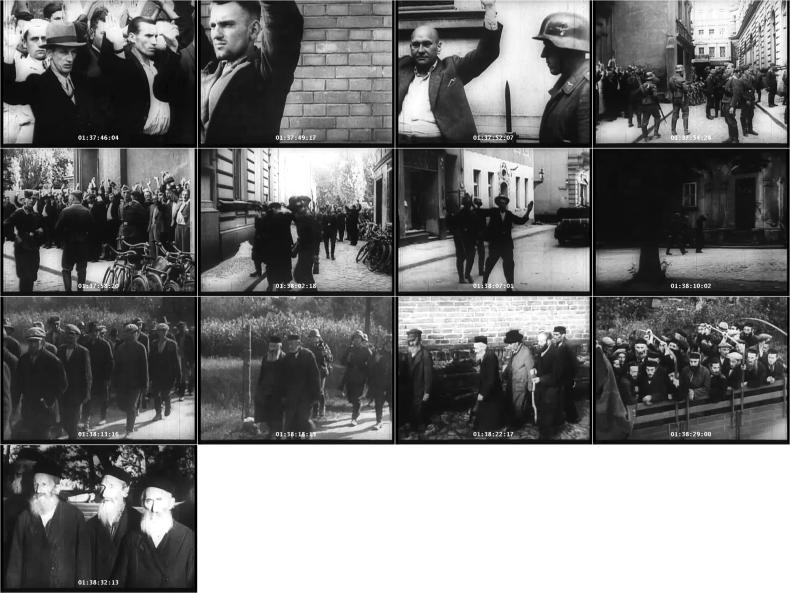
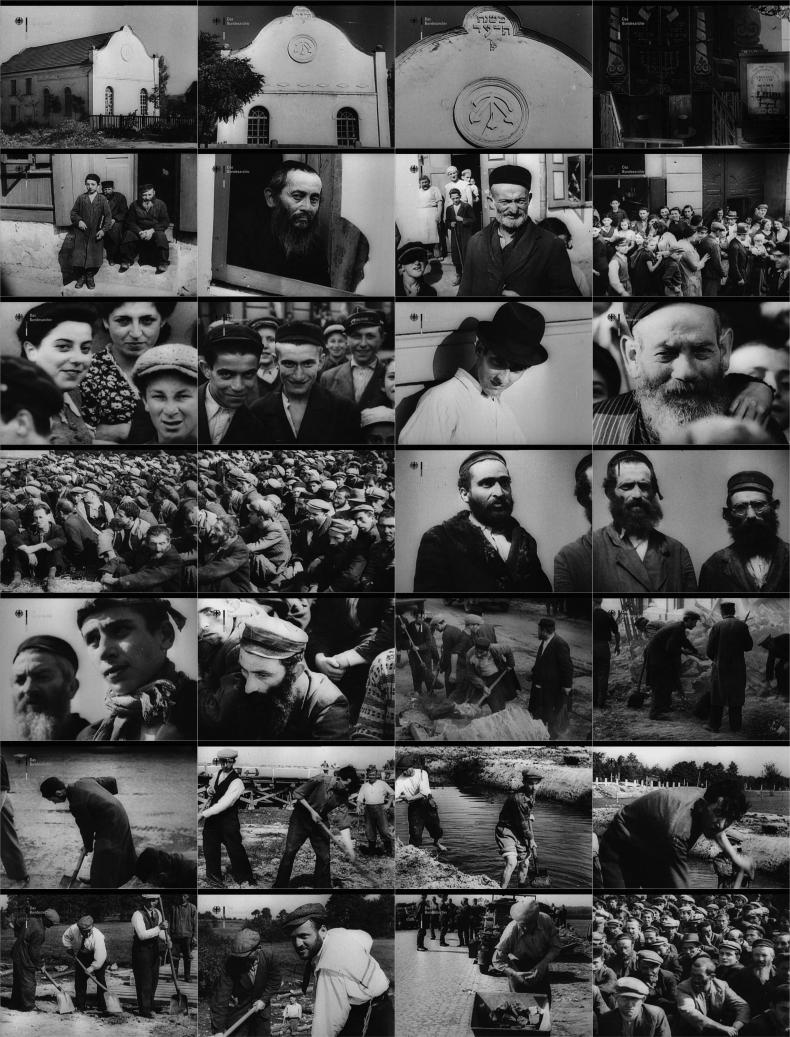
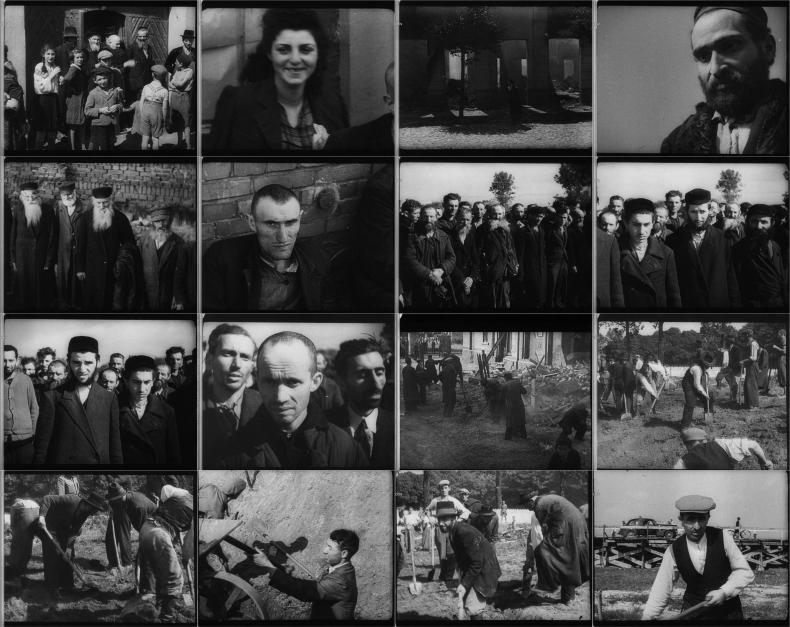

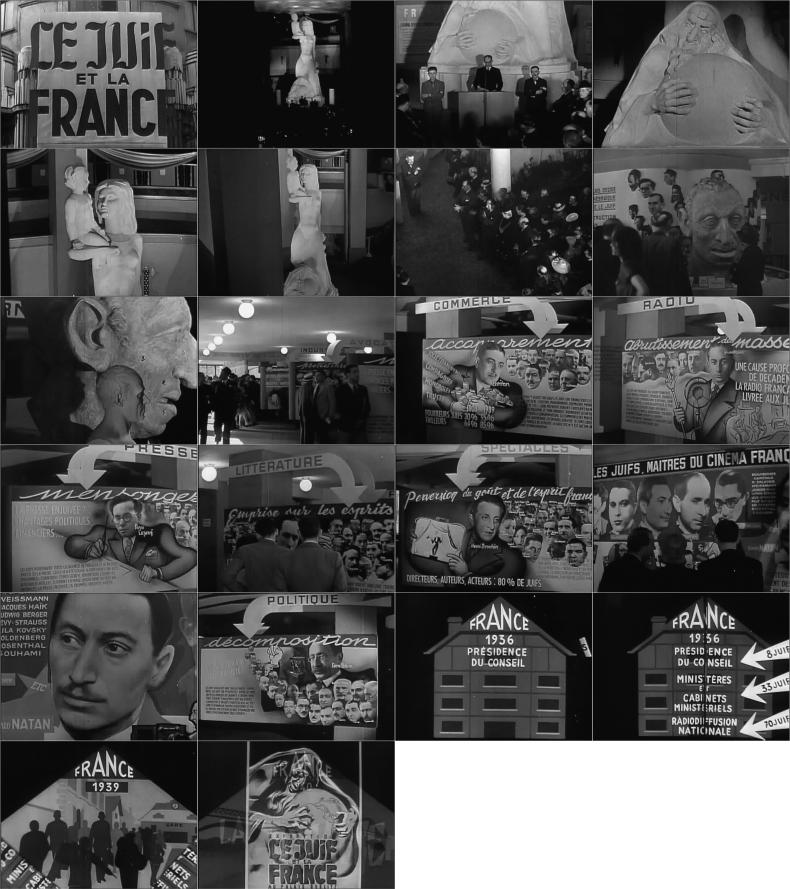
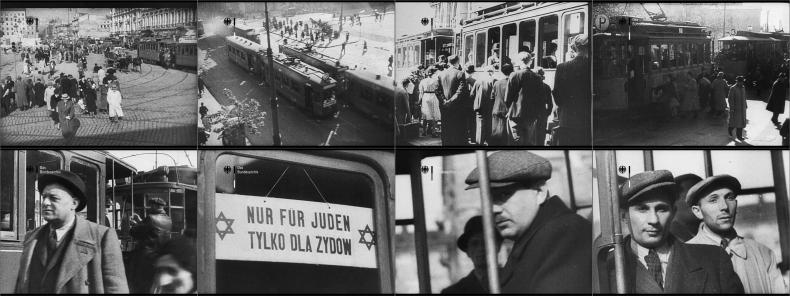
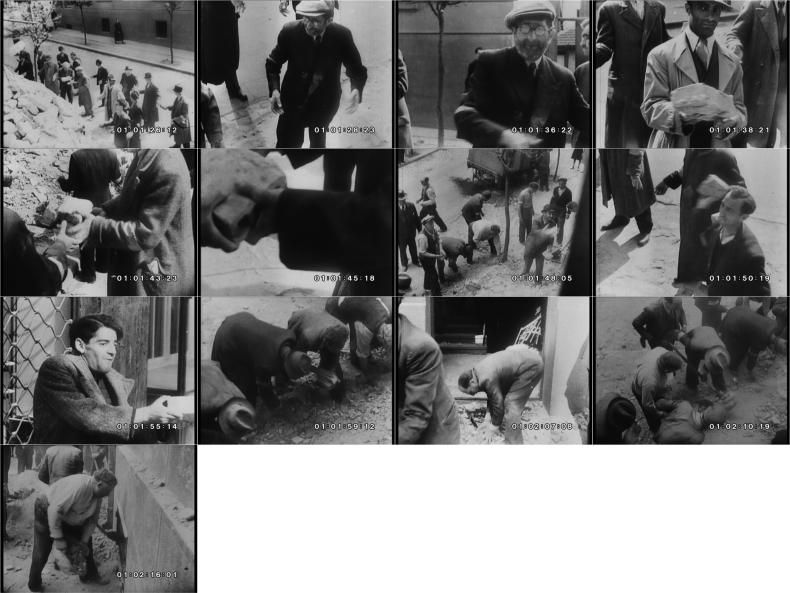

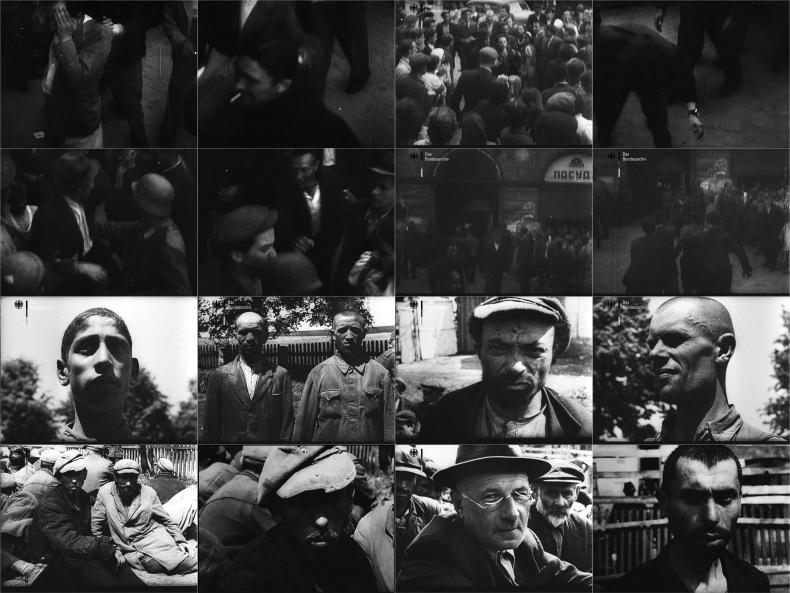
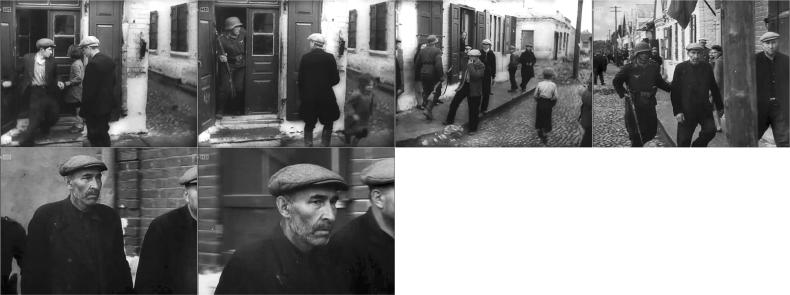


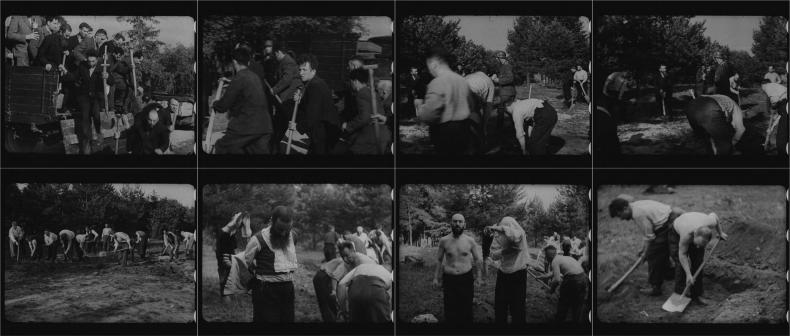

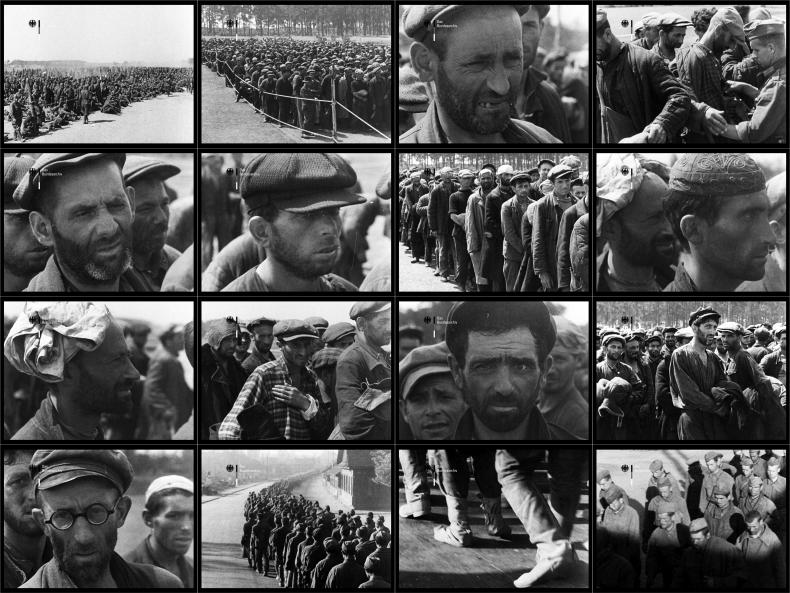
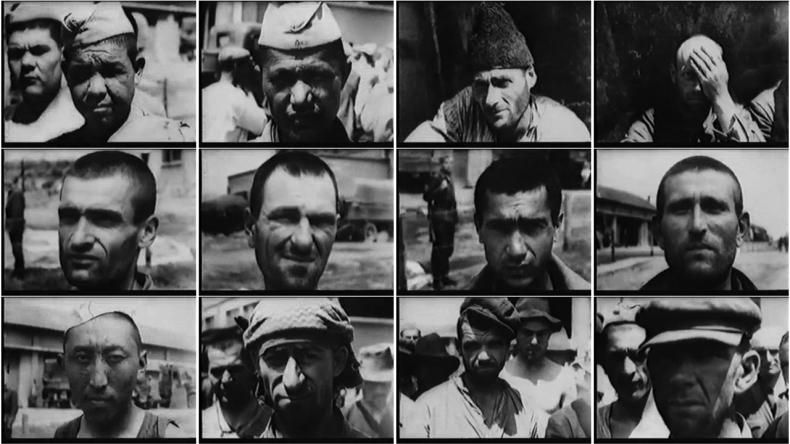
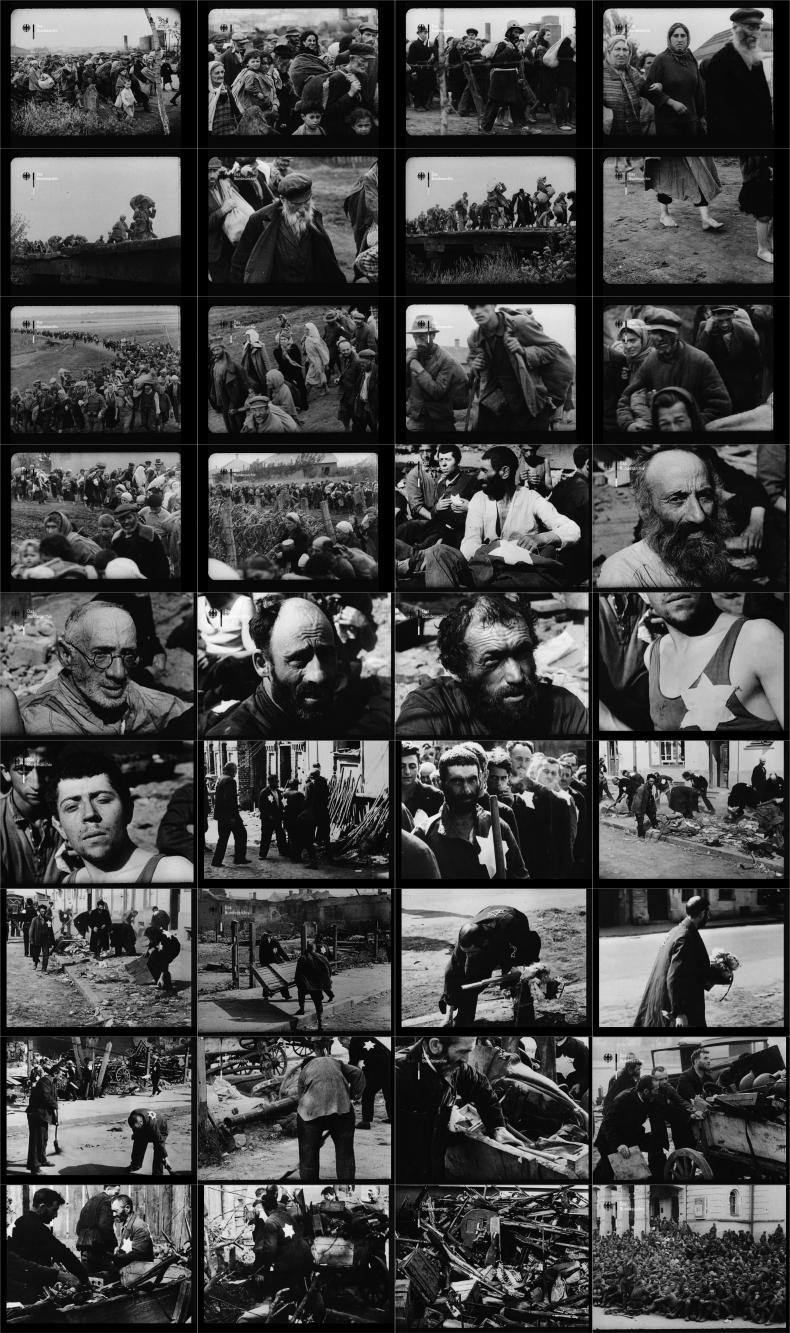
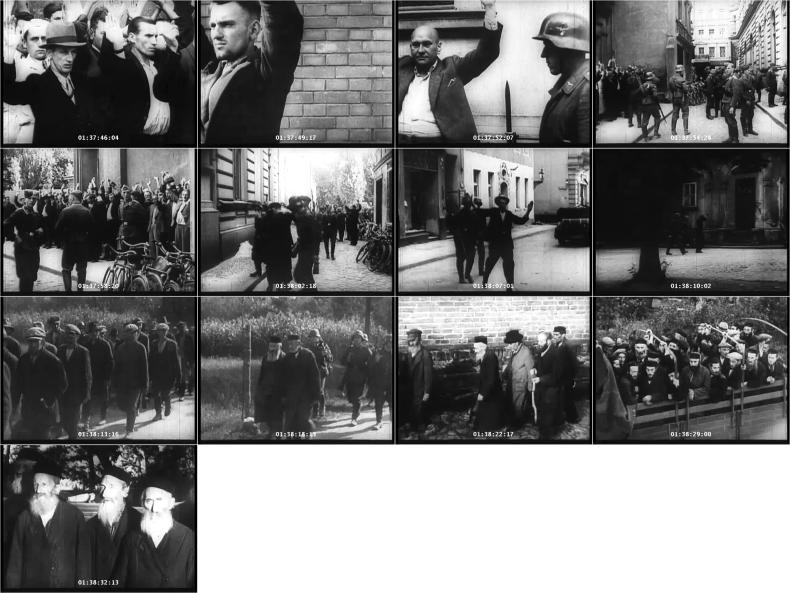
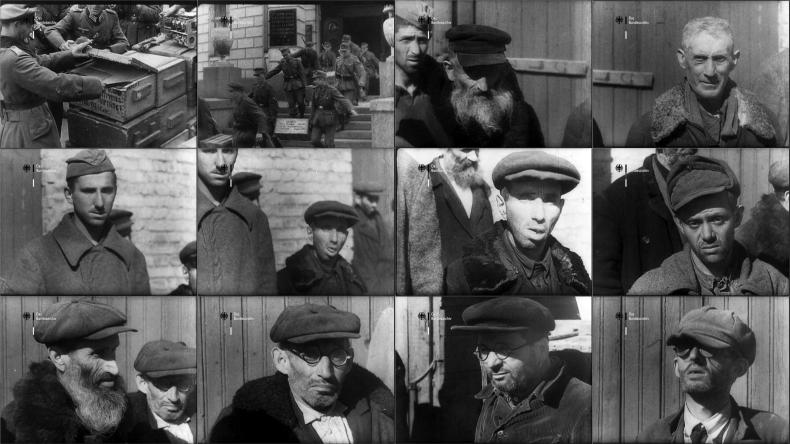
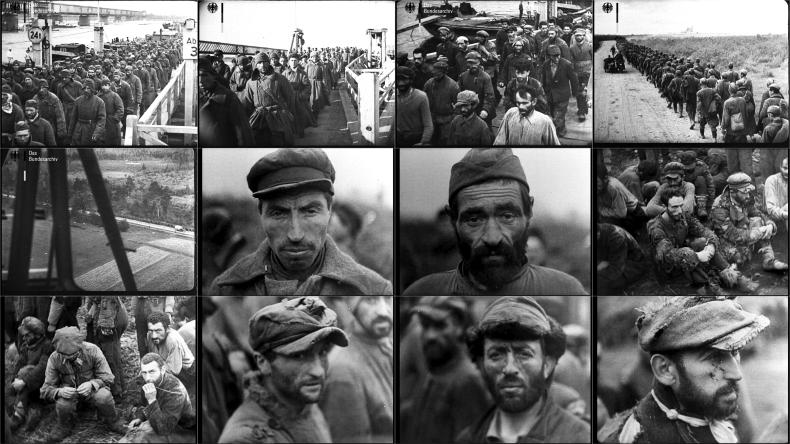
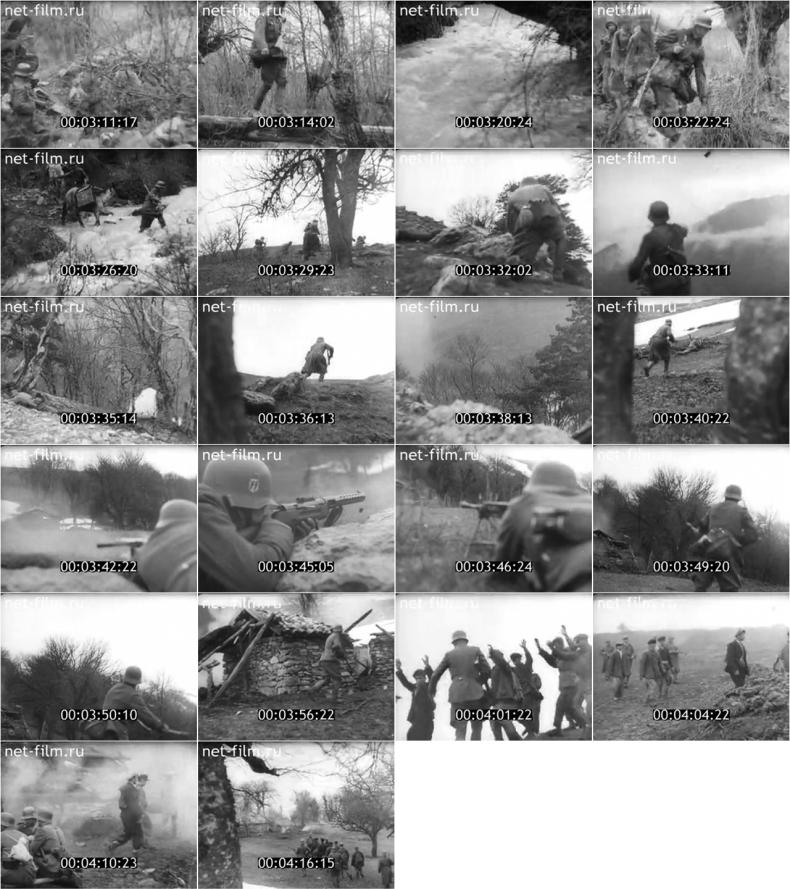
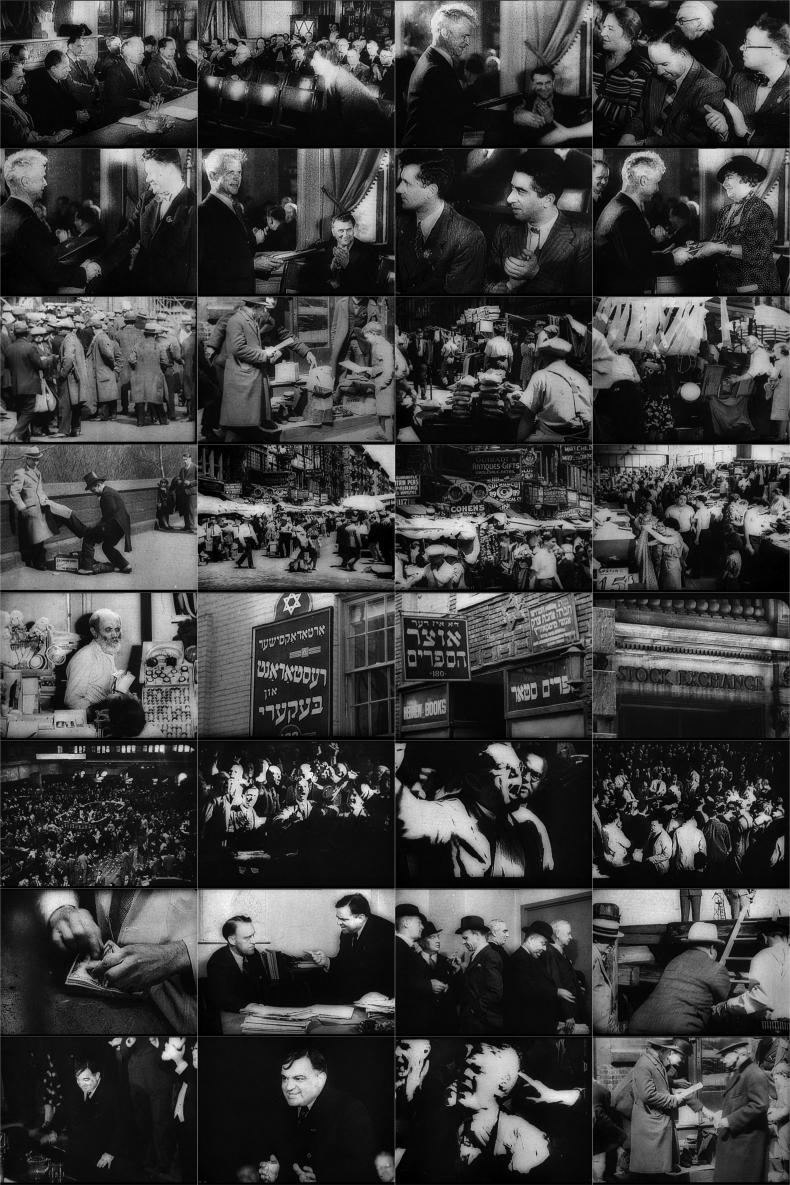
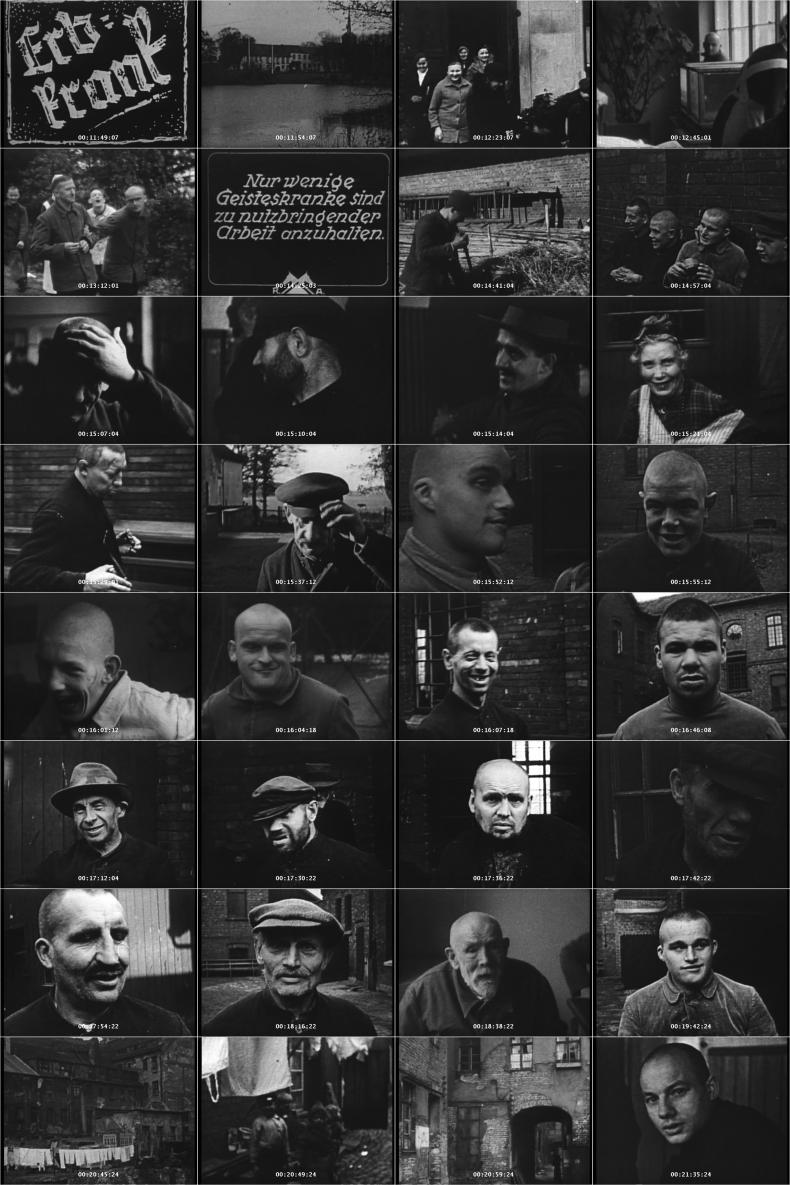
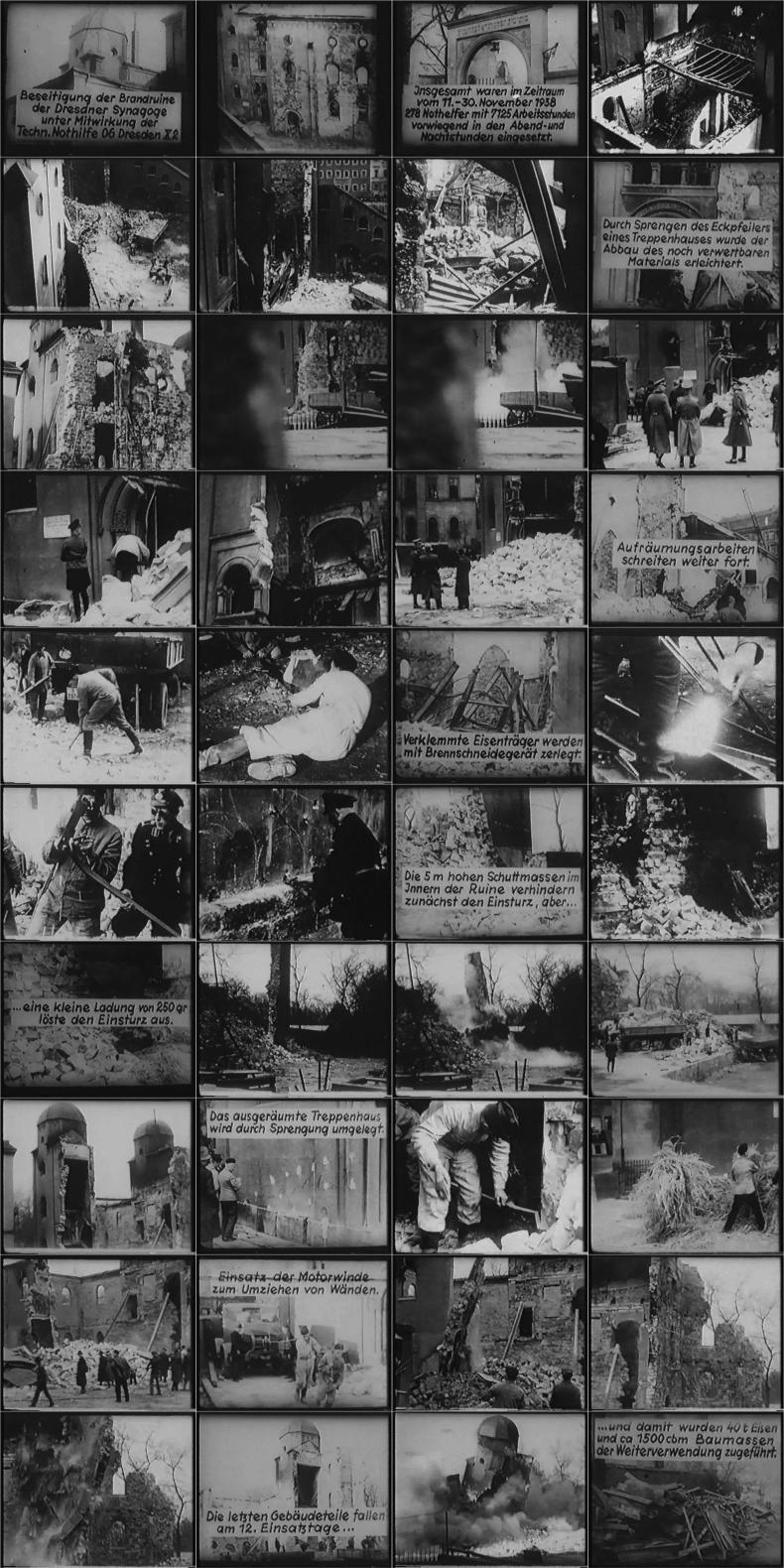
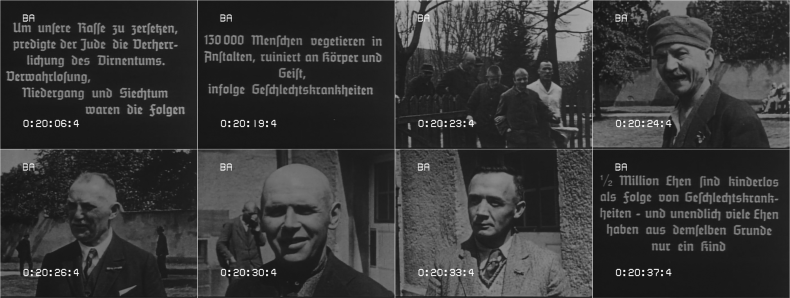
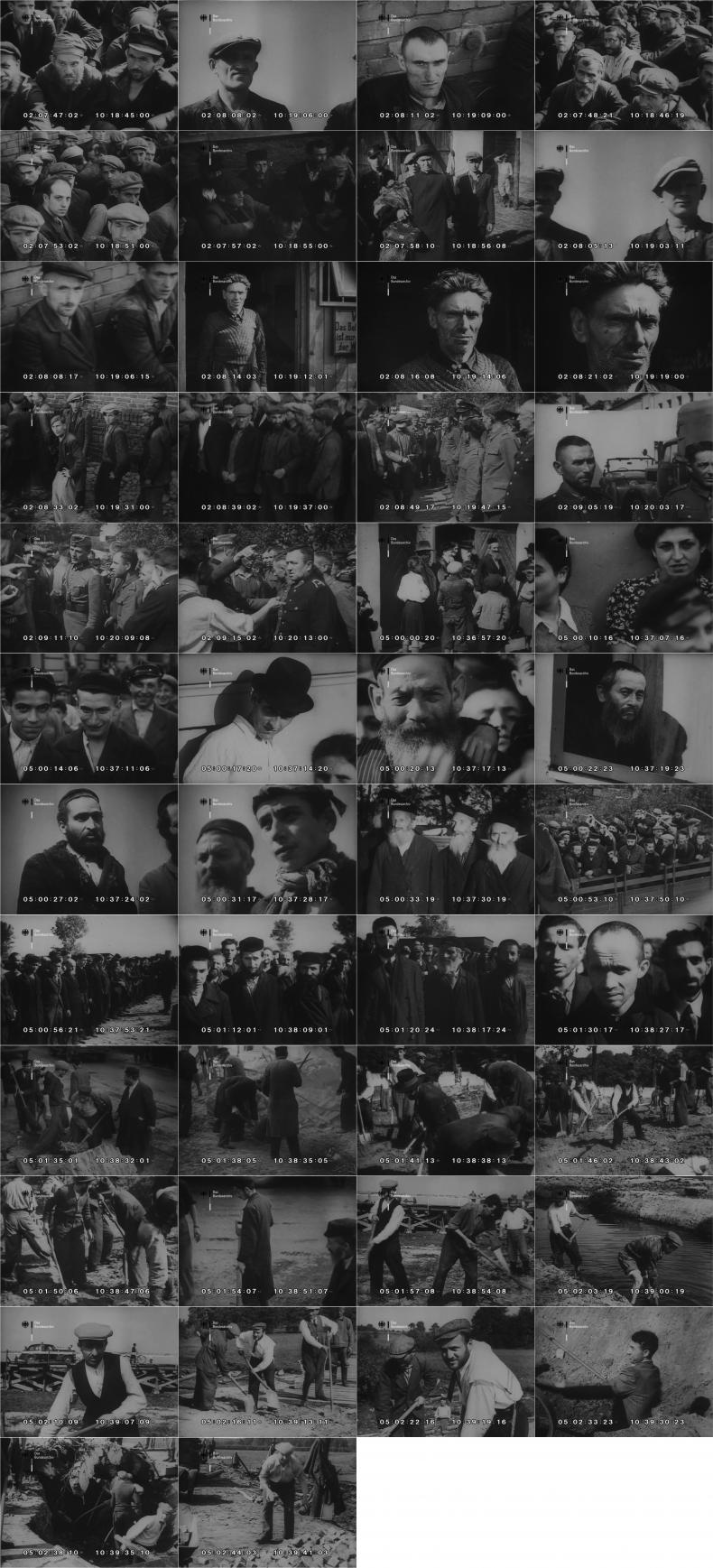
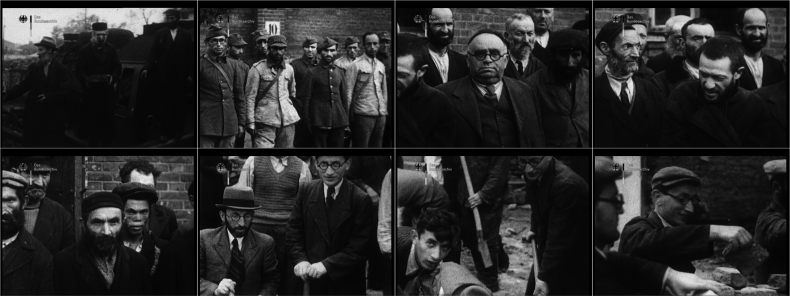
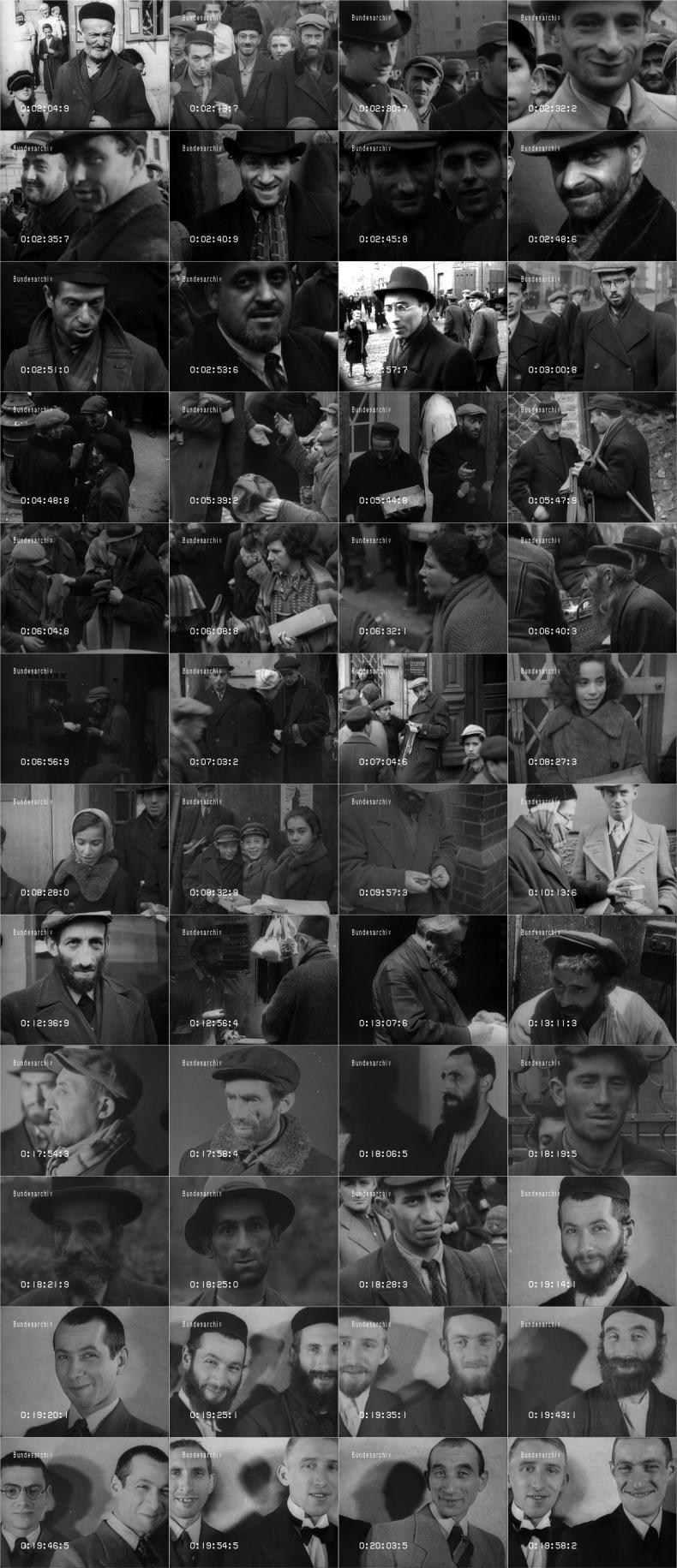


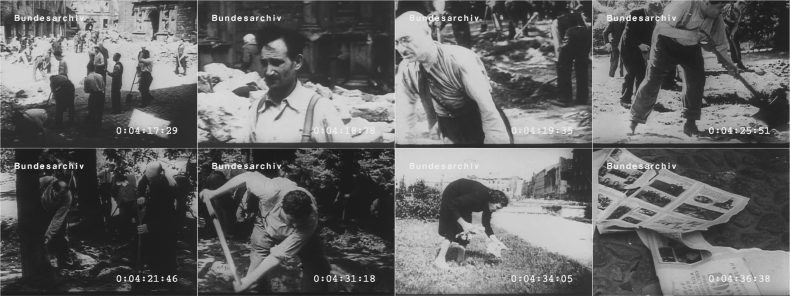
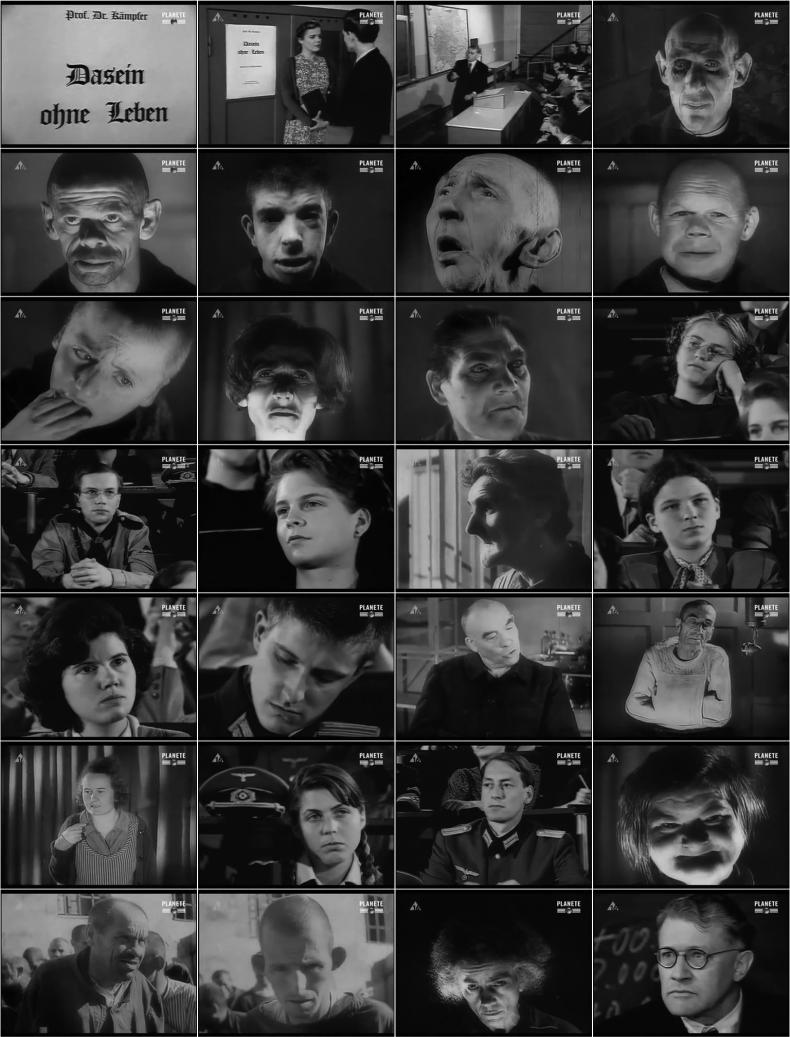
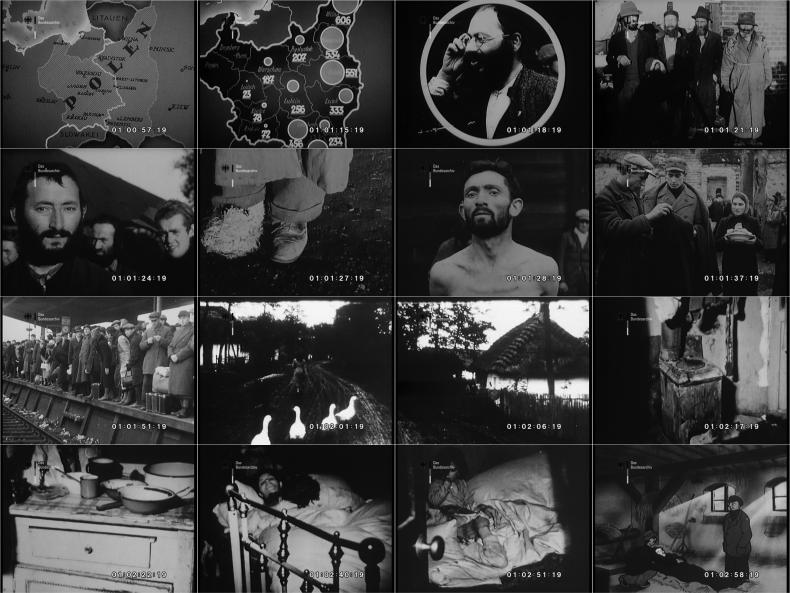
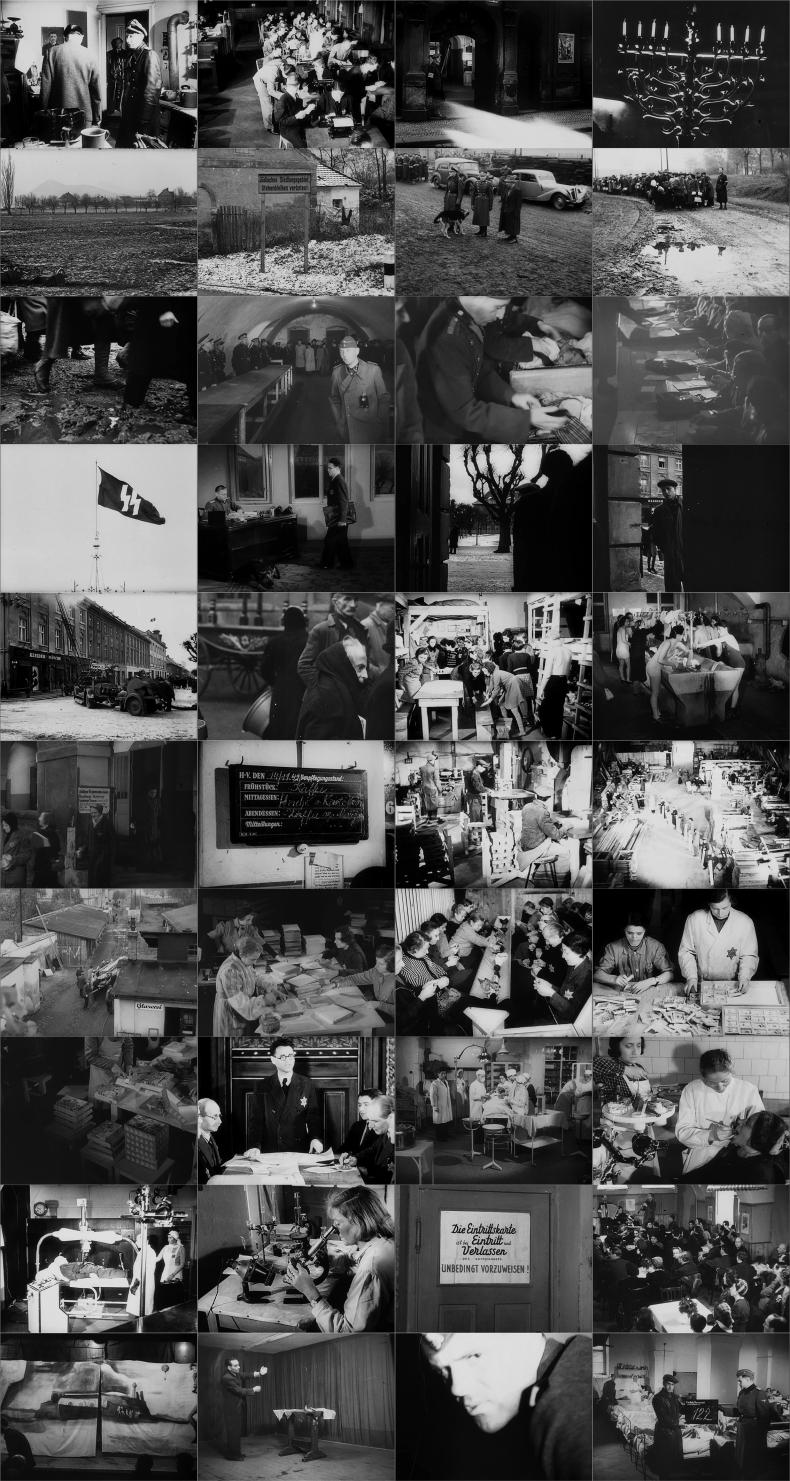
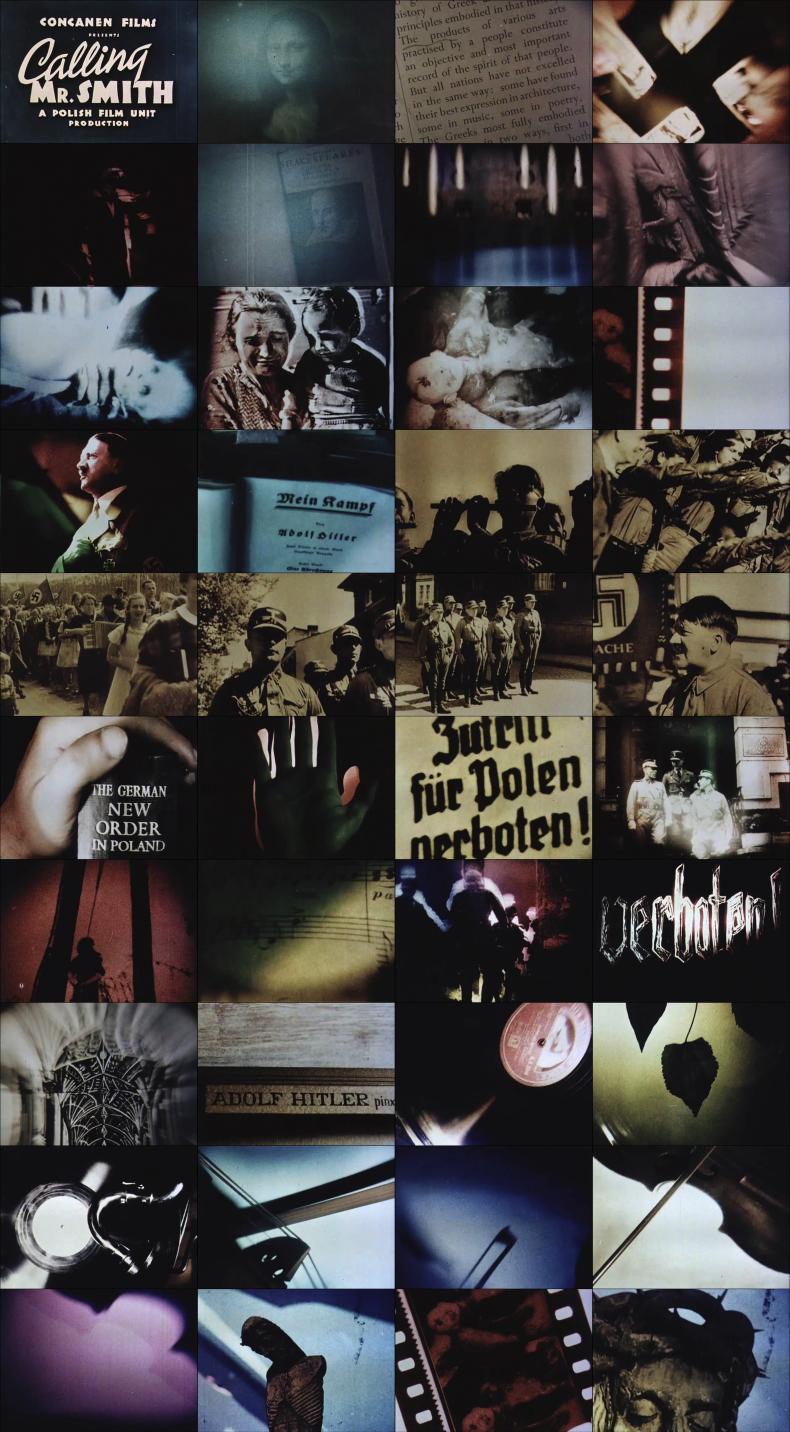
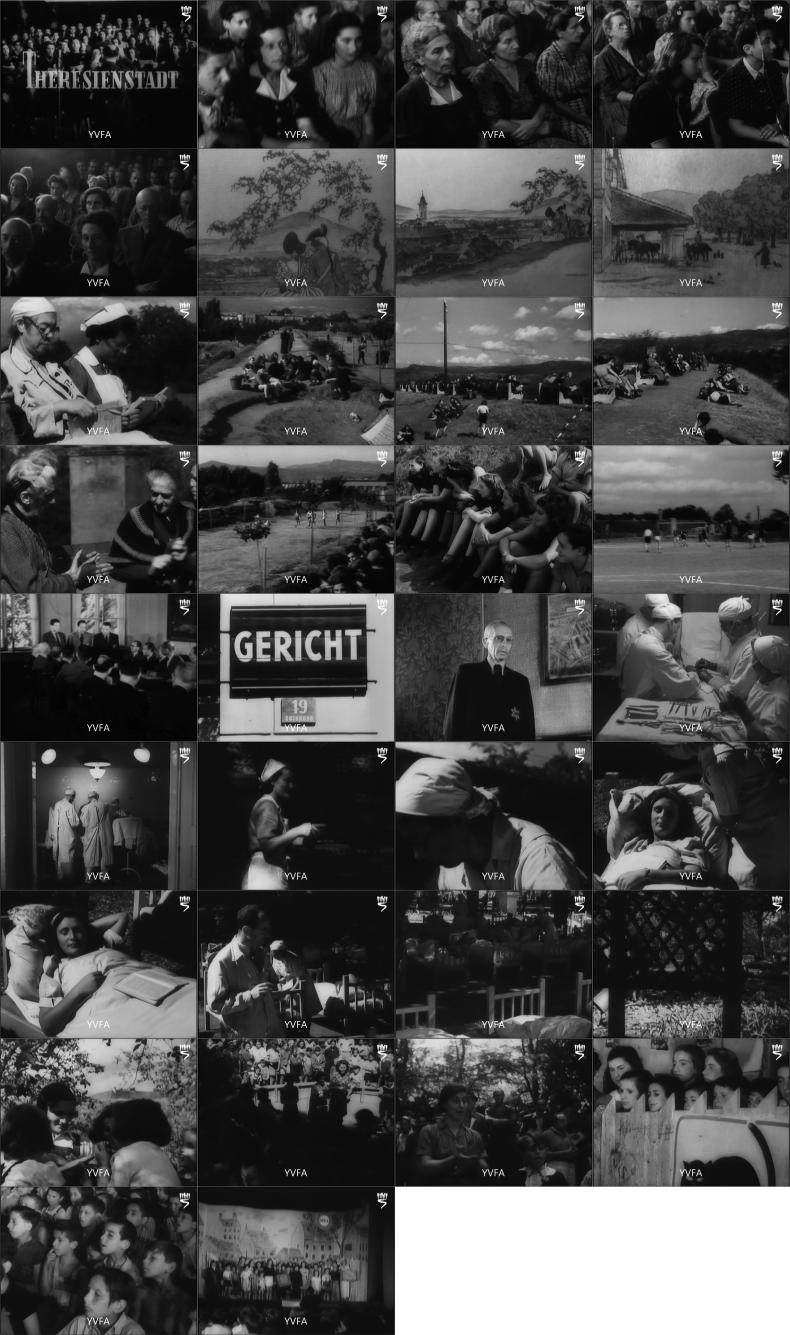
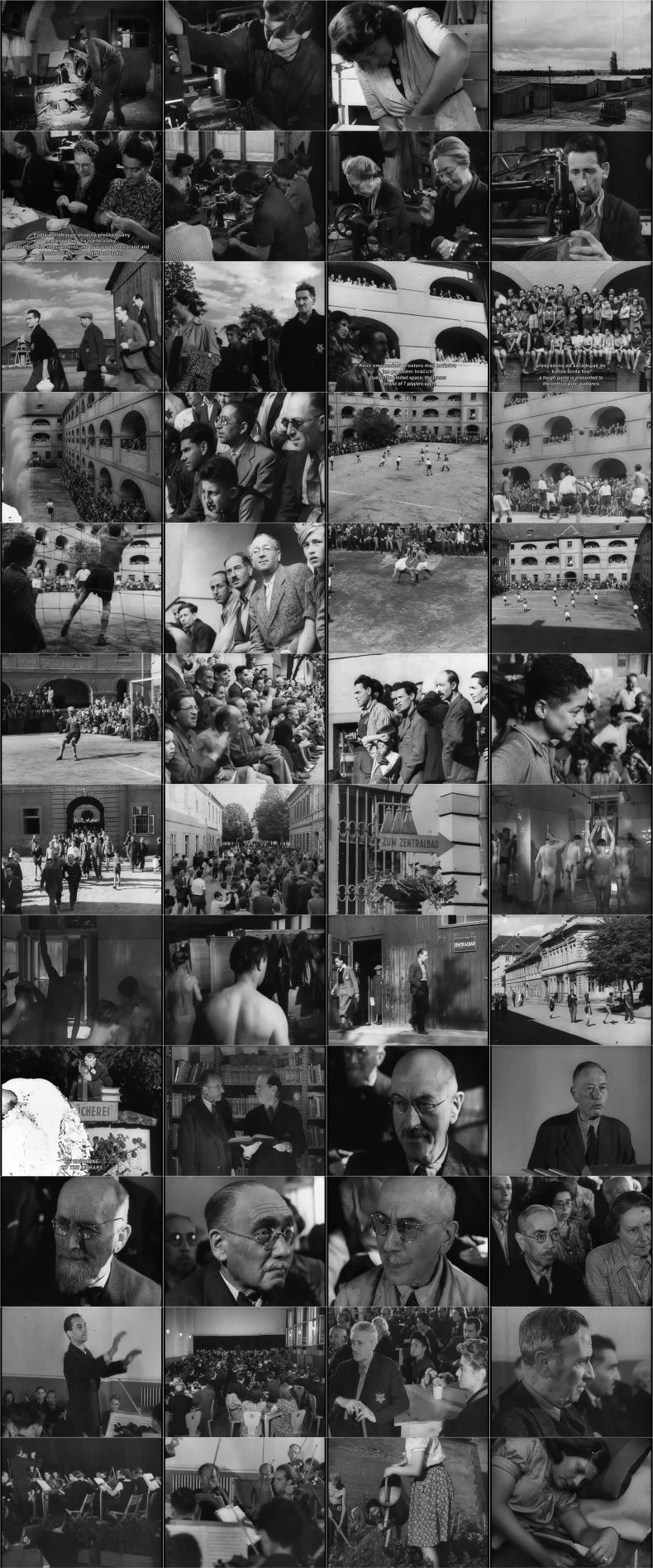
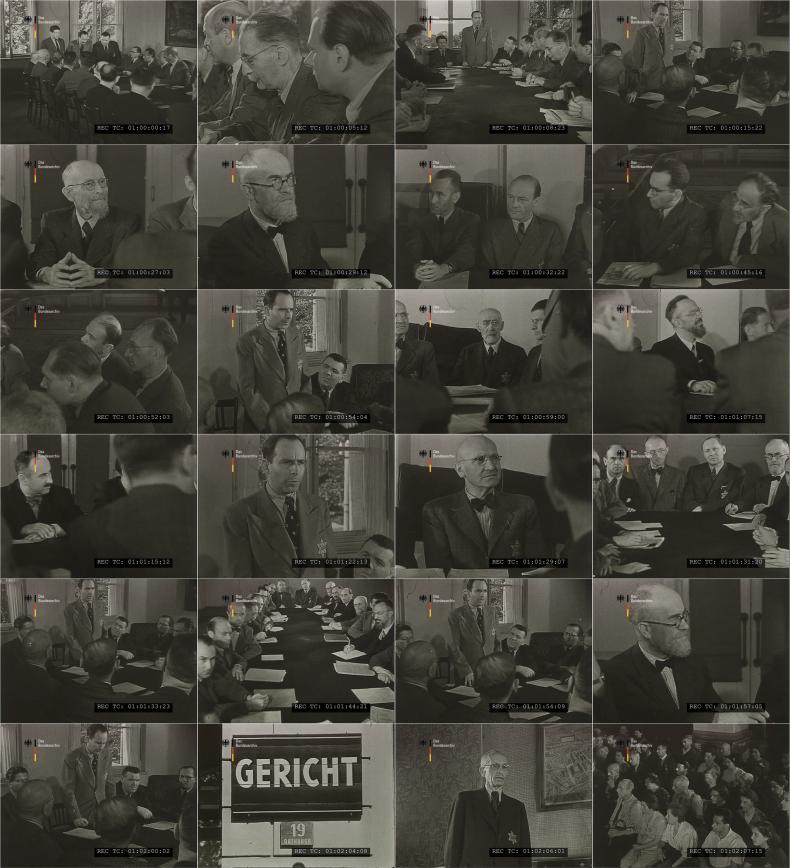
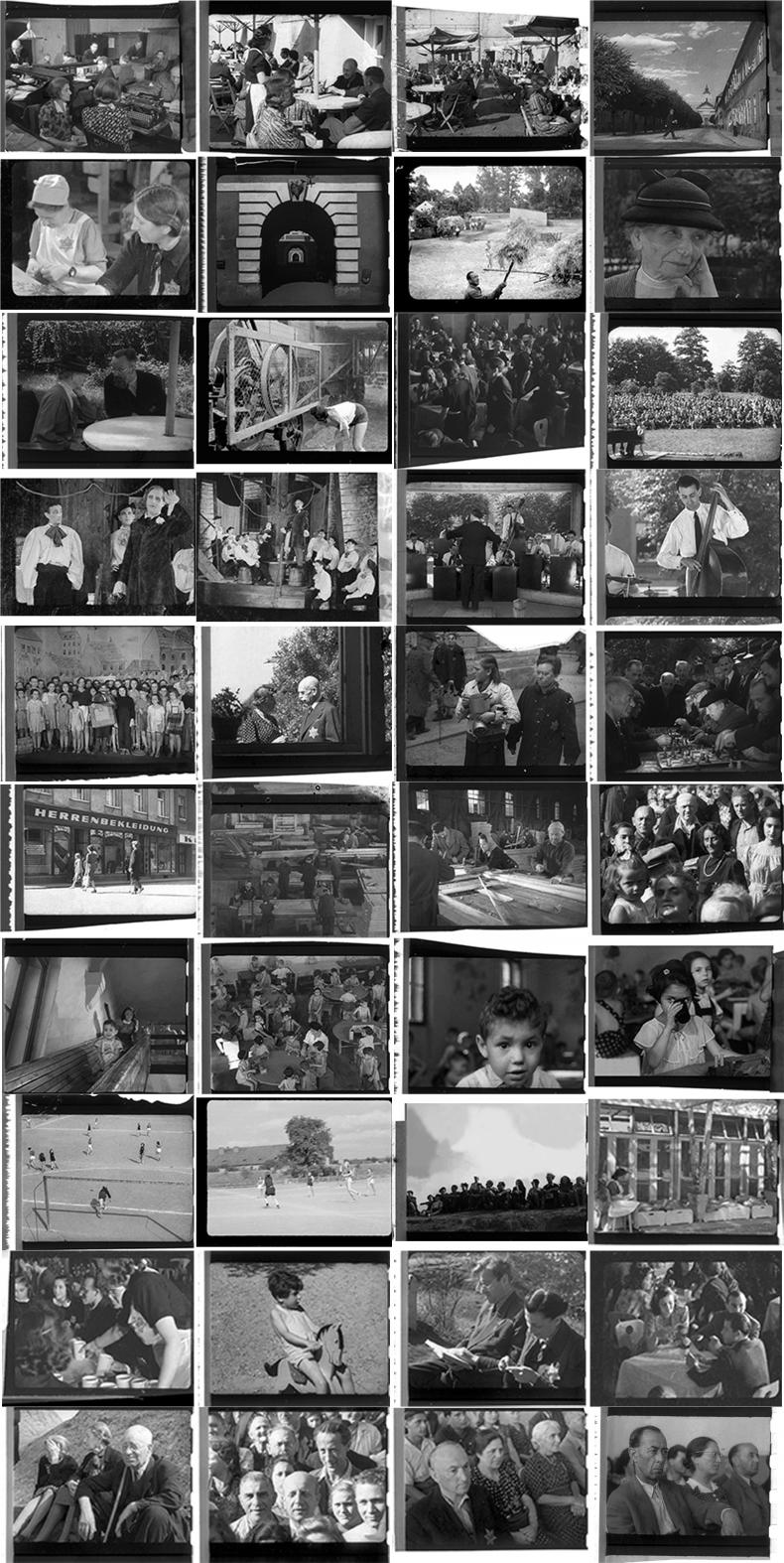
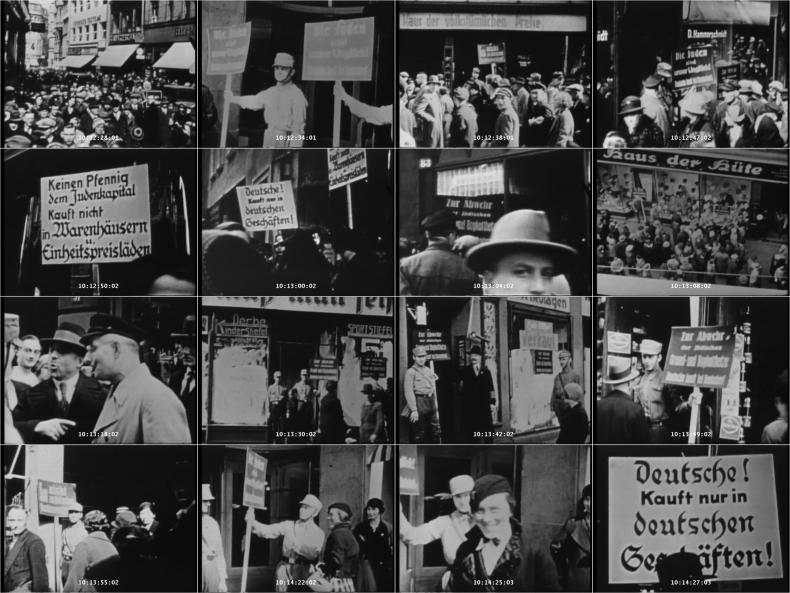

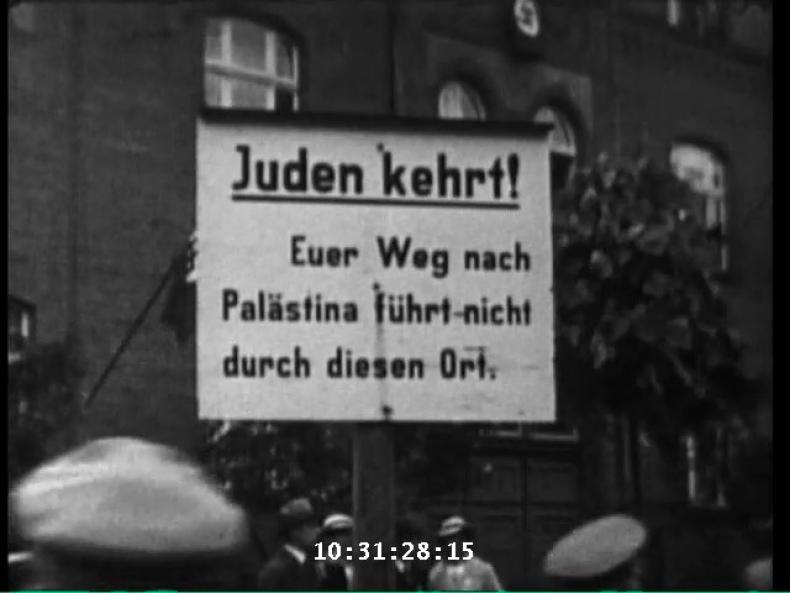
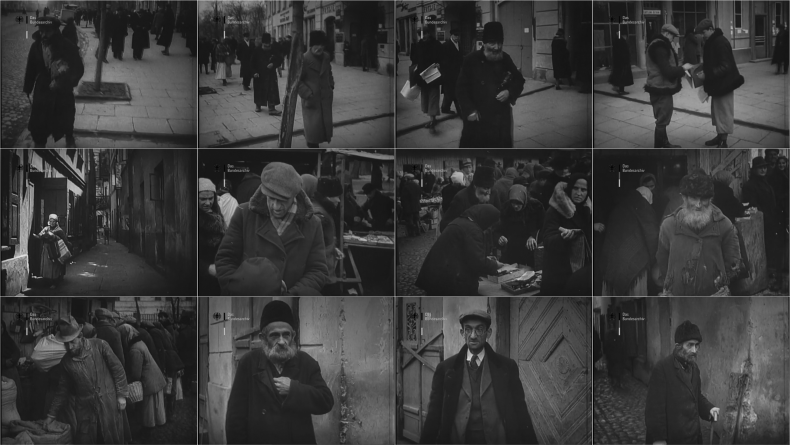

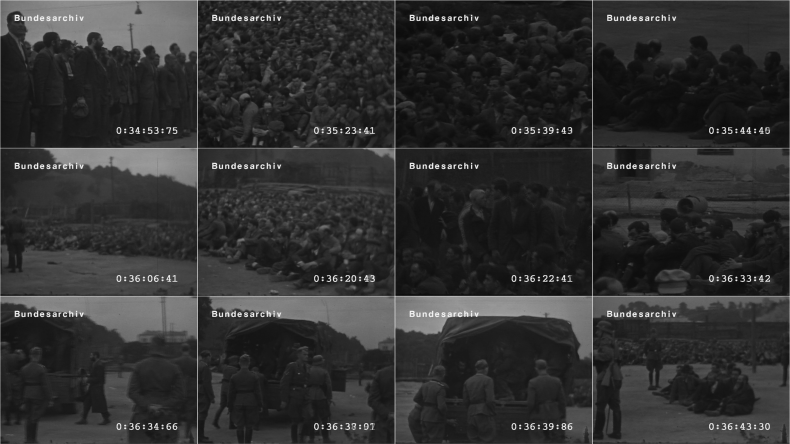
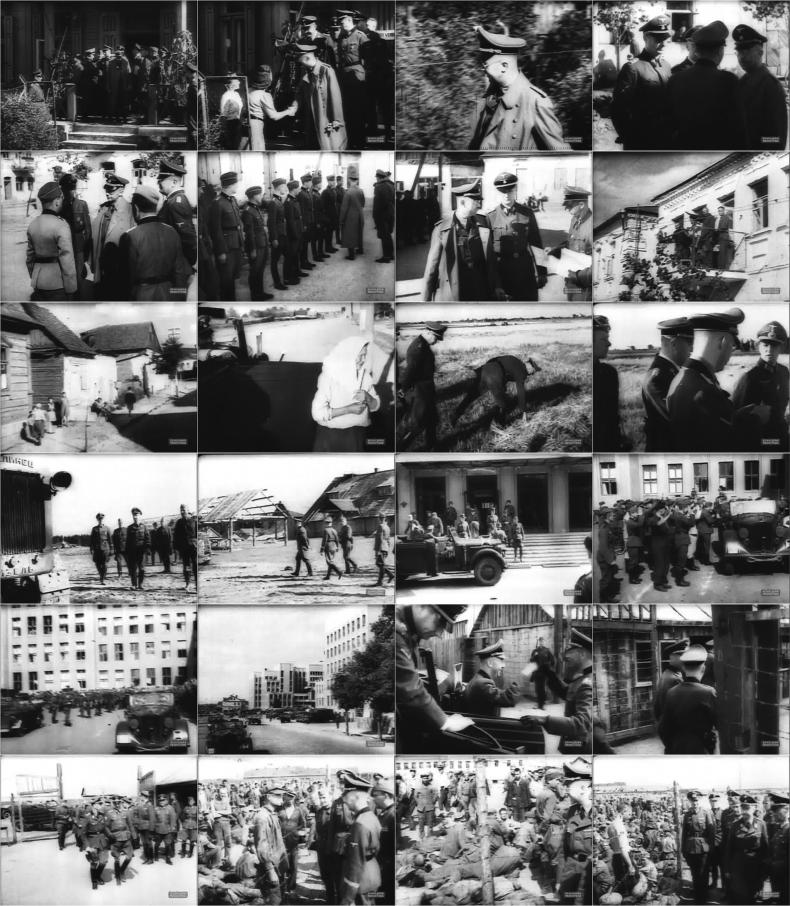

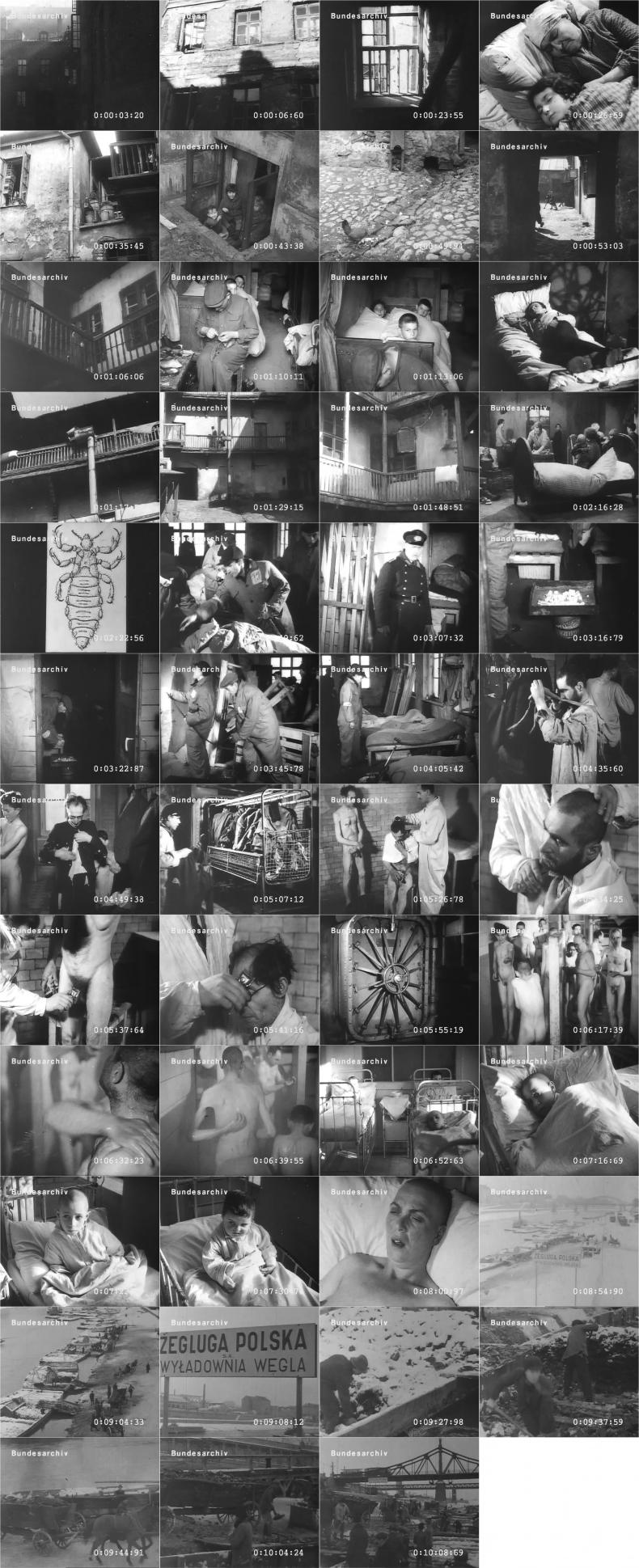
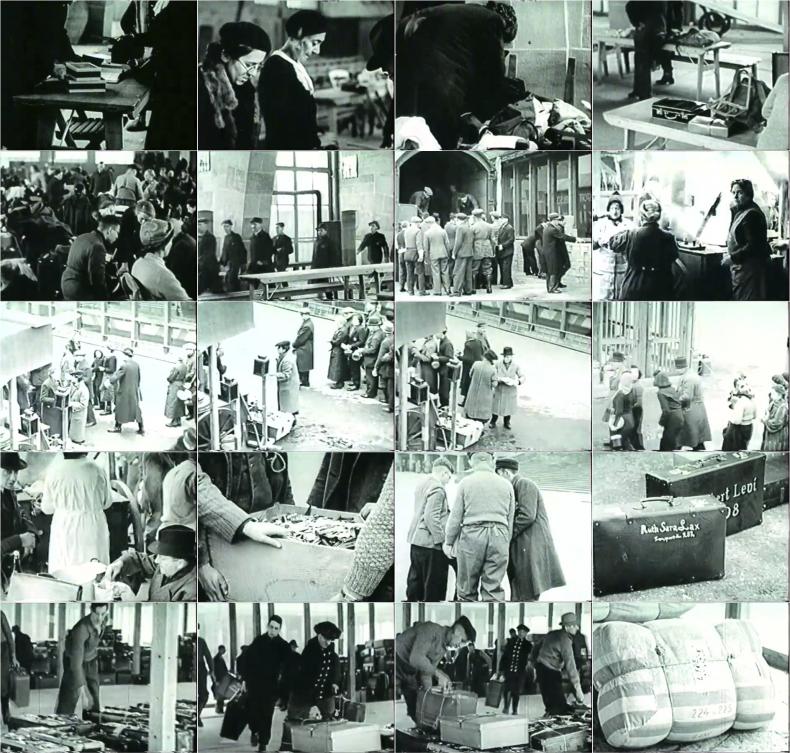
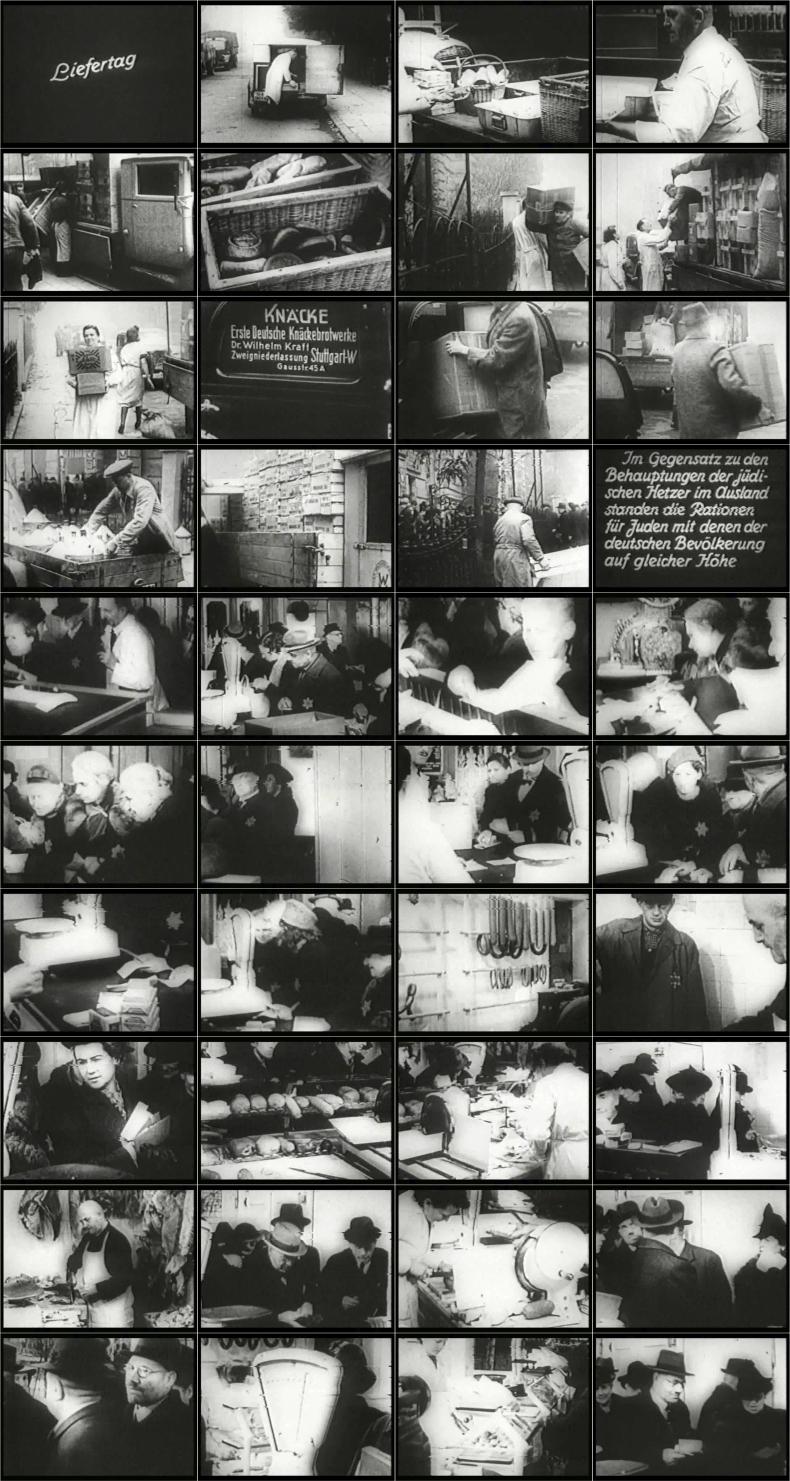
![[MOGILEV GASSING]](/sites/default/files/styles/9col/public/2022-01/Mogilev.jpg?itok=5wzumxFg)
